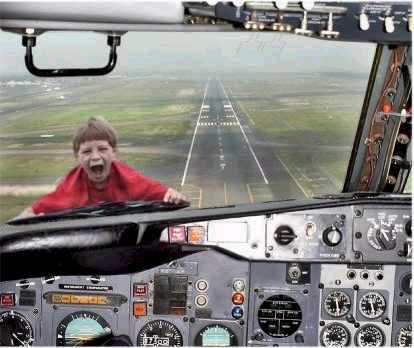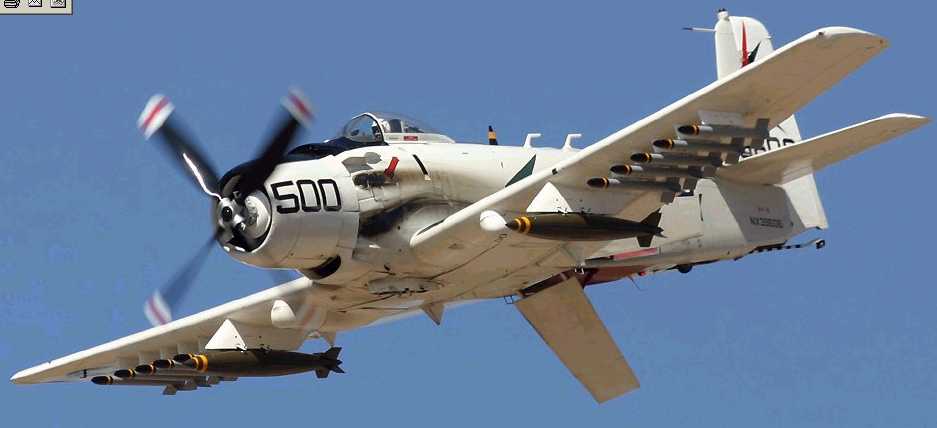
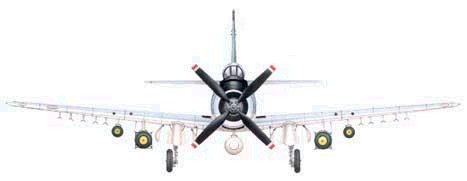
FIXED-WING = LONG LOITER TIMES OVERHEAD FRIENDLY TROOPS


"'Fast-moving aircraft are not designed to support ground troops," said Army Sgt. First Class Frank Antenori. 'As much as the Air Force and Navy would like to think that, fighter aircraft that travel at speeds can't slow down to identify the targets,' he told National Defense...
He said the Air Force A-10 attack plane and the Army Apache helicopter are the ideal platforms for close air support, best suited to SOF missions. Air Force F-16s and Navy F/A-18s are much too fast to be able to properly identify targets, he said. 'The problem is getting the pilots at the altitudes and speeds that they are flying to be able to ID the targets,' he said.
A-10s and Apaches do a much better job, because they can move at a slower speed. 'With fast movers, I never had any success,' he said."
"Fast Jets Not Ideal Choice for Close Air Support" by Roxana Tiron, National Defense magazine, April 2004
Arizona Republic (Phoenix)April 3, 2007
Peril To Forces Called Cause Of Crash [WRONG: it was WRONG type of aircraft]
By Charles Kelly, The Arizona Republic
Maj. Troy "Trojan" Gilbert, a Luke Air Force Base fighter pilot killed in Iraq on Nov. 27, crashed because he was so focused on saving friendly troops from insurgents that he flew too low, Air Force officials have concluded. Gilbert, 34, of the Litchfield Park area, was trying to head off an attack by insurgents on ground troops and the crew of a downed Army helicopter 20 miles northwest of Baghdad.
At the time, Gilbert was leading a flight of two F-16 fighter-bombers near Taji, according to an Air Force accident investigation board report. He responded when insurgents attacked troops on the ground with truck-mounted heavy machine guns, rocket-propelled grenades, small-arms fire and mortars. Gilbert carried out one strafing run against the enemy vehicles, striking a truck with his 20mm Gatling gun before pulling out only 200 feet from the ground, said the head of the accident investigation board, Brig. Gen. David L. Goldfein.
Gilbert flew even lower on his second strafing run and was unable to pull up before he crashed, Goldfein said. Investigators concluded that he died instantly.
His actions helped save the lives of the helicopter crew and other coalition ground forces, Goldfein said. Gilbert was awarded the Distinguished Flying Cross with Valor.[And the USAF-fighter-bombers-for-everything bureaucracy continues operating the wrong type aircraft lest their ego platforms have to share the budgetary limelight with slower, more agile armored aircraft like the A-10 suitable to the job].
He chose to attack at a very low altitude because he was concerned about making sure he was correctly identifying enemy vehicles trying to merge with civilian vehicles, Goldfein said. Gilbert attacked from a difficult angle because he apparently wanted to bring fire on the enemy vehicles quickly to protect the ground troops, who were in a very perilous situation.
Gilbert's remains were removed from the crashed plane before coalition forces could get there. An intensive search was immediately conducted without result. Coalition forces are still working to find Gilbert's remains and return them to his family, Goldfein said.
The U.S. military nation-state war racketeers do not want to change and do sub-national conflict tasks properly with proper equipment to resolve an allegedly "long war" they want to keep on milking for years and years. They need to be fired by WE THE PEOPLE and replaced by people representing us FROM US ie: the all-victim-force (AVF) must be ended and replaced with a broad form of national service where non-racketeers run the services.
www.iht.com/articles/2007/03/15/opinion/edpllizzari.php
Repeating Soviet mistakesValerio Pellizzari
Published: March 15, 2007ROME: A few weeks ago a young military spokesman representing Italian Coalition forces in Afghanistan was summarily relieved of his duties after commenting that Italian Soldiers were building a Roman Catholic church in Herat dedicated to the Virgin Mary, whose religious importance he termed, "spiritually meaningful to Muslims too."
A careful reading of the Koran might have made him feel otherwise. Moreover, it might have helped had he known that only one church has ever been allowed on Afghan soil. It was authorized by King Amanullah and built in 1933 in gratitude for Italy's being among the first countries to recognize Afghan independence.
However, there are worse misunderstandings in Afghanistan, the worst being that senior NATO officials at their Brussels headquarters don't seem to grasp that they are repeating the same tragic mistakes made by Kremlin generals 25 years ago. NATO today, like Moscow a generation ago, has opted to increase spending to conduct aerial warfare, thereby intending to reduce military fatalities on the ground, maintain relative control of communications networks and at least pretend to control the country. The strategy isn't working.
The Italian government, for one, doesn't seem to understand this either. Italy's transformation last summer, from the government of Silvio Berlusconi to that of Romano Prodi, occasioned a hectic domestic debate over Afghanistan. Everybody important weighed in, even though Afghanistan had been ignored by Italians for years. Except for Dr. Alberto Cairo, with the International Red Cross, and Dr. Gino Strada with the organization Emergency, few Italians are associated with the country. Unfortunately, the discussion ignored the most important problem in fighting the war, the mistake of maintaining strategic dependence on aerial warfare. Debate centered instead on less-vital issues, like stopping the growing drug traffic, re-establishing the judicial system and building respect for democratic principles.
From June until November, 2006, NATO carried out roughly 2,100 aerial bombing missions there, an average of 18 daily missions, with some bombs weighing close to 2000 pounds. There was nothing cosmetic about this sustained, massive bombardment. However, during this same period, attacks by the Taliban, Al Qaeda and others opposed to President Hamid Karzai increased. The number of suicide bombers also rose. This made 2006 the bloodiest year in Afghanistan since the defeat of Mullah Omar and the Taliban in 2001.
NATO's aerial war has been ineffective. Relying so heavily on air attacks to keep fatalities low is simply repeating the same mistake that the Russians made in Afghanistan a generation ago. The most stunning example was the futile battle of Tora Bora to capture Osama bin Laden at the end of 2001. As Jonathan Randal writes in his book, "Osama," coalition troops did not fight on the ground at Tora Bora. It wasn't a battle at all, just a hail of missiles and bombs that came and went.
Even ignoring the basic tenet of military strategy that having ample numbers of ground troops is vital, other signs that strategic vision is lacking abound. It's not just the Italians who benightedly decide to build a Catholic church in an Islamic country at war. It's also the Americans, whose management of Kabul seems befuddled. For one thing, to protect their embassy in Kabul, the Americans have declared the whole city center off-limits to Afghanis, destroying any chance for normalcy there.
I asked Edmund McWilliams, who was in charge of the U.S. Embassy in Kabul in the late 1980s, about this. He confirmed that life under the doomed Soviet occupation wasn't much different than it is today. There was a nightly curfew back then, when the KGB worked out of the same headquarters that the CIA uses now. The Communist president, Mohammad Najibullah, used to shut down air traffic for hours whenever he flew anywhere, just like Karzai does now. The Kabul sky teemed with armored helicopters and Mig fighters.
Nevertheless, the Russians eventually were obliged to withdraw.
They even bribed the guerrillas to avoid being attacked while retreating over the Salang Pass. The arrangement was made through channels of communication easily as mysterious as anything that Rudyard Kipling describes in "Kim." Still, news of the deal leaked out a week before the withdrawal.
Secrets don't exist in Afghanistan. Note how a suicide bomber was ready to strike recently at the Bagram air base after Vice President Dick Cheney landed there, with no evident advance notice of his visit given. Just one generation after the failed Soviet example, the Western presence in Afghanistan is tilting towards chaos, largely because the lessons of history, culture and modern warfare are being ignored.
Valerio Pellizzari is a special correspondent for Il Messaggero in Rome. He is the author of books on Afghanistan and the war in Iraq.
1. These are yet more reasons why the immature nation-state war Soldier/marine should not be tasked to do sub-national conflicts and why we need a NLB-SC composed of psychologically-screened, older more mature Soldiers.
www.combatreform.org/johnpaulvann.htm
The nation-state war racketeers don't want a properly trained/equipped NLB-SC because it may be the only "action" to justify their budgets and they certainly are not going to let someone else get the missions regardless of how unqualified they are to do them.
2. Another series of tragedies showing why we need low-altitude MANNED observation/attack aircraft with discretionary firepower to control the ground below 24/7/365 not sexy fighter-bombers that can't see what they are dropping and have to have their hands held by a GFAC on the ground below.
www.geocities.com/usarmyaviationdigest/grasshoppersmustreturn.htm
SRA, Aerial Car Bombs
By Carlton Meyer
Mar/20/2007Youtube.com has become one of the world's most popular websites in less than a year. It allows anyone to easily upload home-made videos for everyone to view -- all for free. This is an example of America's "new economy" because it loses millions of dollars a month with no real plan of how to make it profitable. Meanwhile, youtube and other new video databases have changed the way information can be presented over the Internet.
If a picture is worth a thousand words, a video is worth millions. Just a few video clips provide excellent examples of how the U.S. military failed in Iraq. Numerous stories have appeared in the press about U.S. Soldiers and marines slaughtering innocents. However, the most common method occurs when large aerial bombs are dropped on Iraqi cities. While the corporate media provides daily reports of civilians killed by car bombs, they rarely mention civilians killed by U.S. military bombs.
Here is a youtube clip of U.S. troops dealing with a sniper in a major city.
www.youtube.com/watch?v=Iq8oZ7_Z8pg
That blast was as powerful as any car bomb, and U.S. troops certainly didn't inspect the building beforehand to ensure it was not occupied by civilians. The audio is equally frighting as it shows immature soldiers laughing and cheering at the massive destruction, like teenagers enjoying fireworks. How would you like those yahoos rooting out insurgents in your neighborhood?
The Iraqi city of Ramadi has proven tough to pacify. Here are American "peacekeepers" exploding 2000 lb. bombs on its inhabitants.
www.youtube.com/watch?v=y_Lcjfdra2c
Here are two more recent examples of gratuitous death and destruction in Iraqi cities:
www.youtube.com/watch?v=MbE42svaMjM
www.youtube.com/watch?v=LGC5LmjVDIA
Search youtube to find more. These are just incidents that were videotaped and uploaded at youtube. Such crimes occur daily in both Iraq and Afghanistan, and helps explain "why they hate us." Youtube allows viewers to comment, which provides frightening examples of the hatred many Americans have toward everyone. They don't care if innocent people are killed; they think it funny. While billions of dollars are spent each month to rebuild these nations, aerial bomb attacks probably destroy more each day than is rebuilt.
Some may claim these incidents are the result of some immature junior enlisted personnel. Daily evidence proves otherwise. The U.S. Central Command proudly posts its daily "airpower" summary on the Internet. Here is part of the March 7th summary:
------------------------------------------
SOUTHWEST ASIA - In Afghanistan yesterday, .... Also near Sangin, U.S. Navy F/A-18s received coordinates for a compound where enemy fire was originating. One of the F/A-18s dropped a Guided Bomb Unit-12 on the compound. A JTAC reported a good hit with an unusually large initial explosion and at least ten secondary explosions, possibly indicating destruction of a weapons cache. Other U.S. Navy F/A-18s dropped GBU-12s and GBU-38s on two separate anti-Coalition insurgent buildings near Sangin. All weapons hit the desired target as confirmed by a JTAC. Other F/A-18s also dropped GBU-12s and GBU-38s on enemies in a wooded area and another enemy building near Sangin. Royal Air Force GR-7 Harriers released Enhanced Paveway II munitions and a 540 pound bomb on enemy trench systems near Kajaki Dam. The weapons directly hit the targets according to a JTAC. French Air Force M2000s provided a show of force for Coalition forces receiving rocket fire near Now Zad. In total, 54 close air support missions were flown in support of the International Security Assistance Force and Afghan troops, reconstruction activities and route patrols.[1]
-----------------------------------------
As a result of one of these actions, the media reported that nine civilians, including four children, were killed in Afghanistan when U.S. warplanes dropped two 2,000 lb. bombs on their mud home. The Central Command attempted to justify these murders: "Coalition forces observed two men with AK-47s [assault rifles] leaving the scene of the rocket attack and entering the compound," said Lt-Col David Accetta, a military spokesman. "These men knowingly endangered civilians by retreating into a populated area while conducting attacks against coalition forces." The "compound" was a small group of mud houses where a family lived.[2]
In this case, a single rocket was fired at an American airbase and caused no damage. Two men with rifles were seen near the area where the rocket was launched. The two disappeared into a small group of mud huts. It is not uncommon for Afghan men to carry rifles, yet they may have been responsible for launching that harassing rocket. A rational commander may dispatch a squad of soldiers to search the mud huts and question the men. However, some deranged Americans decided to drop bombs on the mud huts where civilians lived.
Even more shocking was evidence of approval by senior American military officers provided by their spokesman. He did not apologize and and state that an investigation was underway and criminal charges are likely to be filed. He blamed the two Afghans with rifles for the civilian deaths, men whom he was not even sure were responsible for launching a small rocket. Even if they were, they did not kill the nine civilians, some in the U.S. military murdered them. This was not part of a firefight and no U.S. servicemen were in danger, so what did they think would happened when they dropped two huge bombs on a group of mud huts where civilians lived?
This is not only inexcusable, but criminal. This was a widely reported story, yet there was no outrage by members of congress, no editorials demanding an investigation, and no military officers relieved of command. This is why such outrageous acts continue, and why the insurgency continues to grow in both Iraq and Afghanistan as friends, relatives, and sympathetic Muslims join in the fight against American "peacekeepers."
The U.S. Military has a justice system to punish people who kill others, even by accident. The Central Command's website provides a recent news release about a junior enlisted Soldier convicted of negligent homicide and sent to prison:
--------------------------------------------
Specialist Daniel E. Turner, C Battery 1/142 Field Artillery, 16th MP BDE, was convicted at a general court-martial Feb. 26 for negligent homicide and dereliction of duty. In the early morning hours of July 20, 2006, Turner shot and killed a fellow Soldier while clearing his M9 pistol. Turner was culpably negligent in failing to ensure his weapon was safe and in failing to ensure he safely cleared his weapon. The court martial was tried at Camp Victory, Iraq, presided over by military judge, Col. James Pohl of the 5th Judicial Circuit based in Germany. The court-martial panel sentenced Turner to confinement for 15 months, reduction to the grade of E-1, total forfeitures of pay and allowances, and a bad conduct discharge.[3]
---------------------------------------------
This was clearly an accident, but killing an American results in prison time. However, when Americans recklessly kill Afghans and Iraqis, it is always the victims fault for living where a bomb was dropped. This arrogance is why the U.S. military has lost. _____________________________________________
[1] "Airpower Summary for March 6"; U.S. Central Command; March 7, 2007.
[2] "Afghan children die as U.S. drops one-tonne bombs"; The Independent ; March 6, 2007.
[3] "News Release "; U.S. Central Command; Feb. 27, 2007.
Jet Fighter-Bomber Madness: Mustangs, Twin Mustangs, Corsairs and SkyRaiders Save the Day in Korea and later in Vietnam, too: what do we have now to do the same today?
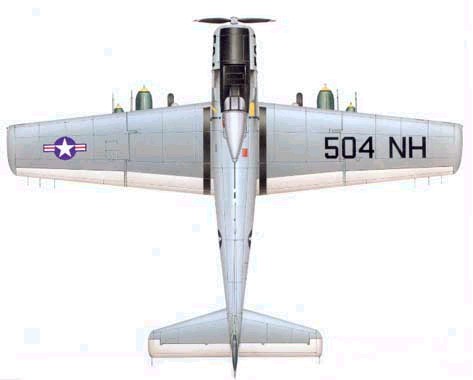
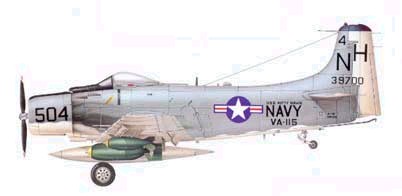
One benefit of a fixed-wing attack U/MCAV Killer Bee is that they can fly with greater weapon loads for longer periods of time than either fast jets or slow helicopters since they require less power to remain aloft and thus burn less fuel because their props only need to keep the aircraft moving forward for air flowing over fixed wings while helicopters with rotary wings must keep their entire wing area spinning to create their own lift.
This is not a new revelation! However its a reality of planet earth physics that egotistical fighter-bomber jet jocks do not want to admit: that some missions like finding hiding enemies are best done using simpler, slower fixed-wing aircraft at lower altitudes, and the rotorheads don't want to admit that slow, loud mechanically complex helicopters with short ranges are not best, either.
How did we get into this too-fast-with-jets, too-slow-with-helicopters Mess?
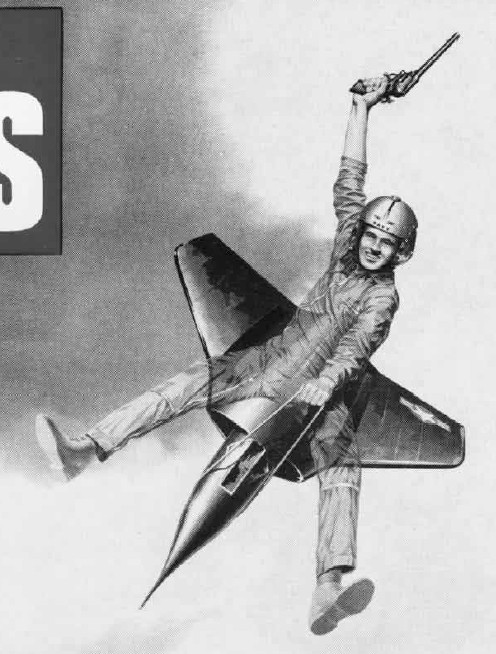
Essentially all the U.S. military services are run by self-worship narcissism. Egomaniacs don't want to admit they have any limitations on their path first paved by Nimrod to Tower of Babel ruin to become "gods". Narcissists don't admit that The Battle Against The Earth (TBATE) is the first military foe and you can see this repeatedly reading about constant pilot-error and engine and airframe created aircraft crashes in the U.S. Naval Aviation News "Granpaw Pettibone" section. This man worshipping hubris has over the years extended to aircraft designs which have become more and more mechanically complex making aircraft less able to beat TBATE to even make it into the air and makes them prone to mechanical failures and crashes.
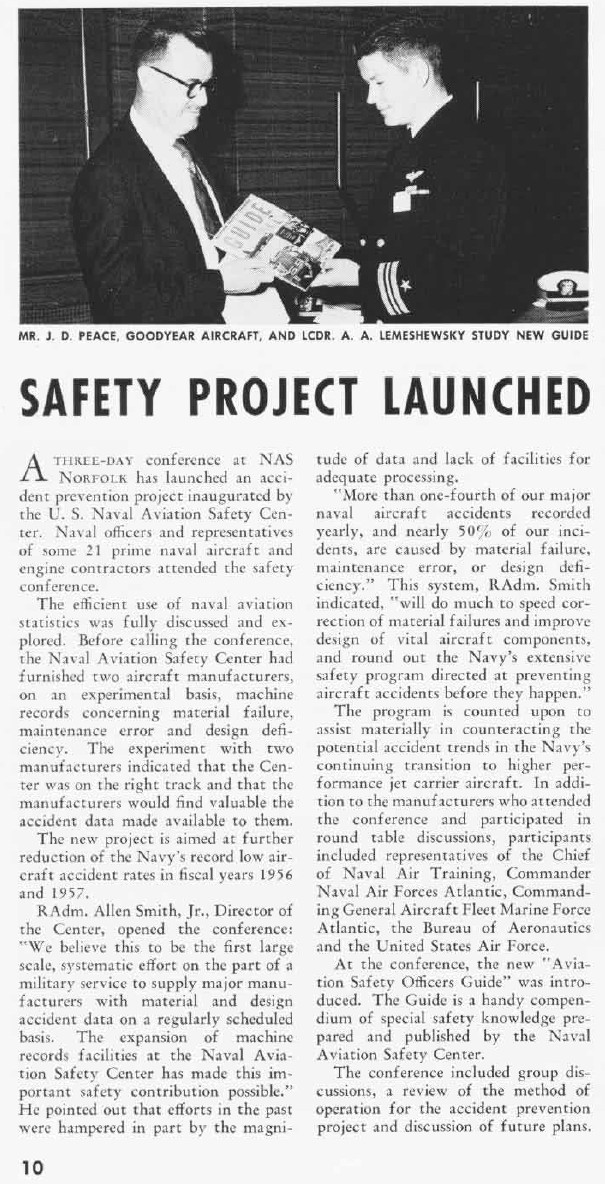
As costs increase with complexity, we get Spinney's "death spiral" where we can buy less and less aircraft until we are out of the air force business entirely, which is where Army and marine ground forces are now today: they do not have 24/7/365 air cover looking out for the enemy below them today in Iraq/Afghanistan. Flying model airplane UAVs with a 50% crash rate and can't see with any near the fidelity of human eyes from aircraft overhead that can investigate has not worked around corporate greed and pilot ego to effect maneuver air support (MAS). The men on the ground getting blown up by landmines are full of their own pride and egotism and don't want to admit they need help from the air, least of all the insufferable pilot egomaniacs and look down on their own fallibility and think they don't need armored tracks and insist on riding in rubber-tired wheeled trucks so they don't look like a "mech pussy" but damn themselves to roads/trails where the enemy free to lay landmines at will awaits to press the detonator.
Aviation legend and war futurist, Chuck Myers recently concluded that in times of peace folks are just pre-disposed towards flying faster and higher with the excuse that they are to shoot down mythical Soviet air force MIG fleets rather than focus on wars on the ground which are ugly. So without a war to keep the U.S. military focused, it tends to want to be a "NASA in military colors". Certainly TBATE is funner and less dangerous than TBATE + The Battle Against Man (TBAM). However, if you are going to lick TBATE, lick it with SAFER aircraft designs like our LARA 2 proposals in the previous Killerbees 2 web page ie; have HUMILITY--not hubris.
Leading up to the Korean war, the advent of jet engine propulsion creates a growing trend to fly higher and higher above the battlefield and requiring longer and longer runways so while both in the air and on the ground the flyboys are further and further distant from the ground force underclass. These runways whether on land or at sea are easily detected and attacked by enemies.
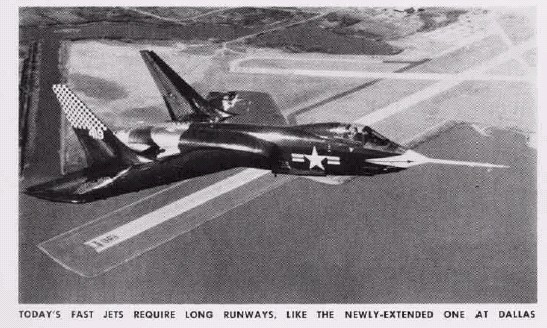
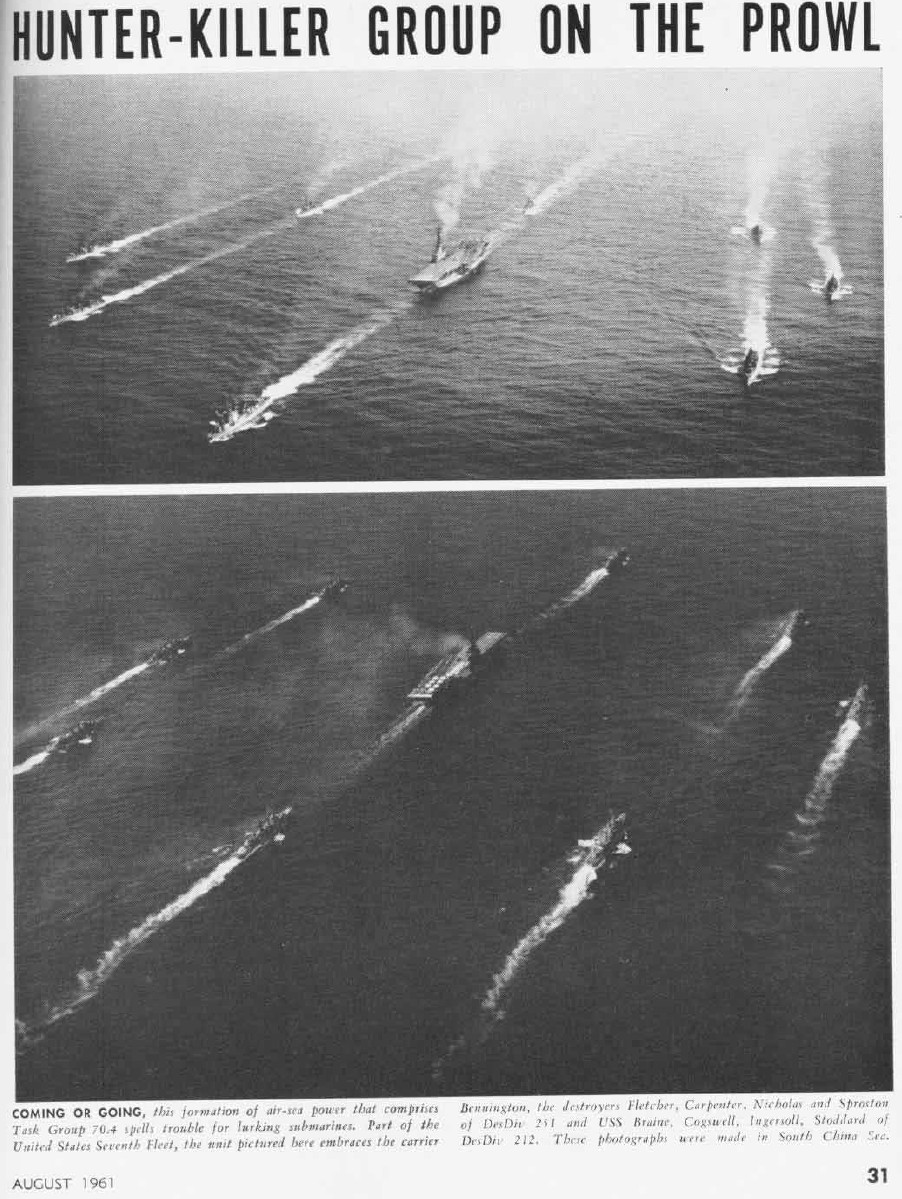
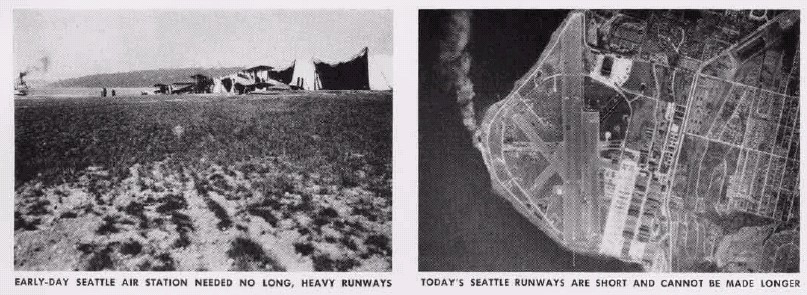
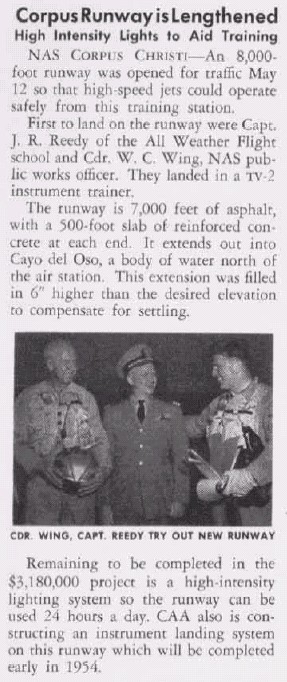
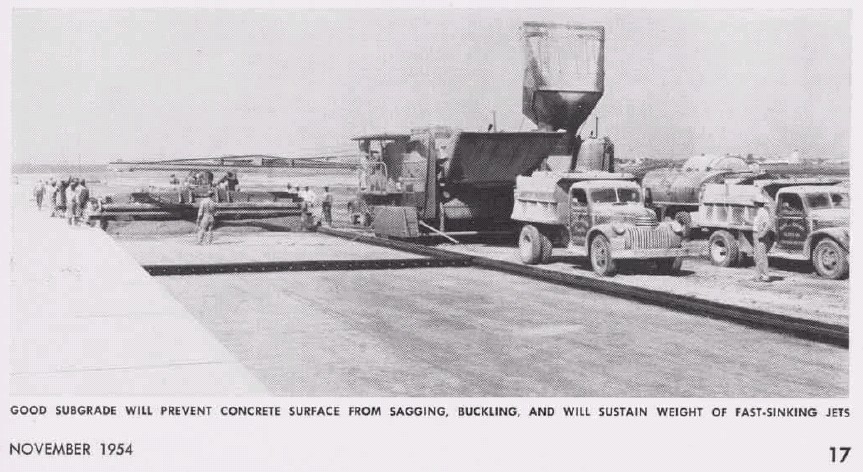
Consider the silly non-sense hubris leading up to the Korean War about "jets doing it all" as seen in U.S. Naval Aviation News August, 1950 pages 9, 10 and 11:
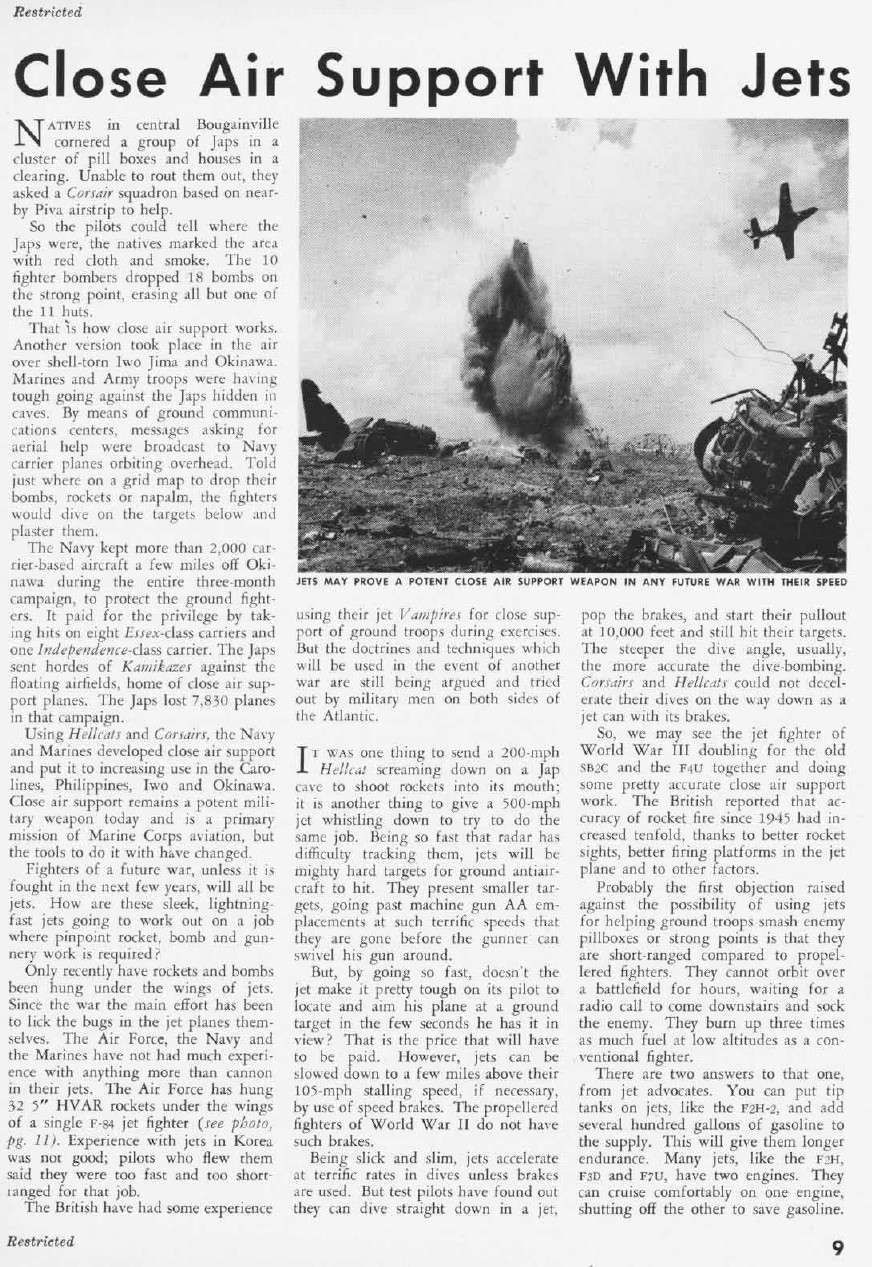
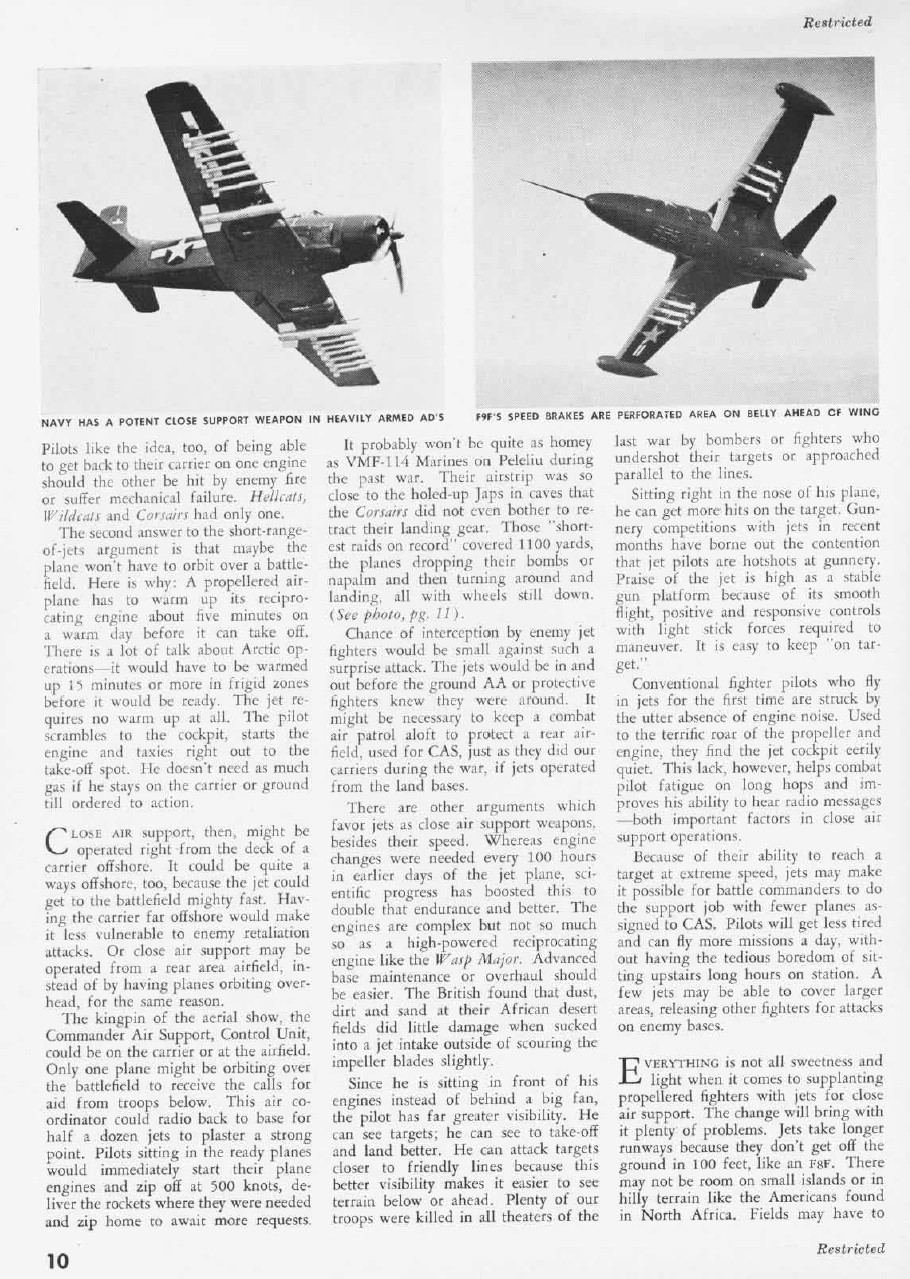
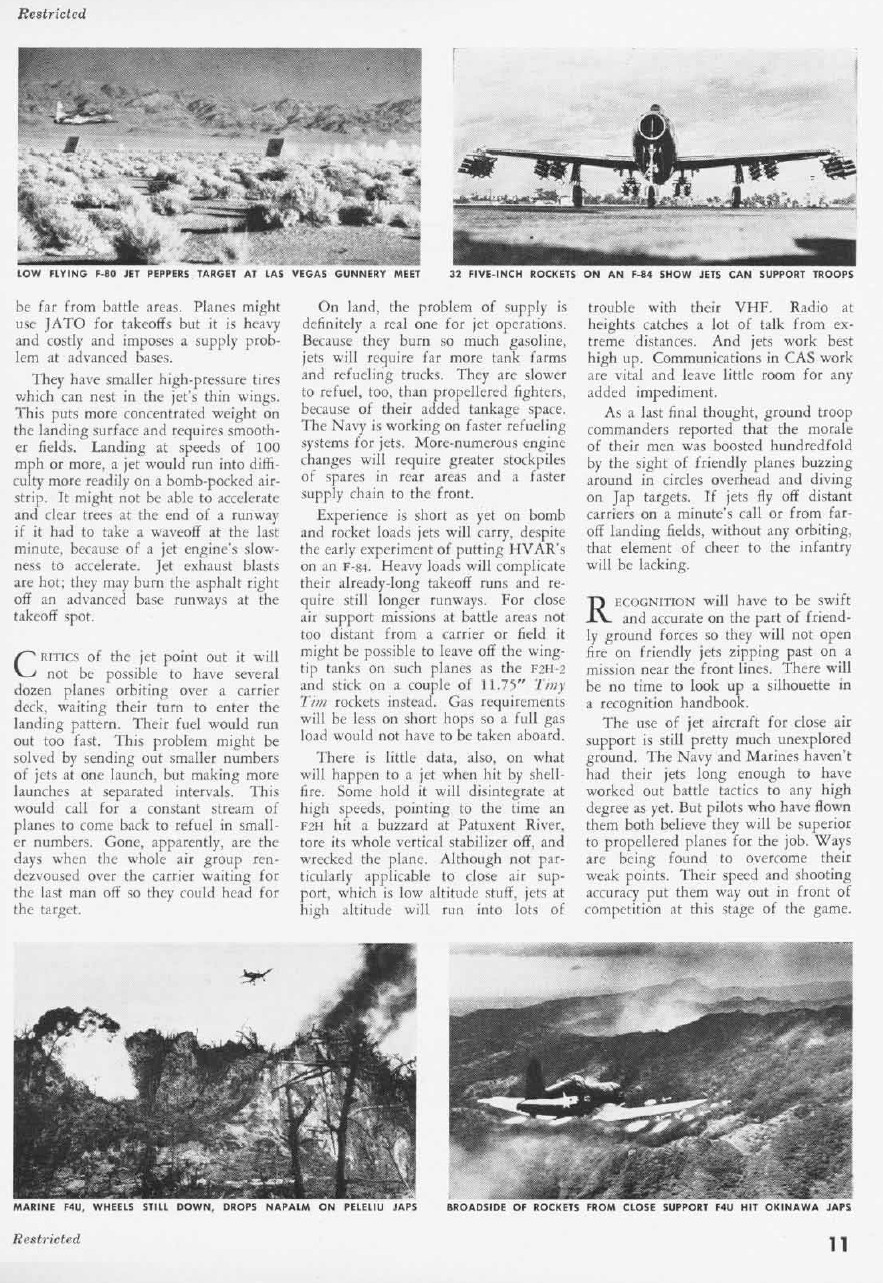
Bring back the Prop planes! Korean War Reality Check: Jets Fail, Props Save our troops on the Ground: We go with Less Than Optimal Aircraft
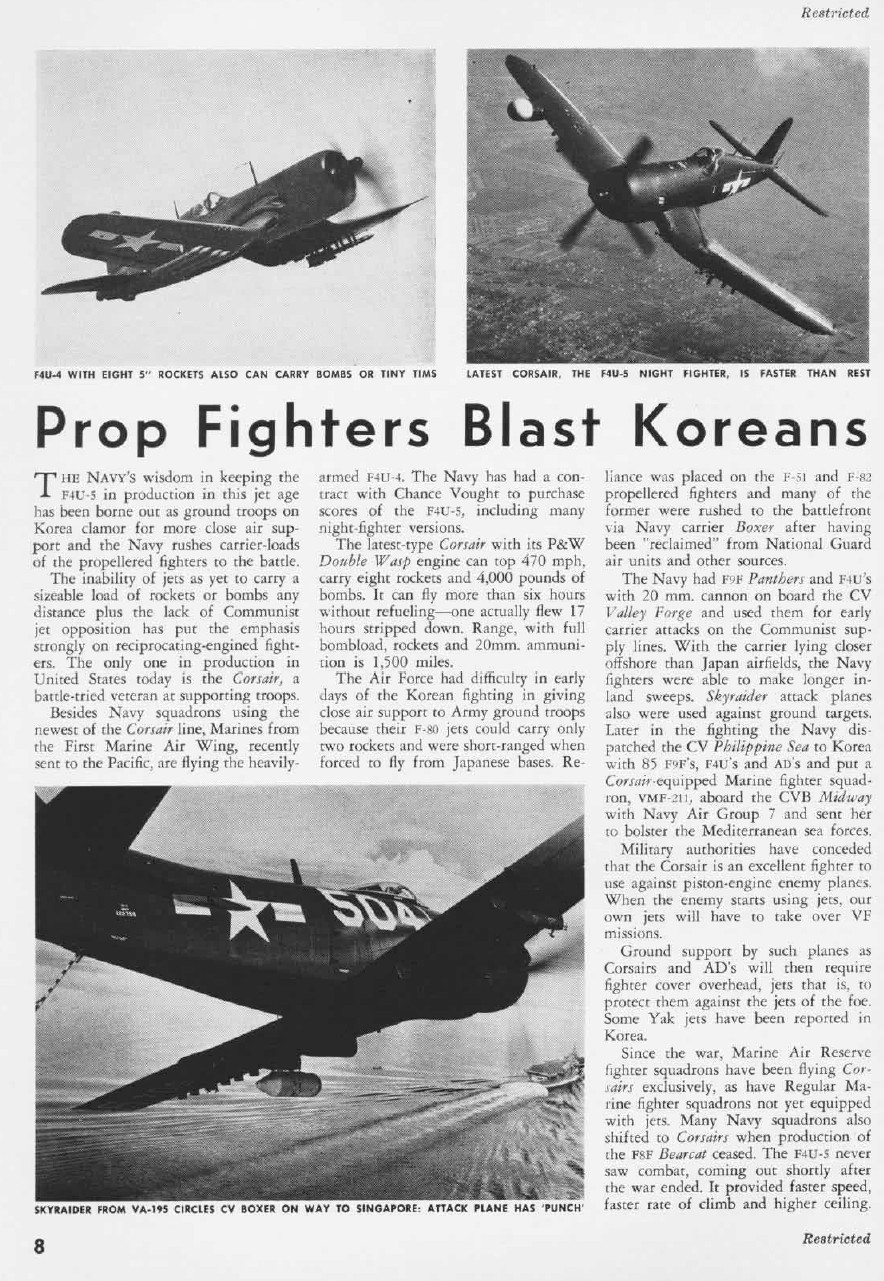

Just a few weeks after this jets-can-do-everything crap was printed the Korean war broke out and the jet pilots couldn't see shit diving in at 600 mph...
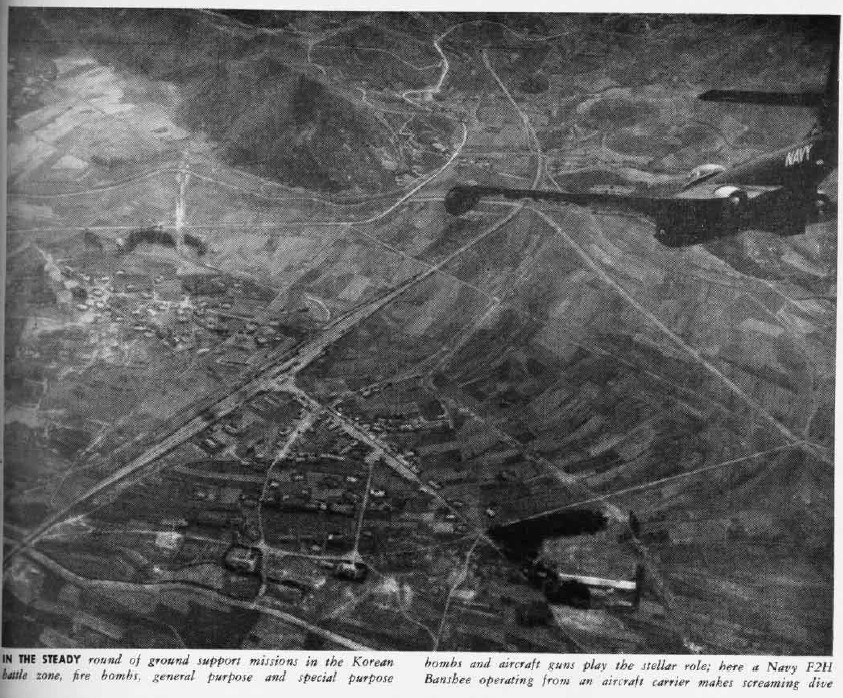
...and only because we had left-over WW2 prop attack planes that we were able to stop our ill-prepared foot-infantry ground troops from being over-run.
Bring back the Ground Forward Air Controllers (GFACs)!
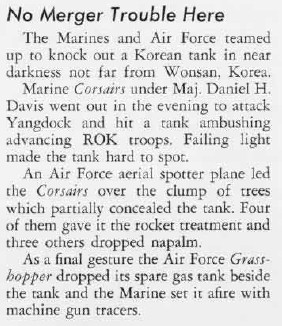

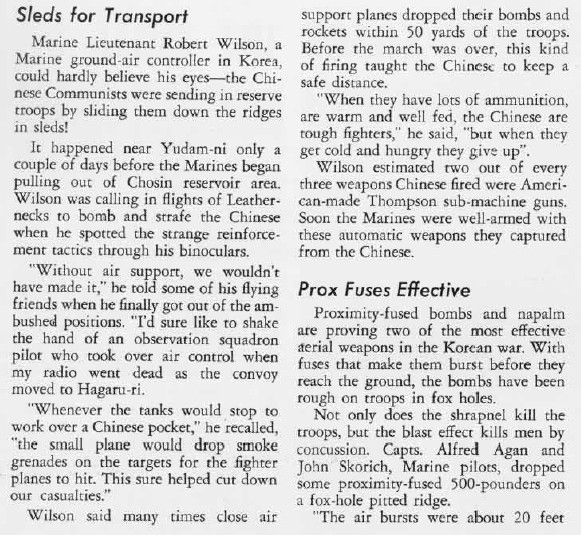

F-4U/AU-1 Corsair
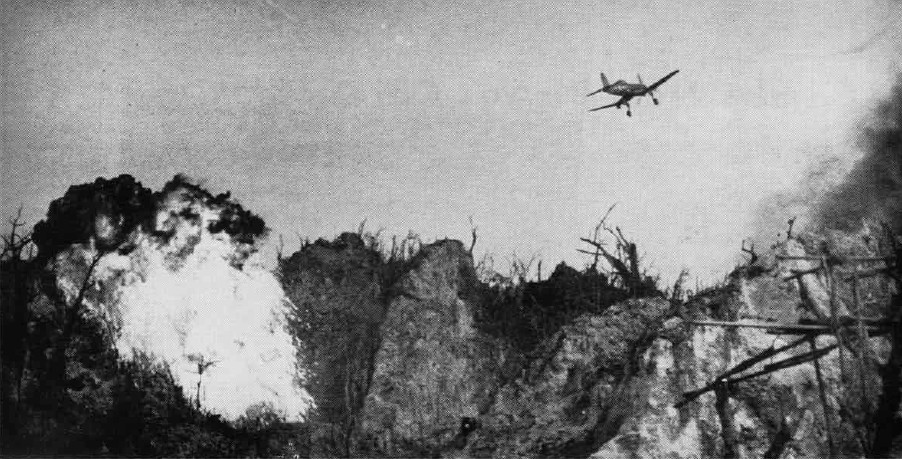
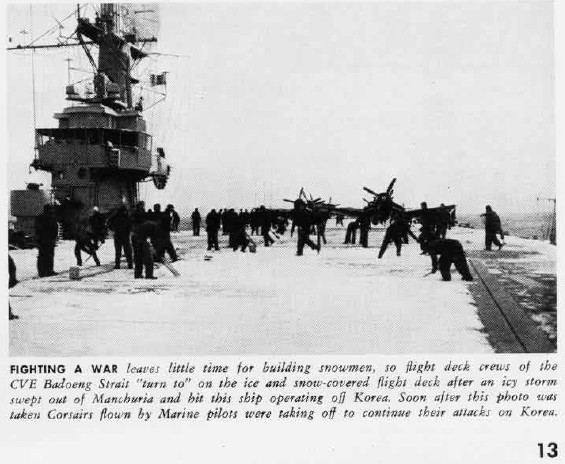
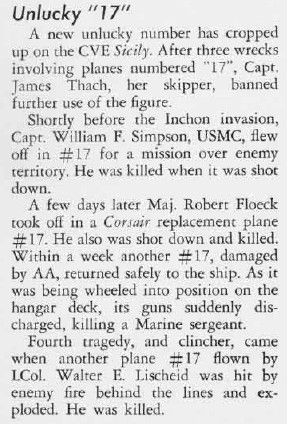
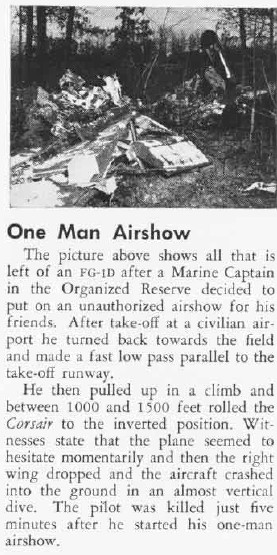
The Corsair was designed by Igor Sikorsky in the 1930s to shoot down other airplanes by the maximum speed possible from the largest engine possible.
BEFORE
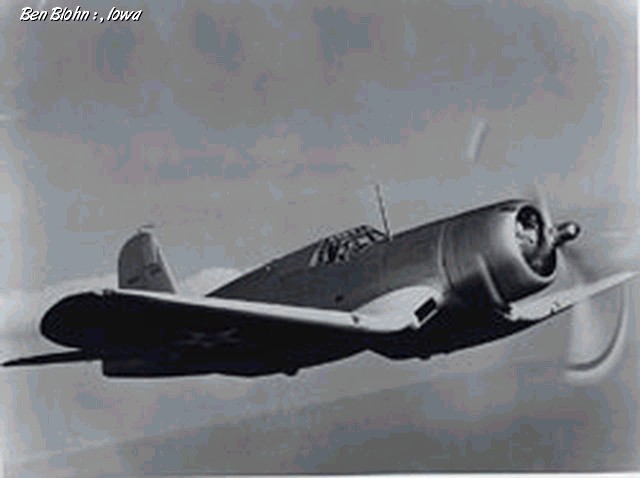

AFTER
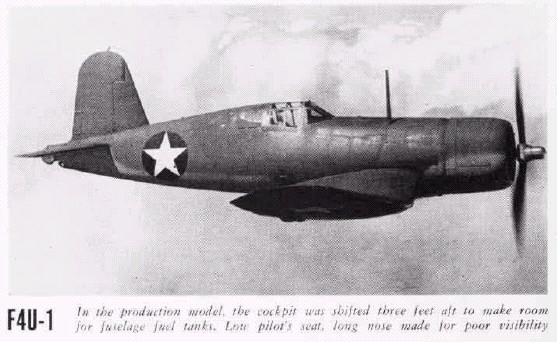
This caused them to bend the wings to lower the landing gear for a huge prop, but they placed dangerous fuel tanks in front of the pilot making for a long nose making it difficult to see during taxiing and landing. With massive torque the Corsair's left wing would drop suddenly when coming in to land causing all that volatile aviation gasoline to burst into flames. Difficult to fly, but able to carry more ordnance than the easier-to-fly Hellcat which was used to shoot down more Jap planes in WW2, the Corsair outlived the former which was replaced by jets to do the fighter role. Able to take-off in 360 feet, the Corsair was able to operate from dirt strips to do ground attacks using its landing gear as dive brakes.
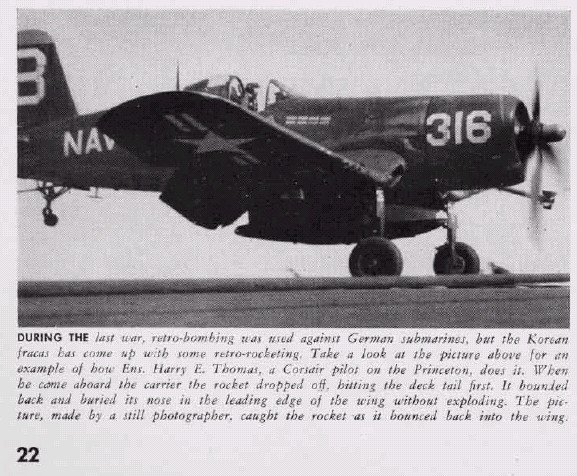
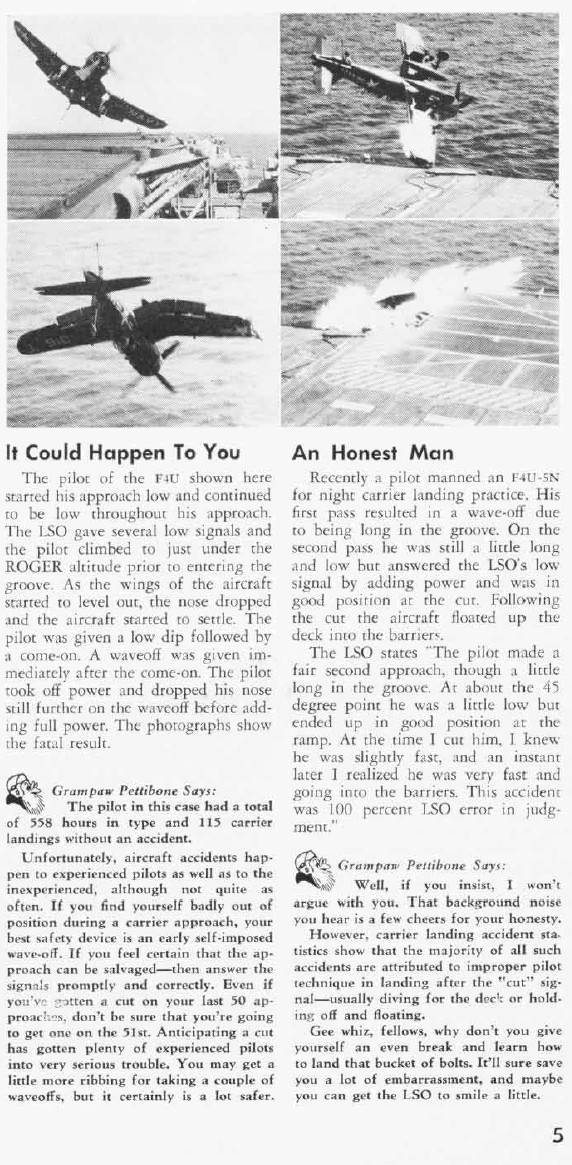
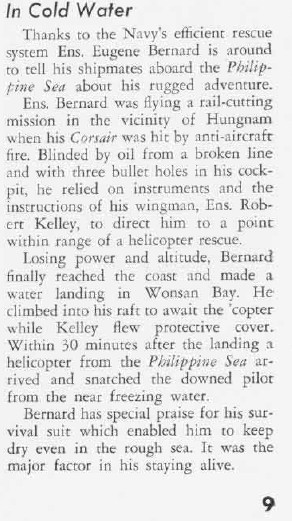
The Corsair was a less-than-ideal attack plane since it really was a prop plane air superiority fighter to shoot Jap Zeros that was only kept around as a second-class citizen doing ground attack because of the insistence of WW2 ground troops. Ditto this for the P-51 Mustang. Greg Goebel writes about P-51s in the desperate days in Korea:
Although the F-82G served an important role in the first few weeks of the Korean conflict, it faded into the background once the U.S. arrived in real force. In contrast, the old P-51D, by then redesignated "F-51D", was a star player through the first year of the war, back in the original Mustang assignment of "mudfighter".After the end of WWII, piston-engine fighters were rapidly phased out of front-line service in favor of new jet fighters, such as the P-80 Shooting Star. The USAAF retained a few squadrons of P-51Hs, but the older P-51Ds were passed on to the Air National Guard (ANG). As late as 1952, the ANG would still have 68 squadrons flying the Mustang, though the last of them would be gone in 1957.
Most of the remaining Mustangs were either sold to foreign operators or scrapped. In the early summer of 1950, the USAF had three fighter groups operating in Japan that had converted from the F-51D to the F-80, and the old F-51Ds were sitting in storage, waiting to be scrapped. When the war broke out on 25 June, the USAF realized that the F-51Ds were what was needed to help stem the North Korean offensive. The North Koreans, as noted, had no advanced aircraft, and the F-51D had better endurance and warload than the F-80, though some Air Force officers worried with good reason about the Mustang's well-known vulnerability to ground fire. The P-51D could also operate more effectively than jets from primitive airfields. The three fighter groups traded their F-80s back in for their old F-51Ds and were thrown into the battle.
The USAF also grabbed 145 F-51Ds from ANG units and rushed them to Japan on the carrier USS Boxer, which arrived in Tokyo on 23 July 1950. Two squadrons were equipped with the new arrivals, and were quickly flying dozens of sorties a day from rough airstrips behind the front lines in Korea. A squadron each of Mustangs was provided by Australia and South Africa. F-51Ds were also supplied to the South Koreans. The Mustangs struck at enemy columns with machine guns, bombs, HVARs, and napalm. Since the bombs and rockets were not particularly accurate, napalm was the preferred weapon for attacking formidable North Korean T34 [medium] tanks, since a napalm bomb saturated a wide area with fire. The attacks were made at low level, however, and Mustang attrition was high. The notorious vulnerability of the Mustang's cooling system was a particular problem. Some thought was in fact given to fielding a squadron of Republic F-47N Thunderbolts, which were better close-support aircraft, but the aircraft were simply not available.
By the fall of 1950, the North Koreans were on the run, and the Americans and their allies were pursuing them into North Korea. Mustangs ranged freely with little air opposition. They claimed five kills during this time, their only air combat victories of the war.
In early November, Mustangs began to encounter fast-jet MiG-15s, and it was only due to the skill of the Mustang pilots and the inexperience of the enemy that the F-51Ds were able to survive. By the time cold weather set in, Chinese forces were pouring into North Korea, driving the Americans and their allies south in a fast retreat that stopped at the South Korean border. The front lines stabilized there and a static war of attrition followed.
With the USAF countering the MiG-15 with the North American F-86, the air combat environment became increasingly too dangerous for piston engine fighters like the F-51D. Most units equipped with the Mustang converted to jets, and by the end of the war in July 1953, only one USAF squadron and some South Korean units were operating the Mustang.
A total of 194 F-51Ds were lost in the war. 172 were destroyed by ground fire, 10 were shot down by enemy aircraft, and 12 were lost to unreported causes.
The SkyRaider was much safer to fly than the Corsair, and far sturdier than the Mustang and could lift more ordnance but it was originally a ship "killer bee" to operate in swarms to sink Jap ships. With no nation-state war Air Force and navies with convenient target patsies comparable to their speeds, they were sent in do ground attack with inadequate armoring and dangerous aviation gasoline as their fuels. Some may ask, WHERE DID ALL THE STURDY ATTACK P-47s GO? (they were given away to friendly air forces).
Corsairs, SkyRaiders and Thunderbolts all used fat air-cooled, radial piston engines which offer a lot of frontal drag and burn a tremendous amount of fuel to create thrust to get their speed. This "brute force" approach made them all gas hogs, hence they had to carry more fuel to get the same ranges a fuel-sipping less frontal drag P-51 could achieve with a liquid-cooled inline engine. Huge amounts of fuel in the airplane make it vulnerable to fire/explosion if hit by enemy fire and as seen in the Corsair compromise the design to ruin pilot visibility by long noses of an already difficult to control machine.
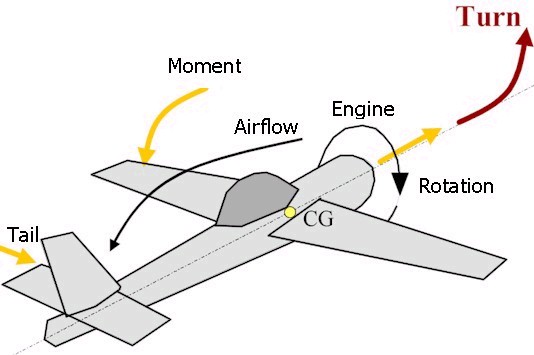
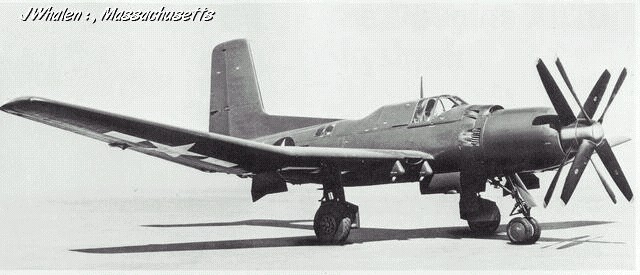

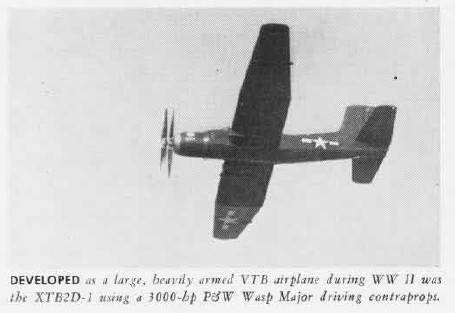
ALL of these single props driven by huge amounts of horsepower have torque problems that can kill pilots on landing and take-offs. The Navy began to try to contraprop piston engined planes to solve this pilot-killing problem starting in WW2. The jet jocks conveniently did not let this problem get solved by contraprops to keep their competitors down and eventually to force them out of the service.
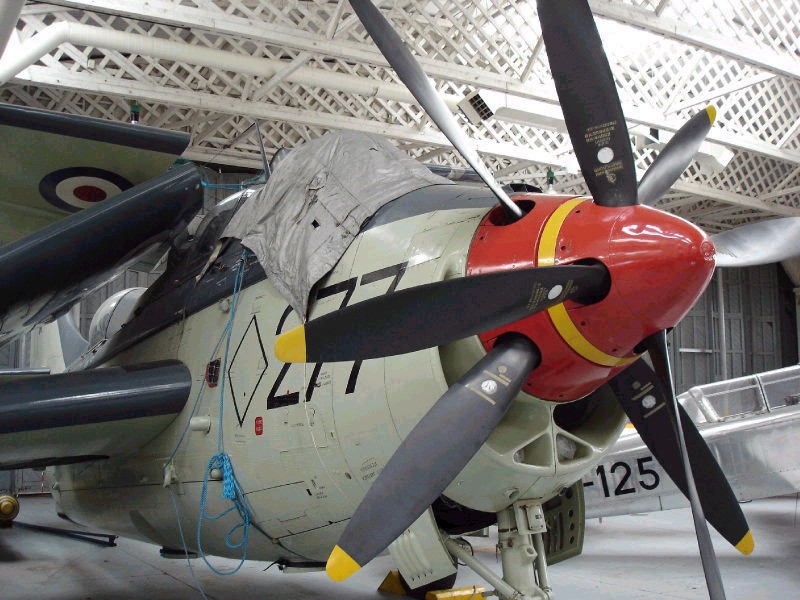
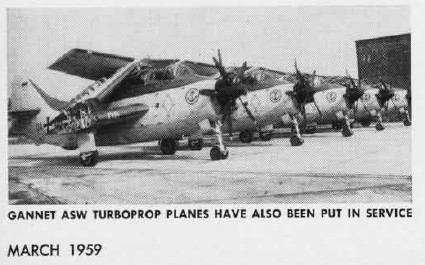

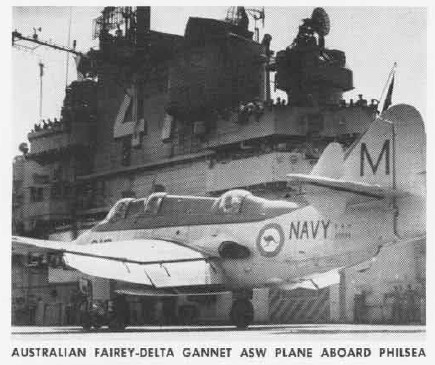
The British and Russians could figure out how to make reliable contraprop powerplants, but we Americans "gave up" after only one try with the Allison XT40 in the 1950s. We could have placed the Gannet's contraprop engine powerplant into P-51s and/or SkyRaiders so we have no excuse.
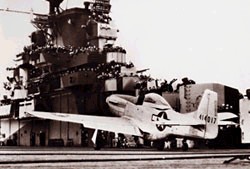
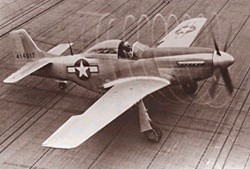
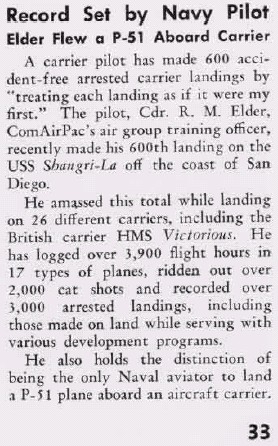
During WW2, the navy tried P-51s on aircraft carriers and found they were suitable but did not employ them having already invested too much ego and $ in their air-cooled gas hogs. Another downside of fuel hungry planes is that more fuel in the aircraft carrier compromises its safety in event of air attacks. In retrospect, had the Navy and Army/AF cooperated on a joint navalized P-51 as an ATTACK PLANE they could have ARMORED IT so its vulnerable inline engine would not make it easy to shoot down. We could have entered WW2 with a contraprop turbine-engined P-51 (with perhaps an emergency jet engine in the tail) HAD WE VALUED CLOSE AIR SUPPORT and not been off zooming into the "Wild Blue Yonder" with jets.

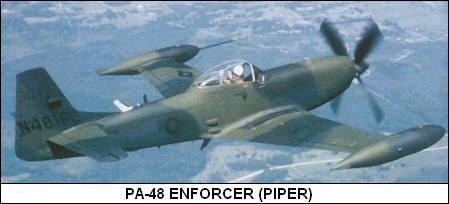
It would have been...the Piper PA-48 Enforcer 20 years before it arrived 20 years too late. Greg Goebel writes:
Even in the 1960s, there were those who felt the Mustang still had plenty of potential. One of these was David B. Lindsey JR, who established a company named Trans-Florida Aviation, which rebuilt several Mustangs into a two-seat "executive transport" named the "Cavalier". The Cavalier Mustang attracted enough attention to lead Lindsey to rename his company "Cavalier Aircraft Corporation" in 1962, and acquired the Mustang type certificate and tradename from North American.The Cavalier Mustang was available in a range of versions, including the "750", "1200", "1500", "2000", and "2500". They were all very similar, the main difference between the variants being an increase in fuel capacity up the numbering sequence, with the Cavalier 2000 and 2500 adding fixed wingtip tanks with a capacity of 416.5 liters (110 U.S. gallons) each. Cavalier also appears to have fitted out aircraft as per user request, making most of them custom jobs to a degree.
In 1967, Cavalier developed an updated Mustang for the counter-insurgency (COIN) role. The "Cavalier Mustang II" was a rebuilt P-51D, with a new Packard Merlin V-1650-7 engine; improved avionics; the taller tailfin used on the F-51H; fixed wingtip fuel tanks as per the Cavalier 2000 and 2500; and a reinforced wing to support a total of eight stores pylons, permitting a total stores load of 1.8 tonnes (4,000 pounds). It also featured a second seat for an observer behind the pilot. Images of Mustang IIs seem to show that they had a canopy with a bulge in the rear to provide headroom for the back-seater, but it is unclear if this was a standard fit.
As with the Cavalier Mustang, the company seems to have manufactured a number of variations on the Mustang II, building them with such features as required by a specific order. It is also not clear if they were all actually referred to as "Mustang Iis", but since the matter is both complicated and not very interesting, all the Cavalier military Mustang conversions are referred to by that name here for simplicity.
That same year, 1967, the USAF ordered a batch of Mustang Iis for delivery to friendly Latin American and Asian nations under the U.S. Military Assistance Program (MAP). The next year, 1968, the U.S. Army ordered two more Mustang Iis as chase aircraft for the YAH-56 Cheyenne helicopter gunship program, and used them in short-lived experiments in close-support applications after the Cheyenne program was cancelled. The USAF ordered a second batch of Mustang Iis for MAP in 1972.
In 1968, Cavalier fitted a Mustang with a Rolls-Royce Dart 510 turboprop with 1,245 ekW (1,670 eHP), calling the modified machine the "Cavalier Turbo Mustang III". Cavalier tried to sell the concept to the Air Force, but the service wasn't interested. Cavalier then sold the Turbo Mustang III to Piper Aircraft and transferred the technology base for the work along with it. The Turbo Mustang III was delivered to Piper in November 1970.
The USAF was interested in a more formidable COIN aircraft for supply to U.S. allies under MAP, and had initiated a program named "Pave Coin" to evaluate such a machine. Piper felt that a turboprop Mustang would fit the requirement, and converted an F-51D and a TF-51D to a configuration with a Lycoming T55-L-9 turboprop engine, with 1,830 kW (2,455 SHP). Piper gave the up-engined machines the name of "Enforcer", and the first flew on 19 April 1971. The USAF evaluated one of them, but had cooled to the program and the evaluation led nowhere. However, Congress was very interested in a relatively low-cost close-support aircraft, and pressured the Air Force to award a contract for two "PA-48 Enforcer" prototypes in September 1981. The two PA-48s were also powered by the Lycoming T55-L-9 turboprop, but they were not only completely new-build machines, they were almost entirely new designs.
The PA-48s were clearly members of the Mustang family, but they were also clearly bigger and meaner looking. They were 38 centimeters (15 inches) longer, with a bigger tail and a four-bladed paddle propeller; were fitted with plastic armor and self-sealing tanks; and their wings bristled with a total of ten stores pylons. There was also provision for wingtip fuel tanks. They did not have any built-in armament, the plan being that they would carry underwing gun pods instead, and had an ejection seat.
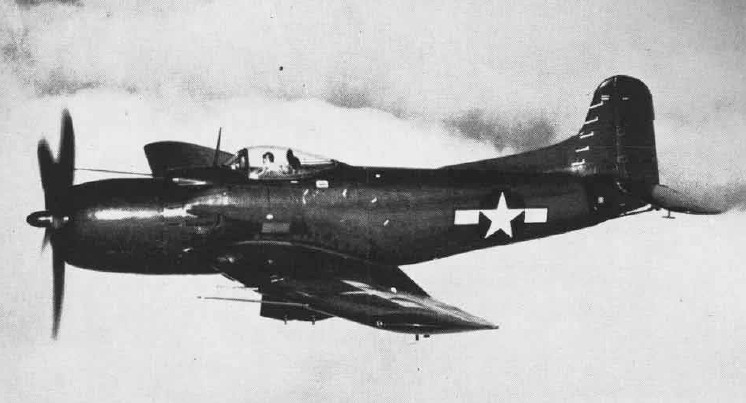
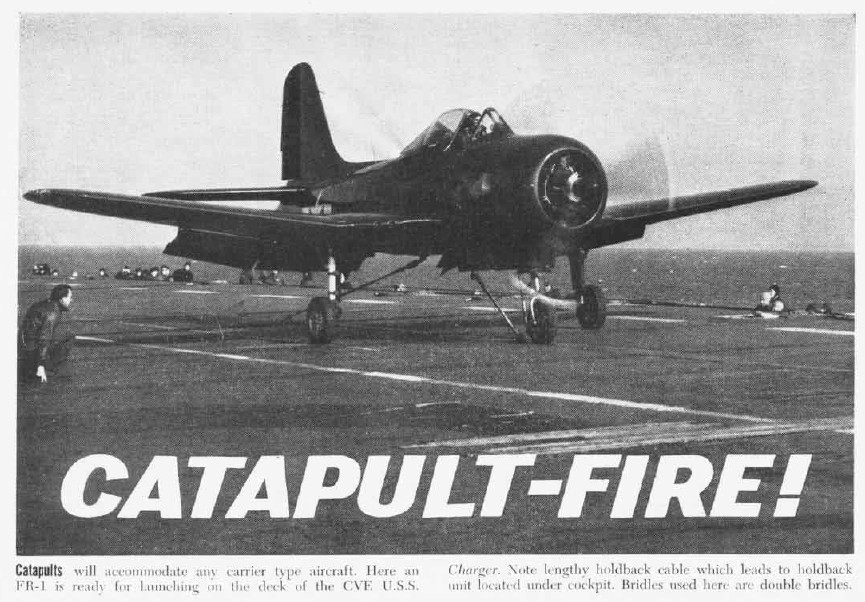
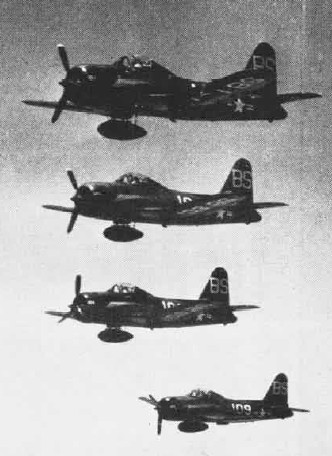
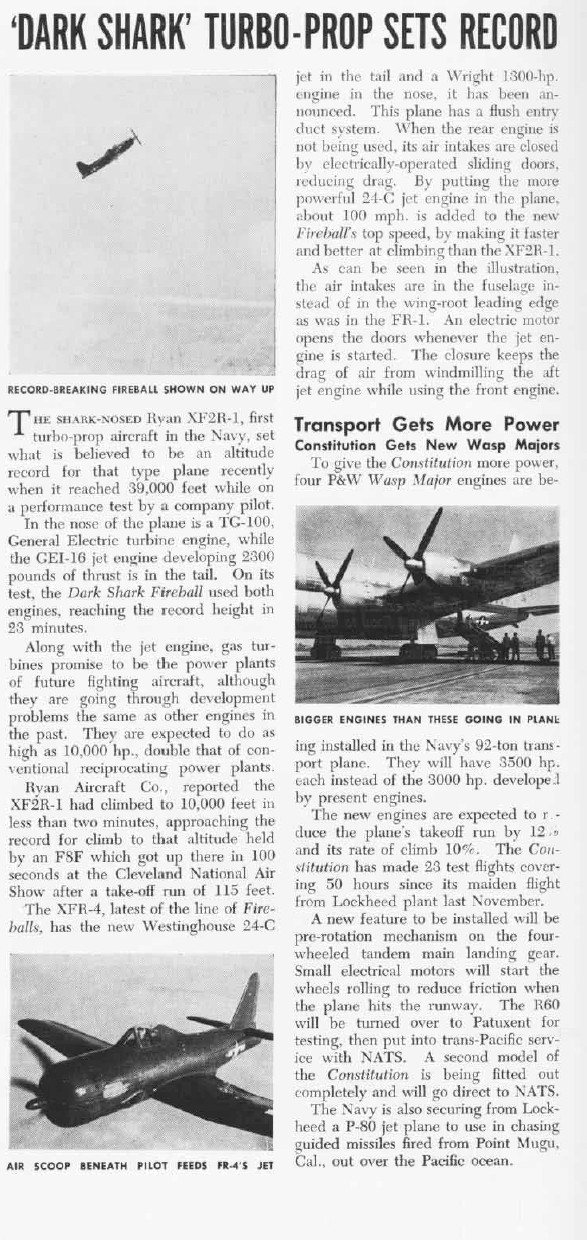
Both the Navy and AF had the Fireball/Dark Shark and XP-81 programs showing them new designs that could have done ground attack but they were both fixated on air duels faster and higher. There's no "ace" and "top gun" glory in ground attack.
Since we can't find/hit the enemy maneuvering against our troops (Close Air Support) in close proximity with jets or naval helicopters we use WW2 prop planes, and have the jets hit obvious targets like bridges and rail yards (interdiction). The Navy didn't realize switching their SC-1/2 SeaHawk fixed-wing observation/attack planes for slow and short-range helicopters was a huge mistake and/or wanted to undermine their cruiser/battleship gunnery to prop up their aircraft carrier mentality. The Royal Navy didn't mind where their air gunfire spotter help came from and kicked ass as the story below reveals:
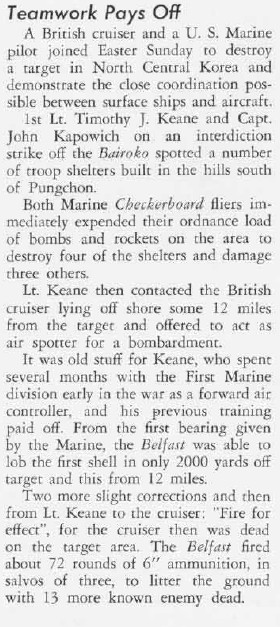
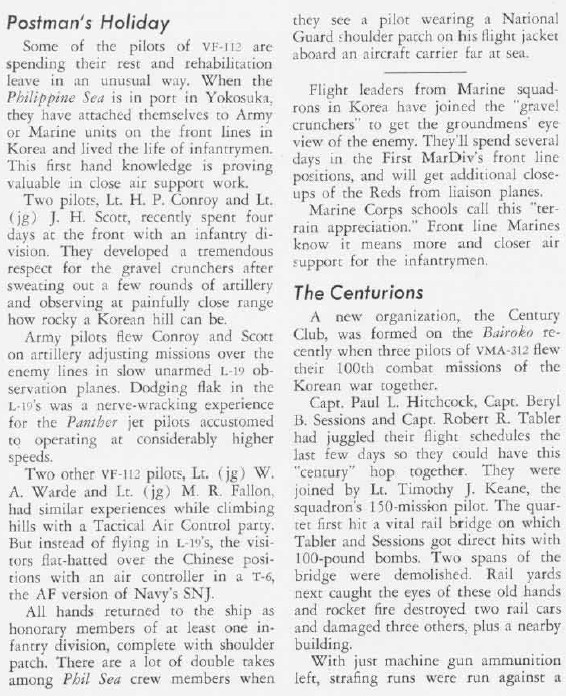
When the less-than-ideal WW2 prop planes began to get shot down, we realized bailing out would no longer suffice and began to field ejection seats--for jets first of course! We began to add armor, drop survival gear to downed pilots, and rescue them by helicopters and STOL grasshoppers fixed-wing planes...

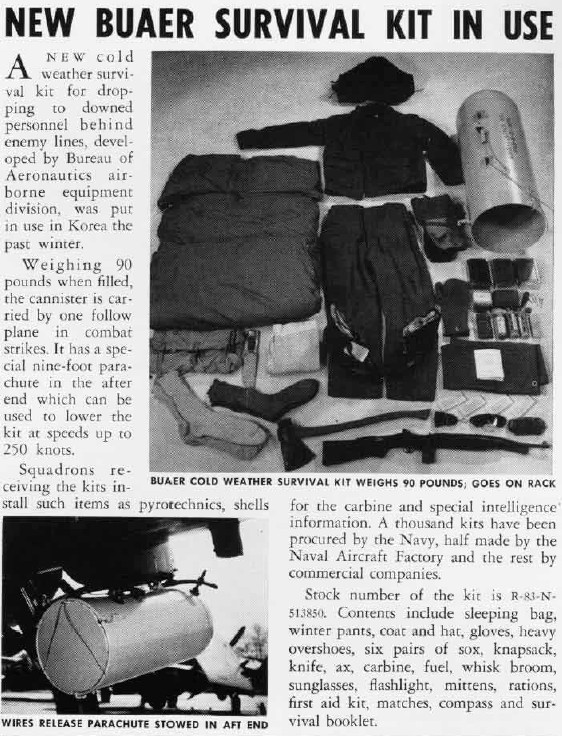
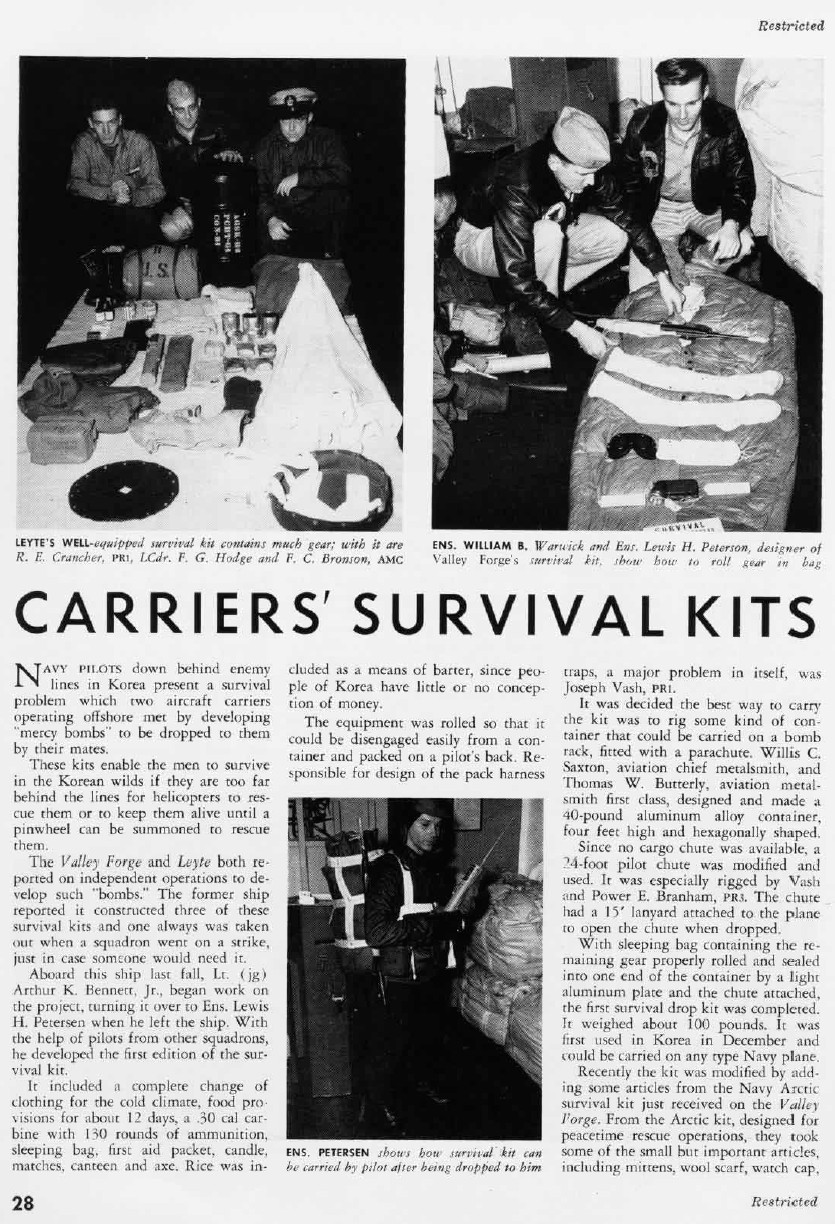
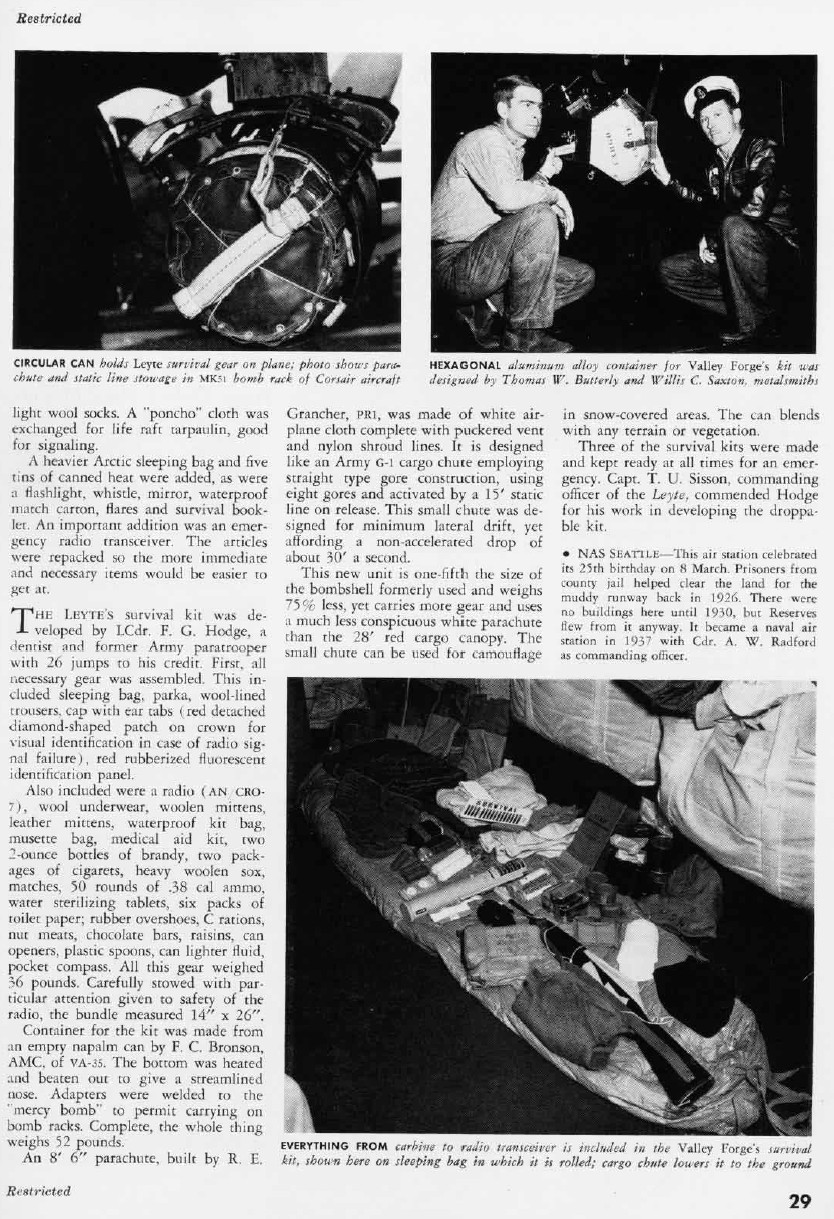
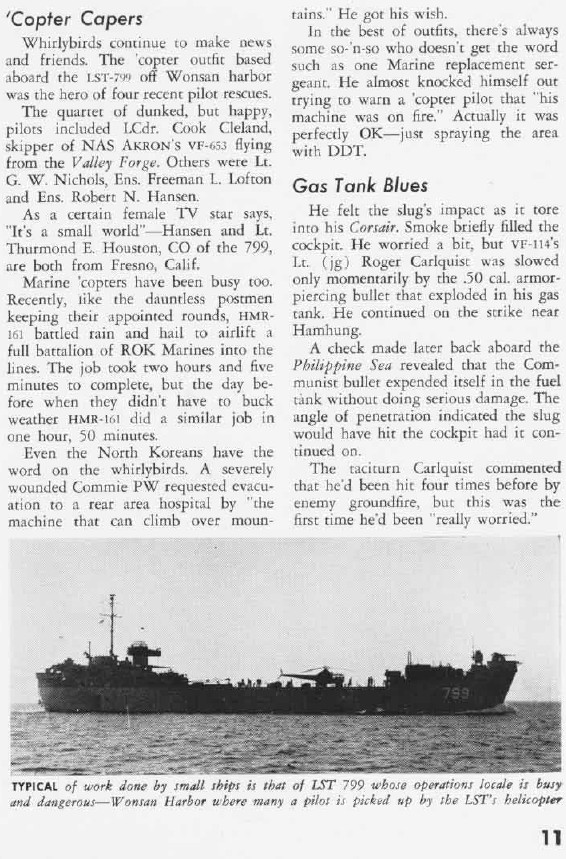
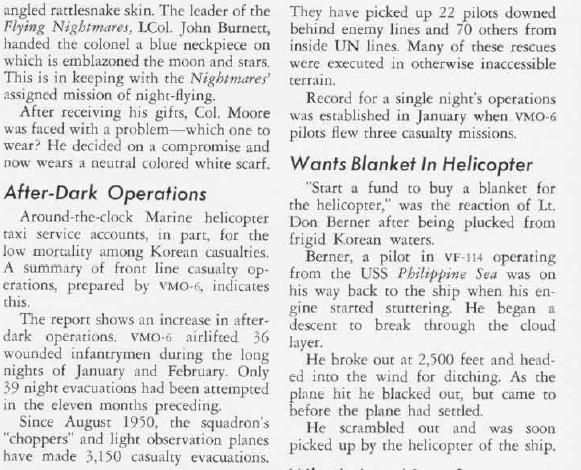

However, a lot of them were shot down in absurd dark blue paint schemes and inadequate armoring. The Navy/marines never realized their camouflage was bad but they did try to improve the armor in the AU-1 version they bought.
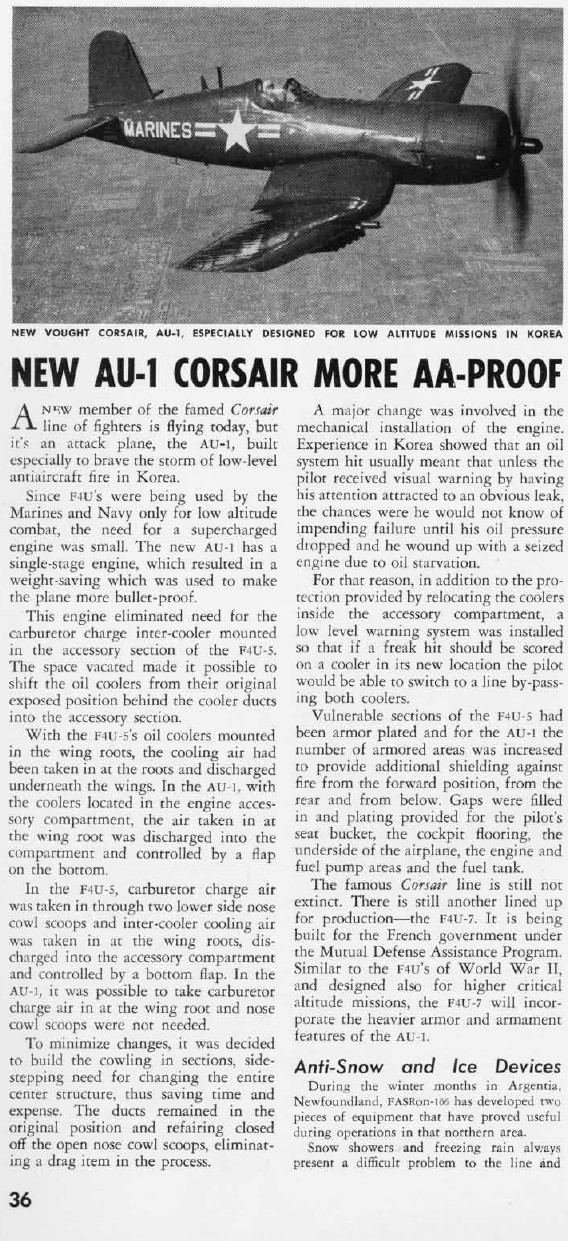
Even though the AU-1 was greatly armored, the Corsair was an "Ensign Eliminator" and killed almost as many of its pilots as it did the enemy, which is one of the perils of taking a plane designed for one thing and trying to make do with it for something else. The Corsair pilot did have an ability to look down at the ground at targets at the gull juncture without having to bank the entire plane;
http://en.wikipedia.org/wiki/F4U_Corsair
"A straight, low-wing design would have blocked most of the visibility from the cockpit toward the ground while in level flight, but a Corsair pilot could look through a 'notch' and get a better ground reference without having to bank one way or the other to move the wing out of the way."
However, the Corsair did not have a back-seat co-pilot/observer to prevent flying into the ground from target fixation or just to ease the work-load of looking for the enemy on the ground and MIGs in the air and flying the temperamental plane.
AD-1 SkyRaider
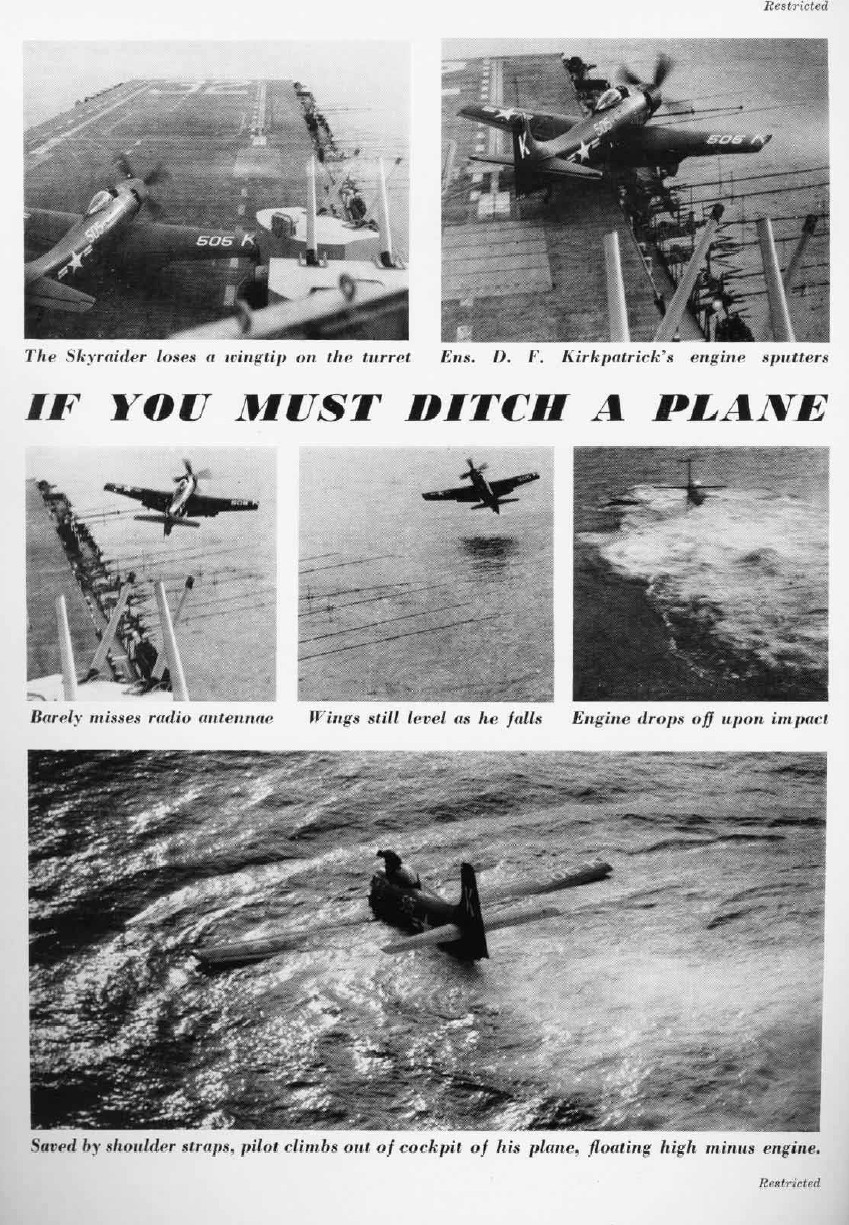
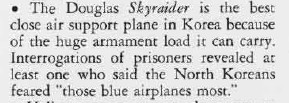
Heinneman's SkyRaider was designed as a dive and torpedo bomber drawing from lessons learned from the WW2 planes. Though still using highly dangerous avgas, the fuel tank was armored and BEHIND the pilot. The pilot was in a 360 degree bubble canopy well forward of the wing to see ahead for targets and to land safely. Later models had armor after a lot of Korean shoot-downs made it obvious...
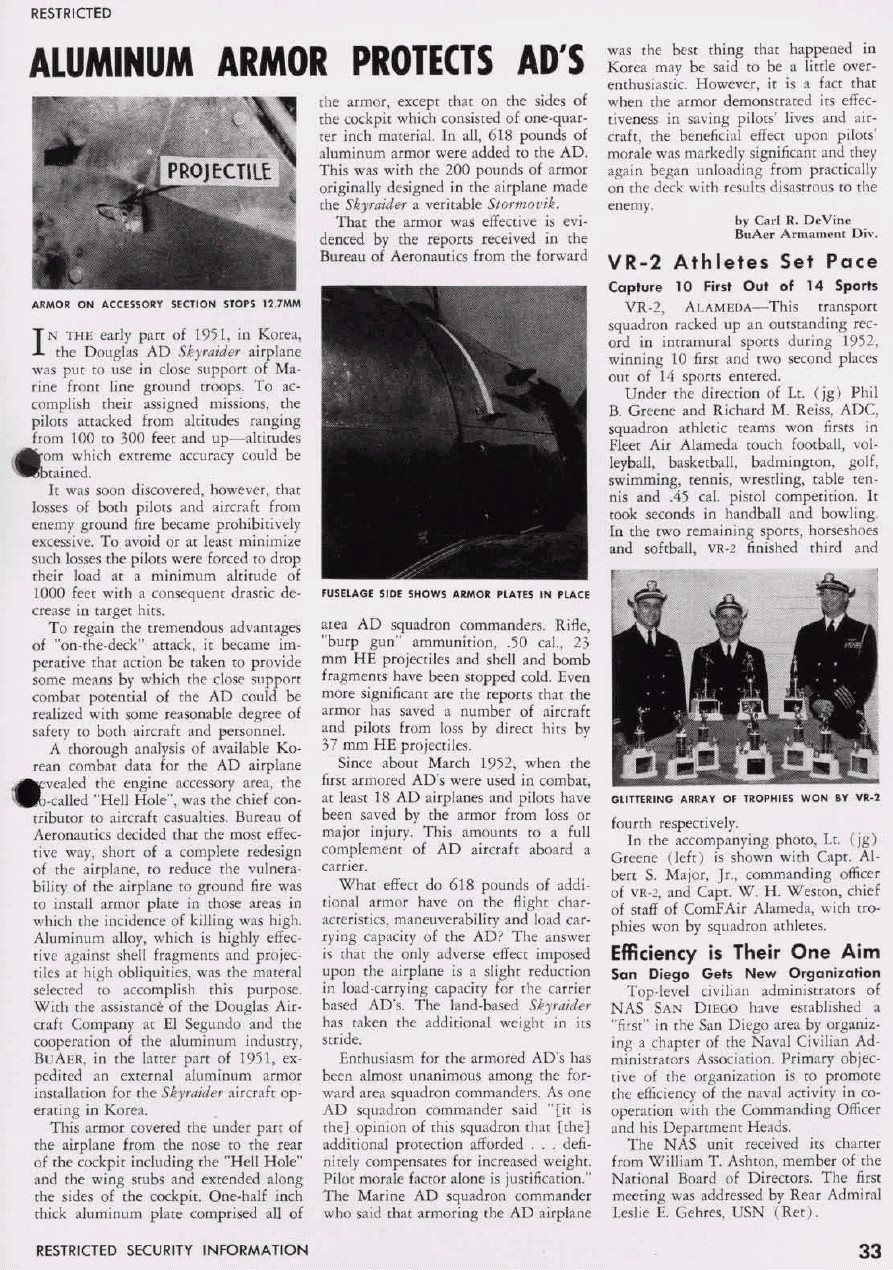
Final models even had ejection seats to escape at low-altitudes without fumbling with canopies that refuse to jettison which plagued the Corsairs.
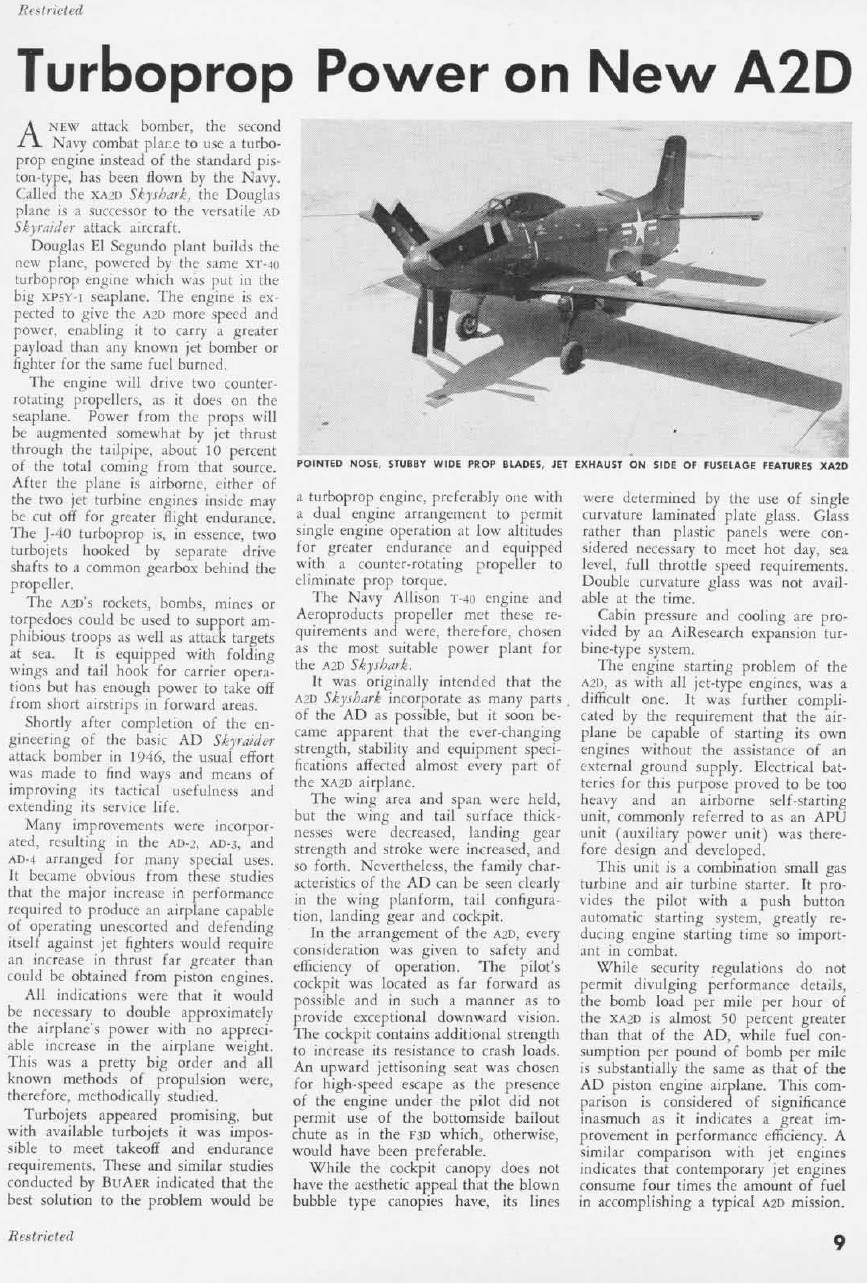
Still having torque problems, a contra-rotating turbine engine version was considered but given up on by the anti-prop plane fighter jet mafia causing production to end in 1957. Most SkyRaiders did not have a back-seat co-pilot/observer to prevent flying into the ground from target fixation or just to ease the work-load of looking for the enemy on the ground and MIGs in the air.
Target Fixation: Fatal for Single-Seat Piloted Aircraft
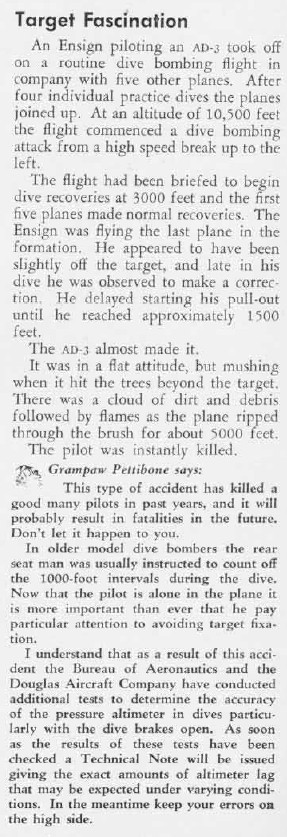
 www.youtube.com/watch?v=lbKLB7xNWhs
www.youtube.com/watch?v=lbKLB7xNWhs
The mighty SkyRaider soldiered on through the Vietnam war reaching a legendary reputation for killing the enemy and not its own pilots. Unlike the Corsair, some models had ejection seats to prevent having to climb out of a cockpit of an out-of-control plane and not get blown back into the tail. Its too bad that the SkyShark was not perfected to solve the torque and volatile fuel problems so we'd have a suitable MAS O/A aircraft and naval gunfire spotter and multi-purpose seaplane today.
Bring Back Airborne Forward Air Controllers (AFACs)
So we grudgingly knew even back in the '50s during the Korean War that most jets fly too fast and helicopters not fast and long enough! Before the advent of jets, we had STOL "Grasshoppers" that acted as Airborne Forward Air Controllers (AFACs) for artillery fires or prop-plane P-47 and other USAAF fighter-bombers. The Grasshoppers could be co-located with ground maneuver units because they could take off and land off grassy fields and roads or be moved by trucks!
Our first stab at a AFAC for jet and single-seat prop fighter-bombers was using the AT-6 "Mosquito".
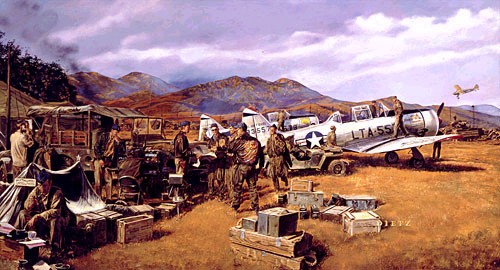
T-6 "Mosquitoes" in Korea
Image Size: 13" x 24" 600 Public Edition (Limited Edition, Signed and Numbered) 100 Publisher Proof Edition (Limited Edition, Signed and Numbered) 100 Artist Proof Edition (Limited Edition, Signed and Numbered)
The 6147th Tactical Control Group, nicknamed the "Mosquitoes", received a Presidential citation in 1951 for their performance in the Korean War. This citation was for the entire unit and without parallel in aerial warfare history at that time. The gallant Mosquito pilots flew unarmed and unescorted T-6 aircraft that were vulnerable to opposition from the air and ground. Yet these brave pilots flew at dangerously low altitudes over Communist positions searching for telltale signs of the enemies presence: freshly turned earth, footprints in the snow or a discarded tin can. Once a sign was spotted, the Mosquitoes flew down into the flak and marked their targets with smoke rockets. The North Koreans called them "Mosquitoes" because the sight of a North American T-6 buzzing down on them meant they were soon to be "stung". Shortly after the annoying buzz of the venerable Texan ceased, the screams of rocket-laden P-51 Mustangs or the new jet fighter, F-84 Thunderstreak, were on their way downhill to deliver death and destruction to the Communist supply lines. The T-6 tactical coordinators of the 6147th Tactical Control Group may have been "old and outdated", but as deadly hunting dogs that pinpointed game for heavily armed aerial hunters, they were universally feared by the enemy.
The speed of the fast fighter/bombers, particularly the jets, did not allow the pilots to adequately see and target the highly camouflaged positions and vehicles of the North Koreans. They needed small, slow yet maneuverable aircraft with an observer who could mark the enemy positions with smoke bombs or rockets. The T-6 was fast enough to evade enemy attacks, had adequate visibility to truly observe targets, could be equipped with the necessary communications gear (eight-channel AN/ARC3 radio sets) to talk the fighter/bombers into targets and could carry target rockets to mark sites. The men called to fly these missions lived a kind of gypsy life, they were moved from air base to airbase as the U.N. forces retreated southward from the North Korean flood. They were quite literally "Out On A Limb", not only needing to complete their operational objectives in the air, but also having to leave the ground staff of the group to move all their equipment to the next airfield down the line. We have largely forgotten the role of these daredevils in the T-6, but without the "Mosquitoes" - a raging outfit of professionals of one stripe or another - the Korean air war might have been a different story. By the end of the Korean War, the 6147th Tactical Control Group lost 42 aircraft and 33 men. The Mosquitoes flew over 40,000 sorties aiding in the destruction of 5 tank divisions, 563 artillery pieces, 5,079 vehicles, 12 locomotives, and 84 bridges.
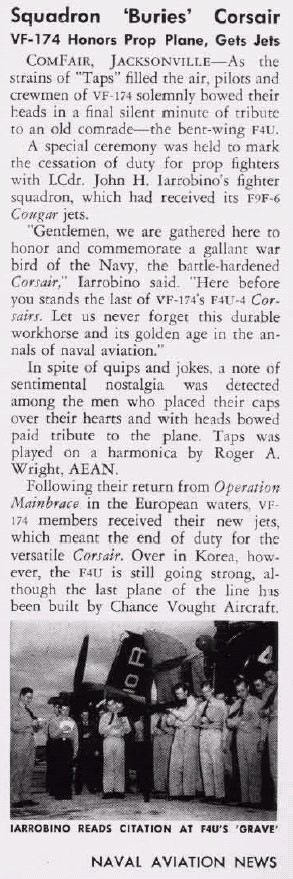
However, as soon as Korea ended the fast jet fighter-bomber panacea BS started up again and the grasshoppers were retired in the USAF. The navy and marines ditched their crash-prone Corsairs and grudgingly kept operating SkyRaiders until they could find a sexy jet attack plane replacement. Only the U.S. Army and marines realized the need for MAS grasshopper type observation aircraft, but as you will see, they had begun home growing their own fighter pilot egotists and a new type of egomaniac: the rotorhead-for-everything idiot. In a few short years both of them would have these mini-ego clubs retired their OV-1s and OV-10s, leaving us to the current state we are in today, without continuous overhead presence maneuver air support which has cost us thousands of dead and wounded in Iraq/Afghanistan.
Korean War Aftermath: The enemy did not sleep. He got better at camouflage while we chose to not look by flying "higher and faster"
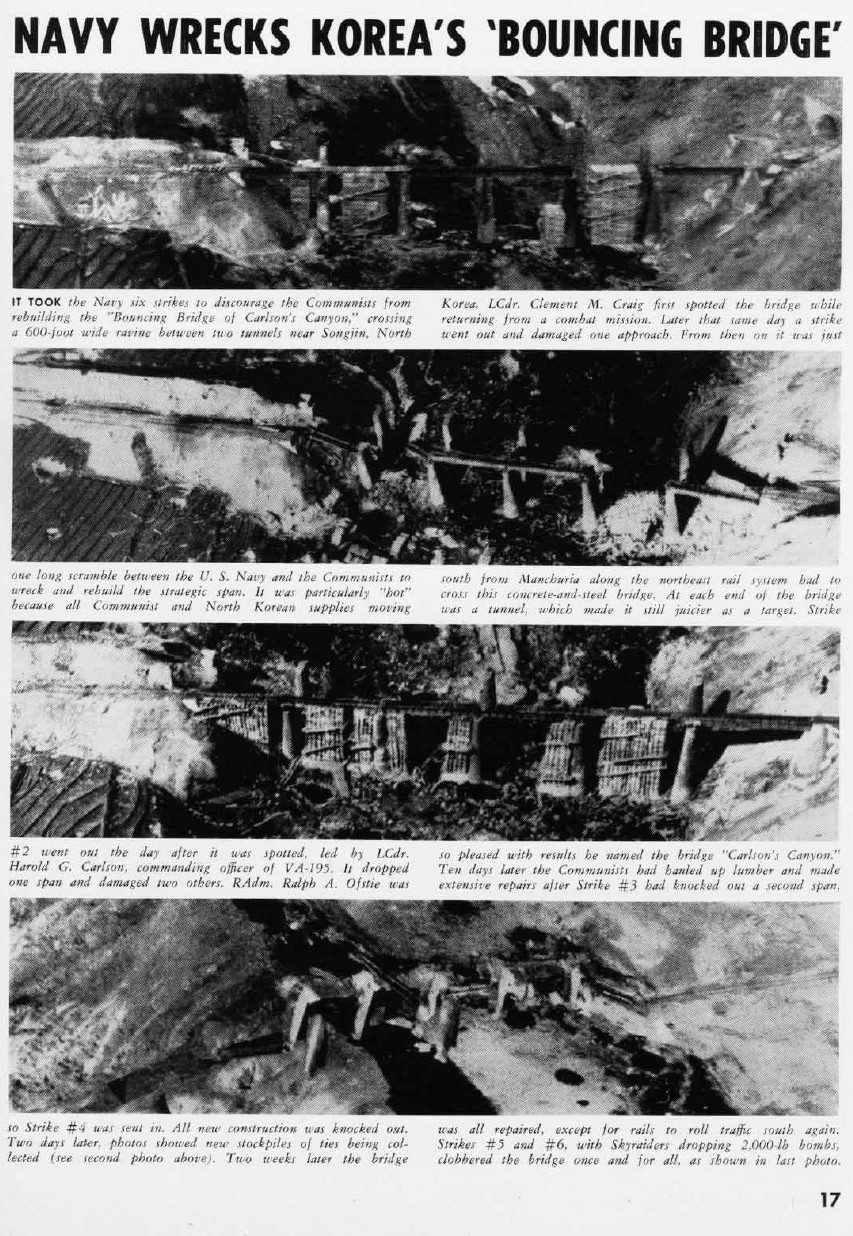
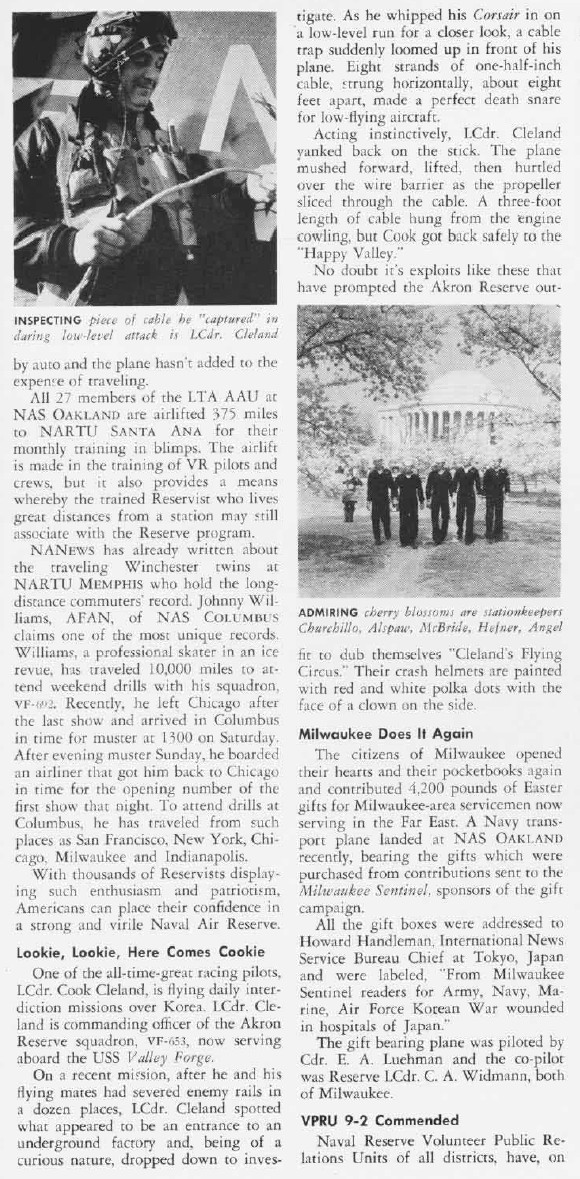
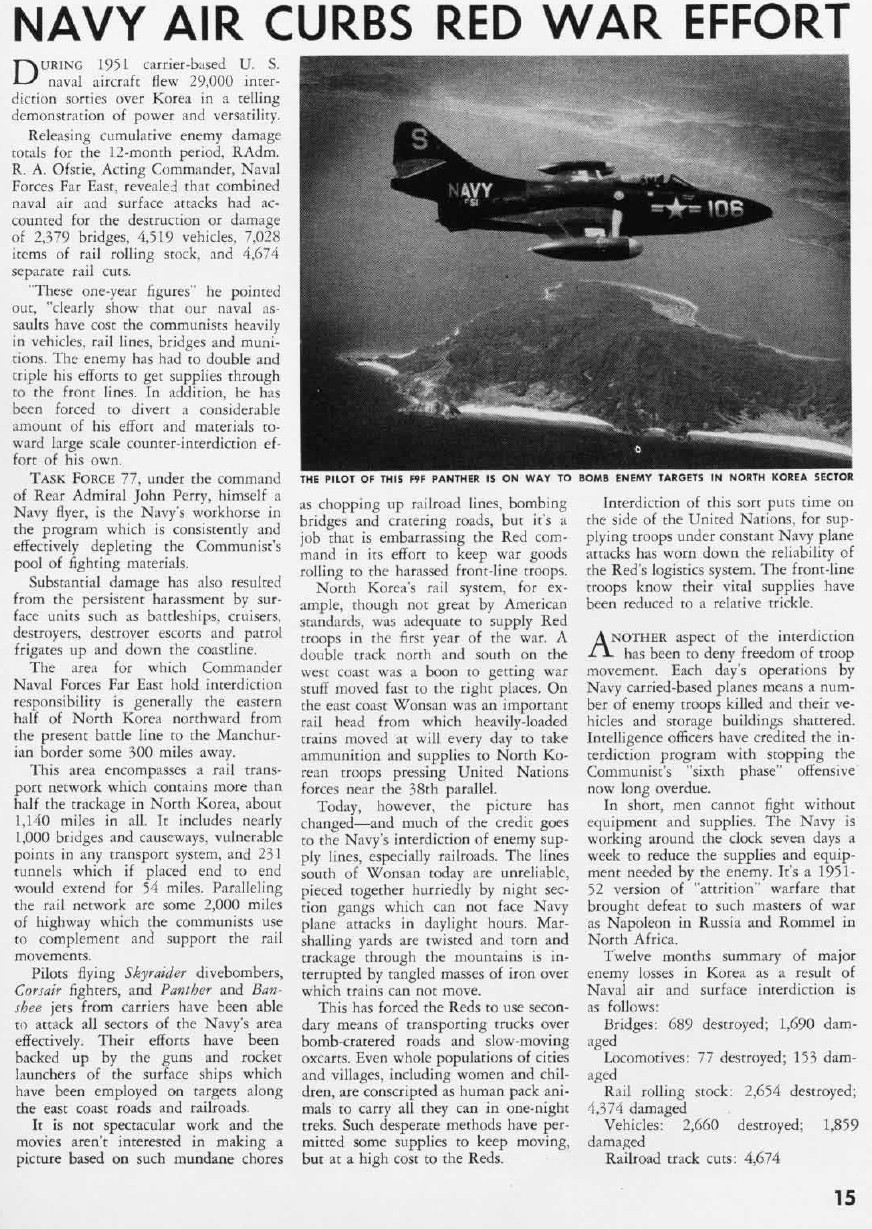
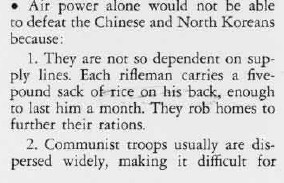
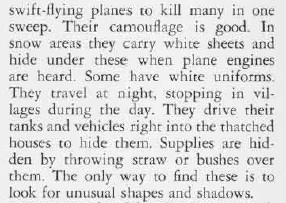
Realizing that in the bare hills of Korea he would be exposed, the enemy turned to camouflage and night operations to evade our aircraft. These lessons were passed on to the Vietnamese who with better closed terrain with foilage offering concealment began to defeat our WW2-style of warfare starting in the first IndoChina war and succeeding at Dien Bien Phu. These events should have made the U.S. MICC-TT wake up and change course from their "higher and faster" push-button war fixation, but as events sadly turned out, did not resulting in our tactical and operational defeat in the second IndoChina war (Vietnam War).
Other Allied Air Forces Realize they Need Prop Observation/Attack Planes
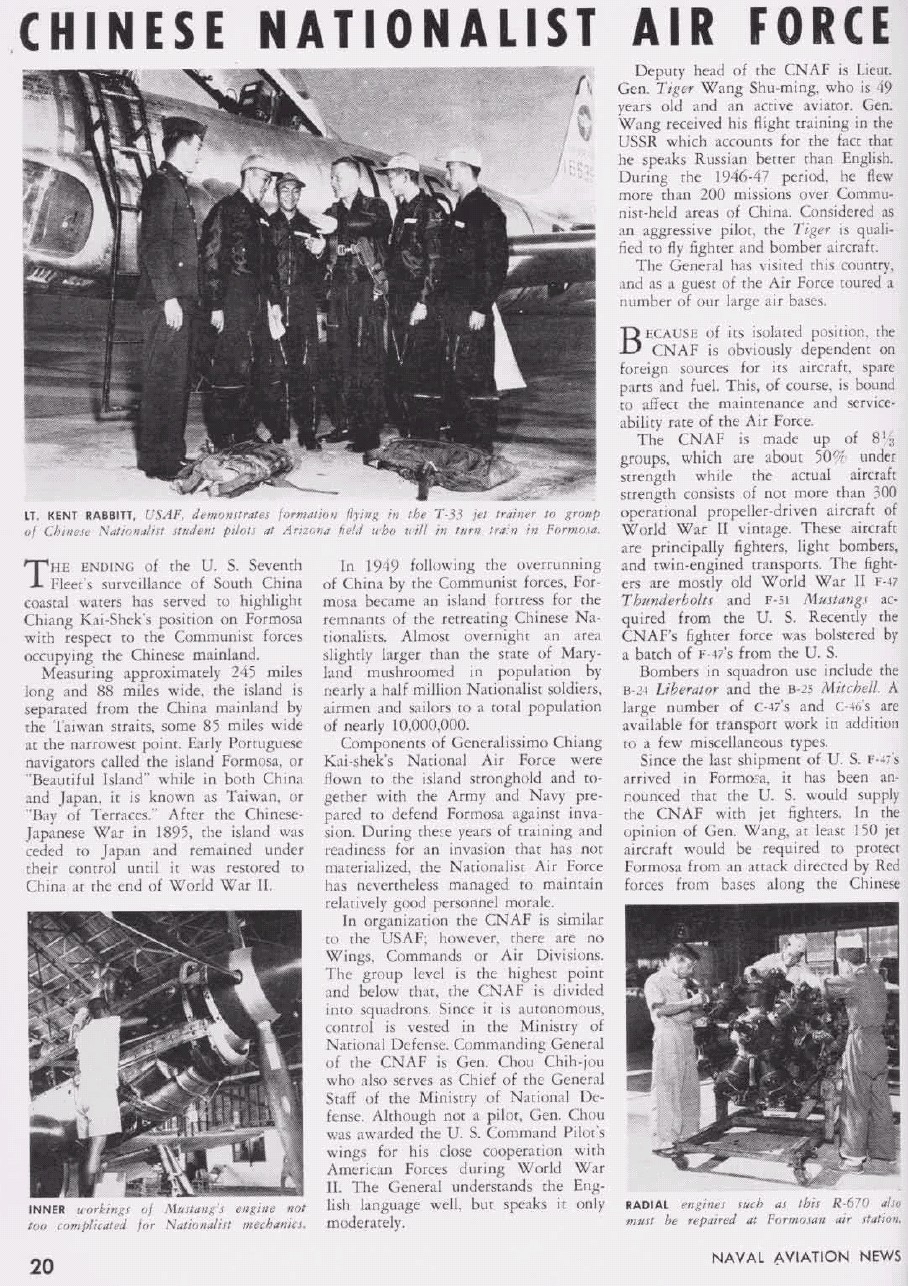
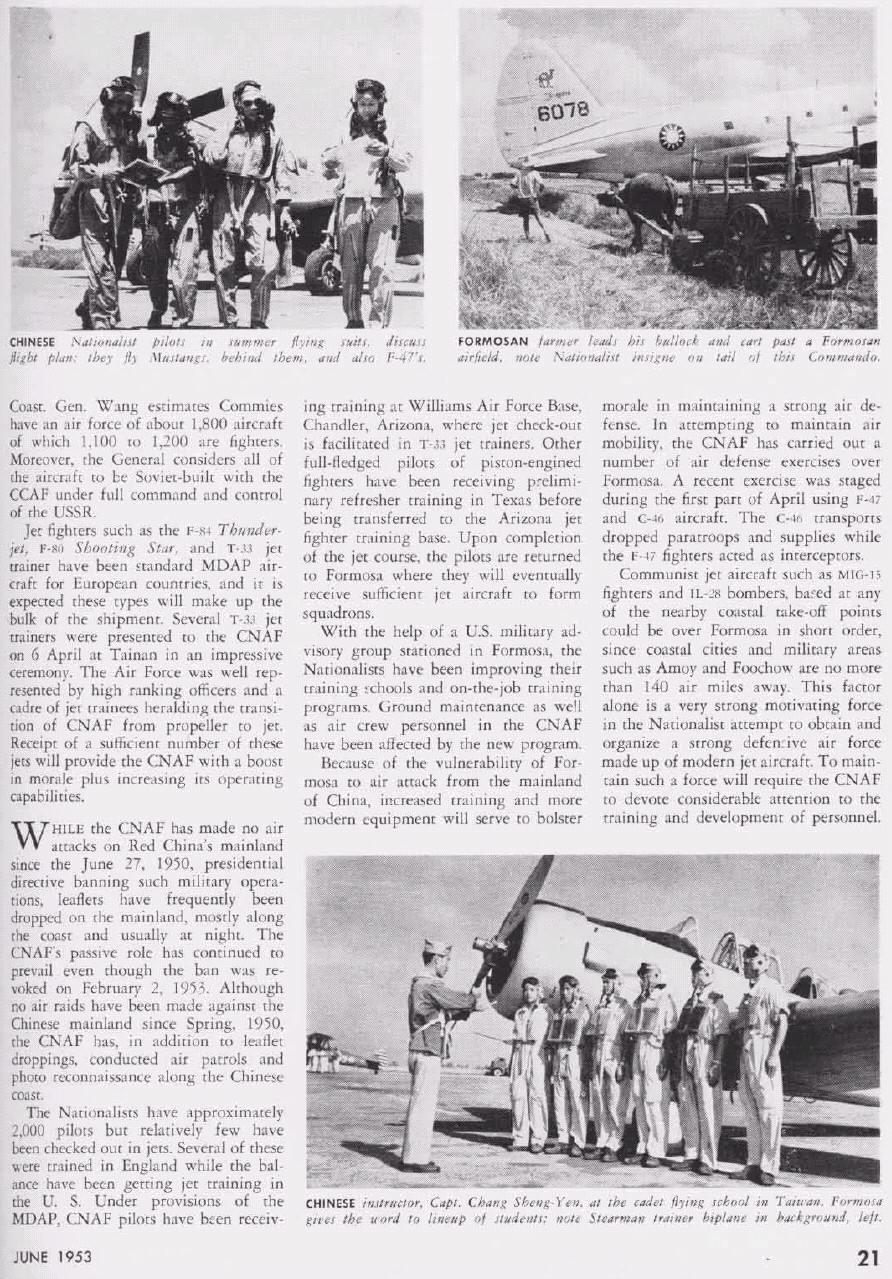
While the U.S. was on an orgy of MICC-TT speed and altitude projects, other nation's with real threats facing them TODAY obtained effective solutions from us that were no longer in vogue like P-47s, SkyRaiders and Sidewinder air-to-air missiles (AAMs). The Taiwanese shoot down some higher flying MIG-15s from their lower altitude limited F-86s, marking a first in air combat.
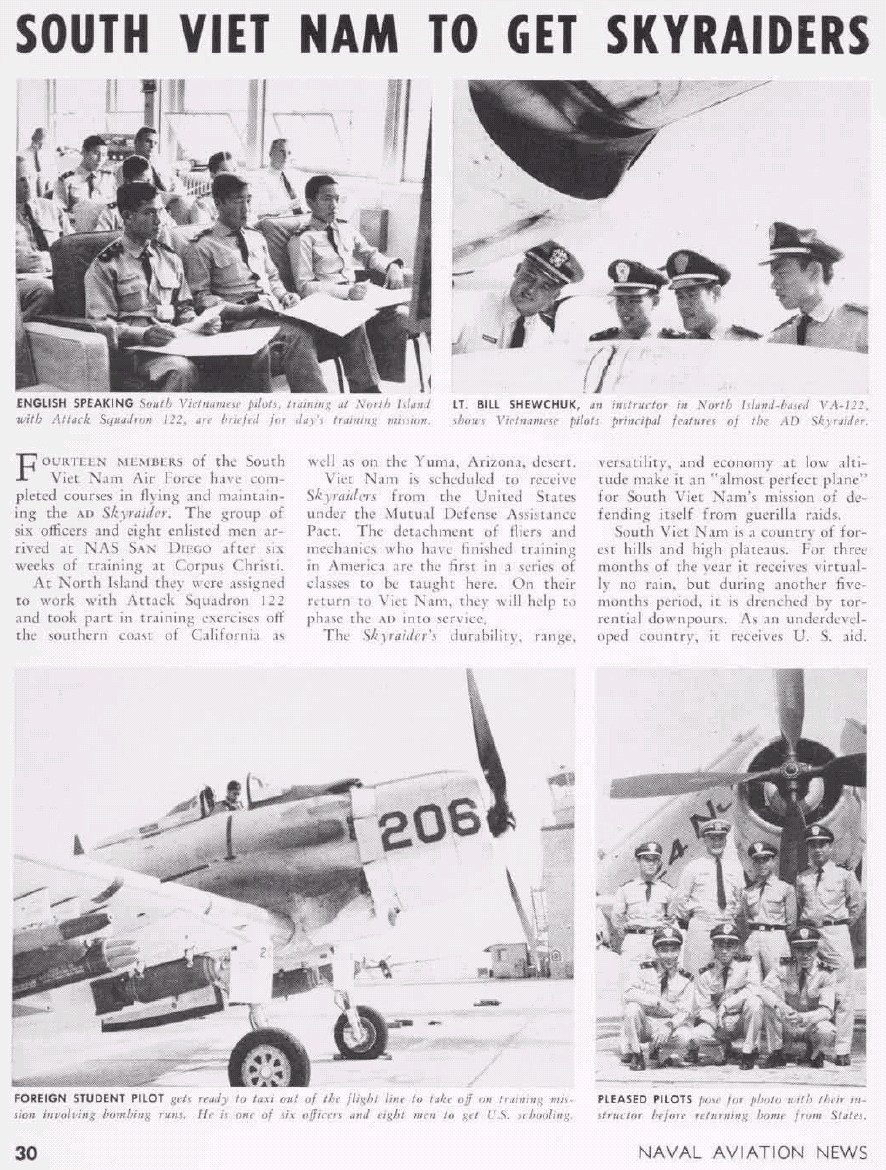
Meanwhile, the South Vietnamese get SkyRaiders for their war with the Viet Cong orchestrated by their neighbor, North Vietnam.
See it in Action!
 www.youtube.com/watch?v=UiQ5kmoumQ4
www.youtube.com/watch?v=UiQ5kmoumQ4
The French Get it Right in Algeria: 1955-1962
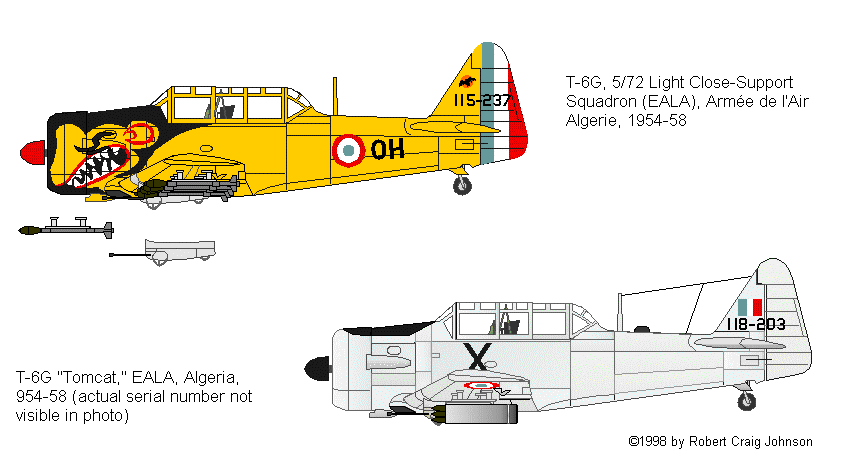
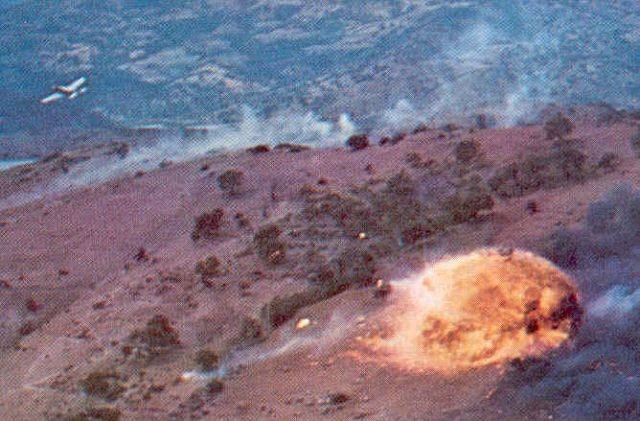
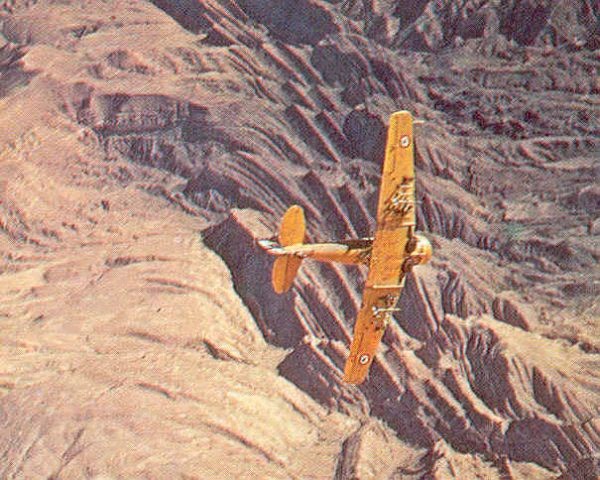
In Algeria, the French cut-out the "middleman" and armed their T-6 Texans so they were their own fighter-bombers!
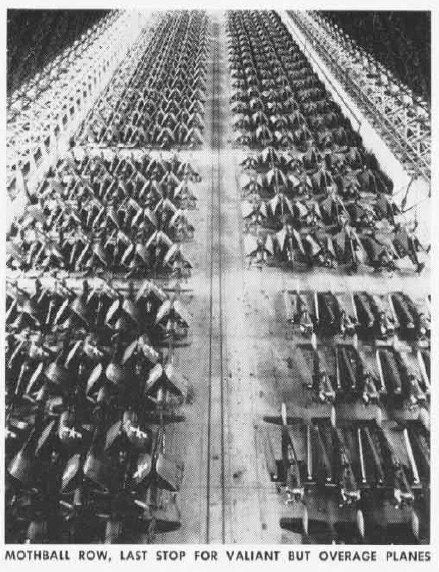
They had fought and lost the first IndoChina war with unwanted, freebee surplus American naval prop planes in the ground attack role; Helldivers, Corsairs, Hellcats and even given the Bearcat its only combat use. These aircraft were lost and now worn-out. They had a supply of P-47s unwanted by the USAF to use in Algeria and bought SkyRaiders. ACIG writes:
The Armée de l'Air was meanwhile facing increasing problem with serviceability of EC.20's fighters. Both types utilized by this unit, F-47D Thunderbolt and Mistral, eventually proved unsuitable for the task at hand: the Thunderbolts were aging fast while Mistrals lacked armament and endurance. The situation was clear already from earlier times, but it took some times until replacements were available.France turned to the USA, who happened to have a large stock of surplus U.S. Navy Douglas AD-4 Skyraiders, left behind after the end of the Korean War. A contract was placed for 113 Skyraiders of three different versions: 20 x AD-4s, 88 x AD-4Ns and 5 x AD-4NAs. All were shipped from the USA to SFERMA workshops in Bordeaux, some arriving directly while others via Saint-Nazaire. The French removed the radar and ECM-equipment from the rear cabin of AD-4Ns, as well as the arrestor hook for carrier operations. Also, the large fuselage brakes on AD-4s were welded in locked position and all the aircraft received an overall aluminum protective paint and a new "serial" number, applied by SFERMA.
These "new" Skyraiders entered service with EC.20 in December 1959, even if the first AD-4 was not handed over to the unit until February 1960, and their transfer began only in April of the same year. The unit moved from Oran to Boufarik, in central Algeria, where conversion to the new type was completed, and the EC.2/20's Skyraiders began flying combat operations in July 1960, followed by EC.1/20's aircraft, in October. When additional aircraft became available from SFERMA a third escadro0n was added to EC.20: in September 1960 the former EC.1/6 Oranie, flying Mistrals, was disbanded and reformed as Escadron 3/20 Oranie, on AD-4s. From that time onwards the Skyraiders saw action on daily basis, providing close air support to ambushed troops and to heliborne operations.
French Skyraiders were usually armed with four 20mm cannons, and could carry 500kg and 125kg bombs, napalm tanks, HVAR or T-10 rockets. Large drop tanks were procured as well, in order to provide long loiter time over target area. Despite heavy loads carried, the type remained very manoeuvrable at low altitude and low speed, even if the Wright engine disliked the "hot and high" Algerian climates, sand and dust. Over the time the type proved very effective: by 1960 the cooperation between the French air force and ground troops was better than ever, resulting in clear and well-trained procedures for fire direction by ground troops and excellently trained pilots.
Here is the excellent ACIG account of the French success in COIN operations:
French COIN operations in Algeria, 1954-1962
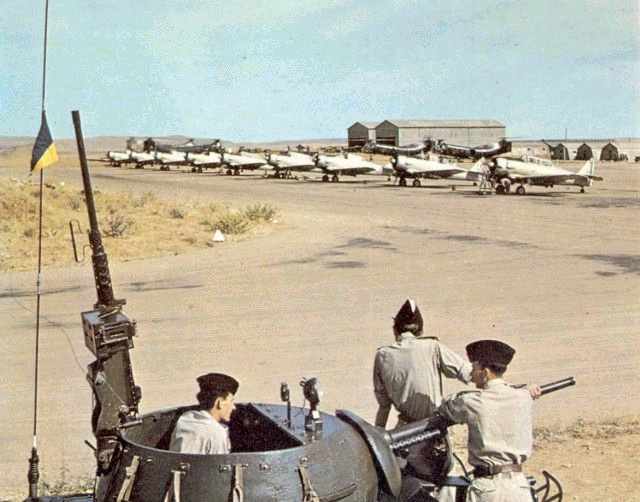
The French then replaced their dwindling supply of Texans with faster T-28 Nomad trainers that the USAF/Navy had replaced their T-6s with.
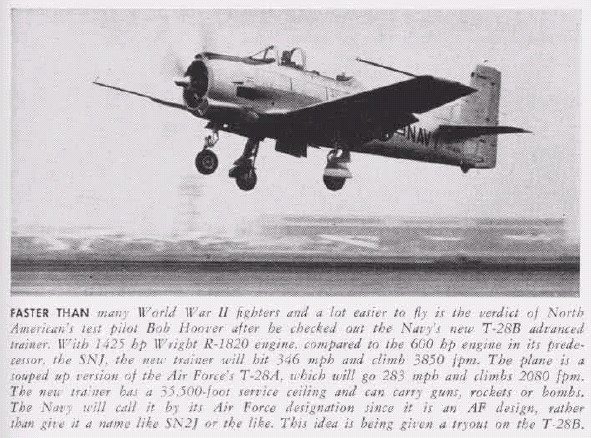
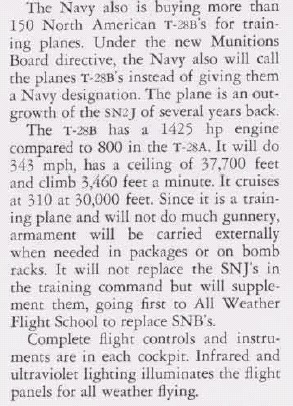
They improved their Nomads for the ground attack role as "Fennecs".
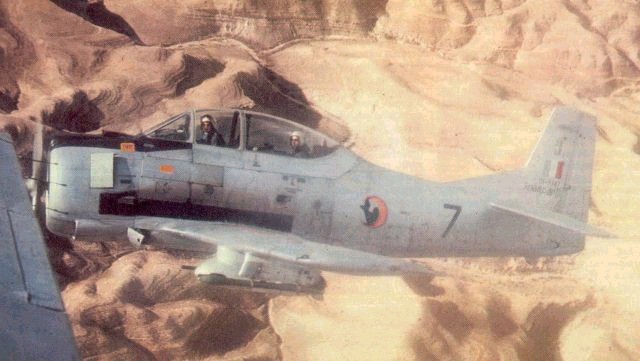
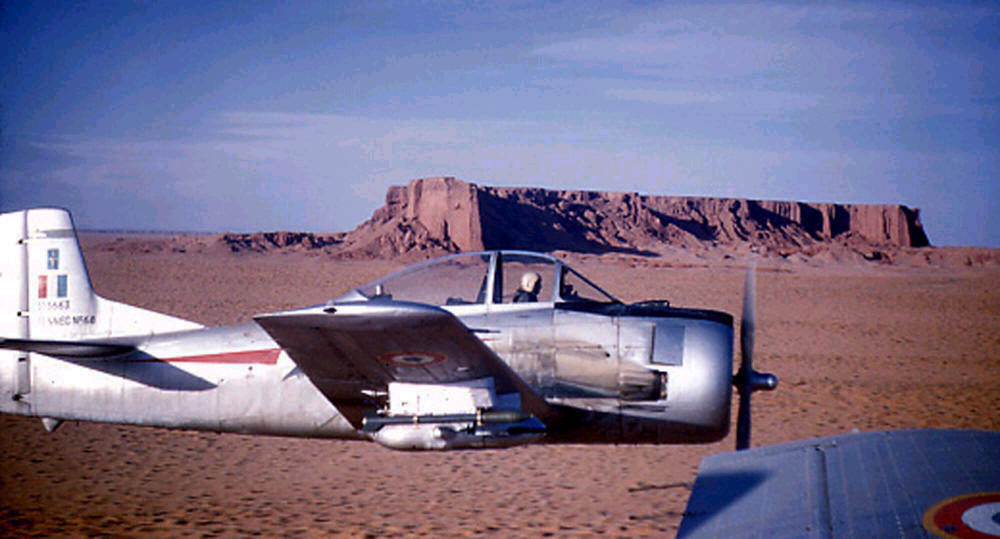
Americans get it wrong: hypocritical marines say they want to do CAS the ditch SkyRaiders that can do CAS for A-4 SkyHawks that cannot (they do sexy interdiction well); wiser heads in the Navy keep their SkyRaiders for a "rainy day"; Army and Air Force look for other aircraft: T-28s, OV-1s, borrowed SkyRaiders!
USMC CAS Hypocrisy 101
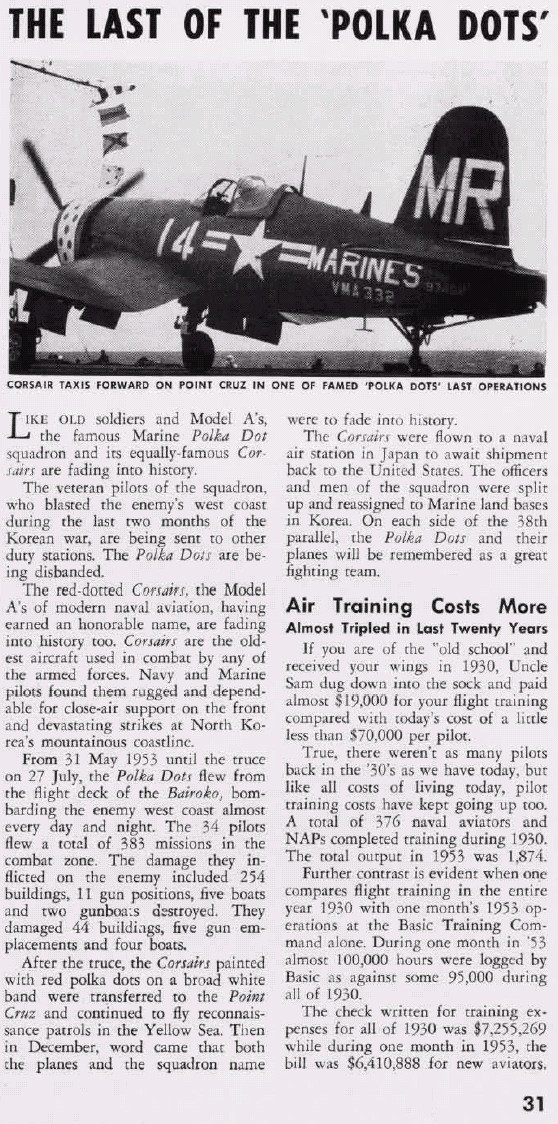
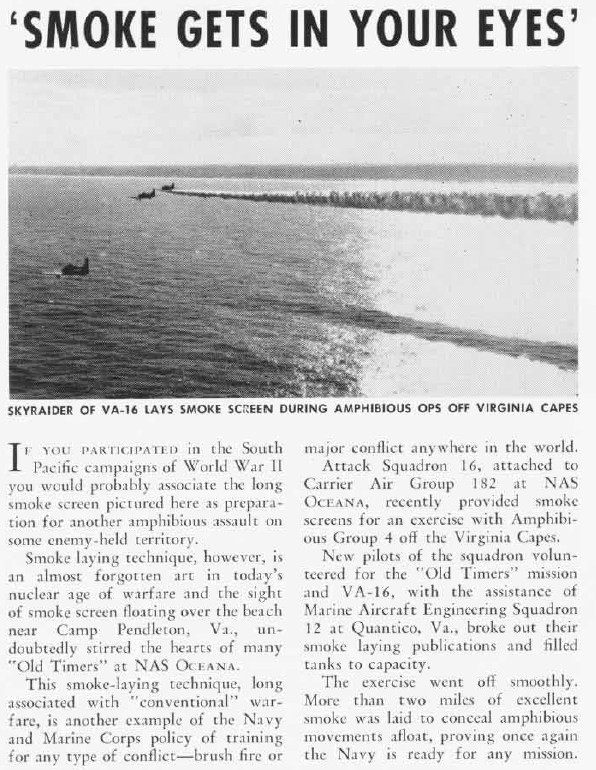
When it suited USMC public image, they praised the Corsair to high heaven. After everyone was fooled, they then retired them after the Korean War while beating their chests how great they WERE. They will brag about smokescreens to help ground maneuver units below from SkyRaiders then retire them a year later.
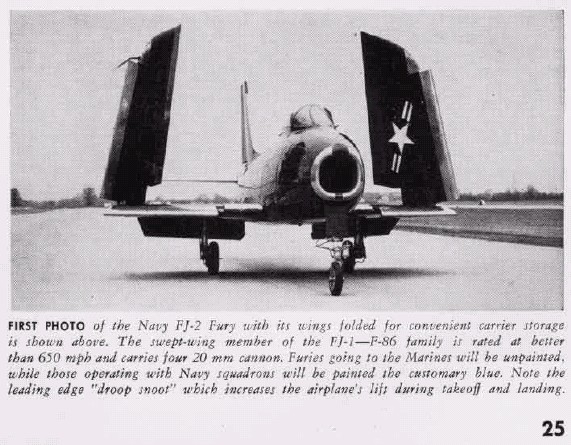

The following series of publicity photos reveals the lying hypocrisy of the USMC which claims it "invented CAS" and shows how right after the Korean War, they went crazy for sexy jets starting with navalized swept-wing F-86s used by the USAF since they failed to kill many MIGs over Korea in their slower straight-wing jets followed by the A-4 SkyHawk...
1946: Corsair better than nothing for CAS
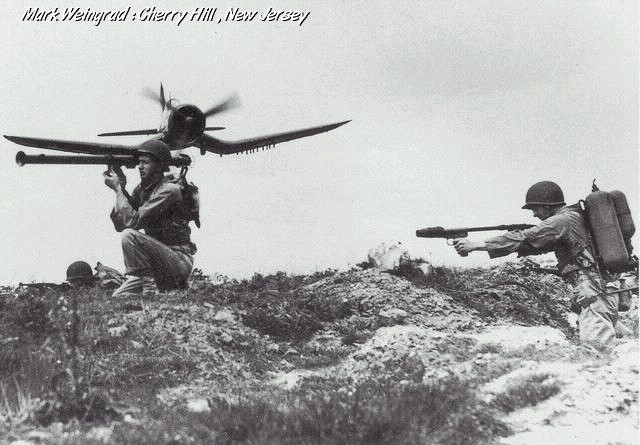
1949: SkyRaider better choice than Corsair
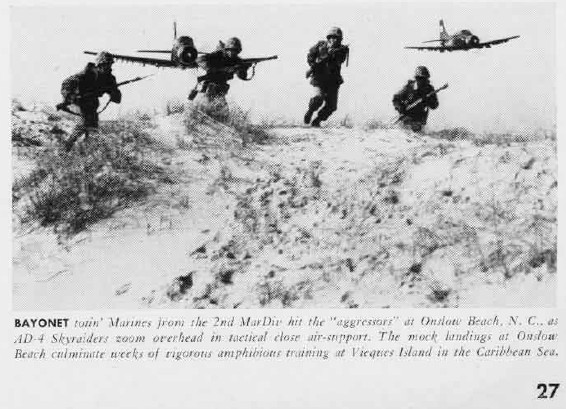
1954: we ain't gonna be outdone by no USAF!
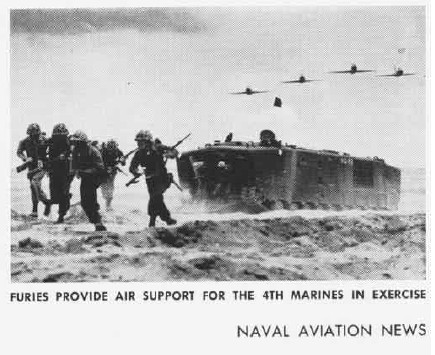
1958: we are all jets now, baby!

JET EGOTISM POST-KOREA: TAKE A PEEK INTO THE EGOMANIA
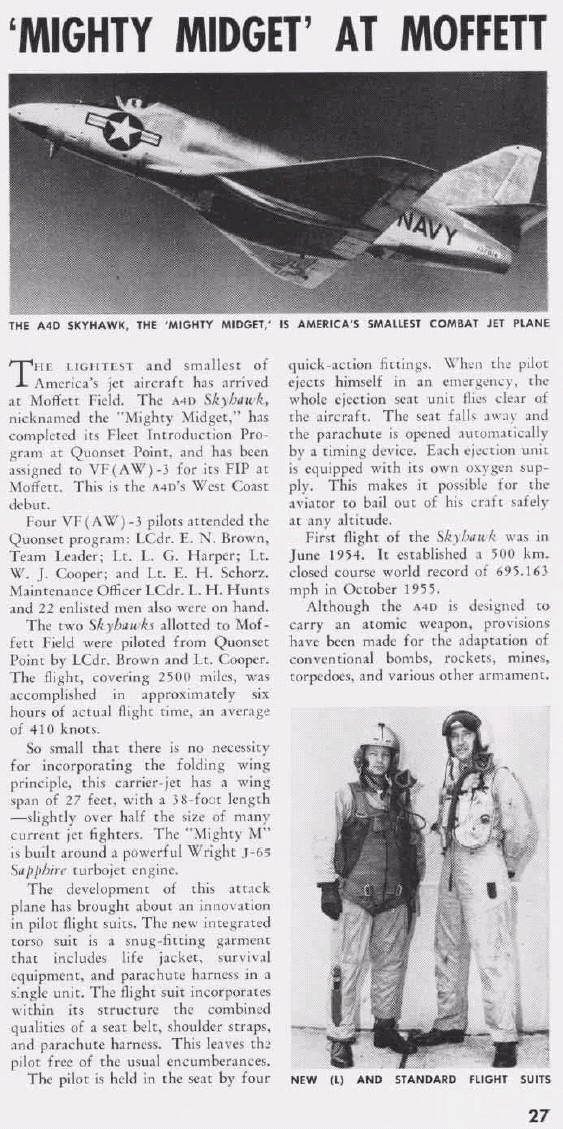
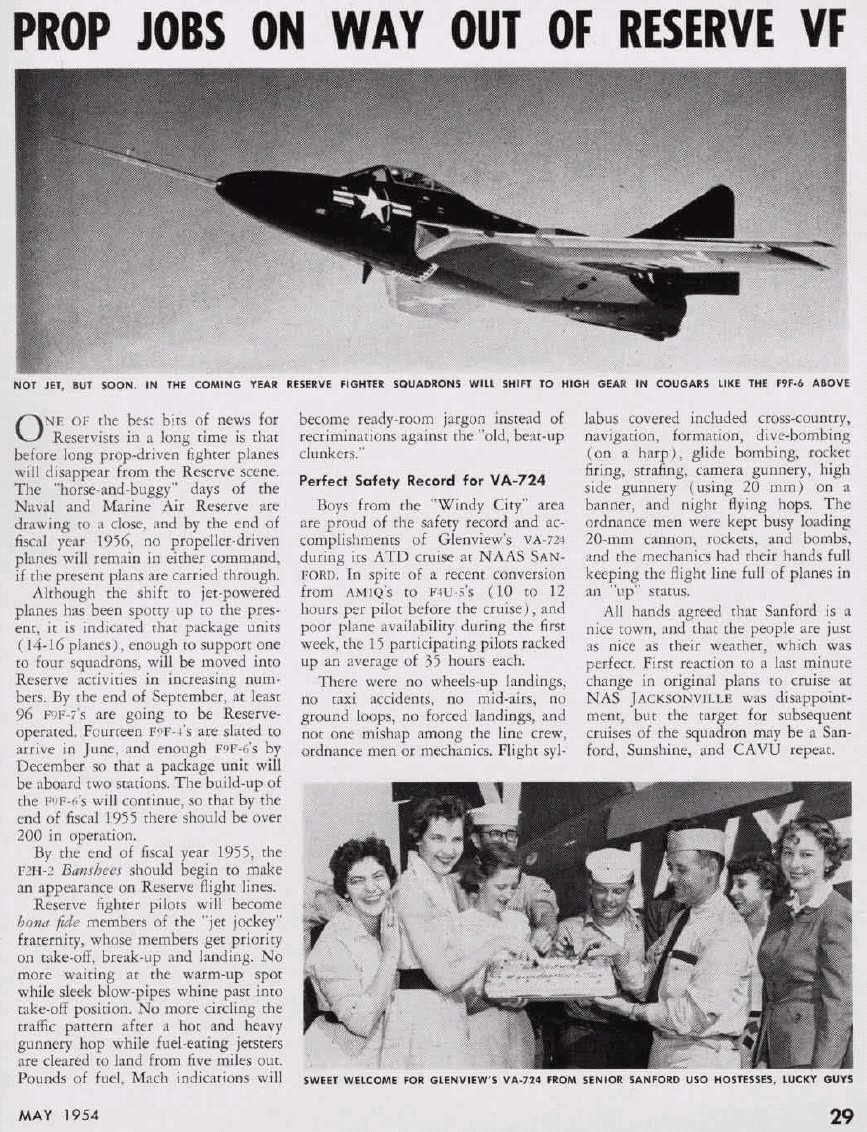
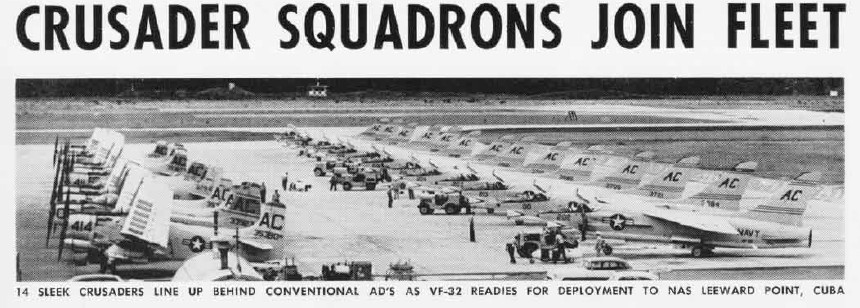
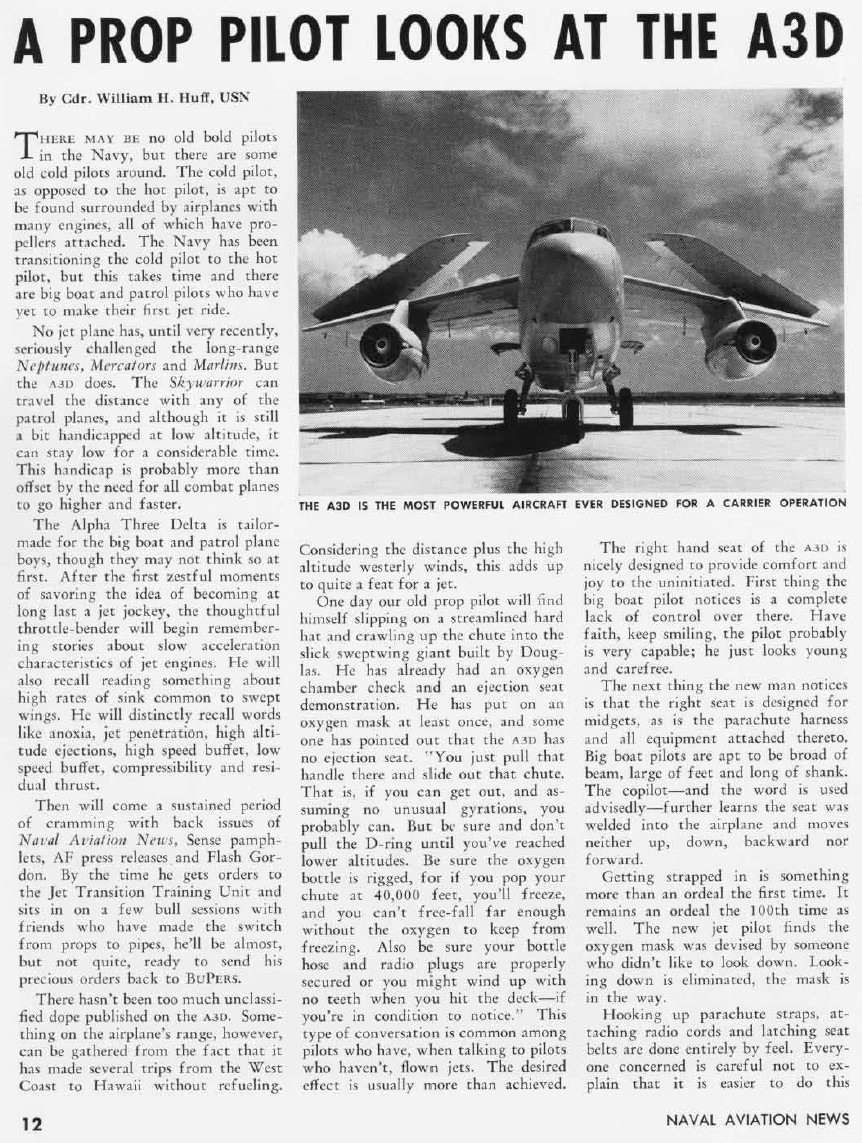
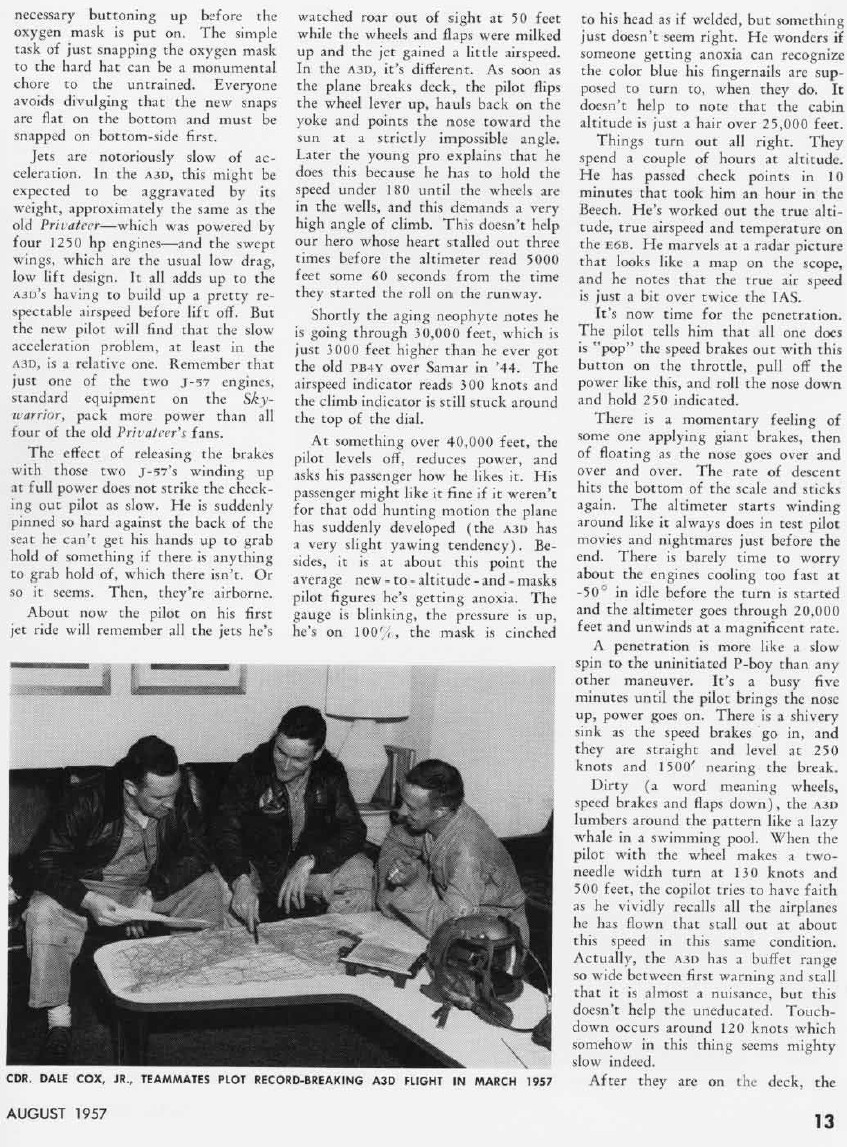
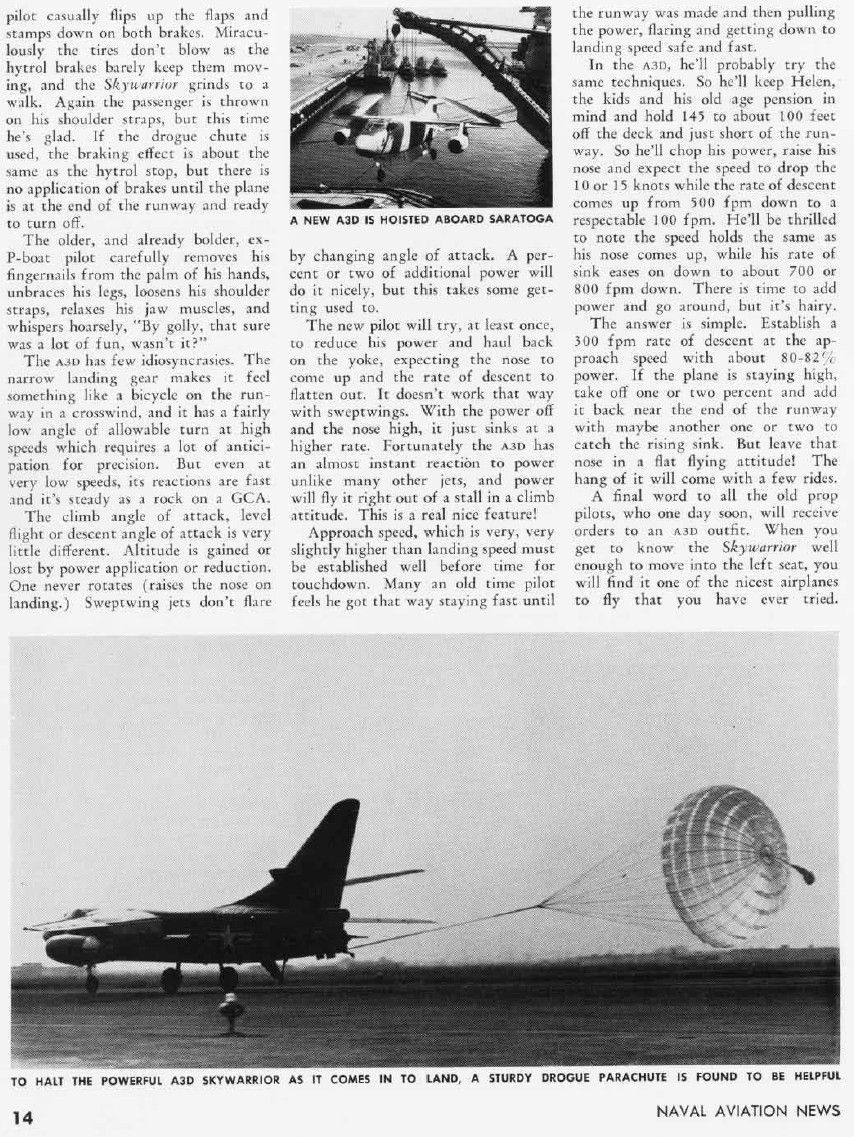
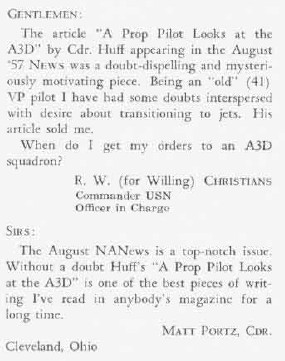
USN: Some Common Sense Fights to Remain
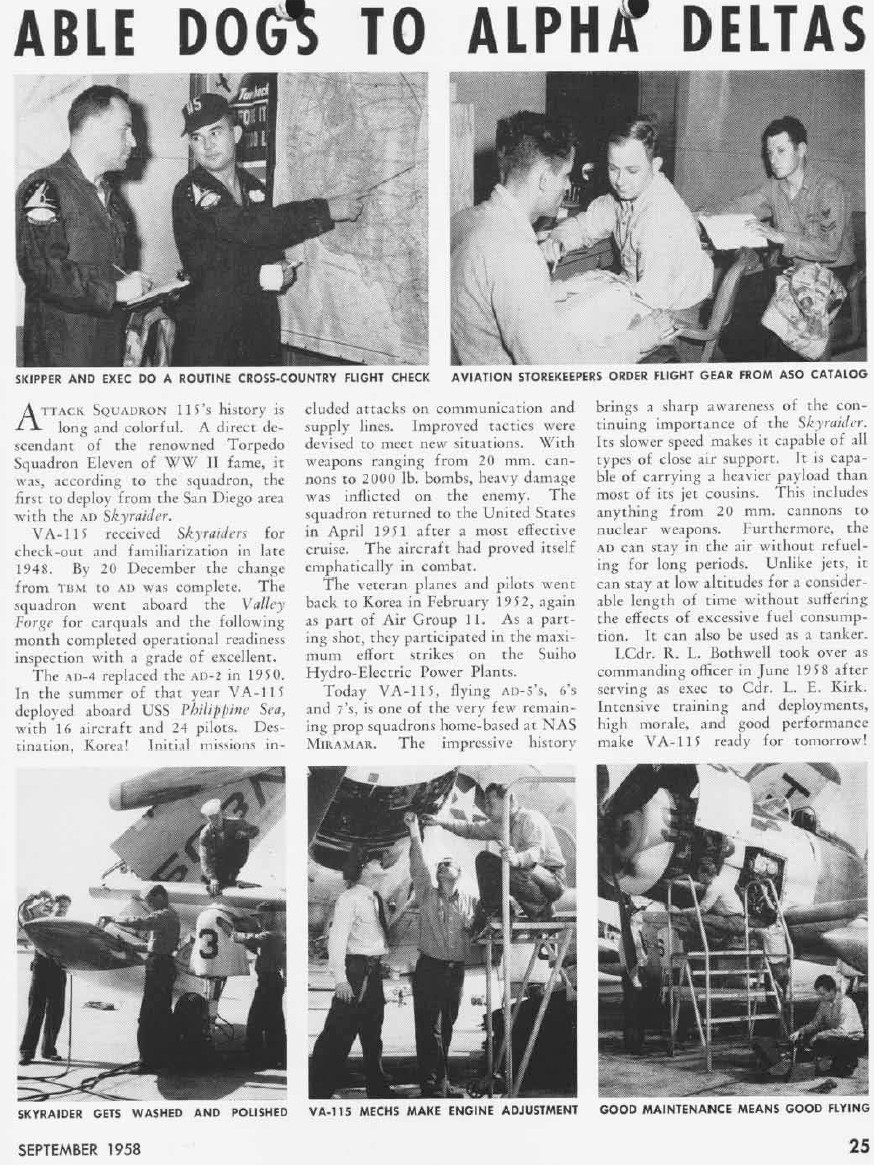
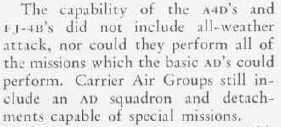
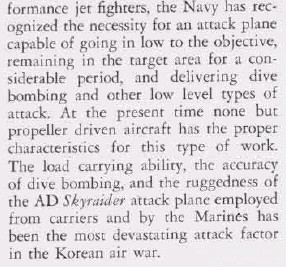
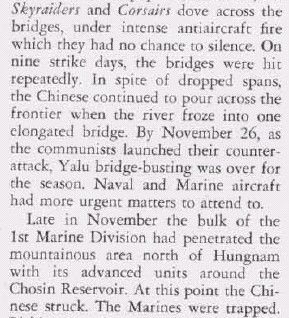
The article above shows that at least in the Navy there were those with some common sense intact who had not fallen to the jets-for-everything mentality and selfishness. They still knew that interdicting point targets with jets hadn't stopped the North Koreans nor would it any other foe who employed camouflage, deception and deceit.
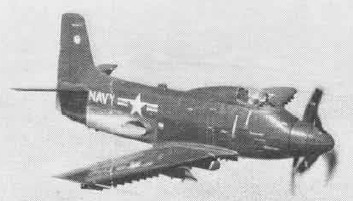
The failure or the deliberate sabotage of prop plane development by the jet jocks of contraprops to make them fly safer and faster to be near transonic when required to penetrate enemy air defenses damned SkyRaider models to minor variations. Without new prop planes in production it was only a matter of time before they all would be lost in combat, crashes and simply wear out. We do not believe this was an accident on the part of the ruling jet jocks in the marines, USN, and Air Force.
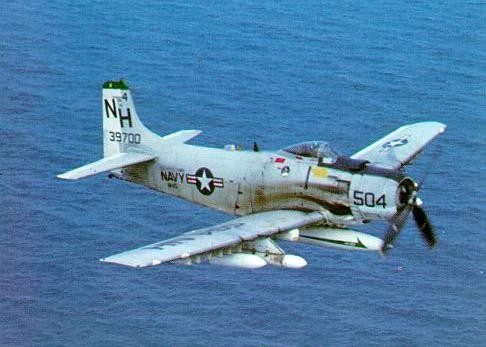
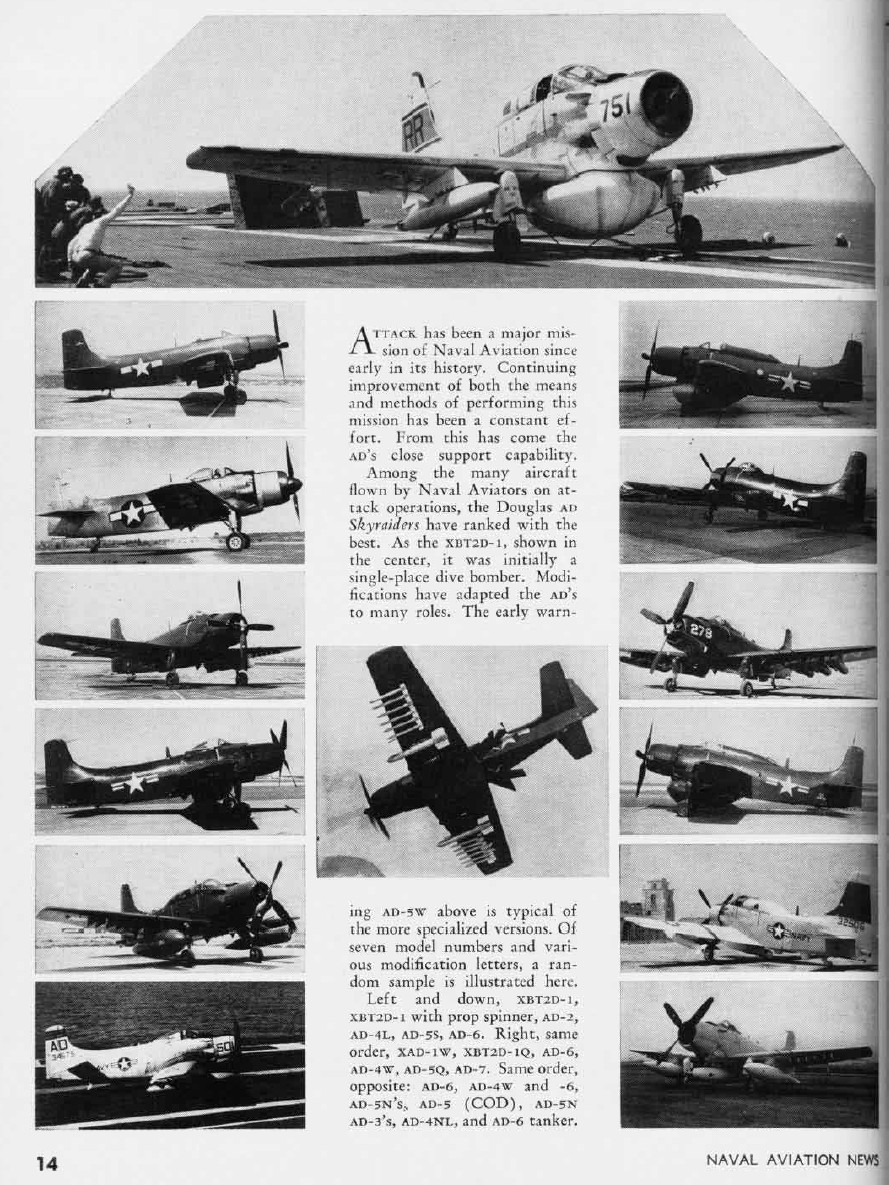
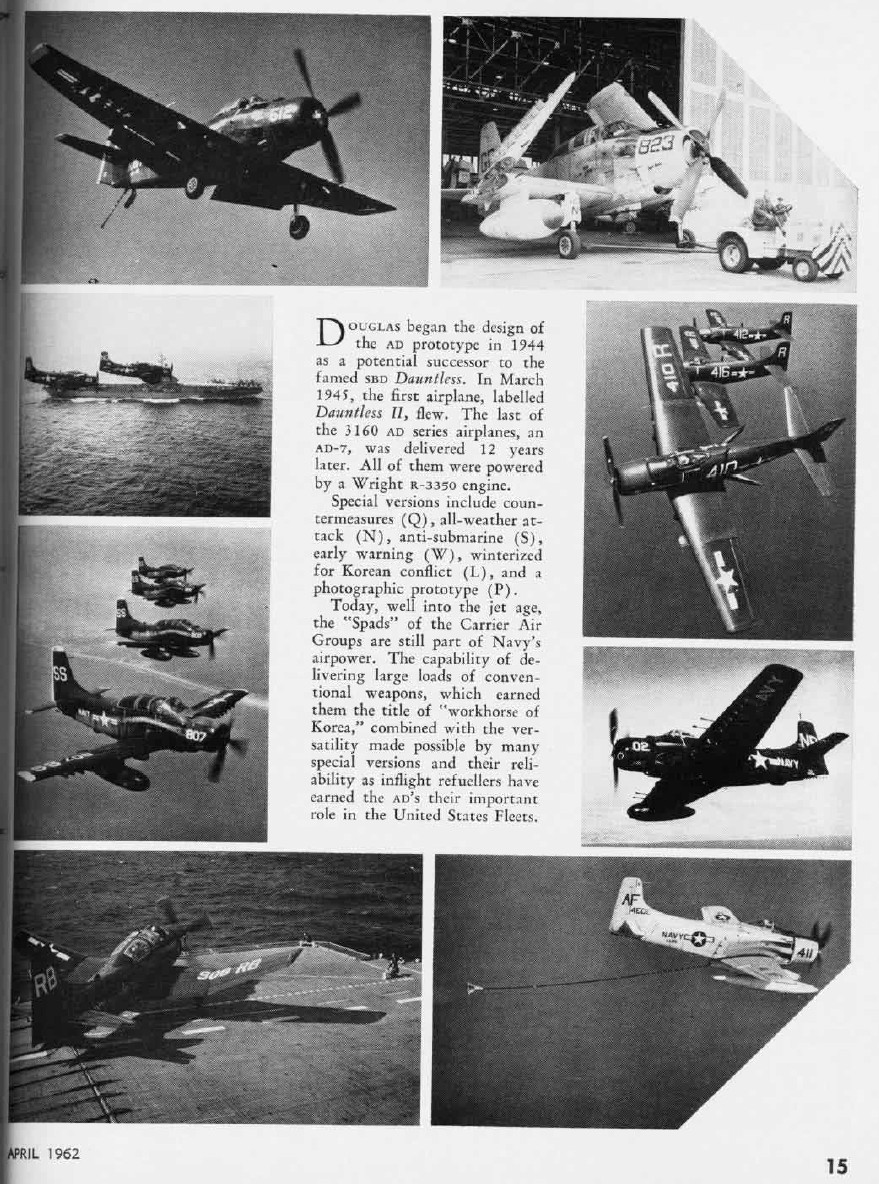
CARGO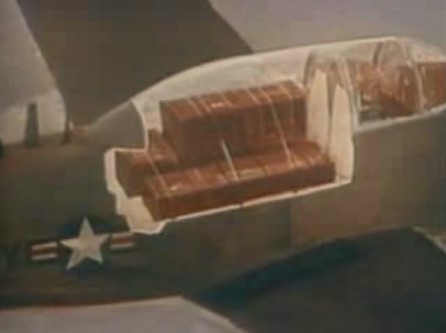
MEDEVAC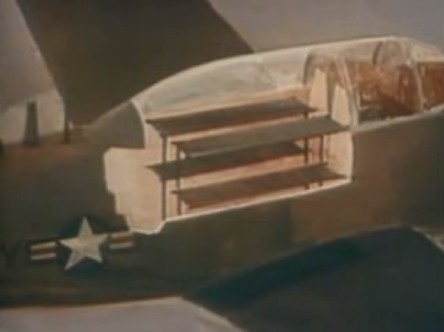
C.O.D. SAILOR TRANSPORT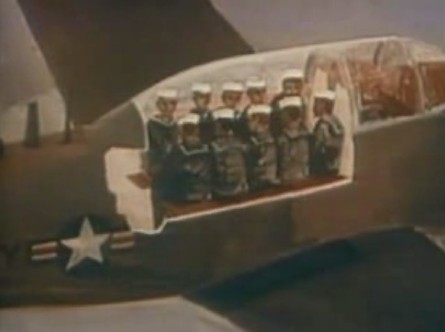
V.I.P. SNOB TRANSPORT 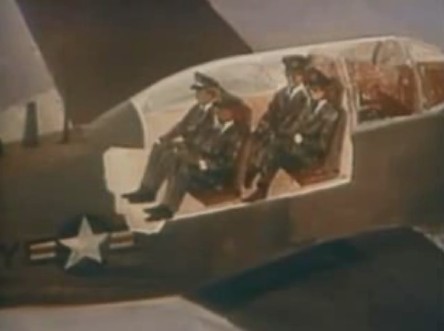
SKYRAIDER 1
 www.youtube.com/watch?v=T8edv3I3T0s
www.youtube.com/watch?v=T8edv3I3T0s
SKYRAIDER 2
 www.youtube.com/watch?v=d2BeD8zDpgM
www.youtube.com/watch?v=d2BeD8zDpgM
SKYRAIDER 3
 www.youtube.com/watch?v=4fD4SJZ4wqU
www.youtube.com/watch?v=4fD4SJZ4wqU
SKYRAIDER 4
 www.youtube.com/watch?v=nUmTlsccbo8
www.youtube.com/watch?v=nUmTlsccbo8
SKYRAIDER 5
 www.youtube.com/watch?v=-3V4nPMC-rw
www.youtube.com/watch?v=-3V4nPMC-rw
So even though the SkyRaiders were far from optimized to their full potential, they soldiered on and got amazing results which surely reminded the jet jock egotists that they must be gotten rid of ASAP. Any limelight taken from them in their zero sum minds is intolerable.
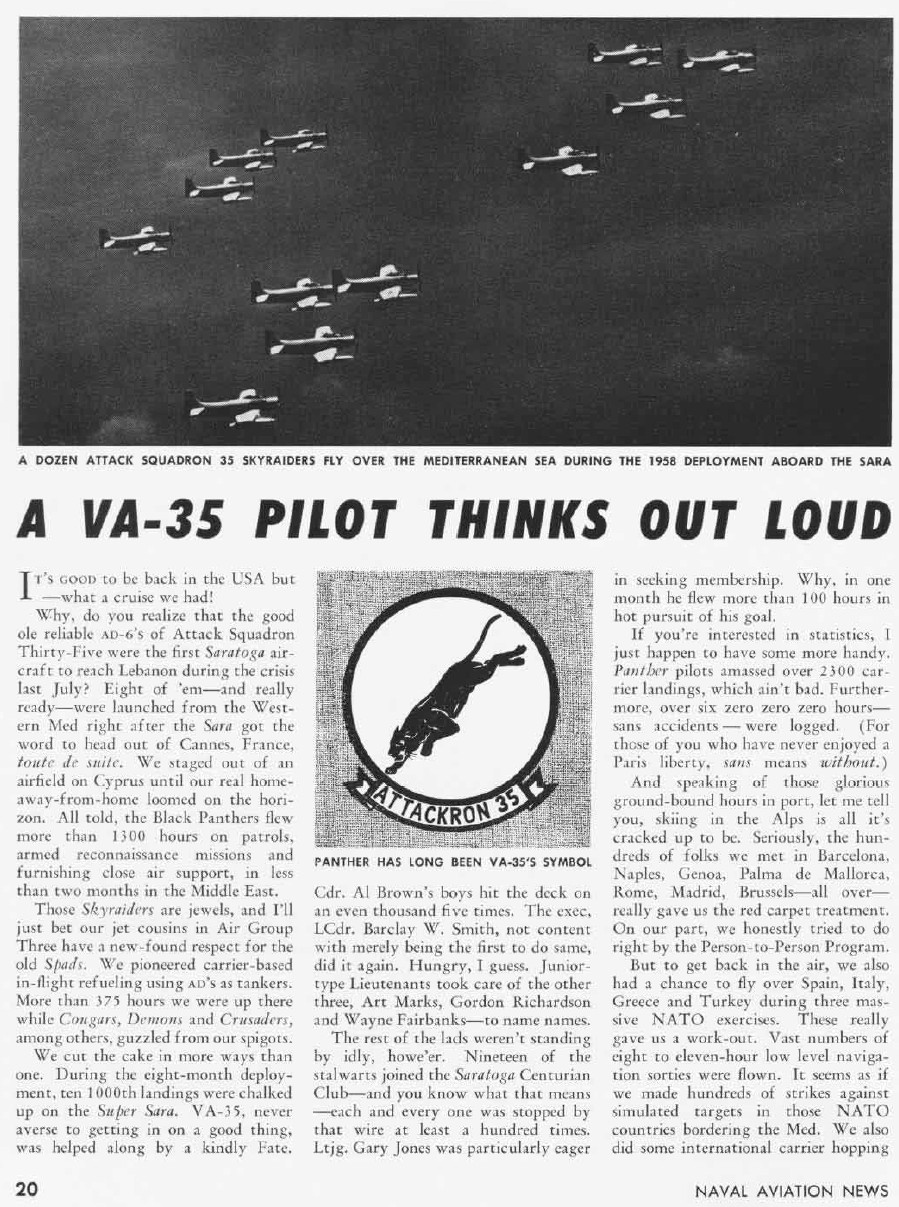
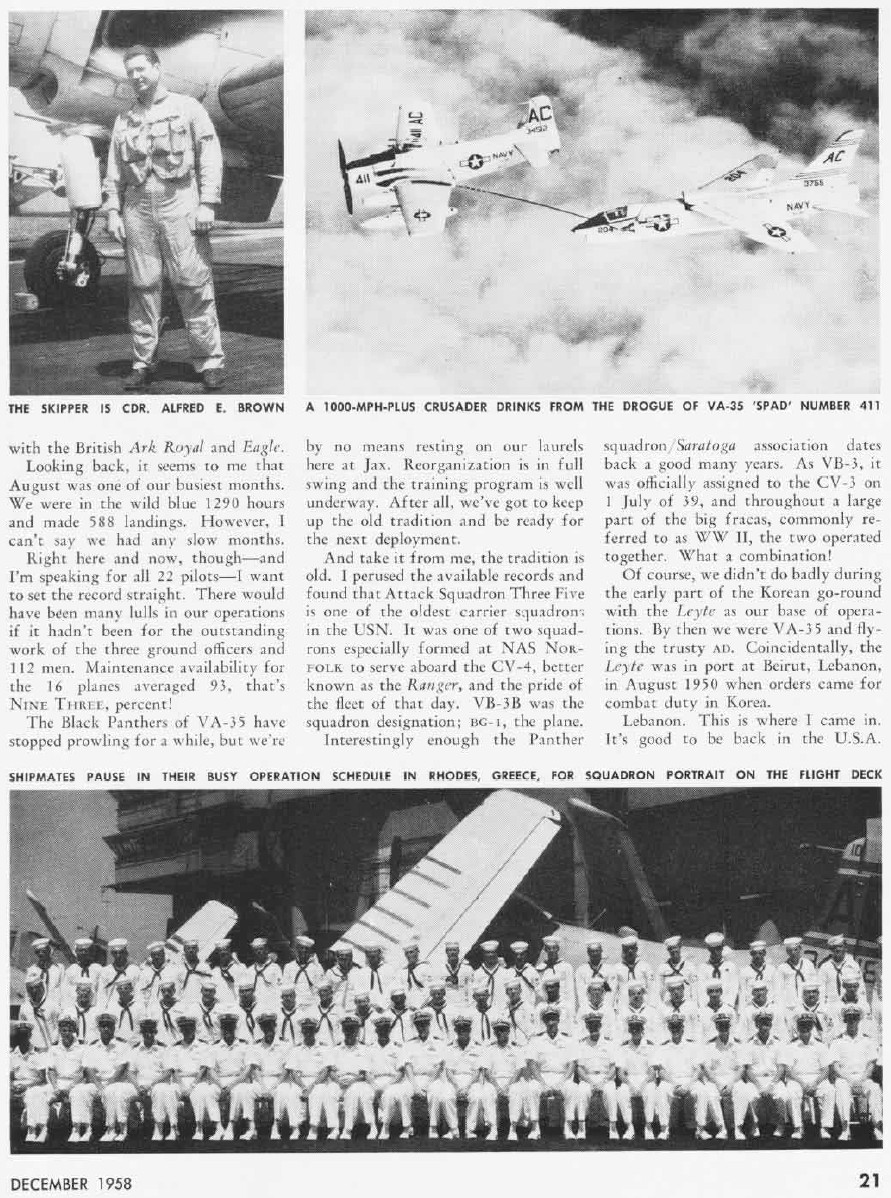
SkyRaiders excelled over the Lebanon countryside during the 1958 crisis able to stay overhead far longer than their jet jock rivals who had to get gas from them.
USMC retires the SkyRaider in 1959 in favor of absurd too-fast jets
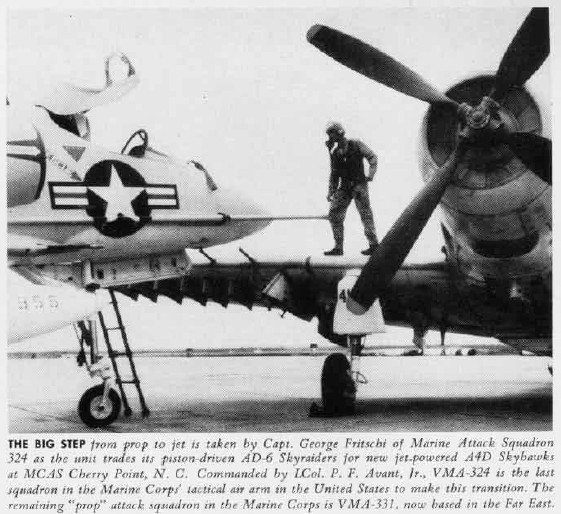
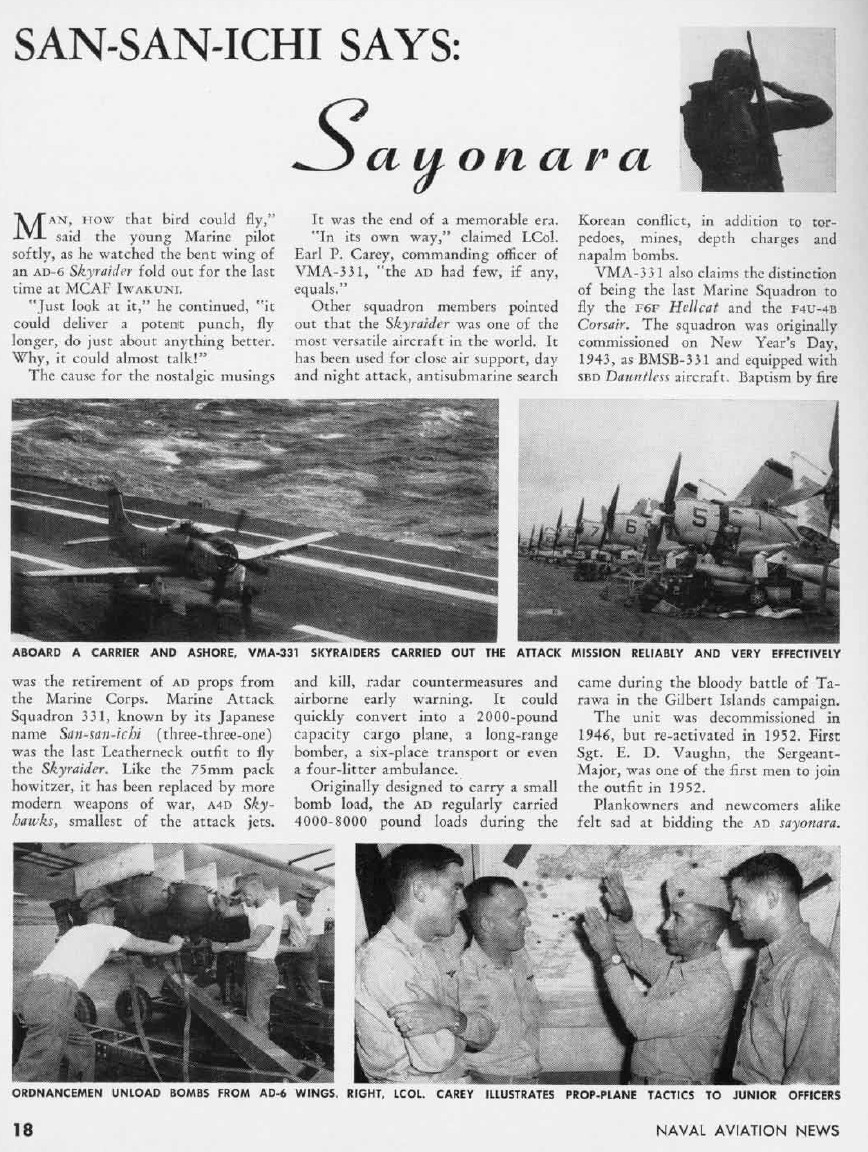
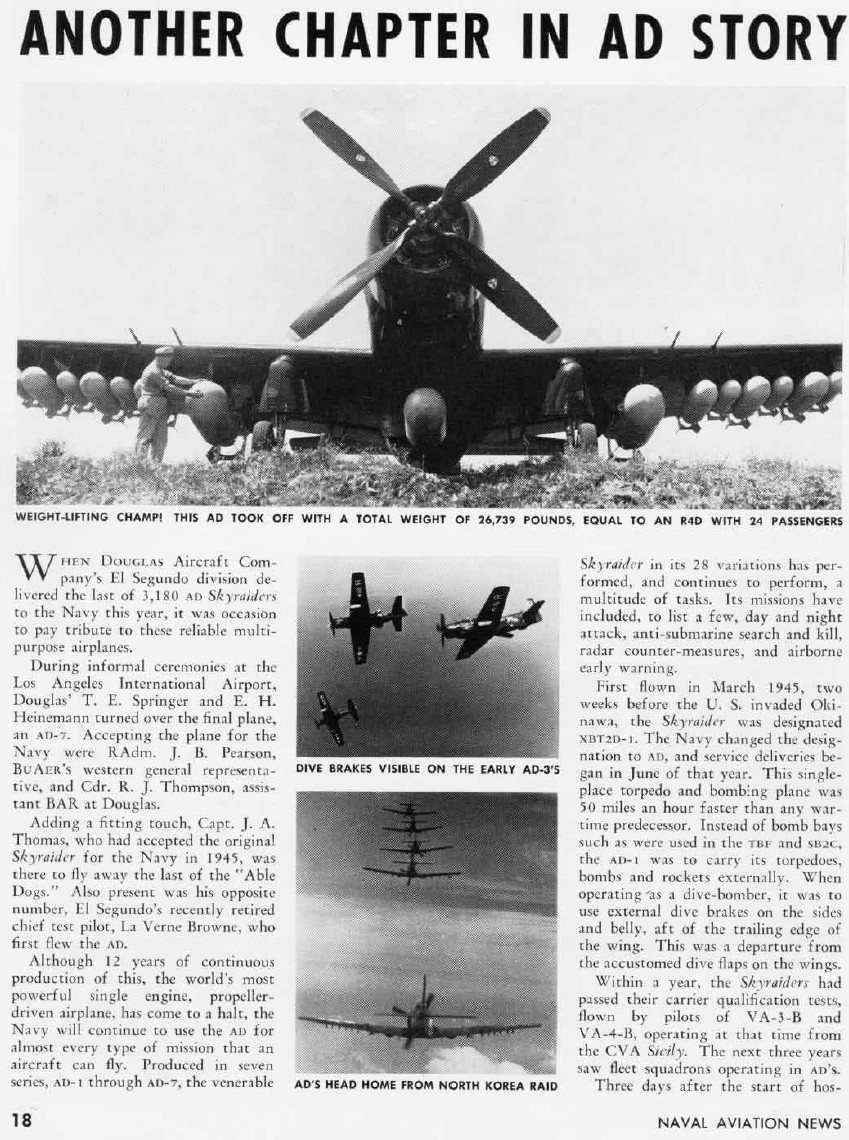
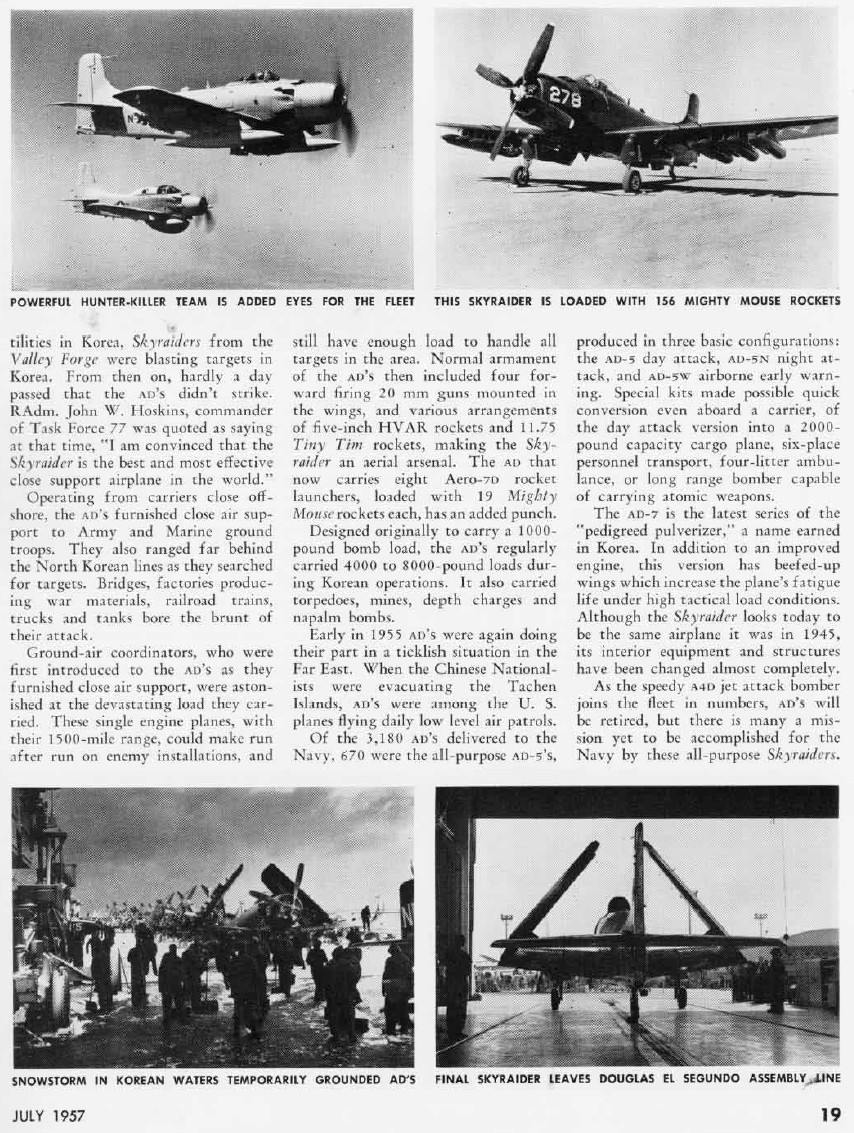
In typical manifest hypocrisy, the marines praised the SkyRaider with gushing words as they showed it the door....just like had done earlier with the Corsair...how many ground troops would die shortly in Vietnam from a lack of CAS because of this blunder is worth looking into.
1962
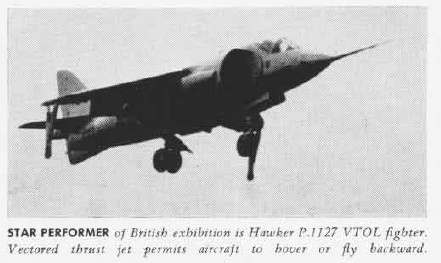
The fact is the USMC today still can't do effective CAS because it replaced the simple, durable and dependable SkyHawk which could operate from short runways with catapults/JATO with the overly complex, unsurvivable-against-enemy-fire (fuel tank co-located with engine exhausts) and still too fast to do CAS
Some minor helps like drag chutes were available but rejected by the USN brass lest the SkyRaider become in vogue again.
As the same pilots flew SkyRaiders over and over again, their inherent ability to fly in more harsh weather conditions than jets became apparent and was used by the USN brass to foist the "all weather" lie to justify their huge supercarriers which can't go through the Panama Canal but have to go around the stormy Cape Horn at the end of South America to go from one ocean to the other.
And even the high torque problem could be flown around if highly skilled pilots operate the SkyRaiders.
Combat T-28s: Army looks, Air Force employs, Navy uses covertly
The T-28 was originally considered as a tail-dragger observation/attack plane for STOL rough field operations. However, as a trainer for jets on paved runways it became widely available with less than optimal tricycle landing gear.
The Army thought about using them as attack planes but decided to go with armed OV-1 Mohawks while the Navy and the Air Force under the latter's secret "FARM GATE" program sent them into combat in southeast asia.
Work was done to turboprop the T-28 to improve it and make it more viable for future operations but the amazing A-37 twinjet was selected by the USAF for COIN work.
Then in a weird case of deja-vu-all-over-again, the un-optimized SkyRaiders in South Vietnamese and American Air Force services were replaced yet again by a new simple attack jet, in this case an A-37 Dragonfly instead of the 650 mph top speed A-4 SkyHawk. Jets can burn lower volatility kerosene fuel that piston gasoline-engined planes can't. Diesel piston engines would be even safer and are available for less than 1, 000 horsepower o/a plane applications today but not back then in the 1960s. Yet these attack jets did not satisfy the egos of the jet fighter jocks, even though the 507 mph top speed A-37 could slow down and fly low enough to render effective CAS. So jet jock prejudice is not just against prop planes, its against ANY PLANE THAT IS NOT THEIRS THAT FLIES FAST AND HIGH, and this explains the current prejudice against the jet A-10 Warthog which still flies too slow and low for them. Attempts to place an observer in the back seat via a two-seat Warthog to enable Airborne Forward Air Control (AFAC) capabilities without pilots crashing into the ground via target fixation have been rejected even though a 2-seat A-10 has already flown.
In a pyramid of ego, there can only be one platform at the top garnering adoration.
During the debacle in Vietnam, it became apparent that the USMC's bloated helicopters couldn't provided their men air mobility and their too fast SkyHawks couldn't render CAS if the latter can't even find the well camouflaged enemy. The desperation Light Armed Reconnaissance Aircraft (LARA) was begun since the corps had stupidly dropped out of the OV-1 program and now did not have an observation/attack plane. We describe in detail the LARA program that begat the flawed OV-10 in our previous Killer Bees 2 web page since it represented a chance to create from a clean sheet of paper a MAS plane. The fighter jet egotists killed the OV-10 around 1994.
While we in the U.S. used to have a long-loiter time, ready-to-attack capability with the magnificent A-1 SkyRaider during Korean and Vietnam but even at its peak need, the fast mover egotists in the USAF and USN were out to get rid of these slower attack/observation aircraft using the excuse that in some idealized ultimate combat type between nation-states, they would not fly fast enough to survive; while at the same time when their fast-movers get shot out of the sky, they expected an even slower moving helicopter to come rescue them. Even jet planes were not exempt from censure from the jet jocks. A-6 Intruders would fly attack bombing missions until, they were shot down in the Gulf War, so they were considered "too slow" and retired. Get shot down a few times and you've given the jet jocks all the bureaucratic ammunition needed to retire you. This means you better have adequate countermeasures on board, and since these things are costly and the jet jocks control the budget purse strings, is it any wonder the attack planes were set up for convenient "failures" to further the agenda of fighter pilot egos?
The Navy's A-4 SkyHawk was effective as carrier and land-based interdiction bombers from forward strips for the marines until they were gotten rid of in favor of vulnerable and failed V/TOL AV-8B Harrier jump jets. The AF thanks to some behind the scenes heroics was forced into replacing the A-1 with the fabulous armored A-10 CAS, but though 700 were built only a few are flying today (and maybe soon none) thanks to the fighter jock mafia with agendas other than joint service combat effectiveness.
Other countries and individuals when faced with the need for CAS have improvised with even lesser fixed-wing means. The Saab Supporter with an extra fuel tank in the back can fly for 800 kilometers (600 miles)! This is 4 times the range and endurance of current helicopters! The prop driving engine of an U/MCAV could be easily silenced so it wouldn't announce its presence to the enemy to react and fire at as current as-is helicopters do. An U/MCAV could loiter overhead and nearby Army Ground M113A3 Gavin ACAV troops providing the Maneuver Air Support (MAS) concept that Charles "Chuck" Myers has documented is needed to insure air recon and immediate strikes are available for ground troops even beneath overcast cloud conditions.
Therefore, we propose that we create a test Air/Ground Cavalry Squadron of the 1st Cavalry Division or the 2nd ACR using upgraded M113A3 Gavin ACAVs and a troop of armed micro-helicopters and U/MCAV micro-fixed wing attack aircraft "ASPs" and see what works best; the optimal solution will probably be a combination of both aircraft types; a force of "Killer Bees".
While the ideal U/MCAV ASP would be the Burt Rutan's ARES "Mudfighter" turbofan or ducted-fan jet with 25mm Gatling cannon shooting the same shells as the M113A3 ACAVs and BFVs shoot, we might get faster progress by using in-production and available in wide numbers, combat-proven SAAB Supporter CAS aircraft with auto engines that can burn common JP-8 fuel. Another aspect of the film, "Iron Eagle III" viewers may not realize is that the so-called enemy "German jet" that flies in the final scenes is actually the ARES "mudfighter" experimental attack jet---exactly the kind of fast when it needs to be, yet-agile-enough-to-fly-slow jet that we should have in the U.S. Army firing the laser-guided 2.75 inch rockets shot by the good guys in the film! The downside of the ARES is we would have to build them from scratch, taking money, time and political clout. However, another U/MCAV ASP possibility is the Argentine Pucara turboprop COIN/CAS aircraft which was greatly feared by the British in the 1982 Falklands War who went to great lengths to destroy them on the ground with raids like the Pebble island attack, though all the pesky aircraft were never fully found and neutralized. Pucaras are now fighting Tamil Tiger terrorists in Sri Lanka and available for purchase by the U.S. Army to form a more effective Air Cavalry for MAS. The smaller, less expensive Saab Supporter CAS aircraft also has a good combat history and OV-1 Mohawks are still flying and available. And as you'll see so are A-37s, A-7s, F-5s, and A-4s!
OPTIONS FOR A CAS/MAS O/A PLANE OFF-THE-SHELF
Rebuild The Ultimate Army STOL "Grasshopper": the OV-1 Mohawk: well-designed COIN and FAC aircraft needed today!
OV-1 Mohawks & scout-helicopters
The Army grasshopper concept reached its zenith with the OV-1 Mohawk which could be BOTH an observation and its own attack aircraft; eliminating for small targets the USAF "middleman". As you will see the weak-egoed USAF brass had a fit over the job they don't want to do and do not want anyone else doing it, either!
Detailed Mohawk photos: AMS Strike Photos!
VIDEOS:
Pre-Vietnam
The Airmobile Division
Vietnam
airmobileOV1MOHAWKSnscouthelicopters.wmv
Desert Shield/Storm
In History: Naval Aircraft--F-7U Cutlass through CH-53E, legendary Naval aircraft developer, George Spanenberg writes:
http://216.239.41.104/search?q=cache:Sm5mQ84_5-YJ:www.georgespangenberg.com/history2.htm+convair+p6y&hl=en&ie=UTF-8
SPANGENBERG: Then we did the Mohawk, the OF. This was a joint program with the Army. In those days the Department of the Defense would not let the Army do any development so when the Army wanted to start a new program they had to shop either the Air Force or the Navy. Most of the time they seemed to end up with us, with the Navy that is, because we didn't charge them anything for getting involved. It had to become a joint airplane for budget justification reasons so the marines and the Army got together on a joint requirement. The main thing that it provided was side-by-side cockpit with enough power. It was a pretty good flying airplane. It had enough capability to do the bird dog job a lot better than other things were capable of doing. We were still flying the Cubs, the OEs and so was the Army. The Air Force really wasn't flying anything in those days for that mission.
I still remember the marine guys arguing with the Army guys on whether it should be side-by-side or tandem cockpits and some of the same argument had gone on at the early days of the A-2F [Guardian].
RAUSA: Which do you prefer? Depends on the aircraft?
SPANGENBERG: It depends on what you're trying to do. The fighters I thought had to be tandem just for aerodynamic reasons. The subsonic stuff, the advantages of hand motions and communication without having to depend upon the ICS I thought were generally overpowering and during one conference one of the marines, obviously one of the sharp marines -- we were working in a working environment where we had partial bulkheads and the guy went over into the next room and then tried to be a part of the conference. He could hear but he couldn't see. It was a very dramatic way to prove that you're better off sitting at a conference table than have guys on opposite sides of a bulkhead without any visual stuff going on.
The airplane was a great success. The marines dropped out of the thing in order to buy C-130s for tanking.
RAUSA: Are we talking about the Mohawk now?
SPANGENBERG: Yeah. We the Navy had done an excellent job of providing a useful airplane to the Army for close support. The Army could not put bomb racks on an airplane because of the Air Force/Army fight about who does what. The Air Force had not done adequate close support for the Army at any time, according to the Army. They did their version of close support which was anything but what the marines call close support. In developing the airplane we had some 600 pound resupply containers which we put on wing stations.
We got as far as testing the airplane with firing the guns and dropping bombs from those resupply container stations. Patuxent cleared the airplane and at the last minute the Air Force found out about it and prohibited the Army from ever using that capability. We thought we had foxed the Air Force and given the Army a close support capability not as good as they could have had if they had bought some Navy airplanes or had been allowed to by the Air Force but the Air Force seemed very jealous of that. And then we got out of the program and eventually the Army took over. The Army normally took over management after the development because they were allowed to buy "off-the-shelf" airplanes.
From Greg Goebel's Excellent Air Surveillance Web Site
www.vectorsite.net/avbtsv1.html
[1.0] The Grumman OV-1 Mohawk
* The pioneer in the field of battlefield surveillance aircraft was
the Grumman "OV-1 Mohawk", a twin-turboprop machine that served with distinction with the U.S. Army for several decades. This chapter
provides a short history of the OV-1.
[1.1] MOHAWK ORIGINS: G-134 / OV-1A
[1.1] MOHAWK ORIGINS: G-134 / OV-1A
* In late 1954, the U.S. Army issued a requirement for a battlefield
surveillance and utility aircraft, and in early 1956, the Army met
with representatives of six aircraft manufacturers to consider
proposals. The proposals were used to generate a final specification,
which was kicked upstairs to the Pentagon for approval in the spring
of 1956.
At this point, the political wrangling began. The Department of
Defense wanted the Army to talk to the U.S. Air Force (USAF) to ensure
there was no duplication of missions between the two services. The U.S.
Navy, working on behalf of the marine corps, also became involved.
While Army officials haggled with their opposite numbers in the other
armed services, in June 1956 the Army came up with a final
specification for the new aircraft, indicating that it should have
twin turboprop engines for combat survivability; carry a crew of a
pilot and observer; be capable of short takeoffs and landings on
rough airstrips; and be able to fly in bad weather conditions.
The Navy also wanted the aircraft to operate from small escort carriers. Although one of the consequences of interservice politics of the time was that the Army was restricted to operating fixed-wing aircraft with an empty weight of less than 2,270 kilograms (5,000 pounds), the limit was waivered in this case.
In March 1957, Grumman Aircraft Corporation was awarded the contract
to develop the aircraft, which was given the company designation
of "G-134". The contract specified development of nine prototype and
evaluation aircraft, to be designated "YAO-1AF".
The relationship between the services over the G-134 was quarrelsome.
Combat Experience Showed Observation Aircraft Must Be Armed
The marines wanted a simple spotter aircraft to replace their old
Cessna "OE-1 Bird Dogs", and were not interested in the sophisticated sensor payloads that the Army was considering for the G-134. The marines also wanted the G-134 to have stores pylons to carry weapons, which annoyed the Air Force, which wanted to retain control of the battlefield close-support mission.
However, the Navy decided to build a fleet tanker vessel and didn't have the money to buy the marines a new observation aircraft. The Navy and marines pulled out of the program in September 1957, much to the relief of the Army. The Army reserved an "OF-1" designation for a marine version in case the issue raised its ugly head again, and got
on with development.
* The first Grumman YAO-1AF flew on 14 April 1959, with Grumman chief
test pilot Ralph Donnell at the controls. The flight test program
went very smoothly, with few major changes required to the basic
design. The aircraft proved to be extremely agile, and had a low
stalling speed and very good short-field performance.
It was also powerful and fast, compared to the piston-engined
aircraft previously flown by many Army aviators, and in fact set a
number of performance records for its class. The type's high
performance would eventually lead to a number of deadly accidents,
caused by pilots who became over-enthusiastic at the controls. This
was not really a fault of the aircraft, which flew well and was
extremely strong. Although the YAO-1F was designed for a ten-year
service life, fatigue tests demonstrated that it would probably be
good for twice that, a tribute to Grumman's custom of building very
rugged aircraft.
The YAO-1F was originally to be named "Montauk", following the Army's tradition of naming aircraft after American native tribes, but the Montauk tribe was judged too obscure and the name "Mohawk" was used instead. The Mohawk tribe was better known, and also had a reputation as a tribe of fearsome warriors.
The YAO-1F was ordered into production as the "AO-1F", going into US
Army service in Germany in 1961 and in Vietnam in September 1962. In
that month, the U.S. military services consolidated their aircraft
designation schemes, and the Mohawk designations became "YOV-1A"
and "OV-1A" respectively. The most distinctive difference between the
evaluation and production aircraft was that the production aircraft
were fitted with black rubber pneumatic de-icing boots on the leading
edges of the flight surfaces.
[1.2] OV-1A DESCRIBED / JOV-1A
* The OV-1A carried a KA-30 or later a KS-61 camera in a bay in the
rear fuselage. The camera could pivot from horizon to horizon. Boxy
photoflash flare pods could be fitted above the wing roots to provide
a total capacity of 52 flares, which were ejected upward to ensure
that the flash was above the camera and so did not blind them.
One unusual feature was an AN/ADR-6 radiation detector ("radiac"),
fitted in the rear fuselage to allow the aircraft to map radiation on
a nuclear battlefield. The detector activated a cockpit alarm if
radiation levels were high enough to put the crew at risk. The Mohawk
was also fitted with a comprehensive suite of radio and navigation
gear, as well as an IFF transponder.
The Mohawk had a bulged cockpit with a snub nose to provide a
superlative view for its pilot and observer. Canopy side panels
hinged upward to allow entrance and exit from the cockpit, with a
boarding step sliding down from each side of the nose below the
panels.
The two flight crew sat in armored Martin-Baker Mark 5 ejection seats, which fired through frangible canopy top panels. Ejection seats were adopted because the Mohawk had big props on either side of the cockpit that blocked a conventional bailout, and the Mohawk was intended to fly operationally at low altitudes, making a "manual" bailout impossible in any case. The Mark 5 seats could be fired from zero altitude, but required a minimum flight speed of 185 KPH (100 knots) to be used safely. Improved seats were later fitted that reduced the minimum safe flight speed to 110 KPH (60 knots).
The cockpit floor was 6.4 millimeter (1/4 inch) thick aluminum alloy
plate for protection against small-arms fire; the windshield glass
was bullet-resistant and 2.5 centimeters (an inch) thick; and the
cockpit could be fitted with flak curtains on the forward and rear
walls. Heavy-duty windshield wipers were provided to deal with wet
weather.
The Mohawk had tricycle landing gear, with the nosewheel retracting backward and the main gear retracting outward into the wings. All the gear had single wheels. Low-pressure tires were fitted to heavy-duty struts for rough-field operation, and a small tailskid was fitted to protect the rear fuselage during steep short-field takeoffs.
The evaluation aircraft had been fitted with Lycoming T53-L-3
turboprops with 960 horsepower each, but in production the engines
were updated to T53-L-7s with 1,005 horsepower each. The Mohawk is said to have been the first fixed-wing aircraft to be fitted with the T53, the engine already having been selected for the Bell "Huey" helicopter.
The engines were mounted on top of the wings, giving them some
protection against ground fire, and "toed out" slightly to improve
engine-out handling. The exhausts were on top of the nacelles, which
would later give the aircraft a degree of protection against man-
portable heat-seeking surface-to-air missiles (SAMs). The engines
drove three-bladed Hamilton Standard propellers with a diameter of
3.05 meters (10 feet). The propellers were fully reversible to reduce
landing roll.
The wings had a 6.5 degree dihedral, and were fitted with large-area
flaps and full-span leading-edge slats to reduce takeoff roll.
Interestingly, the leading-edge slats would prove ineffective in
Vietnam and would be generally bolted down in that theater.
Take-off run was 358 meters (1,175 feet), in contrast to 1,160 meters
(3,800 feet) for a Lockheed C-130 Hercules. Although an early G-134 mockup featured a high tee tail, this proved inconvenient for engine-out flight, and a distinctive triple-fin tail scheme was adopted
instead.
A hydraulically-operated dive brake was fitted to either side of the
rear fuselage behind the wing. Internal fuel capacity was 1,125
liters (297 U.S. gallons) in a single self-sealing fuel tank in the
fuselage above the wings, giving the Mohawk an endurance of 2 hours
20 minutes. The tank was part of the aircraft's frame, and it was
built very strong, with panels from it subjected to machine-gun fire
in tests to ensure survivability.
In operation the Mohawk generally carried a 567 liter (150 US gallon) fuel tank under each wing, giving the aircraft an endurance of 4 hours 30 minutes. Double-size external tanks could be used for ferry
flights, but these were rarely used. The aircraft was designed for
easy maintenance, with direct access to the majority of systems
through panels that could be reached without ladders or work stands.
* The OV-1A was designed to be fitted with up to six underwing
pylons, but only two were fitted in production, to allow it to carry
the two external tanks. The Army, claiming that they wanted the OV-1A
to be able to fire rockets to mark targets and protect itself, had
Grumman refit 54 Mohawks with all six pylons and install a Mark 20 fixed reticle gunsight in the cockpit for the pilot.
These modified aircraft were redesignated "JOV-1A", and evaluated
with 7 round or 19 round 70 millimeter (2.75 inch) rocket pods; SUU-
12 12.7 millimeter (0.50 caliber) machine gun pods; 225 kilogram (500
pound) bombs; 140 millimeter (5 inch) Zuni rockets; and flares.
The Air Force saw the JOV-1A as an Army attempt to perform the close
support mission, which they believed was "their job". They objected
loudly, and the Army formally changed the name back to OV-1A, though
they did not remove the pylons or the gunsight. Many of these
aircraft would serve in Vietnam, often carrying smoke rockets, and
sometimes more lethal stores for "self-defense".
The Air Force remained very touchy about the issue, even demanding
that Grumman drop company brochures that highlighted the Mohawk's
attack capability. In 1965, the Pentagon handed down a directive
dictating that the Army would not operate armed fixed-wing aircraft.
[1.3] OV-1B / OV-1C
* Even before the first flight of the OV-1A, plans were in place to
develop two follow-on variants, the "OV-1B" and the "OV-1C", to
exploit new sensor technologies as they became available. Despite
their consecutive designations, the OV-1B and OV-1C were produced in
parallel.
The prototype OV-1B was modified from one of the nine evaluation YOV-
1As. The primary enhancement was the addition of of the big
Motorola "AN/APS-94 Side Looking Airborne Radar (SLAR)", with the
radar antenna in a 5.5 meter (18 foot) long, boxy, yaw-stabilized
fiberglass pod slung under the right fuselage. The OV-1B retained the
optical cameras.
The APS-94 SLAR provided an imaging reconnaissance capability in day
or night, in any weather. It shot radar signals to either or both
sides of the aircraft and recorded the echoes onto photographic film
strips, which were automatically developed in flight. The right-side
flight controls were deleted and a sensor station was installed to
allow an operator to monitor and control the SLAR. The SLAR also had
a "moving target indicator (MTI)" capability to highlight vehicles in
motion on the imagery.
The OV-1B featured an increased wingspan of 1.79 meters (5 feet 10
inches) to help lift the SLAR. Airbrakes were deleted to save weight,
and only two stores pylons were fitted. An autopilot and Doppler
navigation radar were added to help the aircraft fly nice neat radar
mapping patterns, and a new VHF data link was installed to allow real-
time relay of SLAR data to a ground station.
Late OV-1B production featured up-rated Lycoming T53-L-15 turboprops
with 1,150 horsepower each. Oddly, this was not done to improve
flight performance. While the bug-eyed canopy provided excellent
visibility, it also turned the cockpit into a greenhouse in sunny
weather, and flight crews could return to base sopping with sweat.
Operations in the hot Vietnamese climate demanded a hefty air
conditioning system, and the additional horsepower was to drive the
air conditioning! Older aircraft were retrofitted with the T53-L-15
as well. 90 OV-1Bs were built.
* Initial OV-1C production examples simply amounted to an OV-1A with
a "UAS-4 Red Haze" infrared (IR) sensor system in addition to its
optical cameras. The UAS-4 could spot fires, hot truck engines, and
other evidence of enemy activities at night, in poor weather, or
under jungle canopy. The UAS-4 was originally mounted in the rear
fuselage, but was later put in a blister on the belly just behind the
wing, along with a panoramic camera and an anti-collision light.
As with the OV-1B, the right-side flight controls were deleted and
replaced with a sensor control station, and the IR data was recorded
on film strips. The UAS-4 was later replaced with the more
sensitive "UAS-14", which included a data link to allow
reconnaissance data to be transferred to battlefield commanders in
real time. The OV-1C was also said to have featured a chute to allow
the flightcrew to drop messages to field units. It is unclear if
other Mohawk variants had this little feature.
After the delivery of a few initial OV-1Cs, production was changed to
feature the wider span of the OV-1B, and the airbrakes were deleted
as well. Late production OV-1Cs had a nose panel for a KA-60
panoramic camera that could take 180 degree pictures in front of the
aircraft, and this feature was also retrofitted to older aircraft.
Late production OV-1Cs were also fitted with the up-rated T53-L-15
engines, and these aircraft were sometimes called "Super Cs". As with
the OV-1B, many older OV-1Cs were retrofitted with the uprated
engines. 133 OV-1Cs were built, with final delivery in 1969.
[1.4] OV-1D / MOHAWK IN VIETNAM
* The SLAR and IR sensor systems greatly enhanced the Mohawk's
capabilities, and it was logical to develop a Mohawk variant that could carry either, though not both, of them. The result was the
definitive "OV-1D".
The OV-1D featured three fast-access compartments that allowed the IR
sensor and the APS-94 SLAR electronics systems to be easily swapped
out. The canoe pod for the SLAR could be bolted on or removed
quickly. A full configuration change took no more than an hour. Both
sensor systems used the same cockpit display and control panel.
The OV-1D had the wider wingspan of the OV-1B, but also was fitted
with airbrakes. It featured an updated camera suite, including the
panoramic camera in the nose, a panoramic camera in the fuselage, and
a "serial frame" camera under the fuselage to provide along-track
imagery.
Night imagery could be obtained using an electronic photoflash unit
carried in a wing pod. Flares had proven troublesome to handle in the
field, with improperly loaded flares said to have caused accidents in
which the entire flare load lit off in the launcher pack. The
photoflash pod was also used by older Mohawk variants.
Avionics improvements were added as well, particularly in the form of
the "ASN-86 inertial navigation system", which provided accurate all-
weather flight guidance. In addition, updated defensive countermeasures systems were added, and the aircraft could carry an "ALQ-147 Hot Brick" heat-seeking missile jammer on an underwing
pylon.
A total of 37 x OV-1Ds were built, and 108 older Mohawk variants were upgraded to the OV-1D standard, including four OV-1Cs rebuilt as
the "YOV-1D" pre-production prototypes. Two OV-1Ds of this total were
provided to Israel in 1974, though they were returned to U.S. service
in 1976.
GRUMMAN OV-1D MOHAWK:
spec metric english
wingspan 14.63 meters 48 feet
empty weight 5,330 kilograms 11,760 pounds
maximum speed 490 KPH 305 MPH / 265 KT
* Apparently the Army had some misgivings about the Mohawk at first, as the fussing over the type with the marines and the Navy had led to an aircraft that was more complicated and expensive than the Army had originally wanted. However, once the machine went into combat the Army decided they'd made the right choice after all. The Mohawk performed outstanding service in the Vietnam war,
providing excellent intelligence on enemy positions and activities.
It operated over South Vietnam, Laos, Cambodia, and occasionally even
North Vietnam. The Mohawk often flew in cooperative missions with U.S.
Air Force, Navy, or marine forces.
The Mohawk's ability to operate from forward airstrips and provide real-time intelligence was a great benefit to Army field commanders, permitting immediate artillery or air strikes to be called in on enemy troop movements. It was also occasionally used to parachute supply canisters carried on under-wing pylons to combat units in
isolated locations.
Its agility, ability to fly low, and its relatively quiet turboprop
engines allowed it to sneak up on the enemy unannounced, and the
enemy is said to have referred to it as the "Whispering Death". Its
combat survivability was very good, and its reliability and
maintainability were outstanding, with the highest availability rate
of any Army aircraft.
The lack of serious offensive armament was troublesome to field
commanders, however, because in many cases the Mohawks found
concentrations of enemy troops who would be gone by the time strikes
could be called in. The field commanders argued at length but in vain
against the Air Force restriction on armed Army fixed-wing aircraft.
In many cases, the Mohawks were armed anyway.
In 1966, one Mohawk reputedly shot down a North Vietnamese MiG-17 fighter with 70 millimeter unguided rockets. The North Vietnamese
pilot made a pass at one of a pair of Mohawks, the other loosed a salvo of rockets at the fighter, and to the surprise of all, managed
to hit the MiG. However, one Mohawk was shot down by a North
Vietnamese MiG in 1969, evening the score. This was the only Army
fixed-wing aircraft loss in air-to-air combat during the war.
A total of 27 Mohawks were lost in combat action in Vietnam,
including one destroyed on the ground, and a further 36 were lost in
accidents. There is a story that the crew of one shot-up Mohawk
ejected, and the aircraft then obligingly crashed into a scrapyard.
In 1972, Mohawks began to be transferred to the Army National Guard, but the type still remained in first-line regular Army service for two decades longer.
[1.5] MODIFICATIONS & PROPOSALS
* Several Mohawk modifications also saw service. Since it was
designed for the reconnaissance role and could carry sophisticated
sensors, it was well suited for modification to the "electronic
intelligence (ELINT)" role.
The exact history of the use of the Mohawk as an ELINT platform is a little confusing, particularly because in some cases the
modifications were secret. Apparently, in the early 1960s, one OV-1B
had its SLAR removed and replaced by an "AN/ALQ-133 emitter location
system", with antennas in boxy underwing pods and an antenna in place
of the SLAR boom, to locate and target adversary radar and
communications centers. Targeting data was relayed in real time back
to ground commanders over a data link.
This aircraft was originally given the designation "EV-1D", though
the designation was later changed to "RV-1B". This led to a formal
program named "QUICK LOOK I" to update a number of OV-1Cs to a
similar ELINT configuration based on the ALQ-133. Several dozen OV-
1Bs were later updated to the OV-1B airframe configuration, given an
upgraded ELINT suite under the "QUICK LOOK II" program, and
redesignated "RV-1D". There were also some classified ELINT
modifications of the Mohawk whose details remain unclear.
In the late 1980s, a few OV-1Ds were modified as prototypes for an
advanced "OV-1E" variant with a "glass cockpit", "Global Positioning
System (GPS)" satellite receiver, and other modernized kit, but the
military didn't buy off on the idea and it went no farther.
* There were a number of proposals for Mohawk variants that never
happened. In 1960, Grumman proposed an "AO-1EF (OV-1E)", with the
forward fuselage stretched 71 centimeters (28 inches) to accommodate
a third seat for a sensor systems operator. The additional space
could also be used for cargo. The OV-1E never went beyond the mockup
stage.
One particularly adventurous proposal was the "Model 134E" Mohawk, which was to be a "tilt-wing" vertical takeoff aircraft with four turboprops, a horizontal tail rotor, and a stretched fuselage to allow it to carry cargo or 11 troops. The Army wasn't interested, and the project never got beyond the paper stage.
Both Germany and France were interested in the Mohawk and performed flight evaluations with it in 1962 and 1963. The French Breguet company actually obtained a license from Grumman to build it, fitted with more powerful de Havilland Gnome turboprops, but the deal fell through.
Grumman also came up with a design for an extensively modified
Mohawk "Model 134R" with an armored tandem cockpit and built-in gun
armament as a "COunter INsurgency (COIN)" aircraft for the
Army's "Light Armed Reconnaissance Aircraft (LARA)" competition, but
lost to Rockwell International's OV-10A Bronco.
The Philippines later came up with a request for a COIN aircraft, and
Grumman responded with a more conservative proposal to update 20 OV-
1Bs to a fully armed standard, while Rockwell proposed the OV-10A.
However, the Philippine government came up short on money and the
sale never happened.
One OV-1B was experimentally fitted with a midair refueling probe for
ferry flights, but this scheme was not adopted. Snow ski landing gear
was successfully evaluated for the Mohawk, but it was never used
operationally.
There was even an early scheme to fit the Mohawk with water ski landing gear, in response to a marine request, to allow it to land on calm waters and taxi up to a beach. The concept was successfully tested, but it wasn't used operationally. Apparently pilots were not comfortable with the idea of setting an aircraft down on water with the prospect of sinking if taxi speed fell too low.
[1.6] CIVILIAN MOHAWKS
* In the post-Vietnam era, the Mohawk generally operated with the U.S. Army in Germany and South Korea, though it did see limited service in Central America as well.
It was also employed by civilian organizations. Army Mohawks were flown in missions to support the U.S. Forest Service to spot forest fires and obtain survey data on the spread of tree diseases. In 1980, Oregon Army National Guard Mohawks flew surveillance missions to monitor the eruption of Mount Saint Helens in southwestern Washington state. Army Mohawks also assisted the U.S. Coast Guard, the Civil Air Patrol, and state and local public-safety organizations in search and rescue operations, with the SLAR and IR sensors proving particularly useful in hunting for crashed aircraft in mountainous terrain.
In the early 1970s, the U.S. Geological Survey (USGS) performed large-
area mapping missions with an OV-1B fitted with a modified SLAR. The
flights were part of a study to determine state water resources, and
the aircraft was later used to perform survey missions in Alaska.
During the Alaska missions, the aircraft carried emergency floatation
gear on the underwing pylons to allow the flightcrew to ditch at sea
in an emergency, since ejecting into the frigid Arctic environment
would have given little chance of survival. The primary pilots for
the USGS OV-1B were a pair of grandmothers who had tired of being
secretaries, taken flight lessons, and became topnotch pilots.
The U.S. Environmental Protection Agency (EPA) used a specially
modified OV-1C on loan from the Army to perform environmental surveys
of the areas around nuclear power plants in the early 1970s, and a
civilian engineering firm working for the Atomic Energy Commission
also obtained an OV-1C to monitor underground atomic tests during
1972. The U.S. National Aeronautics & Space Administration (NASA) used
a few Mohawks for aviation technology experiments, including one that
was fitted with a small turbojet engine for noise tests.
In a particularly interesting application, in 1971 the U.S. Customs
Service received four Army surplus OV-1C Mohawks, along with two ex-
Navy Grumman S-2 Tracker ocean patrol aircraft, to hunt for drug
trafficers. The Mohawks were fitted with a Texas Instruments forward looking infrared (FLIR) camera in a turret under an extended nose.
As the Customs OV-1Cs were sometimes fired on by drug runners, there
was some thought of arming the Mohawks so they could shoot back, but despite the fact that Customs officers often carry some impressive
personal firepower arming a Customs aircraft was judged against the
rules. The Mohawks were phased out in favor of more modern aircraft
in 1986.
At least three Mohawks ended up in private hands, and occasionally starred in TV series such as "AIRWOLF", with their unusual looks making them well suited to playing the "bad guy.
The last Mohawks in U.S. Army service were withdrawn in the mid-1990s. These aircraft were used to observe North Korean military activities along the demilitarized zone, and were replaced by De Havilland Canada DASH-7 / Airborne Reconnaissance Low aircraft, the subject of the next chapter. 34 x U.S. Army surplus Mohawks were provided to Argentina in the early 1990s, and at last report these aircraft were still in service.
DEJA VU ALL OVER AGAIN: here is yet another irony in the U.S. military's CAS debacle...
In the post-WWII "jet" era, a funny thing has happened...time after time the prop-driven close air support aircraft has been "re-invented" by the necessity of the many small wars taking place. The reason is simple; jets fly too fast to see anything on the ground and burn up too much fuel to remain overhead.
Robert Johnson of Chandelle magazine has brilliantly documented this truth with inspired writing and skilled artwork in the following, must-read web pages!
Here is an excerpt: guess what this sounds like?
Despite considerable interest and some off-shore procurement funding from the United States, the Voltigeur and the Epervier never saw production. The Algerian war was over before the intended turboprop engines became available, and France's greatly reduced postwar COIN needs were more than met by the many remnaining AD4N Skyraiders. A 67%-identical, commercial transport derived from the Voltigeur, the SE.118 Diplomate, also failed to attract orders."
Maybe the U.S. Army when it was drawing up plans for the Mohawk in the late 1950s they were studying from the French combats in Algeria, huh?
In Heart of Darkness: the Tragedy of the Congo, 1960-67 Robert Johnson explains how the CIA in a pinch created instant air forces using prop planes turned into attack aircraft to support Counter Insurgency (COIN) missions like the Belgian Congo crisis where U.S., Belgian and French Paratroopers have had to intervene several times to save hostages and restore order:
Even the Sri Lankan Air Force is better equipped with fixed-wing CAS aircraft than the U.S. military is now (under-utilization of A-10 is implied here)!
In an excellent article in the January 2003 Soldier of Fortune magazine, "Operation Oman" Jim Bartlett describes how Strikemaster jet trainers/attack planes were used fore low and slow surgical strikes against insurgents with less risk of killing the civilians the British SAS wanted to win over to their side in the 1970s. A "lesson" we should take to heart in our current blood-thirsty approach in Afghanistan. The time to be brutal was when Bin Laden and Al Queda terrorists were in Afghanistan to seal off the border areas with thousands of Paratroopers so they couldn't escape. Now is the time to primarily rid the country of the terrorists by aggressive civil affairs actions to show the government should be supported not the islamofascists.
In Combat Crop Dusters: the Turbo-Thrush NEDS and the V-1-A Vigilante, Rob Johnson describes how via necessity U.S. agencies have had to improvise low-flying CAS aircraft to fight drug wars in Latin America....
He describes how the marine-designed OV-10 failed as a combat drug crop duster in Drug wars revisited: State Department OV-10D Broncos in South America. Its ironic since before the "LARA" OV-10 flew the OV-1 Mohawk, a faster and better handling airplane was offered to the dumb marines as an attack/observation aircraft in a joint program with the U.S. Army. The marines quit and years later, stuck in a war in Vietnam, they found themselves in need of an observation/attack airplane so they wasted several million tax dollars on a new OV-10 when OV-1s were already combat-proven and available. Then----years later--------after a couple of Broncos are shot down in Desert Storm, they "give up the ghost" and retire the aircraft. Now, even a few more years later, high over Afghanistan we have no long-loiter manned observation/attack aircraft (UAVs see through a "soda straw") and they have no escort aircraft for their V-22s if they can be made to work! Is it a wonder the enemy escapes our "precision firepower"??? Stupid is what stupid does!:
* Armored
Basically the "Deja CAS" cycle goes as follows:
1. Arming fixed-wing prop-planes (usually trainers) with rockets and guns
2. Adding Armor to the prop planes when they start receiving enemy fire doing CAS
3. Realizing the prop trainers are under-powered designing a specially-made attack airplane
4. OOPS! the war is over before the CAS plane is built
5. The prop planes are retired...
Until of course the next war flares up and they will be hurriedly armed once again...
Why can't we operate attack jets forward with the grunts in the mud? The Deja travesty continues!
Nation-State western militaries see war as an expression of man's ego and think they should be trained and equipped for high-tech battle against another nation-state army and look at things like they are in egotistical competition with each other for budget/glory. The CAS aircraft flying lower and slower gets the "short end of the stick" even though its RELEVANT to the wars that take place while the Mach 2+ Top Gun is mostly not. Jet aircraft are flown by pampered egotists who want to stay out of the mud and fly from safe bases in the rear where there is air conditioning and good chow. Grunts need CAS in a hurry and can't wait for the fly-boys to wake up and fly to drop ordance and fire guns forward where they are at; the prop or jets need to be near the front lines!
U.S. Army two-seat A-4 SkyHawks for CAS?
Legendary designer Ed Heinemann tried to work around this hubris by designing attack aircraft that could be simple, sturdy and fast when they needed to be--like the A-4 SkyHawk.
According to John Pike of Global Security, "765 A-4 aircraft worldwide. Pound for pound, the A-4 aircraft is one of the most effective and versatile light attack aircraft produced. The Skyhawk is 34 years old; yet export models are still highly regarded and undergoing modern avionics, weapons, and engine upgrades to maintain their flying prowess into the next century."
Maximum speed: 586 knots (with a 4,000 pound ordnance load)
Has one fuselage and four wing racks and carries a variety of external stores. May be provisioned for Sidewinder, Shrike, and Walleye missiles and 1,000 pound bombs.
According to the SkyHawk organization web page: www.skyhawk.org/2C/productionhistory.htm, in 1961, two A4D-2 SkyHawks (BuNos 148490 and 148483) were borrowed by the U.S. Army and modified by Douglas for evaluation in competition with the Northrop N-156 (predecessor of the F-5) and an Italian Fiat G-91, for operations from unimproved airfields near front lines.
Modifications of the Army SkyHawk included large dual wheels on beefed-up main landing gear mounts; a heavier wing to house the larger landing gear; and installation of an A-3 Skywarrior drag chute. Flown by Douglas test pilot Dru Wood, the modified "Army" SkyHawk won the competition, but the project was cancelled when Army funds were diverted to helicopter procurement.
If ZERO length take-offs (ZEL) are too "extreme" (war is an extreme act,
remember?), the fact remains that rocket bottles attached to aircraft (mistakenly called "JATO") has been done for decades to get aircraft short take-off capabilities.
JATO was first used with early turbojet fighters which were very
under-powered and needed ridiculously long runways to take-off.
The French located not far from the then Soviet Union could not take even 15
minutes to get its bombers airborne like USAF SAC and used JATO to get their
dispersed and hidden Mirage IV nuclear bombers into the air instantly.
When the U.S. Army considered a CAS fighter since the USAF was typically not providing adequate support, the N-156 was considered using JATO to operate from short runways. The N-156 became the F-5 Freedom Fighter.
Another candidate for an Army CAS attack plane was the A-4 SkyHawk which was adopted by the USMC and used on short 4, 000 foot runway SATS land bases in Vietnam like at Chu Lai. With JATO SkyHawks could take-off in just 2,000 feet.
The Republic of Singapore Air Force (RSAF) purchased 47 refurbished SkyHawks (40 A-4B, 7 TA-4) from U.S. in 1972. The aircraft were designated A-4S/TA-4S. The "T" version of the RSAF SkyHawk was unique in that, rather than the single "clam shell" canopy common to other TA-4 models, each TA-4S cockpit had a separate canopy.
From 1984 to 1989, the RSAF conducted a SkyHawk service life extension program. The 8,400-lb-thrust J65 engines were replaced with 11,000 lb. thrust F404-GE-100D turbofans. Other upgrades included modified engine air intakes; new structural mounts to accommodate the F404 engines; installation of new refrigeration, hydraulic pumps, air turbine starters, and oil coolers; new sensors, cockpit instrumentation, and state-of-the-art avionics; engine and environmental control systems; higher output electrical generators; and improved air-to-air and air-to-ground ordnance carrying and control capability.
Re-designated as A-4SU "Super SkyHawk," the refurbished SkyHawks became operational in 1988, and SkyHawk pilot training was fully operational in March 989.
With the total RSAF inventory of about 60 aircraft, the three Singapore SkyHawk units (142, 143, and 145 Squadrons), operating from Tengah Air Base, made up a numerical majority of that country's military aircraft.
In late 1997, the RSAF SkyHawk training unit (143 squadron) was disbanded as part of a new advanced jet training effort. The former 143 Squadron A-4SUs were shipped to southwest France in September 1998 where, at Cazaux Air Base, RSAF pilots will participate in advanced training through 2003. The French site was selected because it offers access to needed practice bombing ranges and airspace over the North Atlantic for ACM training, as well as opportunity for electronic warfare technique practice.
John Pike in his excellent A-4 SkyHawk web page states further:
"The Blue Angel Squadron donned a new aircraft in 1974, the McDonnell Douglas A-4F SkyHawk II. The new aircraft transformed the display team. The nimble SkyHawk was the opposite of the powerful Phantom. The SkyHawk was more aerobatic, and allowed tighter display in front of the audience. On 08 November 1986, the Blue Angels completed their 40th anniversary."
"The OA-4M, a two-seat SkyHawk, provided tactical air control services as well
as many other utility missions. "
The A-4 is a VERY tolerant airplane re AAA/small arms, etc. due to designer Ed Heinemmann's design excellence.
Chuck Myers writes:
Harriers had some success against Mirage because of advanced AIM-9L and the fact that they were there because they were STOVL and could fly from UK miniature carriers, not because of any other attribute. Harrier is a poor maneuvering aircraft. Very high wing loading!! Poor cockpit visibility. A-4 and Mirages attacking UK fleet were operating at the end of their tether. If they had prepared base in Falklands, the fleet would never have gotten close enough"
Half the A-4s hit by the SAM-7 in the Arab/Israeli conflicts got home -but that was Also due to the little warhead of Grail but protection is more a function of what type countermeasures you apply, the basic aircraft is very robust. The A-4 is the antithesis of the AV-8. AND, it is VERY agile and small and hard to see (used in the film, "Top Gun"). Illustrates the stupidity of MC giving up the A-4 to go to AV-8 at about triple the life cycle cost."
The Navy still has eight A-4Ms flying in an aggressor squadron in Puerto Rico. They are good "dissimilar" aircraft since they are smaller and can turn tighter. Since smaller aircraft are harder to see and hit.
Even more interesting -some foreign SkyHawks had their 20mm cannon replaced
with 30mm DEFA guns. That is the same ammo as the ASP-30mm, and of the M230s on AH-64 Apache attack helicopters that took out the backs of T-72 tank turrets at 4000m in Desert Storm. A few years ago, GE fitted the GAU-8 30mm gun pod to the A-4 ------the same tank killer the A-10 uses---imagine that! Can also use the podded 25mm which is internal gun for Harrier.
Currently there are 86 x A-4 SkyHawks in storage at the USAF's "boneyard".
Details (to include photos):
MAS-WG OA-4Z SkyHawk Proposal for Maneuver Air Support (MAS)
U.S. Army N-156 (F-5s)?
Part 1
Part 2
Part 3
Page 4
Part 5
The Northrop N-156F light strike fighter prototype was one of three jet-powered, fixed-wing attack aircraft selected by the Army in 1961 for competitive evaluation in the forward air control (FAC), tactical reconnaissance, and ground attack roles. The N-156F was chosen for testing primarily because of its relatively simple design, impressive load-carrying capacity, and ability to operate from unimproved forward airfields.
Northrop had begun development of the N-156 family of low-cost, lightweight supersonic aircraft in 1956, with the first design being that of the N-156F single-seat fighter version. Much to Northrop's chagrin the Air Force showed no real interest in the N-156F, though in June 1956 the service's Air Training Command did adopt a two-seat trainer variant as the T-38 Talon. In the spring of 1958 the Department of Defense renewed Northrop's hopes for the fighter version by directing the USAF to procure three N-156F prototypes for engineering and operational evaluation. The first of these aircraft (serial 59-4987) made its initial flight in July 1959, less than four months after the maiden flight of the first T-38. The Air Force's attitude towards the N-156F did not change appreciably despite the aircraft's excellent showing in the evaluations, however, and work on the number three prototype was halted prior to completion because the USAF did not feel that the remaining tests required a third aircraft. At the end of the test period the Air Force announced that it would not procure the N-156F, and Northrop was forced to temporarily suspend work on the fighter version. The company thus viewed the Army's 1961 decision to evaluate the N-156F as a possible reprieve and gladly supplied the first prototype machine and a complete ground support staff for the tests.
The N-156F was of fairly conventional layout with thin, slightly-swept, low-set wings, a fuselage characterized by a narrow area-rule section amidships, a one-piece 'all-moving' tail plane, a rather large vertical fin, and tricycle landing gear. The aircraft was built primarily of aluminum, and Northrop made considerable use of adhesive-bonded honeycomb as a stiffener in critical areas. The N-156F was powered by two afterburning General Electric J85 turbojets mounted side-by-side in the aft fuselage, and could be fitted with up to four 1,000 pound JATO (Jet-Assisted Take Off) bottles for operation from extremely short fields. More than a quarter of the aircraft's total fuselage area consisted of easily-removable access panels to simplify field maintenance, and both engines were attached to built-in overhead tracks for easy removal.
The Army's evaluation of the N-156F found it to be a well-built and capable aircraft, easy-to-maintain under field conditions and capable of carrying a significant offensive load while operating from the most rudimentary forward airstrips. These abilities were ultimately rendered meaningless, however, by the Army's decision to accede to Air Force pressure and abandon the quest for fixed-wing jet aircraft. The sole N-156F tested by the Army was subsequently returned to Northrop, and was eventually converted into the prototype YF-5A Freedom Fighter.
U.S. Army A-7 Corsair II?
USAF boneyard has 227 x A-7 Corsair IIs!!!!!!!!!!!!!!
Satellite Pics from Space of the Davis-Monthan AFB
Lots of SkyHawks, too!
20 x are 2-seat A-7Ks! Could be great for AFAC work.....as "OA-7Ks".
Built originally on the airframe of the F-8U Crusader, the A-7 underwent a number of modifications since its 1965 introduction. The A-7 Corsair II, which is retired, was used by TAC for close air support attack missions.
TYPE:
Carrier-borne and land-based subsonic single-seat tactical fighter.
PROGRAM:
On 11 February 1964 the U.S. Navy named the former LTV Aerospace Corporation winner of a design competition for a single-seat light attack aircraft. The requirement was for a subsonic aircraft able to carry a greater load of non-nuclear weapons than the A-4E SkyHawk. To keep costs to a minimum and speed delivery it was stipulated by the USN that the new aircraft should be based on an existing design; the LTV design study was based therefore, on the F-8 Crusader. An initial contract to develop and build three aircraft, under the designation A-7A was made on 27 September 1965.
The A-7E was the final fleet version of the A-7. After more than two decades of service, however, it was replaced by the inferior F/A-18 Hornet. The A-7E had a 20mm gun and can carry payloads of up to 15,000 pounds of bombs and missiles. Eight ordnance stations were available. A-7E Corsair IIs were part of the two-carrier battle group that conducted a joint strike on selected Libyan terrorist-related targets in 1986. Together with carrier-based F/A-18s, A-7s used anti-radiation missiles to neutralize Libyan air defenses. F/A-18s replaced A-7Es in the carrier air wing mix. The last two squadrons transitioned in FY 1992. Replacing A-7s with F/A-18s gave operational commanders allegedly gives them more flexibility by allowing them to employ the F/A-18s in either the fighter or attack role, both poorly. Also, a smaller number of aircraft (85) are needed in an F/A-18 equipped carrier air wing than in an A-7E equipped carrier air wing (94).
DESIGN FEATURES:
Cantilever high-wing monoplane. Wing section NACA 65A007. Anhedral 5 degrees. Incidence -1 degree. Wing sweepback at quarter-chord 35 degrees. Outer wing sections fold upward for carrier parking and, in the A-7H, to allow best utilization of revetments at combat airfields. One-piece all-moving tailplane, swept back 45 degrees at quarter-chord and set at dihedral angle of 5 degrees 25'.
FLYING CONTROLS:
Plain sealed inset aluminum ailerons, outboard of wing fold, are actuated by fully triplicated hydraulic system. Leading-edge flaps. Large single-slotted trailing-edge flaps. Spoiler above each wing forward of flaps. Tailplane is operated by triplicated hydraulic systems, and the rudder powered by two systems.
STRUCTURE:
All-metal multi-spar structure with integrally stiffened aluminum alloy upper and lower skins. The fuselage is an all-metal semi-monocoque structure. Large door-type ventral speed-brake under centre-fuselage. The tail unit consists of a large vertical fin and rudder, swept back 44.28 degrees at quarter-chord.
LANDING GEAR:
Hydraulically retractable tricycle type, with single wheel on each main unit and twin-wheel nose unit. Mainwheels retract forward into fuselage, nosewheels aft. Mainwheels and tires size 28 x 9-12; nosewheels and tyres size 22 x 5.50. Nose gear launch bar for carrier catapulting. Sting-type arrester hook under rear fuselage for carrier landings, emergency landings or aborted take-offs. Anti-skid brake system.
POWER PLANT:
One Allison TF41-A-2 (Rolls-Royce Spey) non-afterburning turbofan engine, rated at 66.7 kN (15,000 lb st). The A-7E has a pneumatic starter requiring ground air supply; A-7H, TA-7H and A-7K engines have self-start capability through the medium of battery-powered electric motor that actuates a small gas turbine engine (jet fuel starter), which in turn, starts the main engine through the gearbox. The engine has self-contained ignition for start/airstart, automatic relight and selective ignition. Integral fuel in tanks in wings and additional fuselage tanks. Maximum internal fuel 5678 litres (1500 U.S. gallons; 1249 Imp gallons). Maximum external fuel 4542 litres (1200 U.S. gallons; 999 Imp gallons).
ACCOMMODATION:
Pilot on McDonnell Douglas Escapac rocket-powered ejection system. Complete with U.S. Navy life support system on the A-7E/H. Escape system provides a fully inflated parachute three seconds after sequence initiation; positive seat/man separation and stabilization of the ejected seat and pilot. Boron carbide (HFC) cockpit armor.
AVIONICS: AND EQUIPMENT:
The navigation/weapon delivery system is the heart of the A-7E/H light attack aircraft. It performs continuously the computations needed for greatly increased delivery accuracy, and for maneuvering freedom during navigation to a target and the attack, weapon release, pull up, and safe return phases of the mission. The system not only provides the pilot with a number of options during the navigation and weapon delivery, but also relieves him of much of his workload. The AN/ASN-91(V) navigation/weapon delivery computer is the primary element of the system, in constant 'conversation' with basic electronic sensors, and computes and displays continuously present position, using computed position and stored data to calculate navigation and weapon delivery solutions, and monitors the reliability of data inputs and outputs. An AN/ASN-90(V) inertial measurement set is the basic three-axis reference system for navigation and weapon delivery. AN/APN-190(V) Doppler measures ground speed and drift angle. AN/APQ-126(V) forward-looking radar provides pilot with 9 modes of operation; air-to-ground ranging; terrain-following; terrain-avoidance; ground mapping, shaped beam; ground mapping, pencil beam; beacon cross-scan terrain-avoidance; cross-scan ground mapping, pencil; TV; and Shrike integrated display system. AN/AVQ-7(V) HUD receives and displays computed attack, navigation and landing data from the tactical computer; aircraft performance data from flight sensors; and discrete signals from various aircraft systems.
ARMAMENT:
A wide range of stores, to a total weight of more than 6805 kg (15,000 lb), can be carried on six underwing pylons and two fuselage weapon stations, the latter suitable for Sidewinder air-to-air missiles. Two outboard pylons on each wing can accommodate a load of 1587 kg (3500 lb). Inboard pylon on each wing can carry 1134 kg (2500 lb). Two fuselage weapon stations, one in each side, can each carry a load of 227 kg (500 lb). Weapons include air-to-air and air-to-ground (anti-tank and anti-radar missiles); electro-optical (TV) and laser-guided weapons; general purpose bombs; bomblet dispensers; rockets; gun pods; and auxiliary fuel tanks. In addition, an M61A-1 Vulcan 20mm cannon is mounted in the port side of the fuselage. This has a 1000 round ammunition storage and selected firing rates of 4000 or 6000 rds/min. Strike camera in lower rear fuselage for damage assessment.
DIMENSIONS: EXTERNAL:
Wingspan: 11.80 m (38 ft 9 in)
WEIGHTS AND LOADINGS:
Weight empty: 8668 kg (19,111 lb)
PERFORMANCE:
Max level speed:
max internal fuel: 1981 nm (3671 km; 2281 miles)
LENGTH (m): 14.06
Contractor: Link-Temco-Vought (Prime, now Northrop Grumman Corp.)
Accommodations
A-7E Pilot only
Performance (A-7E/TA/7C)
Maximum speed at 20,000 feet Mach .94
Avionics & Countermeasures
APQ-126 multi-mode nav/attack radar [Texas Instruments]
Armament (A-7E/TA-7C)
One internally mounted M61A1 20mm six-barrel gatling cannon
Compatible with practically all first-line ordnance used by the U.S./USAF/NATO.
Mission and Capabilities
Modern, sophisticated, integrated, highly versatile airborne weapon system platform capable of performing a variety of search, surveillance, and attack missions
Can carry four externally wing-mounted 300 gallon fuel tanks, coupled with a variety of ordnance on remaining stations.
Can conduct in-flight refueling operations
Capable of transferring more than 12,000 pounds of fuel
Fully integrated digital navigation/weapon delivery system is common to all current USN/USAF attack aircraft.
Avionics system which is based on state-of-the-art electronics, digital computing techniques, and an automation philosophy provides unparalleled mission effectiveness and flexibility.
The Forward Looking InfraRed (FLIR) capability means the A-7's night attack accuracy is equivalent to day attack accuracy.
Consistently capable of delivering bombs with an accuracy of less than 10 mils Circular Error Probable (CEP) and guns at less than 5 mils CEP.
During Desert Storm I, demonstrated more than 95% operational readiness and did not miss a single combat sortie.
Has flown more than 120,000 combat sorties and provided unprecedented response in Vietnam, Libya, Grenada, Panama, and Desert Storm I.
Survivability is enhanced via armor plating in critical areas and a state-of-the art DECM.
Modernized with a new solid-state rate gyro assembly in the Automatic Flight Control System and a wing enhancement program that virtually eliminates flight hours as a constraint for measuring aircraft service life.
Average scheduled/unscheduled direct maintenance man hours per flight hour is 11.
A-7F Plus Strikefighter: uses same F100 series engine as F-16, F-15: Mach 1+ attack aircraft
To simplify maintenance, A-7s could be modified to use existing F100 series turbofan engines, which will also increase speed to well over Mach 1...two seater "K" version for back seat observer is available....
Aircraft: Cessna A-37B "Dragonfly"
History: In 1962, the U.S. Air Forces Special Air Warfare Center decided to evaluate the T-37 trainer as a future Counter-Insurgency (COIN) light attack aircraft. The T-37 "Tweet" had been in continuous service with the US Air Force since 1957, and had amassed an excellent service-reliability history. Two T-37Bs were tested with their original 1,025-lb thrust Continental J69 engines. The aircraft were loaded to a takeoff weight of 8,700 pounds, almost 33% above their normal maximum, and were understandably found to be somewhat lacking in performance. Subsequently, each aircraft was modified with a pair of 2,400-lb thrust General Electric J85-GE-5 turbojets, and were designated YAT-37Ds. Flight testing showed that the new aircraft could be safely flown at weights up to 14,000 pounds, which allowed for the carriage of a wide variety of weapons. Nothing became of the project until 1966, when the U.S. Air Forces involvement in Vietnam highlighted the need for a light strike-fighter. Cessna was contracted to convert 39 T-37B trainers right off the assembly line, and delivery of the new aircraft, now called the A-37A Dragonfly, began in May 1967. In addition to the larger engines, the aircraft was equipped with eight underwing hardpoints and wingtip tanks. The first 25 A-37As underwent operational evaluation in South Vietnam and were transferred first to the 604th Air Commando Squadron at Bien Hoa, then to the South Vietnamese Air Force in 1970.
Meanwhile, Cessna had built a prototype called the Model 318E which, while based on the T-37, had significant differences. Its airframe was stressed for 6 Gs, the fuel load was increased to 507 US gallons (1920 litres) plus 400 more gallons (1516 litres) in four underwing auxiliary tanks. In addition, the B-model had air-refueling capability, a 7.62mm Gatling Minigun in the nose, gun cameras, and armor protection for the pilots. This prototype was first flown in September 1967 and deliveries, under the name A-37B, began in May 1968. In addition to service with the U.S. Air Force, the A-37 was supplied in small numbers to the South Vietnamese Air Force and the U.S. Air National Guard, where it remained in service into the early 1990s.
John Pike's EXCELLENT Global Security A-37 web page reports:
The A-37 Dragonfly was developed in 1963 by modifying the Cessna-built T-37 trainer. Although the A-37 resembled the T-37, in fact there were few interchangeable parts with that trainer. Prefix letters may also be added to the designation, as with the OA-37 Dragonfly, where the letter O prefix means that this attack aircraft has an additional role of observation. The aircraft was perfect for FAC (Forward Air Control) and a number of examples were modified into OA-37Bs, which consisted mostly in the addition of radios.
Hardpoints were added to the wings, as were wing tip fuel tanks. The cockpit got upgraded avionics as well as ejection seats. In flight refueling capabilities were also added to the aircraft. In addition there were retractable FOD screens to prevent debris from entering the engines and a 20mm gatling cannon was added. The modifications increased the weight of the aircraft so larger engines and stronger landing gear were required. It sported two General Electric J85-GE-17A turbojet engines, which developed 2,850 pounds of thrust. The wingspan of this plane was 35 feet, 10 inches. Its length was 29 feet, 3 inches and the plane's height was 8 feet, 10 inches. The aircraft weight 14,000 pounds fully loaded. Its maximum speed was 507 mph at 16,000 feet with a range of 460 miles. The ceiling for the Dragonfly was 41,765 feet. The armament of the A-37 consisted of a 7.62mm minigun mounted in the nose capable of firing 6,000 rounds per minute. The aircraft had also been modified by mounting eight hardpoints on the wing, which could carry up to 4,800 pounds of ordnance. Different configuration consisted of two machine gun pods, two 2.75-inch rockets and four bombs; or in place of the gun pods, two 250-pound bombs or four Sidewinder missiles. The aircraft had a crew of two.
Cessna built 577 A-37s over 10 years. Production ended in 1977. Its ease of maintenance and pleasant flying abilities make it well liked. They saw extensive service in Vietnam from the late 1960s onward. Many were turned over to the South Vietnamese Air Force and after that country was overrun by North Vietnam, many were left and operated by the victors.
As communist-sponsored insurgency grew in the 1960s, the Air Force delved into creating a low-cost, efficient aircraft to counter this threat. The increase in guerrilla type activity around the world necessitated a response by free society. Using a more expensive plane to deal with two or three dissident wasn't economically feasible, hence the Dragonfly. Vietnam became the proving ground for the A-37. The plane was refitted with a refueling probe in the nose; reticulated foam was added to the self-sealing fuel tanks to protect against fire or explosions if hit by incendiary anti-aircraft rounds. The cockpit was armor-plated and the undercarriage was strengthened to carry greater weight and to enable the aircraft to operate off rough remote airstrips.
The 604th Air Commando Squadron, in Operation Combat Dragon, moved from England Air Force Base, La., to Bien Hoa, South Vietnam, and was tasked to test it's a-37s in combat over three months. The pilots knew this plane well, having "cut their teeth" on the T-37 trainer. The squadron initiated its test Aug. 15, 1967, flying 12 combat sorties a day in support of ground troops and against enemy supplies being shipped into South Vietnam. The daily sortie reached 60 by the end of September. In October, some of the planes were shipped to Pleiku where pilots began flying armed and visual reconnaissance missions and night interdiction flights in Tiger Hound. Tiger Hound was an area roughly 90 miles long in Laos bordering on South Vietnam territory used by the North Vietnamese to infiltrate troops and supplies. It was also the code name of a special Air Force, Navy, Marine and Army task force that began interdicting southeastern Laos. When the testing period drew to a close, the Dragonflies had logged more than 4,000 sorties without a single combat loss. One plane went down as a result of an unfortunate maneuver after the aircraft returned to its home base. The squadron was then attached to the 14th Air Commando Wing at Nha Trang. The unit however, continued to fly out of Bien Hoa.
The test proved to be a huge success. The pilots were pleased with the planes' maneuverability. It accelerated and decelerated rapidly and its combat delivery system was highly accurate. The maintainers also heaped their praise on the aircraft. It was easy to fix. Turn around times often averaged just over 90 minutes between missions. Although the Air Force sought to purchase more A-37s than originally planned, the plane was subsonic and didn't fit into Tactical Air Command's long-range plans to develop an attack aircraft capable of meeting contingencies throughout potential world combat theaters. This wasn't the first time special operators were flying "low and slow," so to speak.
The A-37 made its debut in the special operations arsenal in 1967 when the 4410th Combat Crew Training Wing began training U.S. and Vietnamese Air Force in the A-37B. The first A-37B arrived at Hurlburt Field in December 1969 for the 603rd Special Operations Squadron. In July 1970 the 427th Special Operations Training Squadron assumed transition training in the A-37. When the 427th SOTS inactivated July 15, 1972, the mission of training Dragonfly pilots fell on the 6th Special Operations Squadron, which was redesignated the 6th SOTS. The mission now included all A-37B training for the Air Force military assistance program. Eventually the 6th SOTS became a part of the 1st Special Operations Wing.
The A-37 was operated by many ANG and Reserve units. The last OA-37 operated by U.S. Forces was retired in 1992. However, many of these airframes have been given/sold to friendly countries in Latin America including Guatemala, Colombia, Dominica, Uruguay, and others.
Past U.S. Army interest in the T-37: burned again by USAF egomania
During the late 1950s the Army Aviation Test Board and the Aviation Combat Developments Agency (ACDA) began to jointly explore the feasibility of using Army-operated fixed-wing jet aircraft in the artillery adjustment, tactical reconnaissance, and ground attack roles. Operational necessity dictated that any such aircraft be easy to maintain under field conditions and capable of operating from unimproved forward air strips, and these prerequisites indicated that any jet procured for Army use would have to be simple and relatively small, yet at the same time be of robust construction and able to offer a performance significantly better than that of the various piston-engined machines then in Army service. Cessna's diminutive T-37 twin-engined primary trainer admirably fulfilled all these requirements, and in early 1958 three examples borrowed from the Air Force were sent to Fort Rucker to begin a one year Army evaluation programme dubbed Project LONG ARM. The Army called the program, the "High Performance Army Observation Aircraft Program" or "HPAOA".
The Army's evaluation of the T-37 found the aircraft to be ideally suited for Army use and both the Aviation Board and the ACDA recommended quantity procurement of the type. However, mounting Air Force opposition to Army ownership and operation of fixed-wing jet aircraft eventually forced the Army to abandon the planned T-37 acquisition and all three machines used in the Project LONG ARM tests were returned to the Air Force in early 1959. The Army did field excellent OV-1 Mohawks that were armed until again the USAF assholes interfered and brow-beat them into not being armed and absurdly embracing helicopters as panaceas, a condition that harms Army Aviation to the present.
Years later, the T-37 became the A-37B "Dragonfly" attack aircraft that we gave away to the South Vietnamese Air Force along with F-5s when we wouldn't give ANY to the U.S. Army. Is this BS or what? Legendary pilot General Chuck Yeager flew A-37Bs in combat in Vietnam and has good things to say about the type. Maybe we should act on his advice?
Today dozens of countries fly 2-seat A-37Bs and have better Observation/CAS capabilities than the U.S. military has all because of inter-service egotism by the USAF that refuses to fully employ A-10s (only has single-seat versions, no career field for dedicated officer FACs only ad hoc disgruntled ALOs on the ground) or let the Army do CAS since its lukewarm to the mission because the aircraft required to do these missions do not fly fast enough to make their manhood erect or pick up chicks.
A-37s can also employ powerful 12.7mm (.50 caliber), 20mm and 30mm gun pods to effect the same kind of tank and armored vehicle killing power as their larger and slower A-10s have.
Even better, A-37s can easily be ground mobile via trailers and sea/air/land containers:
For an excellent history of the birth of the A-10 Warthog, the CAs controversy and the pros and cons of the A-37 and A-7:
Stravonski's A-10 History web page
So let's get this straight.
We retired the 300 mph A-1 SkyHawk (2 seat models available) in favor of a 500 mph A-6 which is also now retired. We gave up on an Army A-4 SkyHawk, the Army N-156 and the Army A-37 fixed-wing attack aircraft to buy inferior helicopters without much armament, eventually having to create an armed helicopter gunship, all because we didn't want to fight the asshole egotists in the USAF for our own very survival on the battlefield? If the USAF doesn't want to do CAS, then they need to shut the hell up and let the Army do it with fixed wing, even jet attack aircraft. The issue today hinges on what the USAF is going to do with the A-10 Warthog, the greatest armored CAS attack jet ever made but hated by the USAF fighter ace jock hierarchy. We don't think the Army should wait and rely on the USAF for CAS.
Meanwhile, we have marine aircrews that when shot down have no escort aircraft to protect their rescue helicopters with immediate suppression of enemies on the ground to effect pick-up since OV-10s were also retired.
We retired the A-4s which could take off from short runways with PSP planking which the marines did all during the Vietnam war using their SATS system of catapults/JATO and arrestor wires, in favor of AV-8B Harrier Iis which cannot take-off with a bombload vertically but need the same rolling take-off an A-4 needs! A Harrier can only stay overhead for 1 hour before having to return to base to refuel. However, with engine thrusters and fuel co-located, if an AV-8B gets hit, its an exploding deathtrap. Two-seat conventional fixed-wing A-4s offer an extra set of eyes to acquire ground targets and good loiter time.
Thus, we have Army Soldiers and marines on the ground today in 2002, who can't get an air strike without over an hour's wait (if they get one at all) and its done by a stranger with little experience and not much control going over 500 mph. It sounds to me and a whole lot of others that retiring the Dragonflies, SkyHawks and SkyHawks was a huge mistake and we should correct it by bringing them or something like them back perhaps with a turbine engine and/or turbofan. Fulling utilizing the over 700 x A-10s we have rather than have them collect dust in the desert is not a bad place to start!
We could put a F404 turbofan engine into some A-4 SkyHawks (2 seat models for an observer) in storage like Singapore has done, paint in Army or AF sky-blue camouflage, perhaps put the bigger wing and double wheel landing gear to operate from mud and we'd have a low-cost CAS/MAS aircraft...
How short of a runway could Dragonflies/SkyHawks/SkyHawks operate from?
Why not mount A-1s or A-4s or A-37s on a TRAILER and tow by an Army truck until the airfield is flattened and ready for them to operate?
The Army AFAC/ECAS Concept
Chuck Myers writes:
Weapons analyst Emery Nelson writes:
Emery is right that a 300 mph A-1 "SkyHawk" aka SkyRaider is a better CAS platform than a slower 100 mph AH-64 helicopter, and is far more robust (armored, able to take enemy small arms fire hits etc.). However sadly, there are not dozens of A-1s in boneyard storage to return them to active duty. =o(
Army AH-64s can be made twice as fast by being made into compound helicopters like the AH-56 Cheyenne using Piasecki ring-tails; which would be a step in the right direction.
Since T-37s are retiring that could be made into A-37s, and thus are available and easy to maintain; why not supply them to the U.S. Army for FAC and emergency CAS duties?
SO YOU DON'T GOT MONEY, AND YOU DON'T GOT CAS, AND YOU DON'T GOT AIRCRAFT?
IF YOU HAVE CONGRESS YOU CAN HAVE AN ATTACK FORCE OF "KILLER BEES"
USAF stores old or unwanted planes at Davis-Monthan AMARC (does it matter what this stands for? Its the aircraft boneyard).
Guess what populates the boneyard?
Why, all the attack airplanes that could provide CAS to the Army and marines!!!!
The actual 2002 list has been removed from the web site for "security reasons".
I did find a 2 year old list and report the following probably still true things:
In storage now awaiting a use:
83 x A-4 SkyHawks (mostly late-model Ms) better than AV-8Bs
156 x A-10 Warthogs
and.........
227 x A-7 Corsair IIs!!!!!!!!!!!!!!
20 x are 2-seat A-7Ks! Could be great for AFAC work.....as "OA-7Ks".
So why not have the U.S. Army doing ECAS AFAC liaison work using either converted T-37s or A-10s or A-7s?
The aircraft are there (A-4s, A-7s, A-10s) or will soon be there (T-37s)...all we need is Congress to weigh in on the CAS and make our military have the capability it critically lacks!
WHO WILL ESCORT OUR HELICOPTERS?
For the sake of argument, if the marines can get their troubled V-22 tilt-rotor (Medium Lift Replacement or "MLR" aircraft) to fly faster than helicopters and not crash, what aircraft will escort it?
In his superb paper, Armed Escort For The Future marine Major Thomas R. Kovach states:
Since we have retired all of our prop attack planes that can fly slow enough to escort V/TOL rotor aircraft and still be faster than them to fly ahead and engage air and ground threats we now need a "new" aircraft... Only the superb A-10 Warthog could do this mission, but the Air Force owns it and it cannot launch off small Navy amphib carriers since they don't have catapults like the big USN carriers have or ski jumps like the British small carriers have.
Major Kovach continues to describe this "new" aircraft which is essentially a "Killer Bee"...called a "VMAO" to meet this anticipated need:
The VMAO aircraft will be capable of accomplishing assigned missions at low level and NOE altitudes at high and low speeds, during day/night operations, in adverse weather and during periods of reduced visibility. Over-the-horizon operations will be possible with the inclusion of a precision navigation system and long-range, low-altitude, jam resistant communications equipment.
Survivability has been carefully considered in the VMAO specifications. A ballistic tolerance to 14.5 millimeter rounds and crashworthy components are included in the design requirements. Economical incorporation of low-observable radar, IR, and acoustic signatures will be designed into the airframe. A fully integrated defensive countermeasures system will assist in identifying and decoying anti-air systems. The enclosed cockpit will provide NBC protection up to MOPP IV and zero-speed, zero-altitude ejection seats.
The VMAO will have a self-deployable range of 2100 NM with internal and external fuel tanks full. This flight will be completed in under 10 hours with defensive ordnance aboard. An in-flight refueling capability will further extend the ferry limit.
Advances in avionics will give the VMAO an unprecedented fire control system tied into the HUD and a visor display. A FLIR/TV will give a night delivery system compatible with all on-board weapons. A minimum load of 12 precision guided munitions, 38 rockets, 2 AIM-9X, and 1500 rounds of 20/25
millimeter ammunition will is specified.
The VMAO will be cost effective for several reasons. Its design will make it suitable for a variety of additional missions. As stated in the draft MNS, the VMAO will take the place of the AH-1, UH-1, and OV-10. The VMAO will therefore be capable of performing close-in-fire support missions, command and control, utility transport including recon insert and extraction, and observation for the marine corps. In addition, this platform is attractive to the other services for such roles as anti-submarine warfare, combat search and rescue, and special operations. The VMAO will save money in the long term by providing a multi-mission aircraft which will have joint applications and maintenance cost-saving commonality. Additional savings will be realized in the force reduction of strategic lift currently required to deliver many of the platforms that the self-deploying VMAO will replace.
The issue now remains to identify an aircraft either available or near development that can meet the future threat, be compatible with the MLR, and be cost effective. From an assault support escort view, there are at least seven platform concepts that meet the previously discussed criteria. The General Electric XV-5A Remote Fan, the Canadair CL-84-1 Tiltwing, and the Sikorsky XH-59A Advancing Blade Concept Aircraft as well as tilt-duct and fan-in-wing concepts all warrant further investigation. However, only two platforms are flying today in the form of the McDonnell Douglas AV-8B and the XV-15 tiltrotor demonstrator developed by Bell Helicopter Textron, Inc. to test concepts for the MV-22 Osprey.
The AV-8B Harrier is at first glance a likely escort for the MLR. It is already fielded, combat proven [yeah, right!], and forward-deployed in the marine corps. However, while the Harrier can work off of amphibious ships and hover, it pays a tremendous price in payload and endurance for operating in this regime. The Harrier has just over an hour of usable time in an attached escort role making it unsuitable for just about all amphibious assault roles. It is an excellent detached escort and will necessarily be limited to that mission in support of an assault force.
VMAO REQUIREMENTS
(1) Capable of sustained (OTH) operations from air-capable
amphibious shipping and austere unimproved sites.
To meet all of these VMAO requirements will require a fixed-wing attack aircraft! Sort of like reinventing....an armored OV-10 Bronco type-aircraft with a tail hook to recover onboard small Navy amphibs! (YES, the Navy will have to "bend" here a bit and provide arrestor wires and a ski jump on the front of small amphibs to facilitate a fixed-wing VMAO so it doesn't have to be a fragile, costly and overly complex V/TOL or STOVL design.
FLY THE SAAB SUPPORTER VIA FLIGHT SIMULATOR!
www.redfoxdk.com/FS98TING/FS98_SAGER.htm
www.sitecenter.dk/ork/rdaft17/
This trainer originated with Malmö Flygindustri as MFI-15, the militarized version being designated MFI-9 and 17 and "Saab Supporter" when the project was taken over by Saab. The prototype first flew in 1969 called the MFI-9. The production variant, of which 150 were built, was powered by a 200 hp Lycoming engine. Military operators include Sierra Leone, Pakistan (as "Mashshak"), Denmark, Norway and Zambia.
Why were Pakistani-made MFI-17s with an observation/attack capability not purchased for new Iraqi AF instead of the impotent and unarmed CH2000s being bought? Was Army Redstone Arsenal more worried about Iraqi pilots dying in flight training or accomplishing something for Iraqi national security after their training was done
http://216.109.117.135/search/cache?p=saab+supporter&prssweb=Search&ei=UTF-8&fl=0&xargs=0&pstart=1&b=31&u=pakakhbar.com/military/airforce/dai.html&w=saab+supporter&d=375D8DFE17&icp=1&.intl=us
Pakistan Aeronautical Complex (PAC)
This is a piston engine aircraft used for basic training and air/ground liaison. In 1974 Pakistan ordered 117 from Sweden, 23 of which were supplied from Sweden in completed form and 94 were assembled in Pakistan from knocked down kits under the local name of Mushshak, for both PAF and Pakistan Army. The component production was progressively taken over by the Aircraft Manufacturing Factory (AMF) of the Pakistan Aeronautical Complex (PAC) at Kamra, this was followed in 1982 by the subsequent transfer of the entire MFI-17 production line from Sweden to Pakistan. Therefore, since 1982 AMF has completely manufactured this aircraft, with Avco Lycoming four-cylinder 200hp (149kW) power plant being supplied by the original manufacturer, along with instruments and electrical accessories. PAC also acquired sales as well as production rights for the MFI-17 in certain areas of Middle East.
AMF has over the years developed a considerable experience and has tried to enhance the performance and eliminate bugs, partly by means of changing equipment such as radio fit and partly by structural improvements.
Super Mushshak has been developed with an improved six-cylinder Lycoming engine. This allows the Super Mushshak to reach a cruise speed of 130 knots (240m/h) and a 1,700 ft/min (518m/min) rate of climb. Other improvements include cockpit air-conditioning, tinted canopy, and an optional electrical trim, all of this designed, manufactured and fitted by Pakistani Engineer & Technicians
The AMF has so far produced over 300 examples of Mushshak/ Super Mushshak aircrafts with export to Iran (Mashak 25), Syria (Mashak 6), Oman (Super Mashak 8) and Saudi Arabia (Super Mashak 20).
www.geocities.com/Baja/Dunes/1107/pac.htm
Aircraft Manufacturing Factory (AMF)
The Aircraft Manufacturing Factory came into operation in mid-1981, as a license production center for the Saab Safari/Supporter two/three seat light aircraft , which has the Pakistani name Mushshak. Progressive assembly of the first 90 of these aircraft began in 1976 from semi knocked down kits, and it is now being manufactured at Kamra from raw materials. By early 1988 about 150 examples of the Mushshak were in service with various units of the Pakistan Army and Air Force, with output continuing at the rate of 15 a year. In mid-1986 work began on installing a more powerful 156.6 kW (210 hp) Teledyne Continental TIO-360-MB engine, resulting in a considerable increase in performance. Production tooling was in hard in early 1988 for modifying additional aircraft, with series production expected to begin in December 1988 after U.S. certification to FAR Pt 23. At least 100 of the updated version are said to be required.
Major facilities at the AMF include equipment to to manufacture all GRP components of the Mushshak. Engines, instruments, electrical equipment and radios are imported, but almost all other items are manufactured locally. To date, around 275 aircraft have been produced and some have been exported to Iran, Syria and Oman
The AMF has developed an improved Super Mushshak varient, powered by a 195kW (260), Textron Lycoming IO-540-V4A5 with three-blade MacCauley propeller. The new variant offers improved speed, range, rate of climb, higher service ceiling, and a shorter take-off and landing distance. Other refinements include new instruments and cockpit air conditioning. The modification was done keeping in view Pakistan's hot climate. The original engine resulted in a very long take-off run and low rate of climb in the summer months. The AMF has the capacity to produce 24 Mushshaks annually. Around 30-40 of the Mushshaks at the air force academy at Risaplpur are to be retrofited. Other potential customers for export include Egypt, Saudi Arabia and Jordan.
In Malmo, where von Rosen maintained an apartment, his son Eric was working at the Malmo Flygindustri, and aircraft-manufacturing concern that was part of the Swedish industrial combine, Saab. The son had once asked his father to teach him how to fly in a small two-seater propeller sport plane produced by the company and designated the MFI-9B. Von Rosen had been impressed by the little plane's hot performance and nimble handling. He had also been impressed by a sketch of the military version, which had been designed as a light attack plane. The unusually strong wing structure enabled the aircraft to carry rocket pods, and the plane could not easily be hit by anti-aircraft fire or detected by radar because it could perform so adroitly at low altitudes. It was just what von Rosen needed.
Early in 1969, officials at the Tanzanian Embassy in Stockholm placed an order for five MFI-9Bs for a new flying school in their country. Tanzania was one of a few African states that recognized Biafra, but the significance of this fact seems to have escaped notice in Sweden at the time. An obscure Paris firm -- actually a front for the Biafran government -- paid $51,600 for the five aircraft. The planes were then flown by Swedish MFI pilots to an airfield outside Paris, where the pilots were surprised to find themselves in a military high-security zone. There, French air force armament experts measured the wings of the little craft for rocket pods, each capable of loading six French 76-millmeter rockets. Then the five planes were dismantled, crated and loaded aboard two Super Constellations. All the Swedes returned home except Per Hazelius, and engineer who was to reassemble the five planes in Tanzania. He boarded one of the Constellations, expecting to disembark in Dar-es-Salaam. But when his plane finally landed, it was on the opposite side of Africa, in Libreville, Gabon. Waiting to greet Hazelius was Count von Rosen.
Two other Swedish pilots and two ground crewman were the von Rosen. The pilots were Martin Lang, a 31-year-old flying instructor, and Gunnar Haglund, a 27-year-old pilot for a Swedish steel company. The ground technicians were Torsten Nilsson, 58, a retired Swedish air force pilot, and Bengt Weithz, a young engineer familiar with the MFI-9B. Like von Rosen, they acted out of idealism; their pay did not exceed their normal salaries. With them were two Biafrans -- pilot Willie Bruce and Augustus Opke, who at only 27 years of age was chief of the Biafran air force.
With everyone pitching in, Per Hazelius soon had the five aircraft out of their crates and assembled. Then the pilots flew the planes into the bush to a secret airfield outside Libreville, where the prefitted rocket pods were mounted on the MFI-9Bs and armed. Von Rosen dubbed the planes 'Minicoins', a play on words referring both to their low price and to their suitability for min-counterinsurgency operations. Later, the name was frequently corrupted to 'Minicon'. Per Hazelius was amazed at the transformation of the harmless MFI sport planes into lethal attack aircraft, each bristling with 12 deadly rockets. Then the ground crews painted out the Swedish markings and daubed on camouflage splashes. Von Rosen invited Hazelius to remain with the group, but the engineer chose to return to Sweden.
The first raid on Nigeria was launched at high noon on May 22, 1969.
'We wanted to get them when they were sleepy after their lunch,' von Rosen explained. Their target was Port Harcourt, where the Nigerians had a radar base for guiding their fighters. There were also several MIGs and Ilyushin bombers based there.
It was a blistering hot day. Von Rosen wore yellow baseball cap over his thinning gray hair to ward off the sun. He was 59 years old.
As the squadron of Minicoins approached the coast, one of the pilots sighted some large oil tankers offshore. He became excited at the prospect of sinking them and broke radio silence. Now the Nigerians knew they were coming.
They flew into Port Harcourt low over the trees and spotted a regiment of Nigerian Soldiers hastily trying to cover the airport's runway with leaves. All the antiaircraft guns were pointed in the direction of the approaching Minicoins and they started firing as soon as the aircraft came into sight; von Rosen's plane was nearly flipped over by the explosion of a shell from a Swedish Bofors antiaircraft gun. The pilots loosed their first rockets and the Bofors guns were immediately silenced. Then the rockets hit two parked MiGs, and the wings of one of the Russian fighters snapped off and cartwheeled through the air. Next the attackers struck at the Ilyushins, heavily damaging two of them before returning to their secret jungle strip.
The raiders took off again as soon as possible and struck Benin, wiping out the Ilyushin belonging to the notorious pilot nicknamed Genocide, and another Ilyushin, known as "the Intruder," that had harassed the airstrip at Uli.
Three days later they struck Enugu.
'They knew we were coming and had moved every available gun to the airport,' von Rosen reported afterward. But the small raiding force evaded the Nigerian ground fire and hit two bombers. 'A MiG taxied out to take off after us,' von Rosen recalled, 'but was shot up as he tried to lift off.'
Martin Land had a bad moment when his Minicoin lost altitude and was forced to touch down along the runway before regaining flying speed. But while his plane was on the ground Lang fired rockets into two parked planes, one of them a MiG.
In three sharp, sudden thrusts, von Rosen and his little squadron of heavily armed light planes had created pandemonium in the Nigerian Air Force -- and given a badly needed lift to beleaguered Biafra.
World reaction was mixed. Nigeria protested to Stockhom as soon as Von Rosen's identity was established. The Swedish government launched an investigation; Malmo Flygindustri expressed surprise; Transair knew only that von Rosen was vacationing. Stories on the daring raids filled newspapers around the world. While von Rosen returned to Sweden to face a government inquiry, his squadron continued its attacks. At home, von Rosen satisfied the Swedish government that he had not been involved in the actual purchase and shipment of the aircraft and had not violated any specific law. Transair agreed to scold him, but only for flying for somebody else while on vacation. According to von Rosen, half the population of Sweden would have volunteered to go to Biafra if asked.
His mission ended, von Rosen settle back in Malmo to resume what he could of his own life. Over the next few months, he was rumored to be back in Biafra, flying on Minicoin raids, like a latter-day knight-errant battling for the downtrodden. In the squalid world of the gunrunners who influenced the outcome of so many events in Africa, he had shown that it was possible to be motivated by instincts other than greed. But he had done all he could for Biafra".
www.canit.se/~griffon/aviation/text/biafra.htm
Operation Biafra Babies
On May 30th 1967, the densely populated, oil-rich, province Biafra with 14 million citizens proclaimed its independence from Nigeria. A blockade was already in force and on July 6th the military attack started by Nigerian troops, who then numbered 100, 000.
Throughout the war, Nigeria got support from abroad in the form of armour, artillery, aircraft and ammunition. Biafra got no official support from other nations, and had to manufacture about half the weapons used locally. They had only 3,000 troops when the war broke out, but still managed several successful counterattacks. When the collapse came early in 1970, they numbered 30 000.
Nigeria had, and got, MiG-17s, Il-28s, L-29 Delfins as well as DC-3s and helicopters. On the other hand, they had few pilots, and it's likely only one Nigerian pilot took part in combat operations. During the war, Nigerian air attacks were directed only against civilian targets and had no military significance.
The Biafrans had pilots, but very few aircraft. They had two B-25 Mitchells and one B-26 Marauder, which was captured on the ground as it was unservicable. Later on they got another B-26, which during Oct - Dec were used for night raids together with the B-25s and a converted DC-3. The B-26 and DC-3 crashed, the B-25s were captured on the ground.
The Nigerians also used DC-3s converted for bombing, for example of the airfield used at nights for relief flights from abroad. 5513 relief flights brought in 61,000 tons of foodstuffs, but Nigerian AAA never brought down any of the aircraft, and the only one shot down by a fighter was a Red Cross flight which had its flight plan approved by Nigeria. Still, 11 aircraft were destroyed and 21 pilots killed by attacks on the airfield.
One of the relief pilots in 1968 was the Swede Carl Gustaf von Rosen. He saw that Biafra was unable to acquire jet fighters, and brought up the idea of Minicoin with General Ojukwu.
In the spring of 1969 five MFI-9Bs were assembled in Gabon, painted in two green colours (Volkswagen car paint) in three large fields, given simple sights and two pods for six 68mm anti-armor rockets, and given an extra fuel tank in the fuselage. They were named "Biafra Babies". At first, the squadron had three Swedish pilots and three Biafran.
The first attack started on the morning of May 22nd with a transit over the sea, followed by an attack on the airport at Port Harcourt. Two days later, the second attack was a dawn attack against the airport at Benin. The third attack, also two days later, was a dusk attack against the Enugu airport via a very roundabout course.
This kept the Nigerian air force on the ground, making it easy for awhile for the relief flights. But after a while they started again, now attacking military targets like they hadn't before, because they were protected by AAA.
The fourth attack was against the important powerplant in Ugheli, which was out of commission for six months after.
On May 30th, the fifth attack had a troop concentration at a village outside Owerri. They never saw any target, in spite of the flight leader climbing to 100 m to try to locate it. Upon returning, they learnt from this that they had been under fire, which they never noticed, and that it was a correct decision not to fire at uncertain targets, as there were lots of Biafrans in the area.
After this, the Swedish pilots had to return to Sweden, leaving only one trained Biafran pilot in the air force. During July another Swedish made him company during 21 attacks.
In August pilot training was started in Biafra under von Rosen's leadership and with one Swedish teacher. Later, in September, Biafran pilots training abroad, for aircraft it was realized would never arrive, were recalled to Biafra to fly the Biafra Babies. 12 T-6s had been purchased, but they were all in bad condition, so only four could be made to fly. During the transit to Biafra, two were lost. The remaining two were used together with the MFI-9s, of which a total of nine were in service.
During the latter parts of the war, two MFI-9s were lost.
Span: 7.43 m
Armament: 12 x 68mm Matra anti-armor rockets
TACTICS
Normal tactic was to begin with to attack with 4 - 5 aircraft at a time. The unit was kept together approaching the target, with a separation of 50m or less, as a larger separation would lead to loss of visual contact between the aircraft. The very low flying altitude was necessary to avoid being fired upon, both over enemy and own territory, it was found. Radio silence was ordered except during the actual attack, when target information had to be passed on.
The tactic to ensure that a chosen target was destroyed before any remaining rockets were used on other targets was adopted. The rockets were only fired two at a time. Anti-armour rockets were chosen because it was decided that all attacks would primarily be anti-materiel, and only military targets attacked.
During the first attacks, pop-ups to 100m followed by shallow dives were made, but as this was when AAA was most effective and the rockets had very flat trajectories, it was found that it was enough to climb to 2 - 5m and fire the rockets during level flight. Firing range was usually 800 - 500m, but when firing at closer ranges, in no case were any aircraft damaged by its own fire. Dawn and dusk attacks were most effective, as AAA fire wasn't as good then.
For qualified targets, the day before was used for careful briefing and planning, that's why only one attack every second day. Later on, attacks with 1 - 2 aircraft were made with less planning against smaller targets. For close support work, metal sheets were placed on the ground close to own troops, and signal flares from the ground used to mark when the enemy was in sight. More than 5 minutes was never spent over the target.
Many aircraft were hit by small caliber fire, but managed to return with as many as 12 hits. Servicability was close to 100% in spite of this. At most three attacks per day were performed.
Statistics from the first 29 attacks (5 abandoned for different reasons) May-Aug:
432 rockets fired, more than 50% hitting targets. No aircraft or pilots lost.
................Destroyed/Damaged
MiG-17 3/2
Enemy losses: 300 men at airports, 200 men at the front
All this from the book "Gerillapilot i Biafra" (guess I don't have to translate that) by Gunnar Haglund, 1988. It's got pictures and an English summary.
Text last updated 1993 OCT 27
The largest operator is Pakistan, whose air force and army have more than 80 and 105 aircraft in the training and observation roles respectively, with counter insurgency a probability in time of conflict. From 1986 the aircraft have been re-engined with 210-hp Continental TSIO-360-MB for improved performance under hot and high conditions.
TECHNICAL DATA
Type: Multi-role aircraft.
Performance:
Range: 5 hours 10 minutes endurance.
Weight
Empty: 1,424 lbs.
Dimensions
Span: 29 ft. 0.4 in.
Principal Versions
Supporter basic model
USERS
Denmark: Supporter
Unmanned/Manned Killer Bees: "you shot down my MIG with a Cessna!"
Here a Brazilian AT-29 Super Tucano trainer/attack plane shows an AAM armament. The Brazilians definitely learned this lesson from their neighbors down south.
Fast fighter jock egotists have one last objection to slower but more agile observation/attack U/MCAVs: "what about enemy MIGs?".
The answer is arm O/A aircraft properly with all-aspect air-to-air missiles (AAMs) and MIGs will be in serious danger if they venture down to thicker air and lower altitudes to pounce on MAS aircraft!
One of the lessons that needs to be learned from the Falklands War of 1982 is that ALL combat aircraft should have an any direction, lock-on AIM-9 Sidwinder AAM for self-defense. If Argentine Pucaras and SkyHawks had this "icing" on their platform "cakes" they could have swept the skies of British STOVL Harrier jet fighter-bombers.
Details: www.geocities.com/usnavyindanger/falklandslessonsnotlearned.htm
1. Argentine Pucaras and SkyHawks did not have advanced Sidewinder AAMs and the latter did not have the available fuel to fight for a tail chase position
to get a lock-on to defend themselves if they did.
2. The British Harriers could fire and hit the Argentine aircraft even if they did not have a tail chase position, which they had the fuel to attain because they were FORWARD LOCATED WITH THEIR GROUND TROOPS VIA SHIP BASING.
Refighting this war with some form of flight simulation providing Argentine aircraft with all-aspect Sidewinder AAMs would be most interesting...
Building the Air/Ground Synergism
In the Airpower Journal - Spring 1991, "THE OTHER SIDE OF THE COIN: LOW-TECHNOLOGY AIRCRAFT AND LITTLE WARS", CAPT GEORGE C. MORRIS, USAF proposes armed Cessna turboprop Caravans (U-27s) be used for STOL airland/airdrop transport as well as close air support. Quick-Reaction Paratroopers could jump from U-27s to secure tactical terrain objectives and maneuver on the enemy. The idea has merit for a 1st Cavalry Division since U-27s or UV-18A Twin Otters could be used to resupply its units using Copterboxes. Both aircraft and the Saab Supporter can be fitted with floats to land on water and skis to land on snow/ice.
These type aircraft might be able to fire the ASP-30mm autocannon, shooting the same lethal 30mm DEFA NATO High-Explosive Incendiary ammo that the AH-64 Apache, MH-6 Little Bird and AH-60 Direct Action Penetrator shoot.
Part of the current UAV/UCAV mentality is that these aircraft will be hit by enemy fire and lost. Realizing this, the U/MCAV would have the latest countermeasures, flares, decoys and a ballistic-deployed recovery parachute (RP) to bring the entire aircraft down intact to save the pilot (and salvage at least parts of the aircraft) if disabled. With the U/MCAV there should never have to be a crash landing, use the RP if you can get to the friendly air base. Pilots of both the micro-helicopter and U/MCAV fixed-wing attack aircraft must realize their "mounts" might be shot out from under them and be wearing body armor, ballistic flight helmets, parachutes and Escape and Recovery gear to include a M4 5.56mm carbine and ammo to effectively fight off enemies beyond 300 meters not a mere 9mm pistol good for only short-range firing (less than 50 meters). A simple ejection seat for both craft should be standard, and least air bags for crash-landings. Costs for a fully-equipped U/MCAV would be around $200,000, a tiny expense compared to $3,000,000 bloated LAV-III as IAV deathtrap armored cars.
CAS expert Charles Myers writes an important conclusion to why this concept must be an integrated Air/Ground Cavalry:
The path to this includes insistence of Army (especially light armor and infantry) folks who understand and will demand it".
How do we get ASPs/Killer Bees (U/MCAVs) to the battlefield?
1. They can self-deploy using drop tanks--remember the Saab Supporter has a 600 mile range as-is!
2. In larger fixed-wing planes for airlanding like von Rosen's Minicoin Saab Supporters were crated into Super Connies for Biafra
ASP/Killer Bee (U/MCAV) wings must fold so at least 4 can get into a C-130 vice only the 2 x OH-58D helo's that can fit now in a C-130.
The C-130 lands on a dirt strip assault zone, the ASPs are rolled out, wings unfolded and fly missions ASAP. Will probably have to have containers to stack the ASPs to get 4 in a C-130.
3. If we do the containers right, the ASPs can be parachute airdropped!
Fixed wing aircraft are not wimpy fragile like helos....we can deliver ASPs anywhere they need to operate from...a M113A3 Gavin with a dozer blade makes a 300 foot long dirt runway....
4. The aircraft's wheels or the containers should act as TRAILERS so the ASPs can be TOWED by ground units from FAARP to FAARP--none of this "flyboy comfort zone" for working around the aircraft, ASPs go where the grunts go!
So where do we go from here?
1. The armored slow-to-fast USAF A-10 is great even though its full potential is not being exploited. It is being used to escort fixed-wing airlift aircraft and helicopters; the marines who ignorantly retired their OV-10s don't have anything to escort their helicopters except other unarmored helicopters. If they get the troubled V-22 to work, they'll have nothing to escort it.
2. The USAF X-45 UCAV is for SEAD NOT CAS despite what Tofflerian pundits think
3. Unarmored, too-fast JSF is to replace A-10 and status quo will get worse
4. Army UCAR will be rotary-wing and lack loiter/endurance/payload to be effective for COP, MAS or CAS
5. Army needs manned Continuous Overhead Presence (COP) aircraft (observation/attack) NOW; 2002
6. Restoration of at least one U.S. Army squadron of armed OV-1 Mohawks or armed C-12s (OV-12s) as Interim ASP COP aircraft to fight war on terrorism; GAU-19/A .50 caliber gatling gun pods and laser-guided 2.75" rockets. Experiments to be conducted at Fort Polk, La with 2nd Advanced Armored Cavalry Regiment.
7. Army Attack Pathfinders: extend Pathfinder school by 2 weeks and teach terminal guidance; first unit to be trained: 101st's Pathfinders
8. Army Requirements for an objective fixed-wing Unmanned/Manned Combat Air Vehicle (U/MCAV) along the lines of the Chuck Myer ASP to replace Interim COP aircraft since UCAV, UCAR and JSF will NOT meet CAS/MAS COP requirements to enable Army decisive MANEUVER in the 21st Century
An Army combat helicopter pilot remarks about what an OBJECTIVE U/MCAV could be:
"For my money, and I certainly admit I may have blinders on, the Army still needs to stay in the V/TOL business because it just has too much flexibility to make an airfield damn near anywhere (I have landed in a company of helo's in fields that would bog a tank company. Was scary pulling out of the muck the next morning, but hey).
So in our never ending friendly debate, I submit that tilt-rotor is a good answer. No one has said it cannot fly like an airplane. It is about the same speed as a A-10. So use it as an airplane that can land on a VERY small runway. You can rearm it closer to the action (no FARP action for A-10). You can put the airfield next to the brigade/divison TOC. A V-22 size "AV-22" carries almost the same load as a A-10, and, the cannon swivels, and it comes designed to carry a crew of two. So instead of it loitering for hours at an IP with all those evil radar's noticing their location and waiting for them to come into range. By the way, our RAND buddies don't care which side of the FLOT you are on. Zillion-mile range uber SAMs will kill you. Instead the TR attack aircraft sit outside the BDE TOC on the APU ready to be in the air in 15 minutes for days, or at flight idle that gets them in the air in two minutes or so for more hours than an A-10 can loiter, with Flight Lead sitting in the brigade TOC monitoring the fight with the brigade he is supporting. Or they can go and loiter someplace just like an A-10.
You do know they took the ejection seats out of the V-22? The pilots are "in it" with the troops. Anyway, the tilt-rotor certainly can carry a bigger load than a RAH-66 (and an AH-64 I think), can self-deploy, air refuel (assuming the USAF will let you), and of course it is faster. Not sure you need the AV-22 (it is A-10 size) unless the V-22 survives, then parts commonality helps keep O&S cost down. There are smaller designs out there based on the BA-609 (civil tilt-rotor), probably cheaper to procure.
Oh, one other thing.
If there is somebody who really needs to get CASEVACed out or just plane out of Indian territory if worst-comes-to-worst an AV-22 can land and get them out. OK that last is a little stretch, but it is feasible and gunships in Vietnam were known to get troopers out if no one else was available."
The tilt-rotor as an OBJECTIVE U.S. Army attack aircraft has some merit compared to it as a troop transport....with ejection seats, and just a pilot/co-pilot we are not putting 2 dozen men at a risk with the whole-tiltrotor-has-problems-assault-landing paradigm...if something goes wrong..you eject. In a tilt-rotor transport all onboard crash/burn with no escape capability.
Point is we need responsive CAS and we are willing to take risks up front to get the attack bird close to the front via V/TOL and its A-10 like high speed is another pay-off rather than the RAH-66's using stealth approach.
So how about an OV-12 for RIGHT NOW?
Is there a fixed-wing aircraft already in U.S. Army service TODAY that could be modified to be an INTERIM observation/attack aircraft? An "AV-22" but without the V/TOL tilt-rotor aspects but good SHORT take-off and landing capabilities....
YES THERE IS!
Pappy Gunn (guy who armed B-25 noses with multiple .50 cal HMGs etc. in SW Pacific in WWII for Gen Kenney) and Jay Vanderpool (armed Army helicopters) look out!
The RC-12 Guardrail for ELINT and C-12 for flying the senior official ("the brass") around.
The RC/C-12 is a Raytheon (formerly Beechcraft) model KingAir 200 high-performance turboprop plane.
OK. Why not arm it?
The U.S. Army can logistically support/maintain and fly these aircraft for years at a time.
DoD owns and operates over 300 C-12s!
In case you doubt this, consider that in the book, Chariots of the Damned USAF Major Mike McKinney and Mike Ryan on page 8 describe how an U.S. Army U-21 turboprop aircraft--the forerunner to the C-12---was flown over Koh Tang island to gain observation/recon info. You have to use what's available to get the job done!
UAVs Suck: U.S. Secretary of Defense Gates Orders MANNED C-12 Observation Aircraft to Iraq/Afghanistan
Guess who 8 years ago realized the C-12 was the only MANNED DoD twin-turboprop platform readily available for observation/attack duties since unmanned UAVs suck at persistent 24/7/365 surveillance in sub-national conflict (SNC) settings where the enemy actively hides and evades detection efforts?
(This web page)
www.combatreform.org/killerbees3.htm
I wonder if they will soon figure out that C-12s can also carry Hellfire (ATGM) missiles and a recoilless 30mm revolving autocannon under their bellies (like the OV-10 NOGS had) to provide INSTANT attack capabilities to what they observe?
Our comments in [CAPS].
C4ISR Journal, October 2008
Notebook
U.S. OKs $1.3 billion to boost ISR efforts
When U.S. Defense Secretary Robert Gates stood up an ISR Task Force in April, he demanded a quick response to get more intelligence, surveillance and reconnaissance assets to Iraq and Afghanistan, and now he's getting it to the tune of $1.3 billion.
The four congressional defense panels have approved a Defense Department plan to pull $1.3 billion from the 2008 budget to purchase a variety of ISR systems and speed them into the Iraq and Afghanistan theaters, a senior defense official said Aug. 7. "This funding ... has been requested to increase and enhance the ISR capabilities in CentCom," Pentagon spokesman Bryan Whitman said. "It's going to be used for
A U.S. Army C-12 lands at Balad Air Base, Iraq. Additional [MANNED] C-12s equipped with ISR sensors are being purchased for U.S. forces in Iraq and Afghanistan.
_________________________________________
the procurement of additional ISR sensors, and leases on contract aircraft as well as services." Gates approved a package of initiatives compiled by the task force, which include purchasing [MANNED] C-12 planes equipped with sensor suites like those found on [UNMANNED] Predators and sending more intelligence personnel to Afghanistan, a senior defense official close to the task force said.
A total of 21 [MANNED] C-12s will be purchased this year, with seven going to the Air Force, 11 to the Army and three to U.S. Special Operations Command. Pentagon officials hope to purchase another 30 [MANNED] C-12s the following year that all will go to the Air Force, the official said.
The task force recommended [MANNED] C-12s, rather than unmanned drones, be purchased because they could be bought and deployed much more quickly; he said.
To help free up pilots and sensor operators flying missions at Creech Air Force Base, Nev., more contractors will be sent to the 432nd Air Expeditionary Wing to handle basic mission-planning duties, the official said.
Task force officials also said they hope to use the funding to bolster the infrastructure set up to disseminate intelligence products produced from the ISR collected by [MANNED] aircraft over Iraq and Afghanistan.
"We need to get it moving faster and to more people as quickly as possible," the official said.
The Pentagon has shifted previously appropriated funds from annual service budgets to cover emerging war costs numerous times during the Iraq and Afghanistan conflicts. But this request marks the first time senior Defense Department leaders have drawn primarily from Army procurement accounts to pay large war-related bills.
Although Gates set a 120-day deadline for the ISR Task Force when he announced its stand-up April 21, officials said the task force will stay intact and continue to find ways to get more ISR assets to U.S. Central Command "indefinitely. " Defense officials are putting together a proposal for additional funding in 2009 to purchase the 30 [MANNED] C-12s, along with other assets and personnel. Whitman said the additional funding would be in the range of $1 billion.
CONSIDER THE C-12's RAW PERFORMANCE POTENTIAL:
The C-12 Huron, an executive passenger and cargo aircraft, is the military version of the Beech Model 200 Super King Air. The prefix "Super" was later dropped by Raytheon (who had acquired Beechcraft) in 1996. The aircraft is a high-performance, twin-engine turboprop that accommodates a pilot, co-pilot, and eight passengers. It first flew on 27 October 1972 and was adopted by all U.S. armed services (except the Coast Guard), with more than 300 currently active.
The C-12 provides on-call, rapid response, modern air transport for high priority supply and movement of key personnel. Specifically, it is used for VIP transport or to deliver repair parts, equipment, and accident investigation teams wherever needed. Its support role also includes such functions as range clearance, medical evacuation, administrative movement of personnel, transportation connections, and courier flights.
The first three production King Airs were delivered in 1974 to the U.S. Army as RU-21J (later redesignated C-12L) electronic warfare and intelligence-gathering equipment testbeds. In the same year, standard King Airs were obtained off-the-shelf as staff transports by all four U.S. armed services simultaneously, the U.S. Army and USAF aircraft being assigned the designation C-12A, and those for the U.S. Navy and marine corps (with cargo doors, more powerful engines and high-flotation undercarriages) being designated as UC-12B. All versions were given the name Huron.
Deliveries of the King Air 200 to the USAF as an operational support aircraft under the designation C-12F began in May 1984, these having side cargo doors and payload choices including two casualty litters plus attendants. Forty were purchased by the USAF after an initial five-year lease, six were supplied to the Air National Guard and 17 were delivered to the U.S. Army. The U.S. Navy also obtained 12 UC-12Fs (equivalent to the C-12F) and these, together with the some UC-12Bs, were upgraded to UC-12M standard from 1987.
Official Designation: C-12F
Specifications
Wingspan: 54 feet, 6 inches (16.61m)
Weights
Operating Weight: 8,060 pounds (3,656kg)
Performance
Cruise Speed: 325 mph (523km/h)
Generally similar to the C-12F except in the following particulars:
Fuselage and tail: length 57 ft 10 in (17.63 m); height 14 ft 11 in (4.55 m); tailplane span 18 ft 6 in (5.64 m); wheel base 23 ft 10 in (7.26 m)
Powerplant: two Pratt & Whitney Canada PT6A-65B each rated at 1,100 shp (820 kW)
Weights: typical empty 9,100 lb (4128 kg); maximum take-off 16,600 lb (7530 kg)
Fuel and load: internal fuel 4,470 (2027 kg); maximum payload 1,910 (866 kg)
Speed: maximum cruising speed at 25,000 ft (7620 m) 292 mph (471 km/h)
Range: range with 15 passengers at high-speed cruising power 1,481 miles (2383 km)
Performance: maximum rate of climb at sea level 2,330 ft (710 m) per minute; service ceiling more than 25,000 ft (7620 m); take-off distance 3,250 ft (991 m) to 50 ft (15 m); landing distance 2,540 ft (774 m) from 50 ft (15 m)
RC-12N/P/Q
Endurance: 5.5 hours
OV-12 INTERIM ASP PROPOSAL
Now consider if the C-12 had a new 9g stressed wing for attack profiles and ordnance carrying hard points....
1-2 x Observer/Gunners in the fuselage with two side-firing .50 cal GAU-19/As or 30mm ASP autocannon on left and right sides to prevent being limited to one type of turning attack like AC-130Us are. Another option would be the German recoilless autocannon in a belly mount like the OV-10D NOGS had.
FLIR and image intensifier sensors for target ID
Laser rangefinder and target designator
Dive brakes on fuselage.
Pilot's HUD with gun pod and rocket aiming imagery/fire control.
Hardpoints under the wings for .50 cal GAU-19/A gun pods, 2.75" Hydra-70mm rockets and small bombs or Hellfire, Stinger, Sidewinder missiles.
Armor around pilot's area, engines and fuel tanks
Low-visibility Camouflage paint scheme
All crew wear bail-out parachutes and E&R gear.
Recovery Parachute to deliver entire aircraft to ground to be retrofitted later
ECM (chaff)/IRCMs (flares)
Yes, we can put a laser weapon in the OV-12 to burn the eyes out of MANPADS gunners. There I said it.
Some have suggested the tilt-rotor as a smaller "AV-22" gunship would make a good CS attack bird. Why wait for the tilt rotor? We got the fast forward flight from the fixed-wing and non-tilting engine C-12 NOW!
"OV-12" Sounds like its more advanced than the OV-1 and OV-10.....
Missions
MAS COP Observation
Remove the side .50 caliber gatling or ASP-30mm guns. Fuselage is now free to airdrop either by static-line or rip-cord activated round or ram-air parachutes a SF team or a Long Range Surveillance Unit (LRSU) team covertly into an area from high or low-altitude. Has high t-tail not even close to a parachute or static-line/d-bag fouling with it! By being ARMED it can self-escort itself (AIM-9X or Stinger AAMs?) to and from the dummy and actual drop zones. Can land and extract Soldiers if suitable stretch of highway or road is determined. Saves the Army BIG $$$$ on "renting" large 64-92 seat USAF C-130s just to insert a small team of men into an area. Afghanistan SF Soldiers have expressed dis-satisfaction with the availability of aircraft to do missions--why not have 160th SOAR own and operate some attack/transport OV-12s?
Vanilla C-12 is $2 million. With weaponry and defensive countermeasures, armor and sensors say what, $4 million?
Drop-in-the-bucket compared to a F-22 or V-22 ($80 million each).
For price of one unarmed V-22 deathtrap that could insert at best 24 men (if it doesn't crash and burn first), we could have 20 (almost two squadrons!!!) of SAFE, ARMED OV-12s that could insert, gulp: 160 LGOPs Paratroops (Ranger Rifle Company and a half!).
Self-deploys from CONUS with external fuel tanks (YES!!! YESS! YESS!)
The Brass has been flying around 300 of these C-12s as VIPs...they are already in the DoD "system"....we are not buying a "new" aircraft"....have NG and USAR pilots who lost their UH-1s and AH-1s fly the OV-12s........Attack Pathfinders could serve tours as observer/gunners, too! A mirror image of what we want to do with the OA-10Bs: give the FAC an understanding from the-ground-up and from the-sky-down....
A Vietnam fighter-bomber pilot warns that the C-12 may not be up to the job without a new wing and high-g force modifications:
"I'd check the design G load - the '99 was designed as an airliner which would normally give it a 4-G limit - not really enough for evasive action. Also it would not have self-sealing fuel tanks meaning a good AK47 gunner would make holes in its fuel tanks. Personally I think a guy on the ground with a 51 or 14.5 would shoot many holes in such an airplane. A Stinger type 'black hole' guiding missile would be sure death. Problem is you got to get too close with a gun and once there you can't get away fast enough. The A10s in Desert Storm gave up strafe except in unusual cases like extraction/CAS because it wasn't worth it with the flak down there. Their Mavericks worked better from farther out. I know the Taliban probably won't have ZSU23s or ZSU23-4 (God help you if they did!!) but still massed rifle fire is a hazard and MGs make it worse. At least fighters can come in fast and out fast pulling hard G all the way. try that on a 99/C12 and the wings will fail pretty soon.
The 'wheels' won't let you burn out the flak gunners' eyes.
We tried to get some 500 LB photoflash bombs for 'Nam - they put out a jillion candlepower in one giant flash the idea being to rob the gunners of night vision for the next 30 minutes. Denied - there was a possibility of permanent retinal burns of anyone was looking at the bomb when it went off. (I wanted to wire a Mk13 day-night survival flare on the bomb to be ignited on release so
they would be looking at it coming down . . .
The '99 wouldn't take rough field landings either. Is that the same
airplane as used in the CEFIRM Leader project? Big whip antennae sticking out of the top and bottom of the wings - we used to have to chase them out of our bombing pattern in MR1. Curious bystanders but we were afraid we'd hit them while jinking hard coming up off the target."
Zlin 143: Tamil Tiger's "Killer Bees"
ACIG's Overview of the Sri Lankan War to 2004:
www.acig.org/artman/publish/article_336.shtml
http://news.bbc.co.uk/1/hi/world/south_asia/6586283.stm
PIC: The bombed bunker in which the Soldiers were killed
Tamil Tiger rebels have launched an air attack on the Sri Lankan military's main base in northern Jaffna peninsula, killing at least six Soldiers.
The rebels said they used two light aircraft to bomb Palaly base. The air force said the Soldiers died when a rebel bomb hit a bunker in the base. It said the attackers had been driven away by gunfire on the ground. The attack is only the second time the Tamil Tigers have used air power in their long conflict with the military.
The vast Palaly military base acts as headquarters for operations against the rebels in the north. It is also the supply base for tens of thousands of Soldiers stationed in the region.
'Strategic hit'
The Tamil Tigers and the military said the air raid was carried out in the middle of the night.
They dropped three bombs but two of them were off target
PIC: Cabinet Minister Jeyaraj Fernandopulle
The rebels' military spokesman, Rasiah Ilanthiriyan, said two aircraft flew over the base and dropped bombs.
He said the airstrip and a storage depot were hit.
According to the rebels, the pilots returned safely and reported that their attack had left fires burning on the ground. At first the military denied any such incident, but later said that a single aircraft had been spotted flying towards the base. A spokesman said anti-aircraft batteries on the ground fired and the plane turned away before it hit its intended target.
Cabinet Minister Jeyaraj Fernandopulle visited the site of the bombing later and told the BBC Sinhala service the rebels had dropped three bombs "but two of them were off target".
"The other bomb was dropped on one of the bunkers from which the military was firing at them. Six Soldiers who were in the bunker were killed as a result."
The military says the rebels were also firing artillery in the area at the time.
In separate violence, at least five people were killed and 35 injured by a suspected roadside bomb that hit a passenger bus.
The attack - the third bombing of a civilian bus so far in April - occurred in Vavuniya district, about 250km (155 miles) north of the capital, Colombo. Vavuniya is the last government-held garrison town before territory held by the separatist Tamil Tigers, blamed for the attack by Sri Lankan officials.
Theoretical cease-fire
In March, the rebels launched their first air raid on an air force base next to the island's main airport.
Experts say the rebels smuggled light aircraft in pieces
The Tigers later released pictures of an aircraft; a two-seater, propeller-driven Czech trainer adapted to carry bombs.
The BBC's Roland Buerk in Colombo says it confirmed what analysts had suspected for years - that the rebels were developing an air capability to support ground forces and naval wing.
Experts say the Tigers could have as many as five light aircraft, smuggled into the country in pieces to be assembled in jungle bases. Both the Tigers and the military are, officially, still observing a 2002 ceasefire which has become meaningless in practice.
Violence began to increase after the 2005 election of President Mahinda Rajapakse. Since then about 4,000 people have been killed.
The Tigers are fighting for a Tamil homeland in the north and east of the island.
www.sundayobserver.lk/2005/10/16/fea03.html
Bull's Eye by a Special Defence Correspondent
It had been revealed that the LTTE had identified an ideal block of land close to Iranamadu tank as their airbase already. The strategic geographical situation of the site is believed to be most suitable point for fast fighter aircraft operations as taking off, reaching the target and returning within a specific given time. Another factor for them to select the site is that it provides them with a better cover up with dense jungle from two sides and human settlements from the Northern and the Southern flanks of the tank. Its closeness to the A9 road is also another positive factor as they can make connecting routes to the airbase for other necessary facilitation and supply activities.
LTTE airstrip in the vicinity of Iranamadu tank
Though this issue became the centre of controversy since the news broke in mid '90s, it was gradually forgotten as other issues attracted focus of attention. While much attention was focused on the Iranamadu airstrip another development had gone almost unnoticed.
Undoubtedly, tigers may have taken every possible measure to train their own pilots and other technicians towards their mission of owning a fully fledged air power further expanding the already existing paved 1250 metre long runway and procuring more sophisticated flights apart from the current ones believed to be Czech-built Zlin Z-143.
As a measure to have trainers, they would probably try to take air force pilots into their custody and force them to train their own cadres. It is learnt that one such officer, Squadron Leader Priyantha Weeraman whose helicopter crash landed in a LTTE stronghold area was apprehended by them and was forced to train pilots. Priyantha was believed to have been put to death as he refused the order.
The airstrip is believed to be built between mid 2003 and end 2004 and doubtless they are developing the airstrip too as they strengthened their military power during the truce.
The LTTE's ambitions of air power are not new. Even Indian Peace Keeping Force (IPKF) had recovered assembly parts of micro light aircraft from LTTE hideouts, plans with manuals etc during their operations in 1988. Later, security forces too had found an engineering workshop with aircraft spares during operations in LTTE held areas. Because of this ambition they purchased surface-to-air missiles in 1988 and used them in 1989 to shoot down Air Force planes. Since then the LTTE has increased its artillery, radar systems, and naval capability. Therefore the LTTE attempt to acquire air power cannot be simply taken for granted as they have been working on it to create a fully fledged force similar to sea tigers.
The LTTE's plans to acquire an air-mounted capability for suicide missions against Government politicians and military officers cannot be refuted. The Western and Indian intelligence agencies had noticed that LTTE cadres in West Europe and Canada were buying a large number of expensive technical books relating to flying and were inquiring about light aircrafts.
Purchasing aircraft has today become a simple deal as that could be done at the click of a mouse on the Internet because many companies offer first hand and second hand aircraft. Anyone who can afford can buy aircraft or helicopters through an online transaction. If the LTTE has been able to shop for its air assets online it can also shop for the bigger aircraft in the future depending on its requirements. If the Government keeps a blind eye about such deals, in the course of time, the LTTE would possess more potent air bases and weapon systems.
The important aspect is, that any aircraft, that is flown in airspace of a country needs to register and flown as per both the ICAO (International Civil Aviation Organisation) Regulations and the relevant laws of the land. The LTTE has not observed any of these norms in respect of flying. They would use it as they wish to destroy anything they want to destroy.
During this election campaign, politicians are using more flights to attend to their schedule. One cannot deny that the LTTE is observing the movement of such flights. Therefore, it is imperative to take precautionary measures such as changing locations of take off and landing to avoid becoming LTTE targets.
While the LTTE's acquisition of an air-mounted capability for suicide missions is thus old news, it needs to be added that it has not so far used the aircraft, in a conventional or unconventional manner, either for suicide missions or in its operations against the Sri Lankan security forces before the cease-fire came into force in 2002.
LTTE has been operating on a test basis low flying light aircraft, which may be used to transport weapons as well as to carry out suicide missions from the air. Due to their very nature it is difficult to track them on radar or engage them with fighter aircraft.
As the Air Defence System of the Sri Lanka Air Force still lack state-of-the-art modern equipment to identify movements of low-flying aircrafts, one has to presume that the LTTE is developing their airbase as well as non-conventional air power in the Vanni.
Therefore, import of various equipment, may be in the name of tsunami rehabilitation work or in the guise of any other activities and transporting them to the LTTE held areas without the permission of the Government and proper supervision by an independent panel of security authorities poses a risk.
It would be pertinent to say that maximum vigil has to be kept to prevent Tigers or their friends from importing light aircraft or parts of them and transporting them to safe locations, not necessarily in the Vanni. There should be no repetition of incidents like the import of highly sophisticated communication equipment by the LTTE with the help of their 'foreign' friends. If such loopholes are not sealed, the consequences to many VIPs, top security rankers and major security installations and economic targets in particular and the country in general would be calamitous.
Last week, while human right violations by the LTTE were escalating in Jaffna, former SLMM Head Major General Trond Furuhovde and International Human Rights Activist and former Amnesty International President Ian Martin paid courtesy calls on LTTE Political Wing Leader S.P.Thamilcelvan in Kilinochchi. The two incidents of gunning down Principals who went against child conscription is best evidence for Furuhovde and Martin to assess the LTTE's commitment to the CFA and human rights. But it seemed that Chelvan has tactically diverted the attention of the duo towards the LTTE's releasing of 26 child-Soldiers in Kilinochchi and away from the LTTE killings in Jaffna.
Chelvan took every effort to suppress discussion about human right violations by his group occurring in the North coincidentally to his meeting with Martin and Furuhovde. Martin was told that para-militaries were responsible for many killings and Chelvan put the blame on security forces alleging that they support such paramilitaries. Chelvan tried to bring Martin's attention more on ISGA proposals than on human rights protection. However, Martin's commitment to matters related to human rights in the North East would be a relief for the ordinary people who are at the mercy of the gun-totting LTTE.
Chelvan would have thought that he would be able to cover up the incidents in Jaffna including gunning down of two principals from the eyes of Martin. However, he as an international expert would have certainly read Chelvan's mind. Not only a human rights expert but any other ordinary man with common sense would be able to understand the ulterior motives of Chelvan. If the LTTE does not conscript children, how do they release children is the simple argument to prove the LTTE's continuing child conscription despite warnings from the international community and UN agencies such as UNICEF.
The elimination of activists of rival political parties is still continuing. Another EPDP member in Trincomalee, Sivalingam Vilvarasa was gunned down on Monday at Uppuveli in Trincomalee. In Ampara, the LTTE killed EPDP Chief Organizer for Pottuvil Mohammed Abubakar Sahabdeen on Monday. Pottuvil, a predominantly Muslim area observed a symbolic shutdown on Tuesday to protest against continuing LTTE killing spree. Tigers killed several Muslim businessmen and civilians in the East last few weeks.
Tigers abducted a Hindu Priest of the Sri Gayathree Kamakodi Peedam Hindu Ashram in Meesalai east of Jaffna town and badly assaulted him as he refused to pay ransom from the fund received from the Government to rehabilitate the temple.
It is evident that the LTTE has been taking all possible strategic attempts to strengthen their firepower and increase the number and quality of fighting cadres. Continuous child conscription, collecting ransom, eliminating rivals and other secret missions launched locally and abroad are some of the clear indications to prove this factor. Illegal arm deal is also obvious as Naval forces routinely spot fast sea crafts moving off shore during the recent days while using the truce to its full swing.
Meanwhile, the LTTE, has a secret agenda to work for the victory of the candidate whom they want to be the next President despite their proclaimed neutrality on the issue.
Although, the Norwegian Ambassador has requested the LTTE during his meeting with them last week not to disrupt the elections in the South, it is essential to intensify the security provided to main candidates because the LTTE has not given up terrorism yet.
WHERE'S THE LTTE AIR BASE?
ACCORDING TO GOOGLE MAPS ITS EAST OF Iranamadu not west as shown in the Sunday Observer article drawing.
www.tamilnet.com/art.html?catid=79&artid=15023
[TamilNet, May 30, 2005 00:11 GMT]
The article on the use of airpower in Eelam conflict written by late Dharmeratnam Sivaram that appeared in the 19 May 1991 issue of the Island gains added significance in view of recent controversy over Liberation Tigers' alleged possession of Czech made Zlin type Z-143 aircraft. Full text of the article is reproduced in this feature.
The use of air power has been the most salient feature of the current conflict in the north and east. As a consequence of the fact that the LTTE controls a substantial portion of the north- the interior- there have been two types of air operations: tactical and strategic.
Tactical air power is used on the battlefield. Strategic air power is used to attack targets behind the battlefield- in the opponent's territory. Tactical air power is part of ordinary military action which seeks to rout opposing forces on the battle field, whereas strategic air power is coercive, in that military coercion seeks to change the opponent's behavior (agree for a ceasefire, give up conditions or territory, agree to hold talks on terms favorable to the assailant etc) and indirectly affect the opponent's ability and will to sustain battlefield operations.
Right now in the context of the government's stated and express desire to conclude, a temporary peace at least, the concept of coercion becomes crucial in examining the role of air power in the war against the Tiger. At the conventional level the military instruments traditionally used for coercion are strategic air and naval forces, while tactical air and ground forces are concerned with directly influencing events on the battlefield. (Given the reduced vulnerability of modern states to naval blockades, air power has emerged as the main tool of conventional coercion.) Although technically this country cannot be said to possess a strategic airforce the need to affect the LTTE beyond the warfront in the territory it controls has given rise to strategic bombing.
The central question is, in the north, under what conditions is strategic bombing with conventional munitions likely to create the desired coercive leverage? Coercive air power can be directed at civilian and/or military targets. There are two models which exploit the vulnerability of the civilian population in the opponent's territory. The first which seeks to gain the enemy's compliance by slowly raising the risk of civilian damage is called the Schelling Model (the idea of manipulating the risk of civilian punishment for political purposes has largely come to be identified with the work of Thomas Schelling. Others also shared in the development of this idea chief among them Morton Kapalan in his Strategy of limited Retaliation).
Key: Under this strategy bombing would gradually be escalated in intensity, geographical extent or both. "The key however is not to destroy the entire target set (population concentrations and the economic infrastructure that provides the population with essential goods and services) in one fell swoop." This model's premise is that coercive leverage comes from the opponent's anticipation of future damage and hence spares a large part of the opponent's civilian assets in order to preserve the threat of further destruction. In addition the assailant in this model gives a clear signal that the bombing is contingent on the opponent's behavior and will be stopped if he complies with the assailant's demands. ("To be coercive violence has to be anticipated...It is the expectation of more violence that gets the wanted behavior if the power to hurt can get it at all" - Thomas Schelling 'Arms and Influence')
The second counter civilian strategy is called the Douhet model- after its chief proponent Giulio Douhet. It rests in on the belief that infliction of high costs can shatter civilian morale "unraveling the social basis of resistance" and causing citizens to pressure the opponent to abandon his territorial and political ambitions. The Douhet model is simply what is known as terror bombing. However the military theoreticians and generals of the West have established the euphemistic concept instead. Under this strategy it is expected that civilian morale could be damaged by exposing large portions of the population to the terror of destruction by causing severe shortages of services and goods such as food water textiles and industrial goods.
Like the Schelling model the Douhet model focuses on population and economic targets. There is however a fundamental difference. The Schelling model holds ultimate ruin in abeyance. The Douhet model calls for immediate devastation.
The third and final strategy of coercive air power is the Interdiction model. Unlike the Douhet and Schelling models which aim at civilian vulnerability, the Interdiction model aims at the opponents military vulnerabilities. The fundamental premise of the model is that coercive leverage could be secured by attacking rear area military targets. "The goal is to neutralize the enemy's military potential before it can be brought to bear on the battle field." Aerial interdiction sometimes includes economic targets to the extent that these are assumed to be part of the opponent's 'war machine.' (The Industrial Web Theory put forward in the 1930s emphasized precision attacks against critical economic bottlenecks to cause an adversary's war economy to crumble. During the bombing campaign against Germany, the eight air force targeted armament ball bearing and synthetic oil production as well as the German transportation network.)
The interdiction model assumes that in a conventional dispute or in a guerrilla war which is in the process of incorporating conventional methods, battlefield demands for resources are often inelastic especially in high input conflicts and therefore successful aerial interdiction of critical supplies can quickly lead to military disaster.
Air operations in LTTE controlled territory in the north can be tentatively classified into the Schelling and Interdiction models. How effective was the Schelling model in undermining the LTTE's will to sustain the war?" (The Douhet model is not possible in Sri Lanka for two reasons. One it does not possess a modern strategic air force and the necessary conventional munitions. Two, the Tiger is not another government). The counter civilian strategy prescribed by the Schelling model is intended inter-alia to distance the people away from those prosecuting the war by posing the risk of destruction and hardship. It certainly led to an exodus to Colombo from the peninsula and presented the Tiger with a possible manpower crisis. But this strategy did not create the desired political crisis for the Tigers because civilian hardships were offset by supplies from Tamilnadu and the extraordinary volume of expatriate remittances.
Valvettithurai: The last occasion on which Valvettithurai was bombed thoroughly- only the Tiger base there was spared- it did not create the necessary volume of open civilian displeasure to coerce the Tiger leadership into considering methods other than war to mitigate the suffering of their kith and kin in their township. Coercive airpower in the form counter civilian Schelling model as used in the peninsula apparently failed to take note of an important fact: that from the late fifties one of the main tasks of Tamil politics has been to impress upon the Tamil population the need to countenance tremendous civilian punishment to achieve important political- and later- territorial aims.
The pogroms of 1958, 1977 and 1983 clearly strengthened the case. The net result is an almost indelible association among the ordinary Tamils between putting up with destruction of civilian assets and lives and the achievement of political objectives or the extraction of concessions from Colombo.
The counter-civilian models of coercive bombing presupposes that economic devastation will undermine civilian morale which in turn would divert the opponent's attention away from the war front.
Major Muir Fairchild, Britain's Director of Air Tactics and strategy in World War Two, referring to the counter-civilian coercive airpower had remarked, " We obviously cannot and do not intend to kill or injure all the people. Therefore our intention in deciding upon this method of attack must be to so reduce the morale of the enemy civilian population through fear- fear of death or injury for themselves or their loved ones- that they would prefer our terms of peace to continuing the struggle and would force their governments to capitulate." This approach is typical of the military leadership in societies where it is unequivocally under civilian authority dependent on the popular will for its survival.
Did the government gain any coercive leverage through the Schelling model of strategic bombing in the peninsula?
The Tiger's unilateral ceasefire in January 1991 some may tend to argue was a consequence of it. This is incorrect because civilian vulnerabilities- the objective of the Schelling model- as it was quite evident as soon as the ceasefire was called off did not affect the political will of the LTTE to begin a rapid and intense escalation of its military operations. It is a fallacy amply exposed by many scholars on modern warfare that the punishment of civilian populations by strategic bombing with conventional munitions (unlike in the case of nuclear or biological munitions) can undermine or dislodge the real or assumed leadership of that population. But it continues to claim many adherents in modern military establishments mainly because the equation involved in the counter civilian model is simple.
The LTTE ran a war machine which is not an integral part of the northern economy. The war machine or in other words the infrastructure that is necessary to maintain its troops and battle field operation is located in the 'interior': the Tiger controlled portion of the north. Therefore the interdiction model is extremely crucial in determining the outcome of battles as well as in debilitating the LTTE's ability to 'oil' its war apparatus.
Deep interdiction in the 'interior' theoretically has to be aimed at ammunition storage facilities food f fuel and explosive supply point communication bases camps and factories where mortars, shells and other war material are produced. Then it has to thwart the LTTE's ground strategy by choking off the logistical flows on which the strategy is dependent: aerial interdiction of lines of communication between the battle front and bases or population centers.
Deep interdiction can be successful only if targets are correctly identified and if the industrial infrastructure necessary for the production of mortars and shells is part of the Jaffna economy. The problem, however, is that this industrial infrastructure that is necessary for metal casting, making of moulds, precision lathes etc is located in Tamilnadu.
Although camps had been on many occasions correctly identified they were more often than not bombed days after the Tigers vacated them. This rotation system of setting up camps in the peninsula has posed difficulties for aerial interdiction.
The often declared curfew in Kilinochchi is obviously for the possible aerial interdiction of LTTE's lines of communication with the battlefront since Kilinochchi's open spaces roads on irrigation bunds and channel banks can drastically expose and jeopardize Tiger supplies through t he district. But this tactical interdiction's succss is possible only under the following conditions that Tiger supplies of men and material emanate from Jaffna; that the supplies are large; that they send convoys during the day when detection is possible as a result of the curfew which would preclude the possibility of civilian transport. Deep interdiction may seriously affect the LTTE when it launches a full fledged conventional ware dependent on an economic and industrial infrastructure located in the north. But that may never be because of the Tamilnadu factor. The LTTE rear base where its basic war material is secured is still Tamilnadu. Hence tactical interdiction may play a more crucial role in the future use of air power for coercive leverage.
OK, how about $1.6 MILLION U-27 Caravans?
Non-Linear Maneuver Brigade (NLMB)
AT-34D: the Next Generation Stealth Combat Mentor
The U.S. Navy is retiring its T-34C Turbo Mentor twin-seat trainers in favor of T-6A Texan II turboprops because the latter has ejection seats the former lacks. However, the T-34C could be fitted with a recovery parachute to stabilize the plane for bail-out and recover it in event of single-engine failure, pilot errors etc. The T-34C has excellent speed 320 mph beats 150 mph helicopters, visibility and 4 x underwing hardpoints for 500 pounds of ordnance each.
In the past, T-34Cs have been used as "surrogates" for MAS type tests. Surrogate shmurrogate!! Dozens of allied air forces use T-34A/B/Cs as not only trainers but as 24/7/365 observation/attack COIN aircraft.
So here's the BIG QUESTION.
WHERE ARE THE NAVY'S T-34CS GOING?
In the past, the Navy unloaded thousands of A-1 SkyRaiders and the USAF Air Commandos picked them up and fought an entire 10 year war with them.
So why couldn't the 6th Special Operations Squadron at Eglin ask for the ex-Navy T-34Cs to get themselves off their asses?
Why couldn't THE U.S. ARMY ASK FOR THESE T-34Cs TO USE AS OBSERVATION/ATTACK AIRCRAFT OVER IRAQ/AFGHANISTAN? The Army Airborne/Special Operations Test Board at Bragg operates a pair of T-34Cs as parachute drop test chase planes. The Army operates now a total of 6 x T-34Cs for test observation purposes....how about for COMBAT observation purposes?
The following video of a (A) T-29 SuperTucano tuboprop trainer observation/attack plane with ejection seats and stepped cockpit shows the kind of 200-300 mph air-to-ground manned observer visibility we need that can investigate and detect hiding enemies using C3D2 in order to effect Maneuver Air Support but be fast enough to not get shot down and have maneuvering energy to break lock from a MANPADS SAM. I believe we can get the same capabilities but without ejection seats with surplus T-34Cs being retired by the Navy with adequate crew escape using a recovery parachute and the crew wearing bail-out parachutes. Maybe we CAN fit lightweight ejection seats to the (A) T-34D? Shrug.
If you compare the visibility of a bubble canopy plane at 300 mph to the 2-seat OA-4Z SkyHawk at 600 mph, you will see that its significantly better;
www.geocities.com/usarmyaviationdigest/oa4z.htm
And a bit better than the 400 mph A-37;
www.geocities.com/usarmyaviationdigest/fighterinabox.htm
We'd love both the slightly-too-fast TA-4J and the OA-37 o/a jets; we wish we had a bunch of unused aircraft to exploit to effect MAS but they would require new production and hence a $3M price tag at least that the corrupt too-slow and too-fast military flying clubs are not likely to pay. Even the STOL Vigilante is $1.6M each in a "vanilla" state.
Beech has been gobbled up by Raytheon and wants the U.S. military to buy its armed (A)T-6B version of the T-6A Texan IIs in use by the USAF and being bought by the Navy to replace the T-34Cs at $3M each which is a non-starter for the jet jock USAF or the we-don't-think-we-have-a-problem U.S. Army. The 6th SOS at Eglin needs o/a AIRCRAFT not excuses. The Army's test commands already operate 6 x T-34Cs already as camera chase planes etc. All we need to do is camouflage, armor, and sensorize the T-34Cs into AT-34Ds as others have suggested.
1. Recovery Parachute
As you know, the thing we in the military don't like in an aerobatic plane is not having ejection seats. This is what led the T-34 to be retired in favor of the ejection-seat equipped aircraft. However, what happens to the plane after ejection? Does it tumble into a home and kill civilians?
Example:
MIAMI (Reuters) - The U.S. Navy says a small U.S. military training plane crashed, killing its crew of two, after colliding with a similar plane over the Florida Keys yesterday. The two T-34C Turbo Mentor aircraft, from Whiting Field in the Florida panhandle, were on a cross-country training run when they collided in midair near Marathon, Florida, a town about midway between the Florida mainland and Key West. Witnesses say one plane spiraled into shallow water about 100 yards off Tavernier island. One of the crew members, a woman, tried to jump from the aircraft but became entangled in a parachute. The other plane made an emergency landing at an airport near Miami.
Why not develop a Recovery Parachute (RP) modification that can be fitted to ALL T-34s to bring them down safely even if a wing falls off? At the very least if the plane is on fire, the RP can stabilize the plane so you can bail-out. BRS has the know-how to RP T-34s.
BRS
2. Re-engine with DIESEL DeltaHawk engines using less volatile fuels and quiet 5-bladed props
Your ultimate AT-34D demonstrator could have a diesel piston engine which can use low volatility JP-8/diesel fuel we use in the military to mitigate against explosions/fires even in event of shoot-downs/crashes. The same fuel that powers our ground vehicles could power the AT-34D. A diesel piston engine would have less of an IR heat signature than a turbine so it could even be suppressed further to avoid MANPADS SAMs. Diesel piston engines don't ingest dirt/sand like turbines do and are more battle hardened to keep operating if hit by enemy small arms fire or HE explosions.
A 5-bladed prop with silencing features would add to the stealth of the sound-proofed diesel engine so the AT-34D in gray camouflage color would be un-dectible from 1, 000 feet above the enemy. This leads to the next suggestion.
3. Develop a FOLDING WING modification so the "AT-34D" can be TOWED on the ground inside an ISO shipping container "BATTLEBOX" so Army/marine ground units could have a "hip-pocket" observation/attack capability whenever they stop and secure a stretch of road/highway en route to a Baghdad taking down a nation-state war capital city or in a defensive mode fly 24/7/365 to deny the enemy a chance to lay roadside bombs (land mines).
The folding wing feature would also enable the civilian T-34 owners to be able to take their planes home with them like a boat and not leave them unsupervised at an airport.
4. Develop a ZELTEL launcher for the folding-wing AT-34D
HISTORY
www.t-34.com
www.fighterfactory.com/airworthy-aircraft/t-34-mentor.php
Beechcraft T-34 Mentor
Beech began production the T-34 Mentor in 1948 in response to their highly successful Model 35 Bonanza. It was not adopted as a training aircraft by the United States Air Force until 1954. Shortly after the USAF purchased 350 T-34 Mentor's, the U.S. Navy also bought 423 from Beech. The first version of the Mentor, T-34A, used a Continental O-470-13 flat six engine production 225 hp, allowing the airplane to max out at 188 mph.
Over the next 20 years, very few modifications were made. Only a more powerful engine and expanded four seat versions were developed. Beech continued to produce a T-34C version through the late 1970's, which contained a Pratt & Whitney turbo prop engine with nearly double the horsepower. The first T-34C Turbo-Mentor began student training in January 1978 and production of this model reached 353. A number of countries have purchased a variation of this model to provide forward air control and tactical strike capability. Japan licensed and built the T-3 version of the aircraft, and also built a four-seat liaison version (LM-1/LM-2), often informally referred to as the "Fuji."
After their retirement from active duty with the U.S. Air Force, many Mentors went on to serve with their official auxiliary, the Civil Air Patrol as spotter and general-purpose utility aircraft. About 100 of the 1,300 T-34s built still remain in military service today.
In the last ten years, the T-34 has developed a loyal following among warbird owners and operators, with well over a hundred now in private hands. Its good looks, maneuverability, and relative economy of operation have captured the interest of the warbird community, and despite recent U.S. regulations limiting its operation, promises to live on for generations to come. [History by Jeff VanDerford]
Nicknames: "The Radial Interceptor"; Komadori ("Robin") (Japanese Air Self-Defense Force nickname for Fuji-built version called the T-3); Harukaze ("Spring Breeze") (Japanese Ground SDF nickname for LM-1/LM-2 Nikko four-seat liaison version.)
The final version was the AT-34C-1 which included armaments for Forward Air Control (FAC) and tactical strike missions. The T-34 Mentor was so popular that the countries of Morocco, Ecuador, Indonesia, Peru, and Argentina used the airplane in their militaries.
The Beechcraft company manufactured this particular T-34 in 1956. Very little is known about the military service of this aircraft but it has spent its civilian ownership on the East Coast in Virginia and North Carolina. The Fighter Factory acquired this Beechcraft T-34 Mentor in August of 2000 from Mentor Holdings, that had used it at numerous public airshows in formation aerobatics.
www.airbum.com/pireps/PirepT-34B.html
PIREP: 285 hp T-34B
Budd Davisson, Air Progress, May, 1989
Motorized Mentor
As the ragged Arizona desert fell away to become a folded backdrop below and the needle went past 10,000 feet, I glanced at the VSI. It still showed a solid 1400 fpm and we were indicated 120 knots. This, I realized, is not your father's T-34. With 285 ponies under the hood, what had been an absolute thoroughbred trainer had become a closet-case fighter.
Readers of these pages are familiar with the name Mike Dillon. this is for one of two reasons: the older readers recognize Mike as being one of the original Air Progress writers from the 1960's and 1970's. He was one of the first to do warbird reports, having owned a P-40, flown a Bf-109 (and survived) and numerous other high performance birds. He was, and still is, one of the more innovative air-to-air photographers, specializing in mounting cameras at odd places osn the airplane and photographing other aircraft.
Newer readers recognize Dillon from Gene Smith's recent article on Mike's Temco TT-1 Super Pinto, a kero-burning hotrod that always has a pool of saliva around it from drooling pilots. This aircraft is the ultimate personal toy.
What many miss in visiting Mike's toy room/hangar, however, is a pair of Beech T-34's, one in camouflage and the other in USAF markings. As is usually the case, when other big birds are around, the lowly Beech Mentor receives short shift. When compared to the other Warbirds, it is just a little too mundane. A little too common. And that's a little too bad!
Those who have flown T-34s always have two comments about the airplane: First, it has one of the best balanced sets of controls of any aircraft available, feels fantastic and lands like a dream. Second, with only 225 hp on board, it is sadly under-powered. The stock Mentor is a beautiful dancing partner with arthritis.
Dillon's T-34s have taken the cure. The cure for Mentor-arthritis is a healthy injection of horsepower, which in this case means 285 hp (Continental 10-520) in one airplane and 300 hp (10-550) in the other. These horsepower injections, as I was to find out, make the T-34 a Beech of another color.
It is often assumed that the T-34 has always been a winner. With a PT-6 turbine in the nose it still serves the Navy as a primary and basic trainer and is only just now being retired by the many foreign services that purchased the airplane. However, in the beginning it didn't look as if that was going to be the case. The military bidding procedure has always been fraught with curious twists and turns and the T-34 was the result of one of those.
In 1948, the government put out a bid spec for a new inter-service trainer to replace the T-6 Texan. When the competition was held in 1949, the two primary contest-ants were the Fairchild YT-31 (looks like a taildragger T-28 with an R-680, 300 hp Lycoming) and the lovely Temco derivative of the Swift, the T-35 Buckaroo. Although the Beech Mentor was flying, it wasn't in the contest. When the flying was over, the winner was declared to be the Fairchild design. Then, something happened; it isn't known exactly what, but reportedly squabbling between the services invalidated the contest and it was again reopened. This time a newer version of the Buckaroo was a contender, as was the Beech Mentor, but the Fairchild had disappeared from sight. Beechcraft came out of that contest with firm orders from both the Air Force and the Navy. Minor differences between the two services' airplanes resulted in the T-34A for the Air Force arid the T-34B for the Navy.
The two services continued to use the airplanes until the Air Force decided to go the T-37 all-jet route, and the Navy replaced their T-34Bs with T-34Cs in the mid-1970s. What resulted is a huge number of airplanes available for civilian usage. Or at least that's what should have happened. What actually transpired was a convoluted path, in which the airplanes all first went to CAP units, park services, or some other governmental agency because a clause in the procurement contract said they wouldn't be turned loose on the market to compete with current Beech products. When all these recipients realized they had bargain priced airplanes that required the upkeep of a then-new Bonanza, they turned around and auctioned them off to civilians.
For years and years, T-34s languished in the Warbird backwaters. $25,000 was a huge amount to pay for one of them as recently as 1980. But to say things have changed is like saying it drizzled the night Noah built the ark. $100,000 Mentors are commonplace and half again that amount is often required to get a newly restored one. (Editor's note from the year 2,000: Oh, you naive little toad, just wait a few years, buckoo!) In-sane, you say? Possibly, but here is a Warbird that doesn't strain the monthly pocketbook (once it is paid for, that is), doesn't strain the pilot and gives every bit of the mili-tary feeling with a fraction of the usual worry.
My introduction to Mike's airplane was a little on the casual side. My partner, Jim Clevenger, and I were out visiting Mike and mentioned we wanted to go over to another airport to visit Doug Champlin's Fighter Museum. Mike said, "Fine, take 46 Charlie:" After flipping a coin (Clevenger lost), I found myself in the front pit with Mike pointing out all the important stuff. Although I hadn't flown a T-34 in 15 years - and very little even-then -I had absolutely no apprehension because I remembered what an absolute gentleman the airplane was.
Sitting in the cockpit, it is impossible to escape the little bit of excitement which always comes from saddling up a military airplane, even one as docile as the Mentor. Sitting straddle of the stick, consoles festooned with switches, breakers and knobs running down each side, placards everywhere in sight, it just said "military." Probably one of the biggest factors in removing the apprehension that most of us military novices feel in flying birds like this is the tremendous visibility. You sit high in the relatively narrow fuselage and have a commanding view.
Thumbing the boost pump to get fuel pressure and tickling the starter brought the engine to life and I could concentrate on making sure I knew what switch did what for the radios. As Mike mentioned, flying the airplane was the easy part of any checkout, figuring out the avionics is always the hardest.
Trundling out to the runway, I had a first-time experience on this flight, in that it was the first time I ever had to use a garage door opener to get to the taxiway Some of the hangar areas on Scottsdale Muni have security gates across the taxiways which explained the garage door opener clipped to the glare shield.
There is nothing I hate more than trying to find my way around new airports so I told ground control I was new to the area so keep an eye on me. Both ground control and the tower had plenty of patience and shepherded me around nicely. After takeoff, I would test the tower's patience but they handled me without a hint of annoyance - which would not have been the case back east.
Cleared to the active, I brought the power up and enjoyed the throaty roar working its way past the David Clark's. T-34s have augmentor stacks that may or may not help the power, but they definitely help the image because of the way they round out the exhaust tone.
Takeoff in a T-34 usually takes a lot longer than it did in 46 Charlie. But even so, they don't differ much from the Bonanza from which the breed was derived. The biggest difference is the increased control, whether perceived or real, that results from sitting on the centerline with a stick rather than a wheel. Loading the stick lightly talked the nosewheel into the air and let the machine run on the mains until it was perfectly happy to fly, which was probably somewhere in the high 60-knot range. Once off the ground, the airplane kept going like it knew what it was doing while I attended to other chores.
Turning right and heading south, I suddenly realized I didn't know exactly where our destination, Falcon Field, was. I knew it was close and I thought I'd be able to see it from pattern altitude, which was not the case. Not one to hide behind embarrassment, I called the tower and asked for a heading to Falcon Field, admitting to being a dummy. They gave me the numbers and away we went.
The flight to Falcon Field was too short to even discuss, but the landing was not. I've flown in the back seat with zillions of T-34 drivers during photo missions, and they all seemed to approach in the 80-85 mph range. So, I figured the high side of 70 knots was close enough. Gear down as we entered downwind, I was again reminded what a fantastically well-behaved airplane this was. Even during configuration changes, it didn't want to do anything unusual. In fact, once I had the flaps out, the approach was a simple matter of jockeying power enough to keep the runway numbers stationary in the windshield. And what an amazing view of the runway numbers the airplane gives.
Breaking the glide in most airplanes is when you get the first hint of what the landing is going to be like. With 46 Charlie, it smoothly rounded out and sat there until plunking down gently on the mains, the nose gear staying clear until I let it down to get the brakes. What a pussy cat! Flying this airplane actually made me feel like I knew what I was doing, even though I clearly didn't.
Later in the day I had time to play with the airplane and mentally record some more lasting impressions, the most important having to do with the curative nature of 60 to 70 additional horses. In all honesty, I frolicked around in both airplanes during the day (and I can't separate the two airplanes in my mind. They both pointed their noses at 12,000 feet and went upstairs as if horsepower were no problem. This was a noticeable difference from a stock T-34. Another was the 160-165 knots indicated with about 23 inches and 2400 rpm.
There is no part of a Mentor flight in which the pilot isn't aware of the airplane's feel and balance. Yes, it is a heavy airplane, but with the extra horses that isn't noticeable. The ailerons are typically Beechcraft, meaning smooth and relatively light with precise response, and the elevators could almost be termed very light. The net result is an airplane that has a difficult time staying right side up. Rolls of any description are beautiful. The absence of an inverted system stymies good slow rolls, but four-point aileron rolls, big swooping barrel rolls - anything which requires twisting around the longitudinal axis -are pure joy. With the airplane's max dive speed being well into the last half of the 200 mph arc, G buildup becomes the only concern when deeply involved in dog fighting -that and the general location of the ground. This is one hell of a great airplane for goofing around in.
Unfortunately, nothing about the machine is cheap, unless it is the fuel, when compared to a Mustang. Several companies specialize in doing the 285 conversion but they are expensive. The engine is installed with a sizeable amount of offset, which results in the spinner not being lined up with the cowl, but cancels out most torque effect of the new ponies
The supply of airframes has also gotten tight Actually, there are still plenty of them around,. but the owners are wanting a lot more than the $10-$15,000 the CAP etc. got for them. A recent batch brought in from South America was-reportedly priced in the $100,000 range and nothing indicates the prices are going to level off. This, of course, is generally true of all used airplanes and especially so of special-interest machines.
The T-34 contingent of the Warbirds of America has become a well-organized group riot only for flying, but for the support of T-34s. If at all interested, contact Charlie Nogle, Box 1618, 29 Fields East, Champaign, Illinois 61820.
It is a fact that the T-34 is looked down upon by many of the big iron owners. More often, however, they have to look up at the T-34 because it is flying while they are bashing away at cantankerous mechanical contrivances. The T-34 just keeps on trucking and continues to prove that it is indeed the Warbird for the masses. BD
OV-6 Ranger: Use an armed version of the USAF T-6 Texan II?
CGI by Jason Chandler www.c74.net
Unique Benefits:
+ 300 mph speed
Downsides
- Not really rugged for STOL--needs air base
Lyn Roberts
Doug Scott
Larry Pope
Mark Qualls
www.angelfire.com/art/enchanter/o-6.html
Phil West writes:
I believe that I was the first of the 1st TSG (A) to suggest a combat role for the T-6 in my Buzzard article. Carlton does a far superior job of making the case so following article is reproduced with the kind permission of Carlton Meyer. Visit his website for the full article and his on-line book on related aspects of Future Warfare.
The T-6 is actually a modified version of the Swiss Pilatus PC-9.
Similar aircraft such as the Brazilian Embraer Tucano used by the RAF and other nations may also be used in the roles described below.
"In 1995, Embraer was awarded a contract to develop a variant of the Super Tucano, known as the ALX or Light Attack Aircraft, for the Brazilian Air Force (FAB), optimised for the environmental conditions of the Brazilian Amazon. The ALX is capable of operating day and night missions from remote bases and unpaved runways with minimal ground support."
The U.S. military must immediately form squadrons of its new T-6A Texan II trainers to support combat operations. This aircraft is fully aerobatic and features a pressurized cockpit with an anti-G system, ejection seats, and an advanced avionics package with sunlight-readable liquid crystal displays. Its narrow fuselage and large canopy allow for excellent observation, especially since the rear seat is elevated. Moreover, this modern aircraft has a top speed of 320 mph and is currently in service and in production for $4.2 million each.The training and parts pipeline is already in place, and every new pilot in the US Air Force, Navy and Marines is already qualified to fly them, although they should attend an observation school to learn how to properly employ them in combat. The planned T-6 buy should be increased while new T-6s coming off the production line are delivered to newly formed observation squadrons.
The T-6 is a single-engine, stepped tandem, two-seat primary trainer aircraft which entered service in 1998. Its Pratt Whitney PT6A-68 engine is flat rated at 1,100 shaft HP. The PT6A-68 engine and the T6-A TEXAN II result in exceptional performance. Its excellent thrust-to-weight ratio provides an initial rate of climb of more than 4,500 fpm and outstanding short field capability. The T-6A combines features typical of a primary trainer with the very low fuel consumption and overall economy of a turboprop, while simultaneously providing 50 percent more overall thrust than its predecessor.
Despite America's overwhelming technical superiority and air dominance in recent conflicts, dozens of casualties resulted from battlefield confusion. This G2mil article about the:
Ambush at Takur Ghar in Afghanistan, quotes a Washington Postarticle: "At headquarters, commanders tried to notify the Rangers that the SEALs had retreated from the ridgetop and to direct the helicopters to another landing zone further down the mountain. Due to intermittently functioning aircraft communications equipment, the Rangers and aircrew never received the instructions, according to the official review. Communication problems also plagued headquarters attempts to determine the true condition of the SEAL team and its exact location."
During the 2003 U.S. invasion of Iraq, units became intermingled as Iraqi irregulars attacked at random causing confusion. Several US Soldiers were captured and a U.S. marine infantry company was forced to retreat after an ill-planned attack, while an American A-10 strafed them. In these cases and dozens of smaller engagements, an OV-6B Ranger overhead could have saved the day.
OV-6B Rangers can operate in short take-off environments, like forward airfields, roads, or large amphibious ships. They are also ideal for accommodating senior officer visits to the frontlines, which often ties up much needed helicopters. A Ranger pilot can provide a General with a faster, longer, and safer tour of the frontlines. Rangers are an economical way to quickly deliver small emergency cargo, like: spare parts, software, battle plans, and specialists. Compared to helicopters and jet attack aircraft, the Ranger is much quieter, one-fifth the cost, and half their length, which makes them harder to see and hit. It is far more practical to risk a $4.2 million Ranger for close reconnaissance than a $200 million F-22 or a slow helicopter without ejection seats. As a result, a Ranger should lead all large helicopter formations hoping to draw fire from enemy gunners. If enemy gunners open fire, it can maneuver and fly onward while trailing attack helicopters attack the threat.
Since the retirement of the OV-1 and OV-10s, the Army and marines have used expensive attack helicopters for reconnaissance. An inexpensive OV-6B Ranger has twice their range, twice their speed, and ejection seats. The Army's primary reconnaissance helicopter, the OH-58 Kiowa [Warrior], is small and quiet, but with a cruise speed of just 80 knots it is far too slow to keep up with transports and attack helos. The Kiowa's range and endurance is only one-fifth that of a Ranger, which can also fly three times higher to avoid medium-range AAA fires. On rapidly moving battlefields, ground forces can advance beyond the Kiowa's range the first day of an offensive. Even during slow moving operations, the Kiowa lacks the endurance to remain on station for hours to provide continual support for ground forces.
OV-6B Ranger missions
1. Forward Air Control - The U.S. military had many cases of fratricide during the 2003 Iraq invasion because fast moving jets arrived and pilots assumed they understood the situation on the ground. This was not a problem in Vietnam when OV-1 Mohawks and OV-10 Broncos were employed as spotters. The slower Bronco has been retired leaving a major gap in close air support which the Ranger can fill. This will free expensive jet "Fast FACs", like the marine corps F/A-18Ds and USAF OA-10s, to use their speed and payload to deliver munitions. The U.S. marine corps lost a couple OV-10s over Iraq during the 1991 war when they were employed in the deep reconnaissance role in a mid-threat environment. Jet pilot Generals claimed this proved they were too slow and led to their removal from service. Many marines were shocked because OV-10s has twice the speed and range of helicopters. [EDITOR: the USMC OV-10s shot down lacked IRCMs] However, the Ranger has a top speed 320 mph (50 mph faster than the OV-10) and four times more range--up to 900 miles.
In high-threat Anti-Aircraft Artillery (AAA) environments, an airborne Ranger crew does not need to actually see targets. It can remain low over friendly forces as a liaison who knows the location of every ground unit, and sometimes pops up to take a quick look. When jets arrive they see the Ranger right away who can literally point them in the right direction. The problem with ground FACs is that pilots feel uncomfortable because they can't see who they are talking to so they are unsure of their exact position and orientation. An airborne Ranger can turn his aircraft and tell them: "the bad guys are three kilometers directly to my front." He may even pop up to draw fire so the jets can see the enemy guns and attack them.
Why not Affordable Russian CAS/MAS Aircraft?
OV-16: Use an armed version of the Thrush Model 550R Vigilante 2
Vigilante 2: Manned Observation/Attack Aircraft, PART 1
Vigilante 2: Manned Observation/Attack Aircraft, PART 2
Unique Benefits:
+ 200+ mph speed
Downsides
- No ejection seats
Max Doellefeld
In COunter INsurgency (COIN) operations a number of writers have cited the leadership and success of using simple fixed-wing aircraft by such legends as Generals Heinie Aderholdt and Richard Secord in Indo-China and Latin America. One very successful aircraft is the armored Thrush AY-65 (Model 510 Vigilante 1, 550R Vigilante 2) crop-duster, which can be armed. These COIN fighters would be simpler than U/MCAVs and have just manned missions to perform; however they would have two: a civilian and a military mission.
You may say, "But it's a crop-duster!!"
Yes... but it's much faster than Army helicopters at 200+ mph, its armored, can take a heck of a lot more battle damage than a helicopter, can carry 4,200 lbs of weapons, can stay airborne for 7 hours, and is highly responsive since crop-dusters have to be able to avoid telephone lines and vehicles at the ends of fields when they make their low-level runs.
The modularity reorganization field artillery "Fires" unit could easily own, move by trailer & operate a fixed-wing short take-off and landing (STOL) "grasshopper" observation/attack plane like we did in WW2 and Korea to do Maneuver Air Support.
Proof: www.geocities.com/usarmyaviationdigest/grasshoppersmustreturn.htm
Read "Thunder Run" when the 3rd ID marched into Baghdad, after the AH-64 Apaches were shot up they lost ALL their helicopter support to include MEDEVAC and resupply. This would not have happened had they towed their own grasshopper, say a Thrush Vigilante 2 (200 mph much faster, quieter and low IR compared to AH-64) that could come off its trailer, have its wings attached and then take-off---not unlike an UAV---but far more effective because you'd have two human eyes investigating with sensors reporting back and striking/marking enemies on the spot.
Ground Mobility Needed: www.geocities.com/usarmyaviationdigest/fighterinabox.htm
The Army has the L-1, L-2, L-3, L-4, L-5, L-19/O-1 Bird Dod legacy and
precedent to own and operate its own manned grasshoppers that are ground mobile and STOL capable ie; they work around the ground maneuver units not vice-a-versa. AH-64, UH-60s as overly complicated helicopters have become pampered air bases queens negating the whole point of V/TOL, such that they are off in their own world apart from the ground maneuver grunts and easily are AWOL for duty with myriad of built-in excuses as the 3rd ID found taking Baghdad.
Thrush already has a "smoker" smokescreen capability that could have been used on the march to Baghdad to blind RPG gunners from adjacent buildings as tracked armored columns passed. The USMC did not use smokescreens as they passed Nasiriyeh (sic) and took heavy casualties. They were also 6 days late getting to Baghdad and much of Saddam's cadre escaped to start the guerrilla war we are fighting now that has cost us 2, 000+ Americans dead and 17, 000 wounded.
EDITOR: Chuck Myers' comments in ( ).
By GREG GRANT
Battlefield experience in Iraq has shown that the U.S. Army's premier,
attack helicopter, the AH-64 Apache, is highly vulnerable to small-arms fire (actually less vulnerable than other helicopters; very susceptible but not so vulnerable). Therefore, it will no longer play a prominent role in the service's deep attack mission (misapplication from the beginning), said the Army's head of doctrine.
Gen. William Wallace, who commanded ground forces in the U.S.-led
invasion of Iraq in 2003, and now heads the Army's Training and
Doctrine Command, said he would shake up the way the Army conducts deep
attack operations. (Army might better consider forgetting about "deep attack")
"Less integration of Apache helicopters," more Air Force ground-attack aircraft, and "more use of Multiple Launch Rocket Systems, perhaps even with unitary rounds that are long-range precision," Wallace said Feb. 16 at the Association of the United States Army's winter symposium in Fort Lauderdale, FL.
Questions about helicopter survivability arose early in the Iraq war when 34 AH-64 Apaches undertook a deep attack mission against a Republican Guard division positioned south of Baghdad. Every airframe was hit by ground fire, one Apache was downed, and 27 of the 33 that returned to base were so heavily damaged they couldn't fly until repaired. Since 2001, the Army has lost 85 helicopters in Iraq and Afghanistan to ground fire and combat-related accidents.
Helicopter survivability has become a top priority, the Army's aviation
chief, Paul Bogosian, said at the January Army Aviation Symposium in
Washington. The Army has rushed cockpit missile warning systems and
advanced countermeasures dispensers to equip all its helicopters in
Iraq and Afghanistan, part of a $1.5 billion Army investment in
helicopter survivability.
Army aviators are changing their tactics and training to conduct
running fire missions with guns and rockets to minimize their exposure
to ground fire, Brig. Gen. Edward Sinclair, commander of the Army's
Aviation Center at Fort Rucker, Ala., said in a recent interview.
A report by the Army's 3rd Infantry Division, detailing lessons learned during the invasion and occupation of Iraq, said Army attack aviation was better suited to providing close air support to friendly ground forces than in the deep attack role. (we emphasized this during our MAS workshops 1985-88; view rejected, of course)
The same report said the Army's OH-58 Kiowas performed better than the Apaches in urban areas because their pilots were trained to fly close to the ground at high speed and use buildings and trees as cover.
• E-mail: ggrant@defensenews.com
Vigilantes are also cheap (about $1.6 M each), uncomplicated and easy-to-maintain. Its simply a PT6 turboprop engine on a sturdy monoplane like an AU-27 Caravan except its volume is for liquids not solids and has a fighter-pilot style tandem seating. Like an AU-27 it has civilian applications other than just finding bad guys and killing them; it can crop dust to help grow food to boost the economies of third world countries. It can also fire fight. If there are crops we don't want grown like drug crops we can spray to kill these plants. Narco-Terrorism is a part of 4th Generation Warfare through sub-national groups; the sooner we realize its also a military as well as a police and cultural corruption problem, the better off we will be.
In the 1980s the United States faced a worsening drug problem and adopted a policy of spraying coca plantations in South America and parts of Asia through the U.S. State Department in cooperation with the respective countries' governments. Surplus OV-10 Broncos were modified and used for these roles but the growers threw considerable resources against them, including machine guns, anti-aircraft cannon and even shoulder launched anti-aircraft missiles. It was later realized that the Broncos were vulnerable in the high-threat, low altitude environments they had to operate in. There were also problems integrating the various ducts and spray-bars to the Bronco and the resulting drag compromised performance and degraded handling.
In the interim, the U.S. State Department approached Ayres Corporation of Albany, GA (Now called Thrush Aircraft) to help develop a new "drug eradicator." Ayres specialized in making crop-dusters and owned the rights to the Rockwell Thrush Commander. The resulting aircraft, rolled out in 1983, used an uprated Pratt and Whitney PT6A-65AG turbine engine offering 1,376 hp driving a 9-foot-3-inch five bladed propeller and had an armored two-seat dual control cockpit, an armored back-up fuel tank and provisions for sophisticated communications and navigation equipment.
Nine aircraft were delivered to the U.S. State Department under the designation Turbo-Thrush S2R-T65/5400 NEDS (Narcotics Eradication Delivery System) and were reportedly used in Burma, Thailand, Columbia, Mexico, Guatemala, and Belize.
The U.S. State Department and the U.S. Army Electro-Optical Survivability Program funded development of a modified NEDS for strike duties. The resulting aircraft, dubbed AY-65 V-1-A Vigilante, was identical to the NEDS except that it was equipped to carry weapons instead of spraying equipment. There are 11 hardpoints (four under each wing and three tandem pylons under the fuselage) with a combined ordnance capacity of 4,200 lbs, possible weapon fits including 2.75-in. Hydra 70mm folding-fin aerial rocket pods, napalm canisters, Stinger air-to-air missiles and a variety of bombs. The aircraft can also be fitted with a variety of surveillance equipment including FLIR an LLTV night vision cameras, video recorders and digital data-links for transmitting images to ground stations.
The U.S. Border Patrol successfully tested the Vigilante in the nocturnal border-surveillance role but funding for the aircraft was not available and the program ended.
The NEDS and Vigilante have a maximum speed of 250 mph and an economical cruising speed of 170 mph. Stall speed with flaps extended is 58 mph. With light loads the aircraft can take-off in 395 feet. Fully-loaded it will take off in 1,250 feet.
The Vigilante is said to cost only $1 million each and has an existing worldwide support network, since over 2,500 Thrush crop-dusters have been sold to over 65 countries. An added benefit to using the Vigilante in COIN duties is its low political visibility. It is harder to for the propaganda arm of an insurgent group to demonize before the world press a low-tech modified crop duster than purpose-built military aircraft. The type is also simple enough and may be suited for local production, both for internal security and in the aircraft's primary configuration for agricultural spraying and aerial fire fighting.
EXCLUSIVE!!! Vigilante 2 scale model photos!
COIN Vigilante Main Points
1. Its no problem adding underwing hard points to his aircraft.
2. Thrush just sent an entire crop duster aircraft IN AN ISO CONTAINER to the Far East.
The entire Thrush/AY-65 Vigilante takes 2 days to assemble/disassemble out of a STANDARD ISO CONTAINER. Think about it! An entire COIN Air Force containerized....ship it overseas PROTECTED in ANY container ship. Not this shrink plastic crap we do to Army helicopters, that requires them to be on top decks.
Once overseas, we TRUCK the ISO container Air Force to its forward Operating base (FOB). Unpack the Thrush Vigilante Armored COIN attack plane (2 seats with observer and FLIR) and within 2 days you have an Air Force.
3. Once the aircraft is together the 660 model has pin-on wings that can detach in half a day so the aircraft and its wings can be put on a M1100 trailer (used to transport 12-foot wide M1 tanks. The span of the aircraft's landing gear is 9 feet. We throw a custom cover over the aircraft and if the weather doesn't allow us to fly we can TOW the mini-Air Force to where its next FOB co-located with ground troops are for MAS operations. If the airfield is not made yet, we truck the Vigilantes and have the bull dozer(s) plow out a 1,000 foot strip and we are in business.
4. This is DO-ABLE N-O-W without aircraft redesign. I think a mix of these aircraft and multi-sensor COIN aircraft like the OV-1 Mohawk and the vulnerable unarmored, unarmed Iraqi Seeker (keep it away from trouble) as hunters/killer teams would be great for the U.S. Army though we might have to start with the Iraqi and Afghanistan Air Forces first.
Got thrust?
An aerospace engineer writes:
"But when NASA Lewis was working with the Army on very efficient propulsion systems the best that the did was a turbo-supercharged diesel ( or a gas turbine with a diesel combustor). Because of the high combustion pressures the specific fuel consumption was the lowest recorded. Diesels are very reliable and can burn kerosene, or jet fuel. Either a P-51 configuration or the twin engine Henshel tank buster would be a good place to start. A slower turning 5 bladed prop can be very quiet, and the work the Gerry Gregorik at OSU did for the Avanti prop means we can cruise at max efficiency at 400 knots and yet not go to hell in a hand basket at loiter speeds. Any truck mechanic can fix a diesel so it the belong with the tanks. Right!"
The pic below shows an entire C-82 transport plane flying by the upper fuselage turbojet despite BOTH props feathered and engines off.
The next is a P-51 with rockets or small jet engines on its wingtips.
Is it possible to have a "PLAN B" of thrust in case your single engine goes out? A small turbofan or even a rocket to give you a boost of thrust if needed in addition to the main engine or if your main engine conks out FLY YOU BACK to base?
A twin with engines on left and right wings is going to kill a lot of low-skilled pilots when one engine goes out and they can't handle the asymmetric thrust and things like one prop windmilling happens etc. Reports are that insurance companies here in the U.S. will no longer even insure owners with twins anymore---their safety record is so bad.
While some advocate a twin like the F-7 Tigercat or the wooden Mosquito to do MAS, we could get a 2nd engine emergency get-back-to-base centerline power with a small turbofan underneath a single-engined crop duster o/a plane that will not kill the inexperienced pilots.
Its clear now the pod-mounted emergency turbofan is feasible and something to keep in mind.
An aerospace engineer writes:
"Mike the problem is converting horse power to thrust. A big horse power engine may not put put all that thrust because for a fixed horsepower as the speed increases the thrust decreases. 700 lb
thrust may be enough for emergency return. It just depends on the aircraft.
The thrust of a 2,000 Hp engine with an Avanti type prop compared to the horsepower of a 1,000 lb thrust jet is as follows.
Speed (knots) Thrust Horsepower
(2000 Hp engine) (1000 lbt jet)
150 3,690 lb 460 Hp
So a prop puts out a lot of thrust at full power at slow speeds (can accelerate quickly) and the jet has a constant thrust with increasing delivered horsepower. So for slower speed work a prop is superior because the acceleration and fuel burn are better than most by pass turbines. The physical envelope is also smaller as only the engine is housed where as in the A-10 the fan has to be housed."
THE PLANE: 10, 000 pound turboprop crop duster O/A aircraft
www.airliners.net/info/stats.main?id=31
The AT-402 is similar other than its 505kW (680shp) PT6A turboprop engine, the AT-402B has increased span wings. The AT-502A (first flight Feb 1992) is based in the 402B but has a far more powerful 820kW (1100shp) PT6A-45R turbine driving a slow turning five blade prop. Its excess power reserves allow high speed or high altitude operations. The AT-502B has Hoerner wingtips and optional equipment including GPS. The 5.4 tonne MTOW PT6 powered AT-602 first flew on December 1 1995 and became available for delivery in the second half of 1996.
THE EMERGENCY ENGINE: 100 pound turbofan generating 700 pounds of thrust
adg.stanford.edu/aa241/propulsion/smallfan.html
Williams FXJ-2 weighs 100 pounds and delivers 700 pounds of thrust.
THE QUESTION:
DOES 700 POUNDS OF ACTION-REACTION THRUST EQUAL 700 POUNDS OF THRUST SPINNING A PROP?
ALL WE ARE TALKING ABOUT HERE IS ENOUGH THRUST TO FLY BACK TO BASE IF THE MAIN TURBOPROP CONKS OUT.
SUMMARY & CONCLUSION: Where are the NOTAR "Killer Bees"/Grasshoppers to resupply troops?
The deterioration of U.S. military air/ground teamwork over the years is at the point now where we have no 24/7/365 air cover to stop Iraqi rebels from laying roadside bombs despite $billions spent on overly complex helicopters and UAVs.
www.combatreform.org/mas.htm
Here is how it progressed:
LIE #1: Helicopters can replace fixed-wing Grasshoppers
By the end of the Vietnam war, the U.S. Army Aviation branch was taken over by "rotor-heads" who got rid of fixed-wing observation/attack/liaison planes DESPITE their recent successes. The rotorhead Army Aviators had fairly simple Huey-based Bell helicopters but replaced them with overly complex AH-64 and UH-60 types, smothering any chance of them being able to fly everywhere and as often as a fixed-wing grasshopper plane. The helicopters are not co-located with
ground units are not around to help. We've created a new Army green flyboy club. Fuck you, ground grunts! We got better things to do than fly YOU around!
LIE #2: Slower than supersonic jet fixed-wing Grasshoppers can't survive over the nation-state war battlefield
By the end of the first Gulf War, the fighterjet egomaniacs in the USAF, marines and Navy had gotten rid of their OV-10 Bronco Grasshoppers out of fear that they would be too easy to shoot down as if even slower helicopters and C-130s can't. Congress makes the Army retire the OV-1 Mohawk grasshopper even as a non-threatening sensor bird. Now we have several service flyboy clubs not interested one iota in doing Airborne FAC, observation/attack or troop MEDEVAC/resupply for small units. Fuck you maneuvering grunts! We are going to win wars
by fighter-bomber strikes!
LIE #3: that unmanned model airplanes (UAVs) can do the dirty jobs the manned aircraft egomaniacs refuse to do
Now, without air observation cover, ground forces have thought if they remove the egomaniac pilot from the mix so you don't have to deal with him and his BS, you could own and operate your own model or even full-sized airplane to at least do some of your dirty work. UAVs can be flown from small terrain clearings by the ground units themselves without air bases. Greedy defense contractors like UAVs because they don't have to make much of an aircraft and can still charge $$$millions and billions. Its a win-win situation even for the enemy because UAVs don't work. UAVs are easily evaded on their own with being part of a larger MANNED observation/attack pressure presence overhead. Without a survival instinct UAVs crash often putting the cavalier attitude that we can tolerate crashes to the test.
The moral of the story is that we need to reverse all of these negative
trends if we want to win wars, which we think deep down we don't want to do. We want to play in our ego clubs.
The solution if we were to get serious would be to:
1. Force the Army's Small Observation/Attack Helicopter units to CO-LOCATE with ground maneuver brigades to restore the Grasshopper concept using ground mobility means
www.combatreform.org/helicoptergroundmobility.htm
2. Buy/obtain some fixed-wing Grasshoppers and make them assist the
rotary-wing Killer Bees
www.geocities.com/usarmyaviationdigest/grasshoppersmustreturn.htm
3. Improve the A-10 into a 2-seat version with a back-seat observer for AFAC duties
www.combatreform.org/aircommandos.htm
If we do not take the steps above we are simply not going to SEE the enemy to do anything about it.
If you like getting your ass kicked and losing wars (OBL still on thr loose etc.), stick to the status quo. A nuclear 9/11 attack will be our reward.
Flying MAS type aircraft using Jane's Fighters Anthology Simulators
Get this flight simulator, fly the "Killer Bee" A-1 SkyHawk, A-37, SU-25 and A-10 and see what its like to try to destroy ground targets and not fly into the ground to get a better appreciation of the MAS concept.
I got a joystick and have been flying the Jane's Simulator, key points;
a. Air/Armor ID from 3D, moving
I cannot praise this simulation enough! This will be the BEST $5 you will ever spend. Jane's doesn't do realistic simulations anymore, not enough Laura Croft booobage appeal to Gen Y. And even if your computer is old, you can fly these aircraft!!! Only need 90 mhz speed.
JANE'S FIGHTERS ANTHOLOGY by ELECTRONIC ARTS
The mother of all flight sims. It's every flyer's dream, the ultimate flight simulation game: three great sims--Advanced Tactical Fighters, NATO Fighters, and U.S. Navy Fighters '97--put one hundred of the world's deadliest aircraft at your fingertips. Go head-to-head against the best pilots in the world flying the best fighters in the world. Choose your plane, your mission, your opponents. Fly through missions and campaigns that take place all over the globe. Experience the rush of high-speed air combat as you race through lightning-fast dogfights and operate some of the most sophisticated weapons systems ever designed. In the skies above cities, jungles, plains, and seas, test your skills and reflexes in missions you can design yourself, or fly against the best AI of all--human opponents--in Fighters Anthology's multiplayer mode.
More than 100 planes
- Electronic Arts -
90 MHz Pentium (120 MHz Pentium or faster recommended); Microsoft Windows 95; 16 MB RAM; 101 MB hard disk space for minimum installation; 144 MB for full installation; 50 MB Windows 95 swap file after installation; 4x CD-ROM drive (6x recommended); Microsoft DirectX compatible SVGA (640 x 480 resolution) PCI local bus video card (PCI local bus video card with 2 MB video RAM recommended); DirectX compatible sound card; Mouse (joystick recommended); TCP/IP connection required for Internet play; Internet connection requires an Internet account (ISP) and 14.4 Kbps or faster modem; IPX/SPX compatible protocol required for network play; Network play requires a serial connection and 100% Hayes compatible 14.4 Kbps or faster modem
A USAF Vietnam F-4 Phantom fighter-bomber pilot writes:
"One of the keys will be a good reliable multi-fuel engine with a fuel consumption rivaling a diesel. There is a light aircraft diesel under development in Europe. I just read of an outstanding electronic navaid in the latest issue of kitplanes that unites GPS and a 'chipped map' that could be upgraded to use UTM coordinates. (My handheld Lowrance GPS can display UTM).
Anyway the lightweight CAS is a decent concept.
Need some way to defeat Stinger type 'UV hole seeking' missiles plus survive under automatic fire. There will be a big 'give and take' problem/argument deciding what to use for armament and how fancy to go. The Mauser 27mm would be a good gun, missiles - 2.75s or hellfires?
Anyway it'd be a lot easier to deploy and operate than the F4s I flew out of DaNang on CAS missions."
I posed the following question to a tactical aviation expert:
Q. An A-4 SkyHawk flying at 400-500 mph below 10,000 feet BEHIND friendly
lines and flying forward to the edge of the battlefield where enemy ADA would be supressed by friendly ground artillery fire.....would not be survivable
because of....?????
His reply:
A. "The idea of doing any CAS low level these days is off since the SAMs are much too good. We already have a situation where much higher performance fighters like F-16/F-18/F-15E are vulnerable, and an A-4 no matter what the engine is a sitting duck.
There are three categories of problem SAMs:
1.Double digit: SA-10/20, SA-12, SA-11 - these are very lethal, long range with excellent low altitude capability.
2.MANPADS - SA-14, SA-16, Stinger etc.
3.Upgraded Single Digit: SA-2, SA-3, SA-6, SA-5 all fitted with digital processing and possibly with radar gear borrowed from the double digit SAMs. Networking the SAMs is now very popular.
The modern trend is for all of this gear to be mobile - even the Iraqis are putting the triple rail launcher on 8x8s. The idea is shoot and scoot between covered sites.
The best summary of Russian SAMs in existence is the recently published
JED survey article:
This article excludes the most recent upgrades, and the `home grown' upgrades. China has been especially active in upgrades and been busily exporting. These days you can get digital back end processing, command link upgrades, and FLIR/laser upgrades even for the older SA-3 and SA-6. The latter is especially dangerous since it is hard to detect and jam.
The `modern' approach to CAS is to come in at 30,000 -40,000 ft with a
stealth fighter of some variety, eg F-22/FB-22, and drop guided bombs at coordinates which have been datalinked up to the fighter by the grunts on the ground. The Buff/Bone CAS in Afghanistan was an improvisation of this method using VOX (hence the errors in targeting, fat fingers and map reading errors etc) in a zero threat environment.
The name of the game is doing it survivably so you can keep doing it without hindrance to your CAS fighters.
A good primer on the weps game plan is here:
www.airpower.maxwell.af.mil/airchronicles/cc/kopp.html
www.popsci.com/popsci/aviation/article/0,12543,262063-1,00.html
The 500 lb JDAM with a DAMASK and datalink is the best strategy for a near term capability. Long term you go with SDB.
I would not be game to even fly a UCAV in at low level in daylight to do CAS, you would run out of UCAVs very quickly indeed.
The JSF/F-35 is becoming marginal as well, it needs a proper stealthy engine nozzle since it can get shot up the posterior in its current form. Watch this happen in coming years and the JSF cost creep up in turn.
This might not be what you expected but battlefield interdiction and CAS has been reinvented with Afghanistan and not everybody in the air power game has put two and two together as yet. SecAF Roche is right on target with the FB-22 proposals - it can loiter over the battlefield and pick off targets at will regardless of SAMs, it has the payload and gas to do this with good endurance.
Mobile digitised SAMs are a genuine headache and many folks have yet to
realize that a mobile digitised SA-3 or SA-6 is not the SAM they know and love!"
My reply is:
1. the JDAMs are not terminally guided with only internal GPS and INS guidance and can go astray killing our own troops:
Three Special Forces killed, 19 wounded by friendly fire
Fort Drum Soldier dead
by Staff Sgt. Marcia Triggs
WASHINGTON (Army News Service, Dec. 5, 2001) - Three Special Forces Soldiers were killed and 19 were wounded north of Kandahar, Afghanistan, when a 2,000-pound U.S. bomb missed it's target and hit in close proximity to friendly forces Dec. 4.
The names are being withheld until next-of-kin notifications have been completed.
A B-52 that was called in to provide fire support to ground forces who were under fire, reportedly dropped it's ordnance about a football field away from two Special Forces teams and Afghan opposition fighters, officials said.
Two Soldiers were pronounced dead at the scene, and the third Soldier died while being transported to a medical facility in the region, officials said. Five Afghan opposition fighters were also killed and an unknown amount wounded, officials said.
"A close air-support strike is one of the most potentially hazardous types of missions used," officials said. "Simultaneously calling in air strikes on your own position and the enemy's position that you're engaged with takes very fine control, coordination and precision. Unfortunately, it doesn't always happen without causing our own casualties."
Officials said they would not speculate on the reason the precision-guided bomb missed its target, whether the wrong coordinates were given, wrong coordinates were entered on the plane or the system malfunctioned.
A second bomb was also dropped and it did hit the intended target, but officials said they did not know how much damage the bomb inflicted on
enemy forces.
Since the war began this is the second U.S. bomb that has missed its target and hit in the proximity of U.S. troops. A stray bomb hit four Soldiers and an airman while they were helping Northern Alliance forces fighting armed Taliban captives in a fort near Mazar-e Sharif.
In an unrelated incident, an infantryman from the 10th Mountain Division, Fort Drum, N.Y. died Nov. 29 in Uzbekistan. Pvt. 2 Giovanny Maria, 19, was a native of Camden, N.J., and had enlisted in the Army in May.
Although the incident in under investigation, Maria's death was not the result of enemy action, officials said.
Link to original news item:
http://www.dtic.mil/armylink/news/Aug2002/a2002080282ndided.html
2. Trying to STEER bombs and missiles from a distant, offset location is problem-prone and gets worse the farther away you try to do it. Alleged "Precision" guidance on munitions has led to a lack of appreciation for the CAS strikes being guided by a FAC on the ground be it radio verbal directions and/or a laser spot for terminal guidance so the PHYSICAL aircraft delivery platform is lined up on the target so there is less physical "murphy" things that can go wrong. Munitions still bump into each other on release from the rack and fins get bent for example.
Carlton Meyers writes:
"G2 gem: GPS Guided Munitions and Fratricide
The May 2002 issue of the Marine Corps Gazette has an interesting
article by LtCol John T. Rahm entitled: 'Bombing Accuracy for Idiots'. He points out the circular error probable (CEP) is commonly used to measure the accuracy of a weapon. However, he points out that "probable" means the circle, often very elliptical, where 50% a projectile or bomb is likely to hit. While that was good for ballistic weaponry, it is very misleading for GPS guided munitions. While they have great CEPs, many of their guidance systems malfunction and the bomb goes miles off target. LtCol Rahm states that testers disregard such failures when measuring CEPs anyway, and he worked at China Lake were the testing occurred. He writes this makes them too dangerous for close air support.
This explains the frequent 'mistakes' in Afghanistan where bombs landed
far from any real target. The complexity of GPS guided bombs like JDAM, or the Navy 5-inch ERGM still under development, or the proposed 155mm Excalibur will often lead to friendly fire casualties which may be caused by any of these factors: a defective guidance system; a guidance system damaged during transport or installation; an incorrect GPS coordinate sent by the targeting system; and incorrect GPS coordinate entered into the bomb; GPS signal interference from nearby mountains, buildings, or solar flares; or GPS signal jamming. So if an aircraft drops a GPS guided bomb from several miles away, any guidance problem may prove disastrous. Even if 90% work great, that loose 10% may prove too dangerous".
Even the USAF is grudgingly admitting that it needs men on the ground to call in strikes:
European Stars and Stripes
Afghanistan War Showing Air Force The Importance Of "Eyes On The Ground"
By Lisa Burgess, Stars and Stripes
ARLINGTON, Va. - Afghanistan has added a "new wrinkle"; to the Air Force's basic doctrine, according to the service's top analyst for the war on terrorism: Wars aren't won by air alone.
The rugged and unforgiving mountains of Central Asia have revealed many hard truths to each of the services. But for the Air Force, perhaps no single lesson resonates more clearly, Col. Fred Weiners said Tuesday: "Eyes on the ground" are essential to round out the advanced space- and air-based sensors, weapons and platforms that make up the service's inventory.
"You can have all the high technology you want, but it's these 25-year-old staff sergeants on the ground making strike decisions" that, according to Weiners, have in the past been made by high-level planning officers located nowhere near the battlefield.
Weiners is acting director of the Air Force's Task Force Enduring Look, and spoke with Stripes in an interview in his office in Arlington, Va.
Air campaigns traditionally have been planned in advance. Coordinates have been known, and target sets could be chosen from data gathered weeks or months in advance.
To hear an Air Force official emphasizing the need for "boots on the ground" is a significant shift in conventional U.S. military thinking.
The Army and marine corps both are founded on the principle that war is never won until "boots hit the ground" - when military personnel actually occupy the turf. The Air Force has tended to be dominated by officers who believe air operations alone can conquer an enemy.
In Afghanistan, however, forward air controllers and special operations forces -not planners sitting in Washington with maps and satellite photographs - have been responsible for almost all critical targeting calls, Weiners said.
"They are our most versatile and highly sophisticated sensor, and they are proving highly effective," Weiners said. "They dramatically enhance overall air power and bombing effectiveness."
Thanks to ground controllers, "We've enjoyed an accuracy like we've never enjoyed," Weiners said - and not only due to more sophisticated "smart" bombs, such as the Joint Direct Attack Munition.
Sensor-To-Shooter Loop
But Afghanistan also revealed a critical break in this "sensor-to-shooter" loop: Air Force pilots had not had enough practice working with the ground operators, particularly the special operations forces.
The service has moved with extraordinary speed to remedy that deficiency, Weiners said.
His task force first identified the need for more pilot training with ground forces in January, and by June, pilots at the Air Force Weapons School at Nellis Air Force Base, Nev., were "engaging special operations forces on the ground, including full mission profiles and simulations, to replicate what we were doing [in Afghanistan]."
Not every lesson coming out of Afghanistan is revolutionary. Much of what the Air Force is gleaning validates tactics and technologies that have worked well in exercises, but never have been proven in combat, Weiners said.
One especially critical validation to come out of the Central Asian campaign is proof that the Air Force's Air and Space Expeditionary Forces, which were designed for peacetime, also work in war, Weiners said.
As the Defense Department continued to pull back from its overseas bases throughout the 1990s, Air Force leaders decided they needed a way to keep the increasingly home-based service ready for action.
C-17 Proves Itself
One example: Afghanistan is the first major conflict for the Pentagon that has required "everything to come in and out by air," Weiners noted.
The Air Force's newest transport, the C-17, was key, Weiners said.
"The C-17 really proved itself, given the austere nature of our bases" in Central Asia, he said.
Creative aircrews also have found ways for the C-17 to perform that its designers never anticipated, Weiners said, citing in particular its function as a "mobile filling station."
Afghanistan has no fuel supply infrastructure, and roads there are so treacherous that trucking large amounts of fuel in is out of the question.
That means every drop of aviation gas and jet fuel needed by the U.S. forces is supplied by the Pentagon's fleet of KC-10 and KC-135 tanker aircraft.
Meanwhile, Army and marine helicopters and the assorted special operations aircraft stationed at the rough airfields that dot Afghanistan "need a lot of gas," Weiners said.
During Operation Anaconda in March, when fuel was at an absolute premium, an unknown airman came up with a novel idea to get fuel to the fighters quickly: Combine the C-17's ability to land almost anywhere with its large fuel tanks.
"We would park a tanker in an orbit, and the C-17 would go up, tap the tanker, land and off-load the fuel - and now you have avgas [aviation gas]" where tankers can't land, Weiners said.
Bombers With Eyes
Another much-discussed evolution was the decision to use of Cold-war era strategic bombers in tactical combat.
The Air Force's B-1, B-2 and B-52 bombers all were originally designed to deliver nuclear munitions in end-of-the-world scenarios.
In Afghanistan, however, Air Force officials took advantage of the bombers' extensive payloads, range and high-altitude capability to deliver lethal strikes on enemy forces - all while being directed by ground-based forces.
The bombers proved very effective, Weiners said.
"The B-1s and B-52s flew approximately 10 percent of the sorties and delivered close to 60 percent of the weapons," Weiners said.
During the Gulf War, B-52s dropped some 30 percent of all U.S. bombs. Neither the B-1 nor the B-2 was deployed.
One reason for that is the versatility of the bombers: They can carry traditional "dumb" bombs, but thanks to modifications, they also can deliver a range of smart weapons.
Secondly, all this can be done with greater standoff. The bombers fly much higher than fighter craft with no need for a visual, using coordinates from forward air controllers - the eyes on the ground.
Change comes with difficulty for the military; it's a "risk-averse group," Weiners said.
But, he said, "this is a great time to question the old way of doing things."
Chuck Myers writes about what he'd hang onto A-10s for CAS/MAS:
"Afghanistan A-10 Thunderbolt armament for CAS?
Are they gun pods?
My favorite load is:
Main Gun
An Army Combat Aviator writes about whether aircraft can survive below 15K against a nation-state ADA system:
"Tough to say.
These days it is hard to figure what might happen. After ODS when asked why no one shot at helo's, Iraqi troopers said it was because they were afraid that a bomb or missile would get shoved up their ass. Not sure what the deal is in OEF. We don't like to brag about our survivability equipment because then someone will want to make better stuff. Not that SA-16/18 are not excellent ... in competent hands. It still takes a steady hand to shoot a missile, they ain't point and pull... yet. I am comfortable that if it emits that the USAF is going to work overtime to make it stop. The long range ADA is good even at lower altitudes, but they still cannot see through mountains and hills. Also if the choice is a helo popping in and out of clutter at 100 km or a F-15E smokin toward downtown or HQ... who do you think gets a supersonic telephone pole? I have been hearing about the demise of low alt air war all of my career, and yet as I have always said, there is no historical evidence to support MANPADs and SAMs are my worse enemy. To date the best killer of low alt air has been the Mark 1 eyeball, gray matter-directed, lead slinger or RPG."
The ADA is doomsday expert replies:
"Yup. Unless they are flying 100% NoE and using terrain cover, they are
guaranteed toast.
I asked about hovering:
Or does sitting uder the tress and coming up to fire and see enough of
protection?
"It depend on how you do it. With mast mounted gear (eg Apache Longbow) you
are apt to be reasonably safe. I am not that sure about playing this game
with the Euro-Tiger since it has to expose the whole rotor to take a shot.
Rotors have a distinctive radar signature.
Have you read this one:
www.csse.monash.edu.au/~carlo/archive/MILITARY/AA/longbow-aa.html
I then asked about stealthy helicopters:
Must we have stealthy RAH-66s to survive?
"Longer term this is the direction to take. Make everything hard to see on
radar.
Then about UAVs.....
"Predators are toast below 15,000 ft in a MANPADS/AAA environment, and
toast in any environment with serious SAM defences. Expect to see the Predator
replaced by an X-45 derivative with a Predator style bomb bay payload.
The Serbs bagged plenty of UAVs in Kosovo. It will not get better in time."
Chuck Myers responds:
"Mike et al:
The response from the 'Low Altitude CAS is Impossible' author is classic thinking.
The frustrating part is that they 'don't hear' what we are saying.
Also, your suggestion re using the A-4 at 400-500 kts (too fast) below 10,000' sets the stage for their argument. I have always agreed that an airplane operating above the "terrain mask" (above 100') for periods in excess of 12 seconds over enemy forces is highly susceptible to a number of SAMs. Even an A-4. However, the A-4, next to the A-10, is the least "vulnerable" (can absorb hits) aircraft we produced. The Harrier being the most vulnerable. Operating in the "contact area" where air and ground can provide mutual support and using the tactics I described in my paper with pilots trained (with the grunts) for the job flying small, tough 'agile' fixed-wing aircraft, might work ---- the problem is that the host of modern aviators and analysts seem almost fearful of experimenting!!!!!
Why are they afraid to try????
I would suggest that your author of that response has not READ my paper:"
Return of the Cactus Air Force!
Legendary combat veteran and futurist Ralph Zumbro writes:
"Mike;
Swarms of Lightweight Observation/Attack Scout Aircraft Home Page
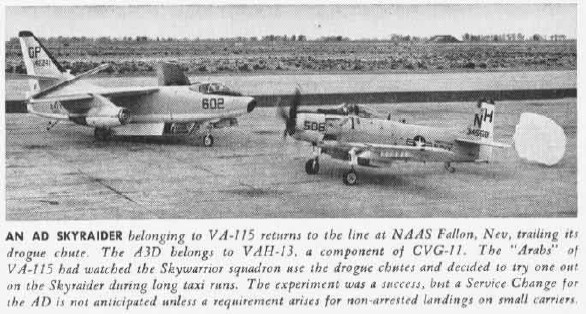
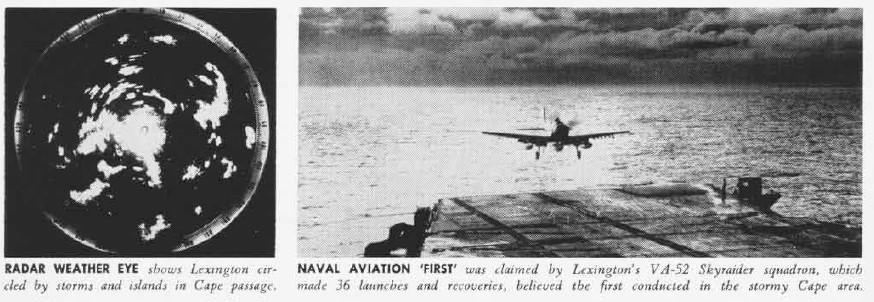
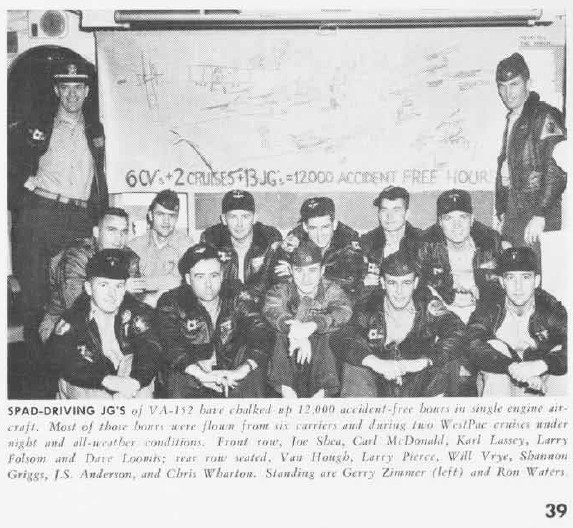
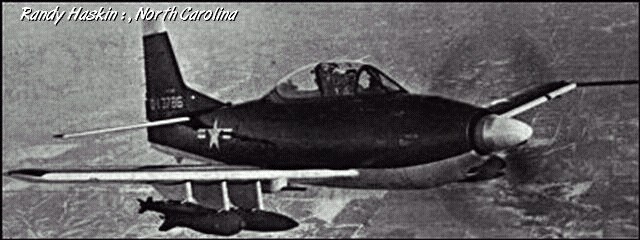
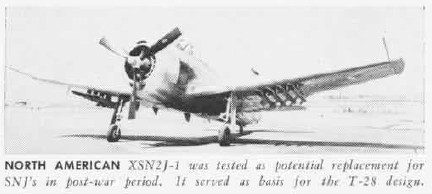
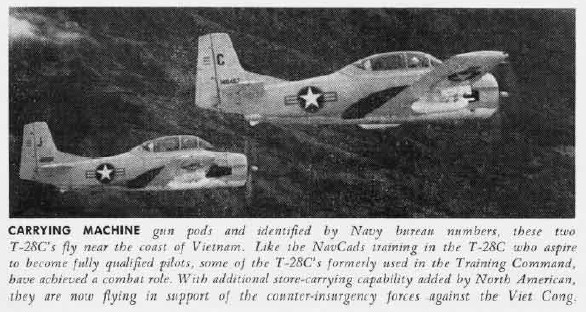
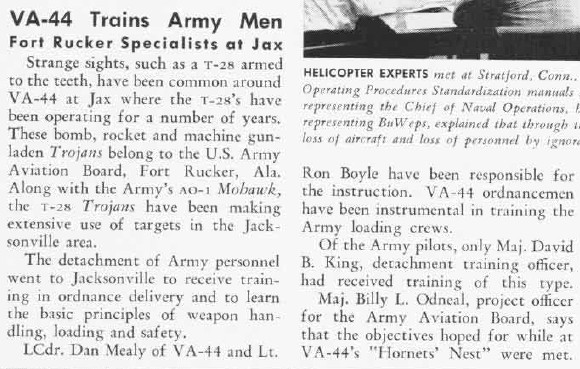
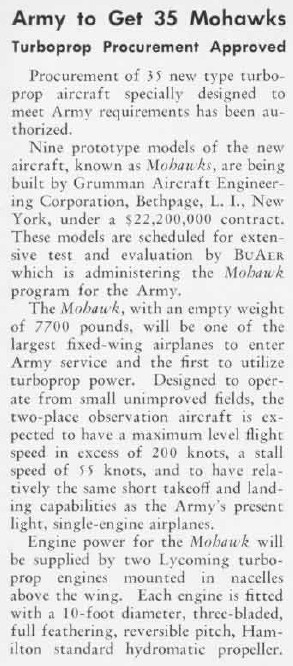
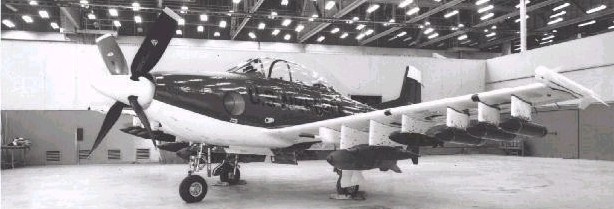
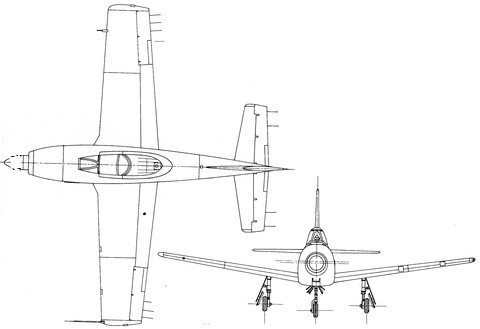
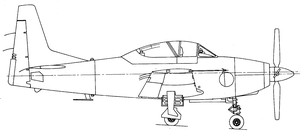
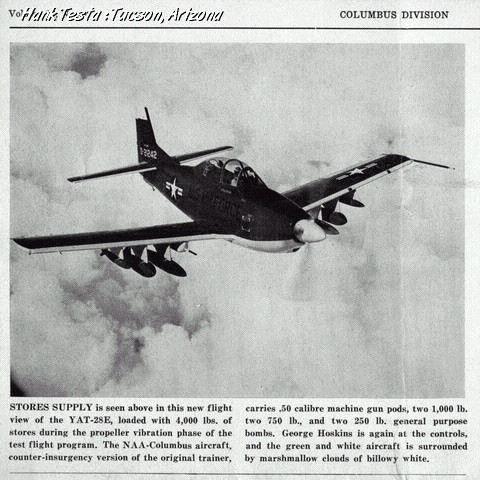
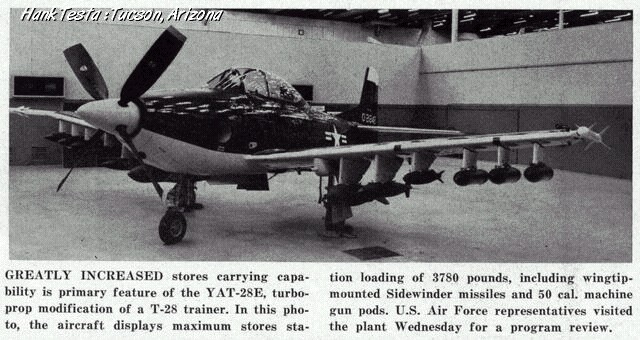
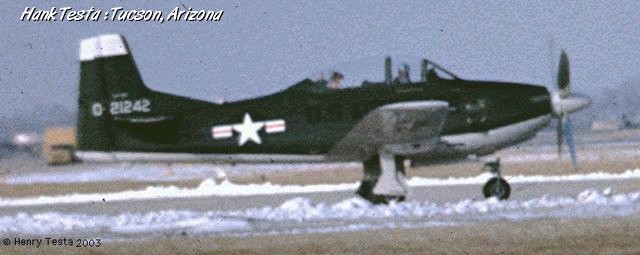
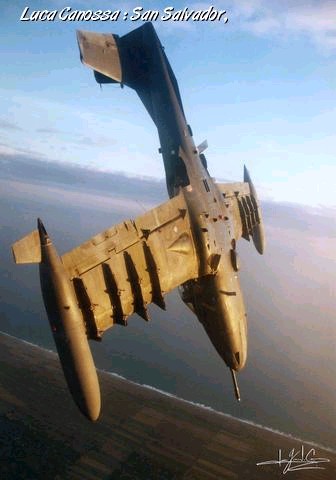
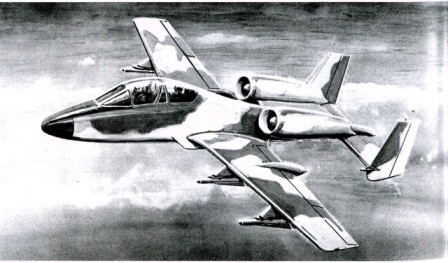
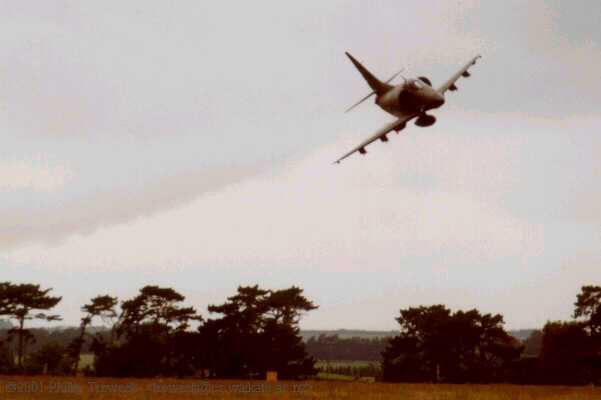
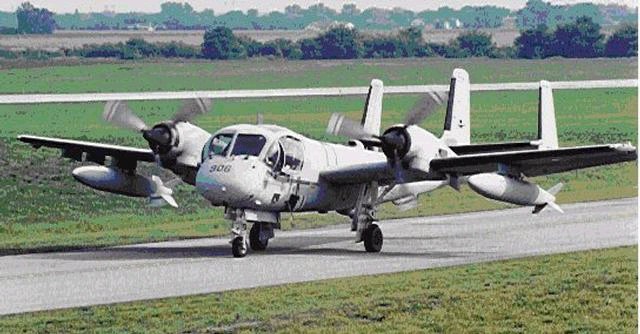
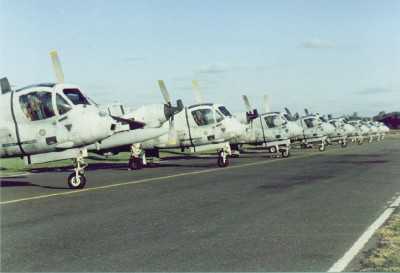
 www.youtube.com/watch?v=FSW7Dqu4e_8
www.youtube.com/watch?v=FSW7Dqu4e_8
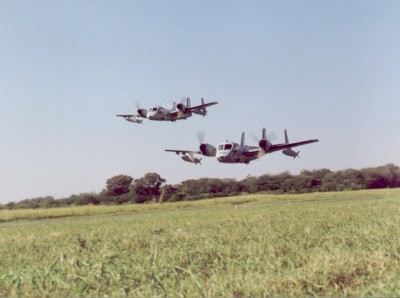
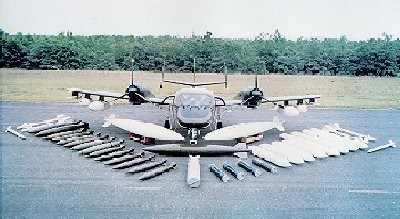
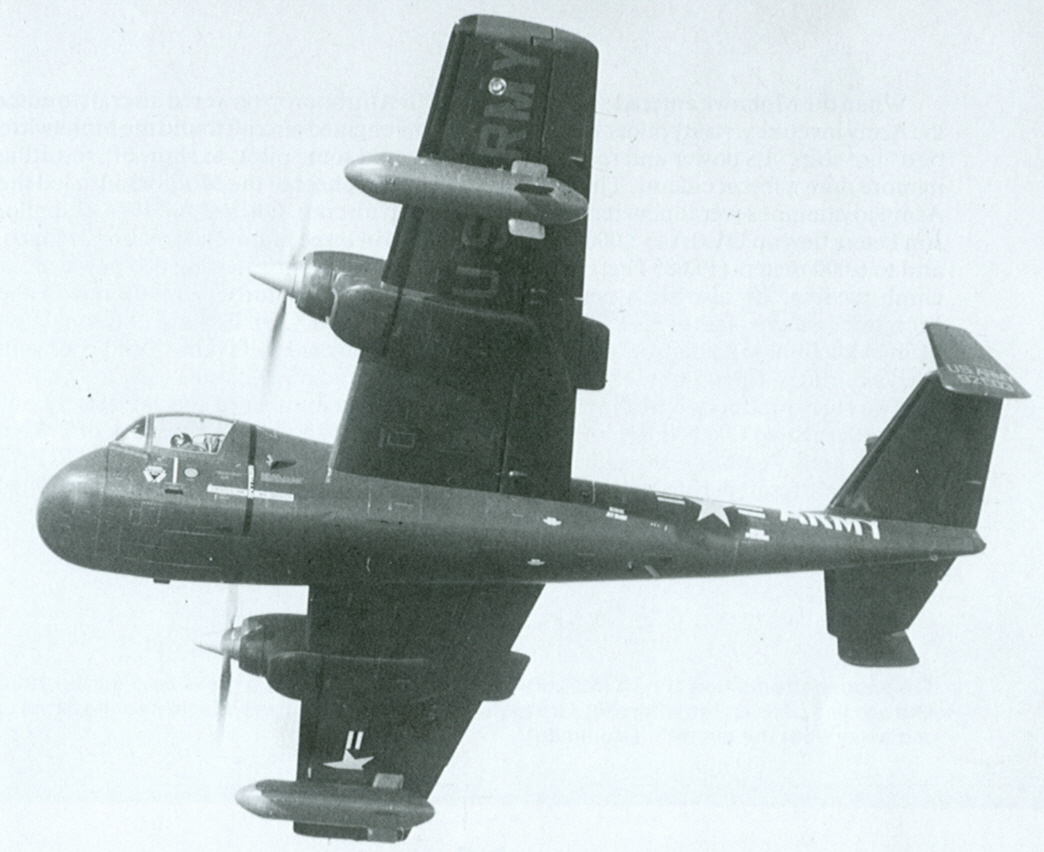
v1.1.1 / 1 of 4 / 01 jun 02 / greg goebel / public domain
[1.2] OV-1A DESCRIBED / JOV-1A
[1.3] OV-1B / OV-1C
[1.4] OV-1D / MOHAWK IN VIETNAM
[1.5] MODIFICATIONS & PROPOSALS
[1.6] CIVILIAN MOHAWKS
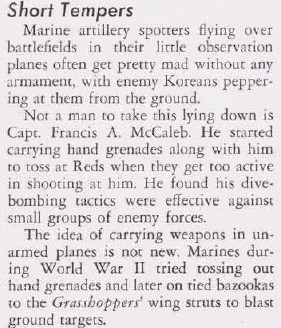
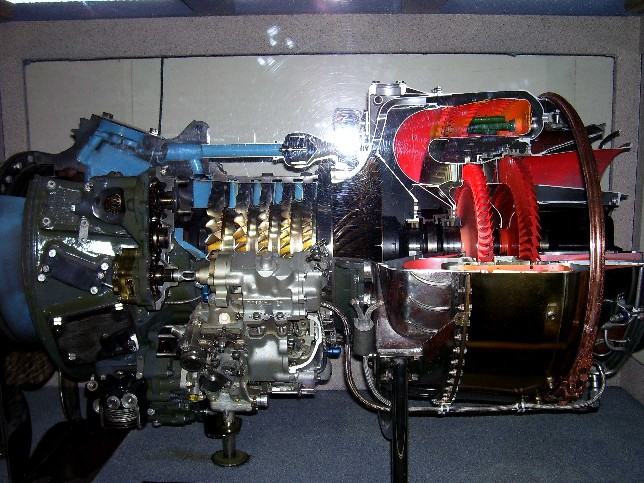
length (no SLAR) 12.5 meters 41 feet
length (with SLAR) 13.69 meters 44 feet 11 inches
height 3.86 meters 12 feet 8 inches
max loaded weight 8,215 kilograms 18,110 pounds
service ceiling 7,620 meters 25,000 feet
range 1,520 kilometers 945 MI / 822 NMI
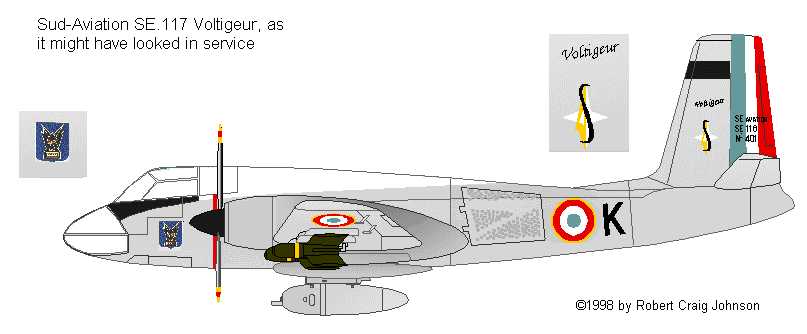
"The Sud-Aviation SE.117 Voltigeur ("Skirmisher") was, with the Dassault Spirale, a competitor for the twin-engined requirement. The SE.117 was a 2-to6-seat multirole aircraft armed with two 30-mm DEFA cannon in semi-external, fuselage pods. Underwing loads could include one 1000-lb and two 500-lb bombs, 24 rockets, or four AS.11 missiles. The pilot and co-pilot/observer sat side-by-side in an extensively glazed nose compartment, well ahead of the low-mounted wing. To facilitate air-to-ground operations at low level, large, perforated dive brakes were fitted on the rear fuselage. The first prototype, the SE.116, flew in December 1958 powered by a pair of 800-hp, Wright R-1300 Cyclone piston engines. Production versions would have had Bastan turboprops. The estimated maximum speed for the Voltigeur was 277 mph (236 mph cruising). Initial climb rate was to be 2677 ft/min and ceiling was 30,800 ft. Range topped 1100 miles and endurance was more than 5 hours. The airplane spanned 59 ft, was 40 ft 6 in long, and had a wing area of 443.5 sq ft.
Hmmmmmmmmmmmmmm.........sounds like an OV-1 Mohawk! ...and it looked like one, if you look at Johnson's art work on his
CHANDELLE web page or see the Voltigeur art above!
"The shorter-ranged T-28s could now be farmed out to fields around the country, where they could respond to calls for close air support much more quickly than the B-26s."
Too bad we didn't have some T-6 Texans or T-28 Nomads armed with GAU-19/A .50 caliber gatlings and laser-guided 2.75 inch Hydra-70mm rockets flying over Iraq/Afghanistan now, huh? Texans Nomads
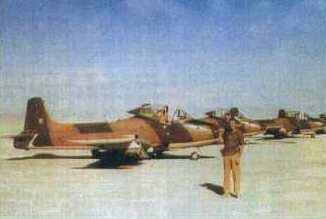
The Bronco did not go unnoticed, however, in the mountain valleys of Bolivia, Columbia, Peru, Thailand, and Burma. The growers quickly recognized the threat and threw their considerable resources against the aircraft. Machine guns, automatic antiaircraft cannon, and shoulder-launched missiles were soon being fired against the Broncos, and it quickly became clear that they were not fully up to the job. They had not been designed for a high-threat environment and were known to be vulnerable to IR-guided missiles and light antiaircraft guns, particularly at the suicidally low altitudes necessary for precise spraying. The aircraft's handling had always been tricky, so it was hard to fly close to the ground, under fire, in high-altitude valleys. The commercial windmill, ducts, and spray bars could not be well integrated with a high-wing, three-pod airframe. The needless extra drag of the resulting, compromise arrangement must have seriously hurt performance and further degraded the aircraft's handling. It was clearly only a matter of time before a Bronco would be lost. After at least one aircraft had a canopy shot out during a low-level run, State apparently enquired into the possibility of up-armoring the aircraft. But the real solution was a new airplane, something better suited to the peculiar operating environment of a drug-eradication aircraft."
Consider how much more robust and crash-worthy, and easy to maintain an armored fixed-wing crop duster would be compared to a fragile twin-tail
Bronco or mechanically complex helicopter...
* Available
* Can land operate fully loaded under 1000 feet dirt strips
* Excellent low-altitude maneuverability to fly NOE
* Definately could be used as MAS COP test surrogates
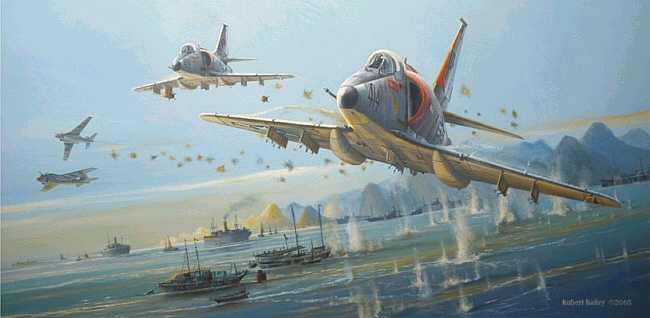
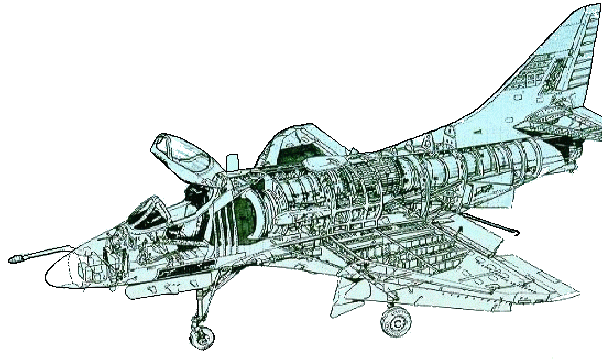
Initial climb rate: 8,440 ft/min
Maximum ferry range: 2,000 nautical miles
Mounts two 20 mm guns internal to the wing root structure
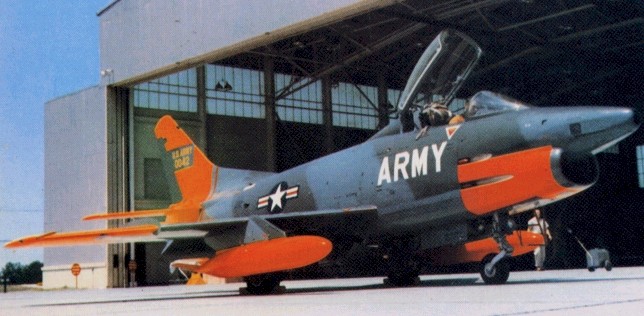
SIDEBAR: JATO for STOL and mini-runways to avoid enemy air base targeting, anyone?
SIDEBAR: JATO for STOL and mini-runways to avoid enemy air base targeting, anyone?
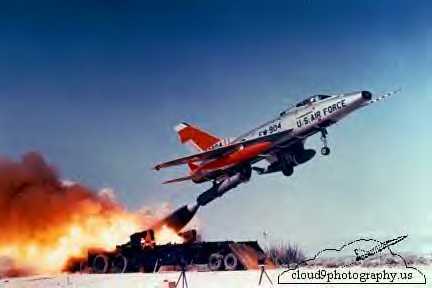
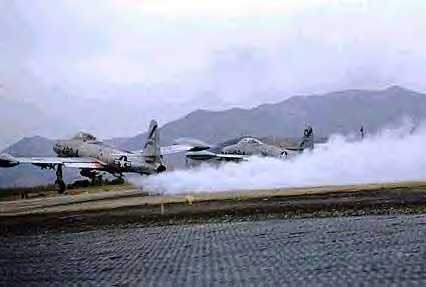

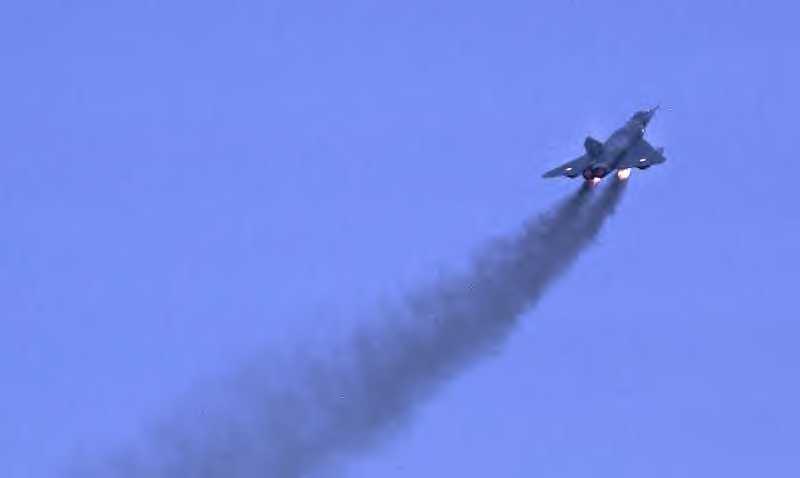
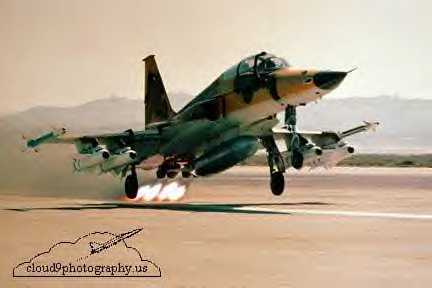
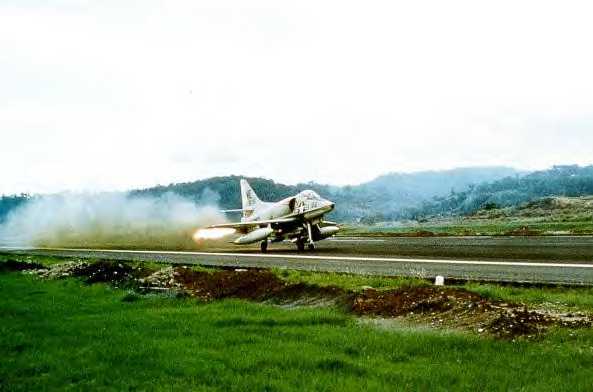
SINGAPORE
"I did the aircraft loss/damage analyses for SEA while working at WSEG. The A-4 had the best survivability rate for aircraft damaged from air defenses on missions into N. Vietnam. It came home to carriers on its damaged single J-52 when F-4s couldn't make it with damage to one of its J-79. The P&W J-52 was tough. Israeli A-4s flew with tailpipe extensions; the secret to taking damage from IR SAMs. IR SAMs are limited in warhead size. They love the AV-8 because: guess where the hot spot is?
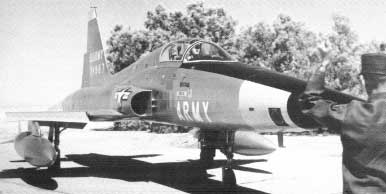
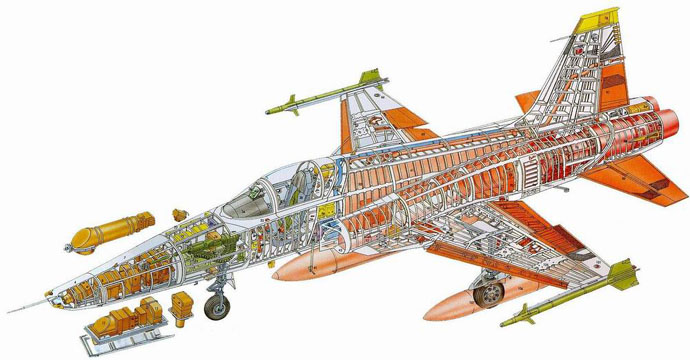
 www.youtube.com/watch?v=SFIyzUdVr-Q
www.youtube.com/watch?v=SFIyzUdVr-Q
 www.youtube.com/watch?v=CGvEdvPBNX8
www.youtube.com/watch?v=CGvEdvPBNX8
 www.youtube.com/watch?v=cGY2vIlF7TM
www.youtube.com/watch?v=cGY2vIlF7TM
 www.youtube.com/watch?v=VVpaGaC-eKI
www.youtube.com/watch?v=VVpaGaC-eKI
 www.youtube.com/watch?v=jfUvhW_WakI
www.youtube.com/watch?v=jfUvhW_WakI
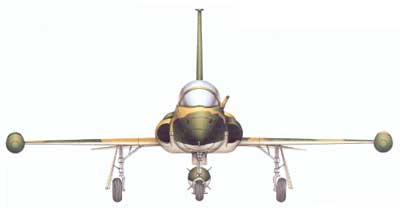
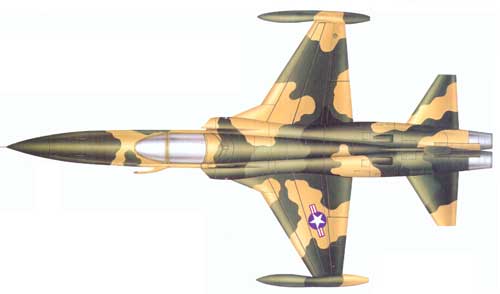

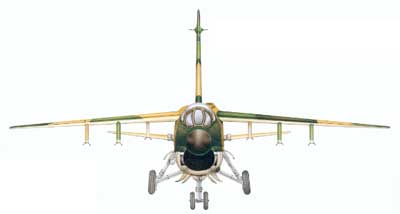
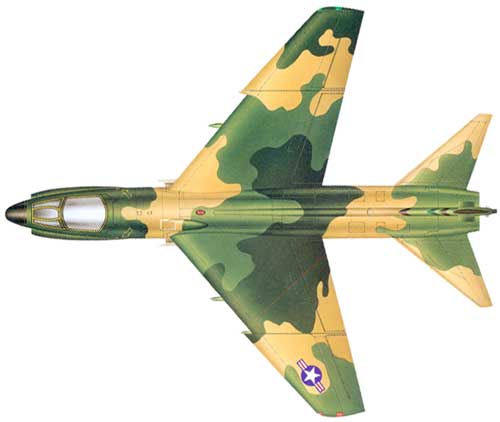
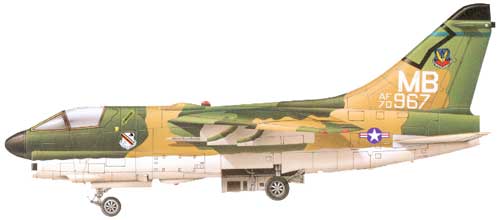
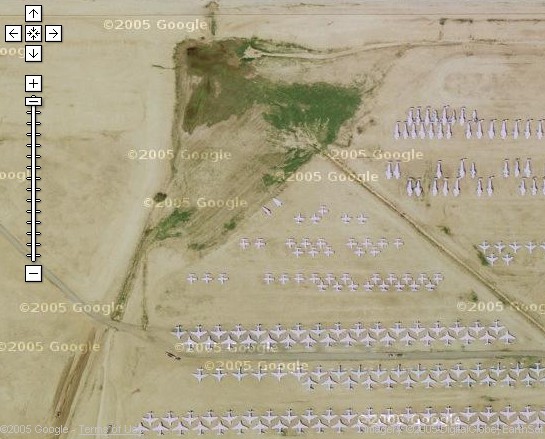
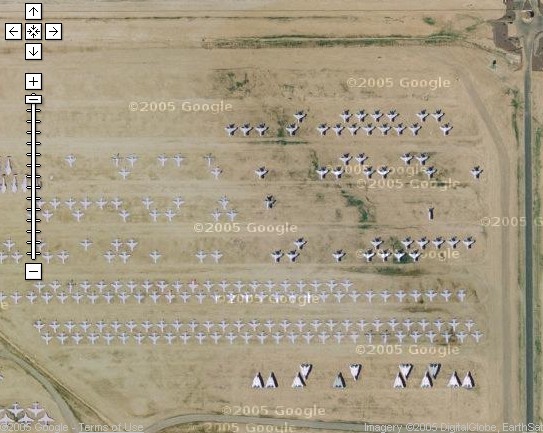
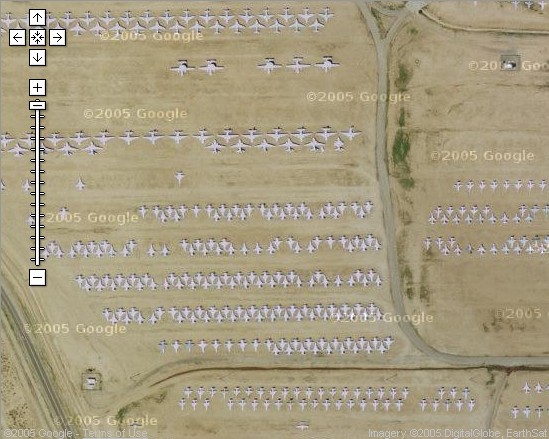
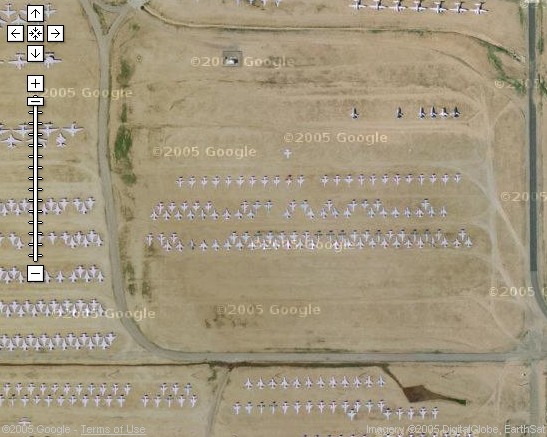
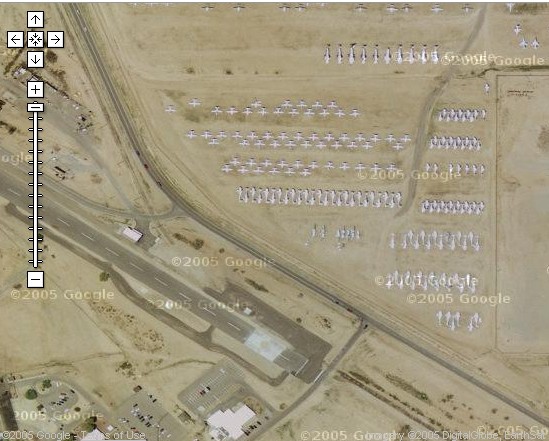
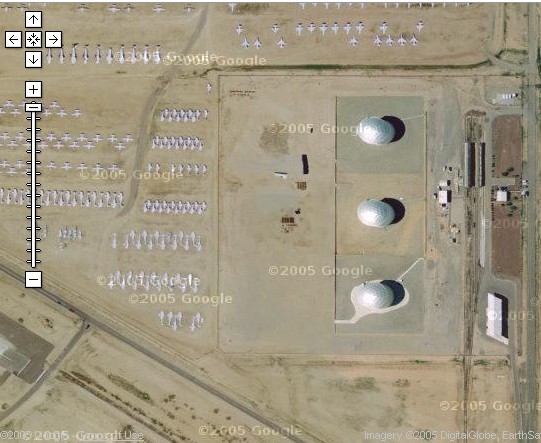
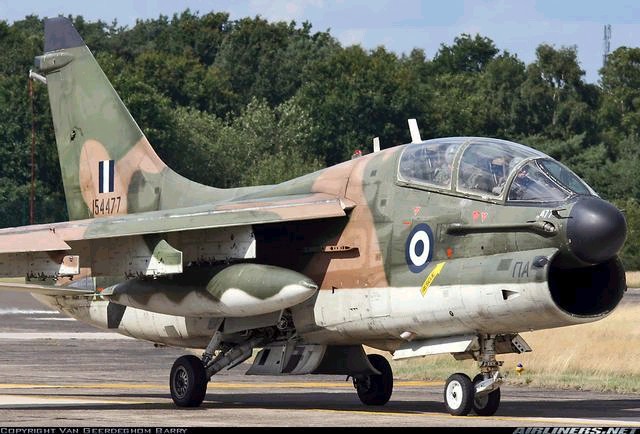
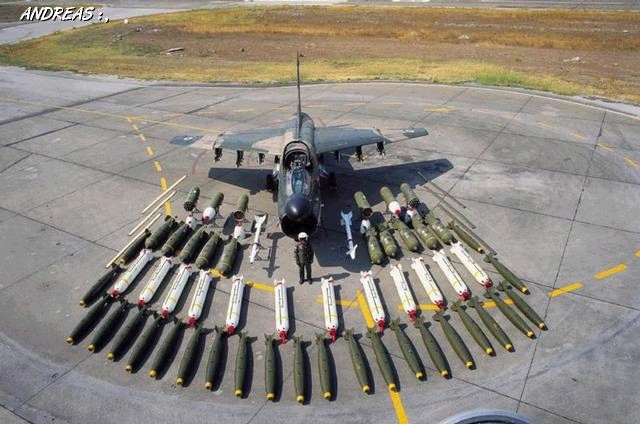
Width, wings folded: 7.24 m (23 ft 9 in)
Wing chord: at root: 4.72 m (15 ft 6 in)
at tip: 1.18 m (3 ft 10 1/4 in)
Wing aspect ratio: 4
Length overall: 14.06 m (46 ft 1 1/2 in)
Height overall: 4.90 m (16 ft 3/4 in)
Max T-O weight: 19,050 kg (42,000 lb)
at S/L: 600 knots (1112 km/h; 691 mph)
at 1525 m (5000 ft):
with 12 Mk 82 bombs: 562 knots (1040 km/h; 646 mph)
after dropping bombs: 595 knots (1102 km/h; 685 mph)
T-O run at max T-O weight: 830 m (6000 ft)
Ferry range:
max internal and external fuel: 2485 nm
(4604 km; 2861 miles)
HEIGHT (m): 4.90
WINGSPAN (m): 11.80
MAX T-O WEIGHT (kg): 19,050
MAX LEVEL SPEED (knots): 600
T-O RUN (m): 1830
TA-7C or A-7K: Two seats
Range greater than 1,900 nautical miles
AVQ-7 raster HUD
ASN-91 INS, ASN-190 Doppler navigation system
ASU-99 projected map display
ALR-45 RWR
ALR-50 SAM warning system [Magnavox]
ALQ-126 ECM [ Sanders]
APR-43 tactical radar warning system [Loral]
ALQ-119 ECM [Westinghouse]
ALQ-131 ECM [Westinghouse]
ALQ-123 IR countermeasures [Xerox]
ALQ-126 DECM [Sanders]
ALQ-162 tactical communications jammer [Eaton AIL]
ALQ-162 radar jammer Northrop
Six wing pylons
Two fuselage launch stations
Pylons can carry a large single weapon, multiple racks capable of six weapons per rack, or triple racks with three weapons per rack.
Can carry 15,000 pounds of payload
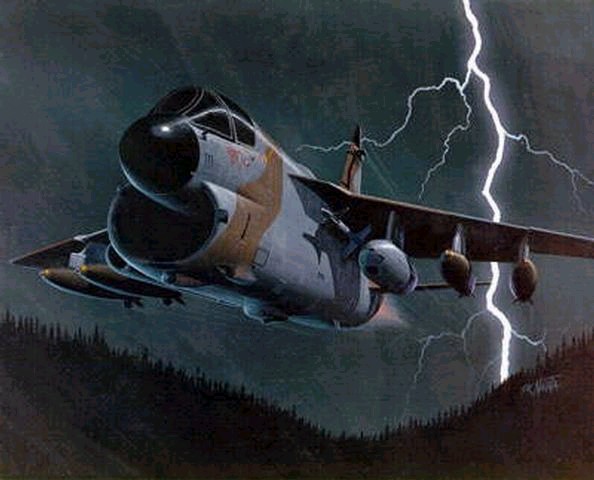
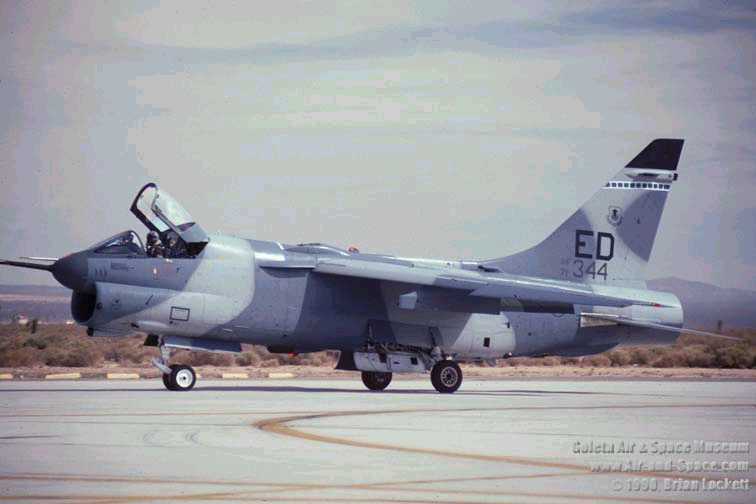
U.S. Army A-37s?
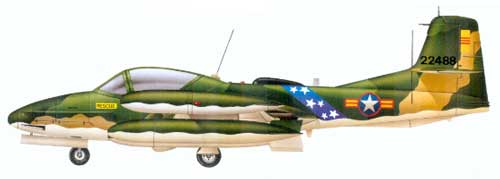
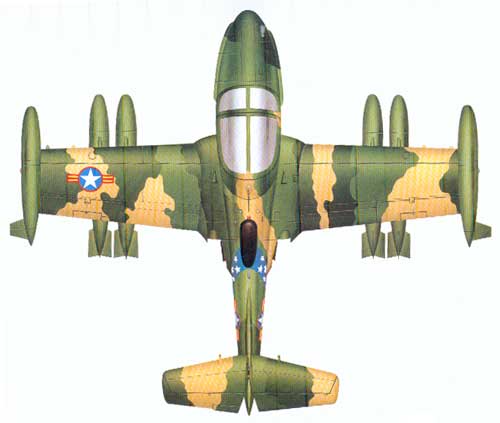

Year: 1967
Type: attack
Manufacturer: Cessna Aircraft Company
Engine: 2 x General Electric J85-CE-17A
Power: 2,850 lb (1,293kg)
Wingspan: 35ft 101/2 in (10.93m)
Length: 29ft 3in (8.92m)
Height: 8ft 101/2 in (2.70m)
Wing area: 183.9sq ft (17.09m²)
Max take-off weight: 15,000 lb (6,804kg)
Empty weight: 5,873 lb (2,670kg)
Max speed: 478mph at 15,000ft (769km/h at 4,572m)
Service ceiling: 32,100ft (9,785m)
Range: 450mi (724km)
Crew: 2
Load-armament: 1x 7.62mm minigun; 5,400 lbs ordnance bombs, rockets, gun pods (2,450kg)
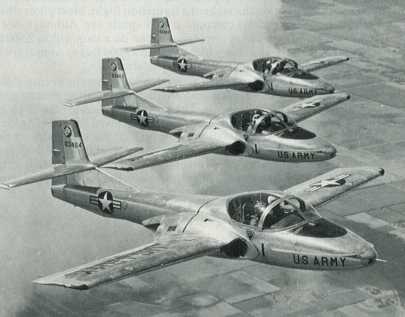
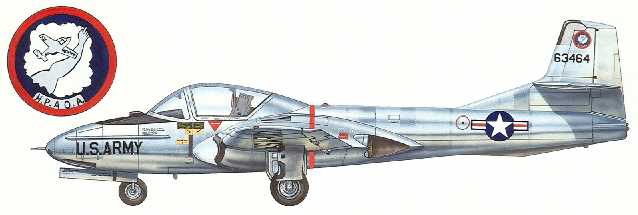
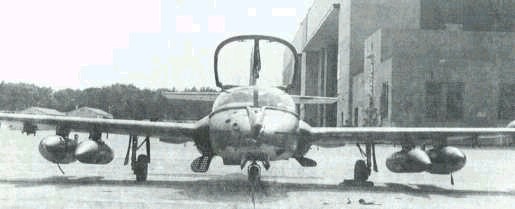
"Airborne FAC and emergency CAS work is not a mission activity to be performed sporadically on the third Tuesday of each month. You have to "live down there" at low altitudes. And, some guys will hit the target with the airplane once in a while. But, after a couple of months, we won't have any loses due to ground impact. Nobody in my squadron ever flew over a target area above 150 feet (that was considered too high for safety ---- the high guy is the target for the air defenses). Stay in the MASK stupid! Our helo folks understand that.
"
"Chuck, as someone who really believes that the A-1 (that's not a mistake, I mean the SkyHawk of WWII, Korea and Vietnam fame) is still a better CAS platform than anything we now have, I couldn't agree more that slow and low is the way to live for a ground support aircraft. However the air force has moved on to "fast and high".The reason I believe that the CAS mission should be turned over to the Army is because the AF want to go higher and faster still and going in the other direction it would be like birds deciding to walk, possible but not reasonable. I understand that this would take an act of Congress, but that seems much more likely to me than the AF ever going back to 150ft. over a target. Of course maybe if we had another major war????
"

"The purpose of escort is to protect aircraft against ground and airborne threats that cannot be avoided ( flown over, under, or around ) or neutralized by defense suppression operations. Assault support operations must include attached armed escort in all but the most benign scenarios to ensure mission success and protect U.S. lives. The current AH-1W fulfills the escort role only marginally and enhancements will be costly and lengthy in time to complete. Even enhanced, the Cobra will not be advanced enough to escort the MLR."
"In a parallel program, the marine corps has developed a Draft Mission Needs Statement for a future attack aircraft to replace the Cobra, UH-1N, and OV-1OD. A complete list of requirements can be found in Tab A. This aircraft has been designated the VMAO because it covers the attack, utility, and observation roles of the three aircraft it will replace. The MNS envisions the VMAO as a tandem seat, 20 to 25 thousand pound maximum gross weight aircraft with a mission configured, unrefueled range (sea level standard day) of 500 NM, a sustained operating envelope of -45 KTAS to 325 KTAS, and a 30 minute dash speed of no less than 350 KTAS. It must be capable of routine shipboard operations with rolling/pitching deck conditions up to a maximum deck displacement of 15 degrees roll and +or- 3 degrees pitch. The aircraft must be capable of engaging and disengaging primary flight propulsion systems (engines, rotors, proprotors) in winds of 45 knots from any direction.
(2) Dual engine aircraft with autonomous self-starting
capability. The aircraft shall be capable of powering all onboard
systems for maintenance or pre-mission tests through its integral
auxiliary power unit. It shall also provide sufficient power for
engine starting while powering critical mission equipment without
power interruption.
(3) Have sufficient engine power so that with one engine
inoperative, cruise flight may be continued with full ordnance
payload and sufficient fuel onboard to fly either the point of
intended landing or return to the point of origin, whichever is
shorter, and land (STOL) with a ground or deck roll of less than
100 feet (with a 15 knot headwind).
(4) In the event that all engine power is lost while in
flight, the aircraft must be capable of a power off
glide/auto-rotation to a survivable emergency landing.
(5) Minimum 30 percent dash speed advantage over the MLR.
(6) An expanded flight envelope and "g" range commensurate
with air-to-ground and air-to-air flight profiles (minimum desired
range -1.5 to +5.0).
(7) Capability to conduct continuous/extended (over 30
minute) hover operations while mission configured, without
significant degredation to aircraft range, performance, and time
on station.
(8) Have a self-deployable range of 2100 NM when configured
with a full internal fuel load and external fuel tanks. Retain
the capability to upload 2 AIM-9X missiles and 750 rounds of 20/25
millimeter ammunition when in the ferry configuration. Complete
the 2100 NM flight in not greater than 10 hours.
(9) Have an inflight refueling capability.
(10) Expanded ordnance payload capability ( multiple
universal weapons stations which facilitate and aircraft
configuration of not less than 12 precision guided weapons, 38
rockets, 2 AIM-9Xs, or an equivalent load. The VMAO will be
configured with an internal/ turreted gun capable of employing
1500 rounds of 20/25 millimeter ammunition.
(11) Ballistic tolerant (at least 14.5 millimeter)/
crashworthy cockpit and critical components.
(12) NBC protection up to MOPP IV level.
(13) Economical incorporation of low observable radar, IR,
and acoustic signatures.
(14) Onboard, state-of-the-art mission planning system/data
loader (paperless cockpit concept).
(15) Fully integrated observation (enhanced optics
day/night with multi-powered zoom lens capability), detection,
navigation, communication, and targeting systems, combining active
and passive means to acquire, designate, and engage targets at
ranges in excess of 10 kilometers.
(16) Heads-Up/ Heads-Out cockpit design. A computer driven
holographic HUD capability, or existing state-of-the-art visor
display systems, which facilitate mission accomplishment and the
projection of FLIR/TV imagery in a heads-up/heads-out manner.
(17) Hands on Collective and Cyclic (HOCAC) cockpit design.
(18) Fully integrated defensive electronic countermeasures
system capable of identifying, displaying, prioritizing and
jamming/ decoying anti-air warfare systems to include ground and
airborne delivered Anti-Tank Guided Missiles.
(19) Long range (OTH) precision navigation capability.
(20) an offensive air-to-air capability superior to
anticipated threat helicopter/tiltrotor and low-performance fixed
wing aircraft. A self-defense capability against high performance
fixed-wing aircraft.
(21) Capability to transmit and receive digital data burst
information from/ to ground and airborne platforms. Capability
for real time data link of FLIR/Optical imagery to/ from ground or
airborne receivers.
(22) Capable of sloped landings and take offs up to a
maximum displacement angle of greater-than or equal-to 15 degrees.
(23) Incorporation of zero/zero ejection seats.
(24) Long range (OTH), low-altitude, secure and jam
resistant communications capability."
SUCCESS STORY: THE SAAB SUPPORTER CAS O/A ATTACK AIRCRAFT GOES TO WAR
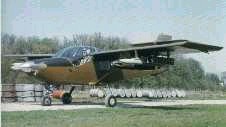
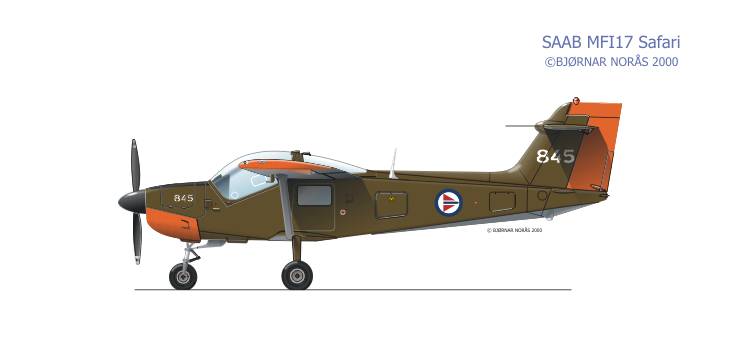
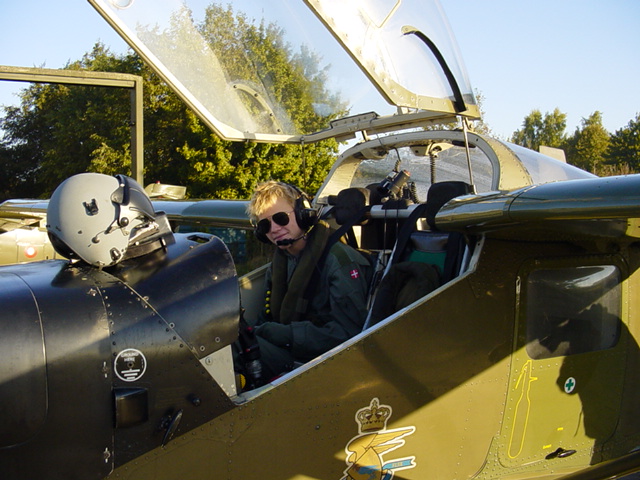
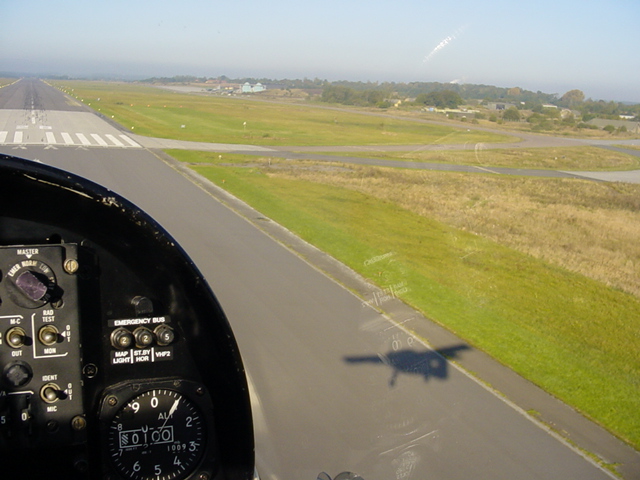
1.0 Aircraft Manufacturing Factory
1.1 SAAB Supporter/ Mushshak
Its most famous civilian use has been the relief work initiated by Count Carl Gustav von Rosen who airdropped sacks of grain using the wing ordnance hardpoints. Denmark and Zambia each took 20 aircraft, the former for training and liaison roles, and the latter for the training and counter-insurgency roles. Before using Saab Supporters to drop relief supplies, von Rosen flew relief supplies into Biafra using large cargo aircraft despite enemy opposition. Sterling Seagrave's Time-Life "Epic of Flight" book,
Soldiers of Fortune, 1981, details how Count von Rosen created a "Minicoin" air squadron of MFI-9 Saab Supporters flown by western and native pilots that destroyed enemy MIG fighter-bombers on the ground allowing relief supply aircraft to land and saved the day for Biafra freedom fighters in Africa. He later used these type aircraft to drop food to starving people in war-torn Ethiopia.
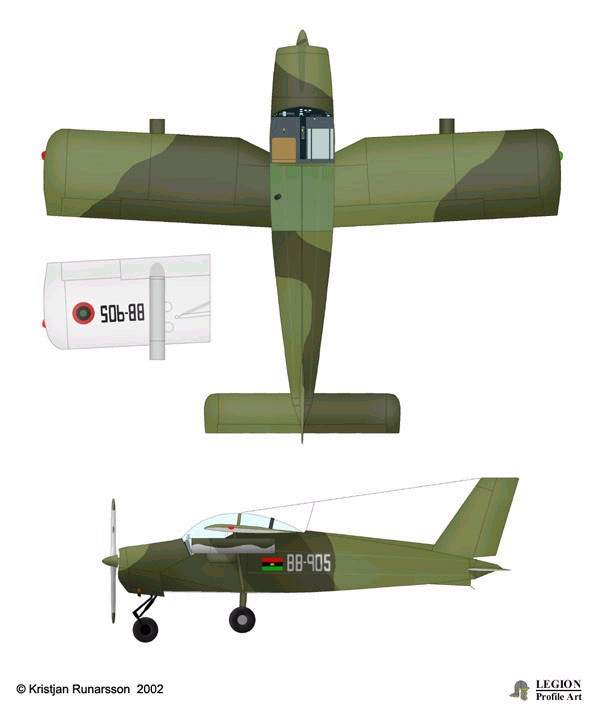
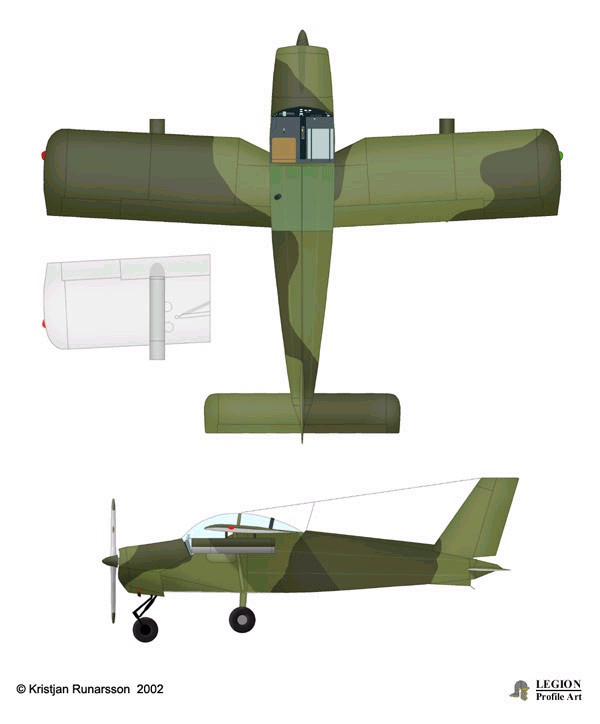
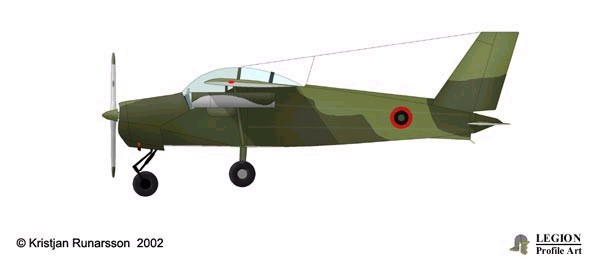
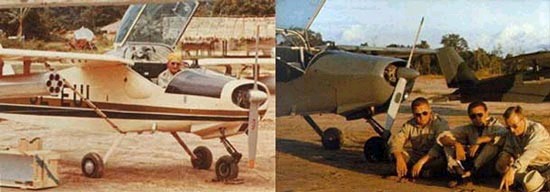
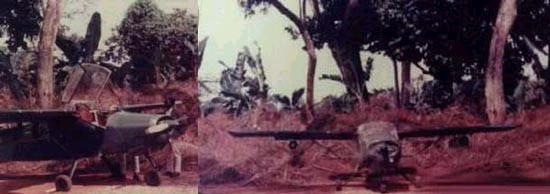
"Von Rosen had broken the Nigerian blockade, but he quickly realized that this was only a temporary solution to Biafra's agony. A fantastic scheme -- a plan that went far beyond the transportation of foodstuffs and medical supplies -- was beginning to take shape in his mind. It was the fate of the starving Biafran children that clinched it. 'I soon realized,' the idealistic Swede would later observe, 'that every priest, every doctor, every black and white man in Biafra was praying for arms and ammunition before food, because the idea of feeding children only to have them massacred later by cannon fire from Saladin armored cars or MIGs doesn't make sense.' His plan, von Rosen explained, 'was not to add fuel to the war but to keep the sophisticated war machine that the Nigerians have at their command away from the little children.'"
Pages 132 - 136
"After a whirlwind tour of the world in a fruitless attempt to mobilize humanitarian aid for Biafra on a massive scale, Carl Gustav von Rosen returned to that battered would-be nation just before Christmas of 1968. There he learned that the besieging Nigerians were getting ready to further constrict the flow of weapons to Biafra and destroy the vital airstrip at Uli. If anything was to be done for Biafra, von Rosen decided, he would have to do it himself. And he believed so strongly in Biafra's cause that he would offer his services without pay. He told Biafran officials of a daring plan that was taking shape in his mind and then returned to Sweden to start getting it under way.
Other Details:
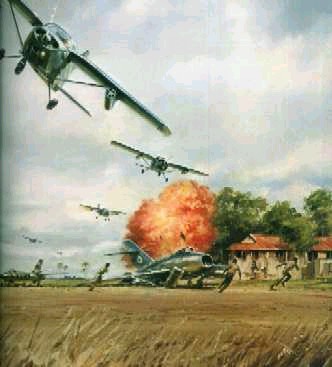
Empty weight: 340 kg
Length: 5.85 m
Max t/o weight: 575 kg
Height: 2.00 m
Payload: 235 kg
Wing area: 8.7 m^2
Fuel: 56 kg
Max altitude: 4500 m
Max speed: 240 km/h
T/O run: 150 m
Vne: 305 km/h
Landing run: 130 m
Cruising speed: 236 km/h
Range: 800 km!
Economy cruise: 210 km/h
Endurance: 4 hours
Stall speed: 80 km/h
Load factor: +4.4Gs/-1.76Gs
Il-28 1/0
Canberra 1/1
"Intruder" 1/0
2 engine transport 1/0
Helicopters 2/1
Trucks 7/1
Radar 1/0
ATC tower 1/1
Terminal bldgs 2/0
Power plant 1/0
Ammo storage 1/0
Headquarters 3/0
AAA 2/0
Oil pump station 1/0
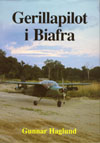
The Swedish military aviation page
Last modified 1996 Jan 10 by Urban Fredriksson
griffon@canit.se
Crew: Two or three seat.
Engine: 200-hp Lycoming IO-360-A1B6 flat flour piston engine.
Speed: 146 mph. at sea level.
Ceiling: 13,450 ft.
Rate Of Climb: 807 feet-per-minute.
Maximum take Off: 2,646 lbs.
Length: 22 ft. 11.6 in.
Height: 8 ft. 6.4 in.
Wing Area: 128.09 sq. ft.
Armament: up to 661 lbs. of disposable stores.
Mushshak Pakistani model
Iran: 25 Mushshak
Norway: Safari
Oman: 3 Mushak
Pakistan: license production
Sierra Leone: Safari
Syria: 6 Mushshak
Zambia: Supporter
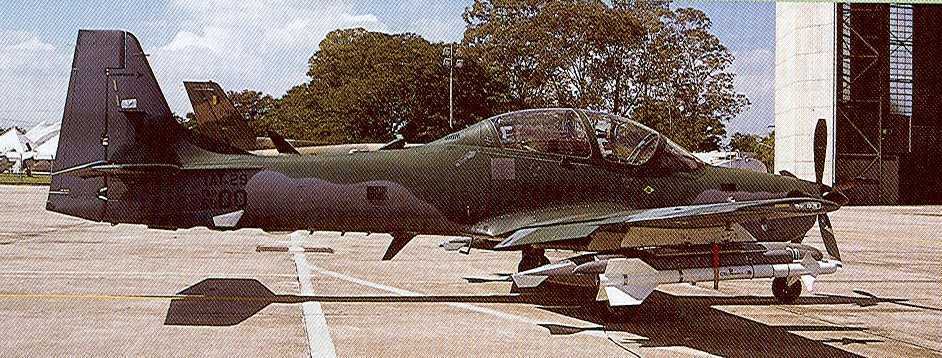
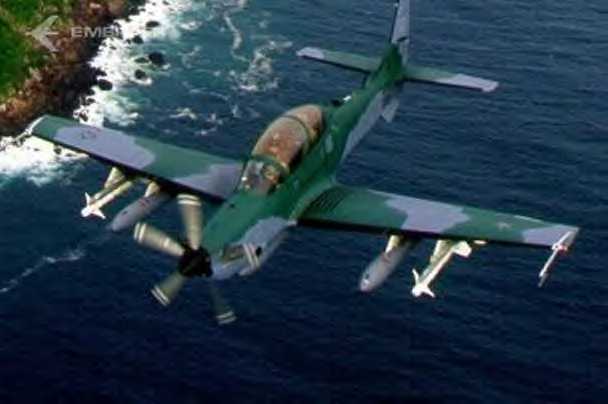
"Its important to recall that my concept (Maneuver Air Support) evolved from scores of interviews with ground combat veterans and pilots who had significant air support experience and led to my definition of air support for smalll forces engaged, or who want engagement or are trying to avoid it. Solution is the Continuous Overhead Presence (COP) of a Joint Air Attack Team composed of a Spectre and a number of fixed-wing ASPs (Agile/Survivable/Potent) flown by trained/experienced pilots who have had extensive practice WITH the ground combat element they are supporting (unit cohesion).
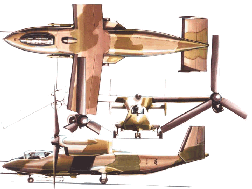
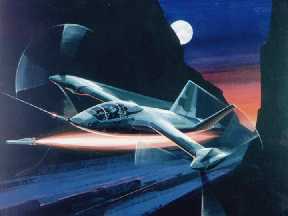

 BREAKING NEWS! DoD AGREES WITH US! (Better Late than Never).
BREAKING NEWS! DoD AGREES WITH US! (Better Late than Never).
 www.youtube.com/watch?v=tGKqSslEDIM
www.youtube.com/watch?v=tGKqSslEDIM



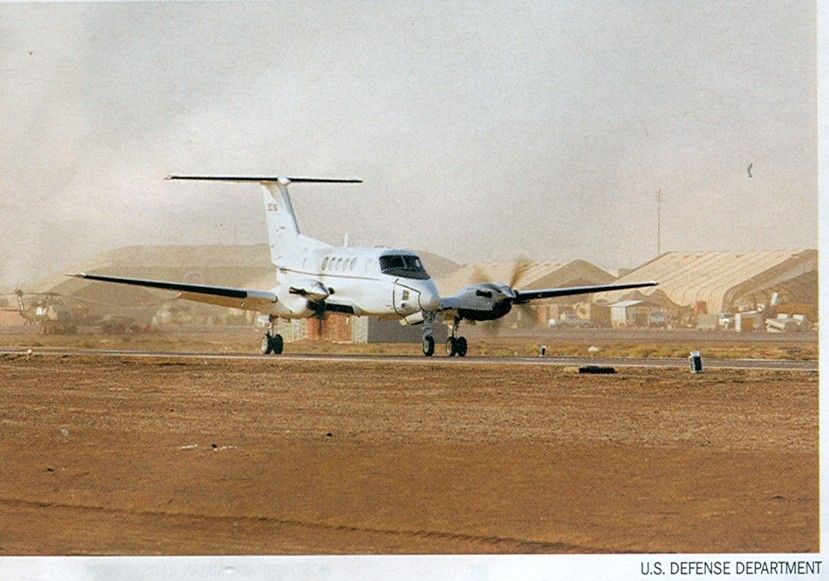
Primary Role: Staff transport
Length: 43 feet, 9 inches (13.34m)
Height: 15 feet (4.57m)
Armament: None [We can fix this!]
Engines: Two Pratt & Whitney PT6A-42 turboprops
Horsepower: 850 shp (634kW) per engine
Crew: 2
Max Takeoff Weight: 12,500 pounds (5,670kg)
Max Payload: 2,647 pounds (1,201kg) or 8 passengers
Max Speed: 339 mph (545km/h)
Range: 1,965 nm (3,641km)
Service Ceiling: 25,000 feet (7,620m)
Cruises at 300 mph
Weight with Guardrail sensors: 16,000 pounds
Range 1,400 miles
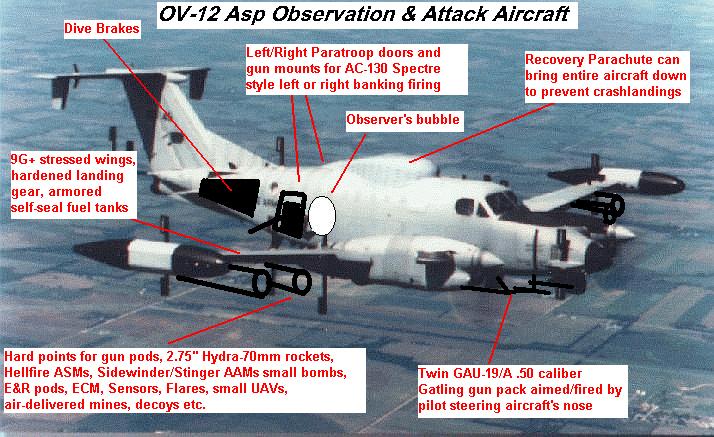
Attack
Forward Air Control
SOF/LRSU/Ranger Paratroop insertion/extraction
CASEVAC
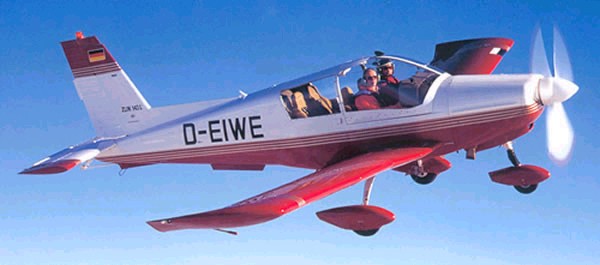
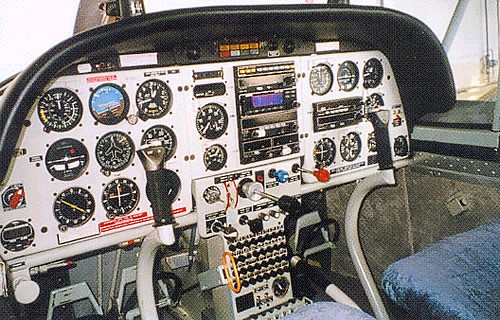
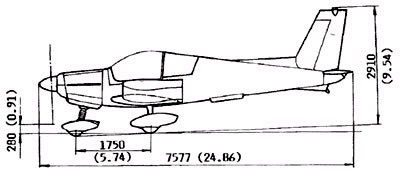
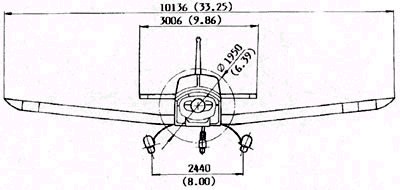
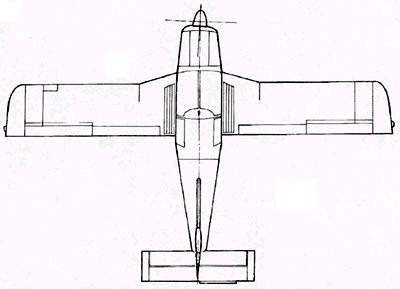
 www.youtube.com/watch?v=8oXUdKZ-2q4
www.youtube.com/watch?v=8oXUdKZ-2q4
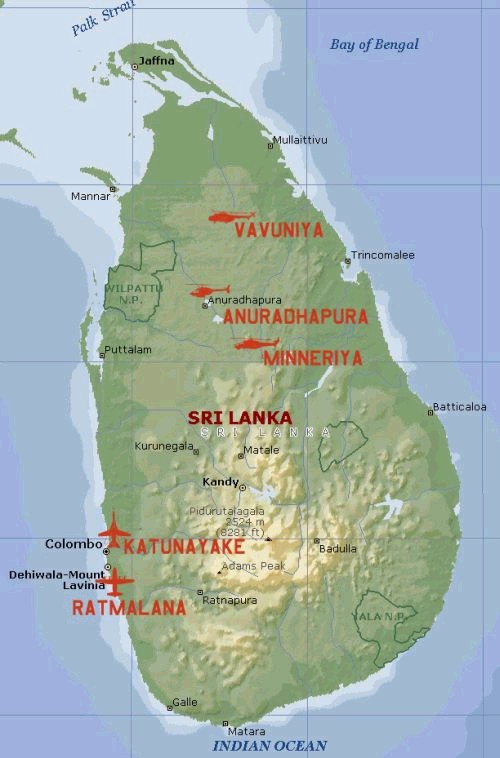
Tamil Tigers in deadly air attack
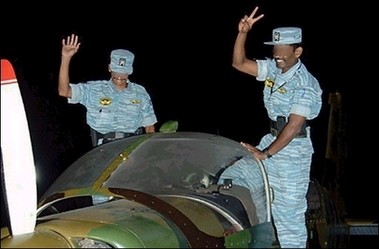
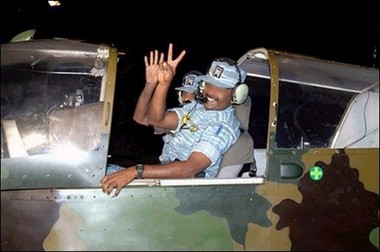
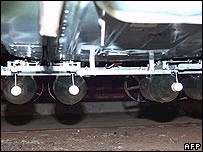
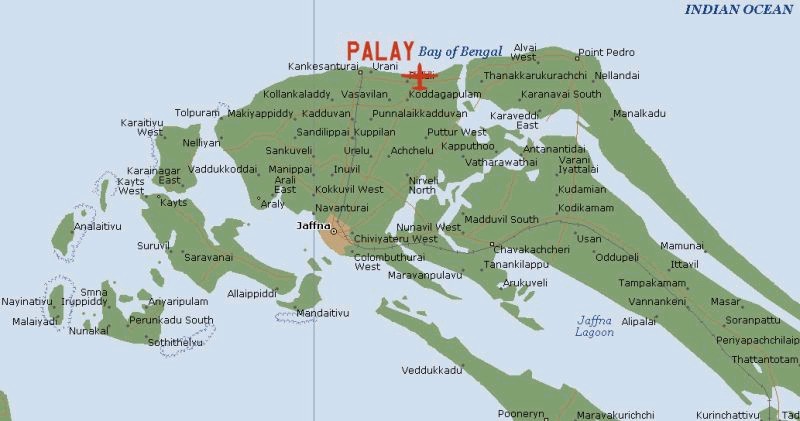
LTTE use of unconventional air power
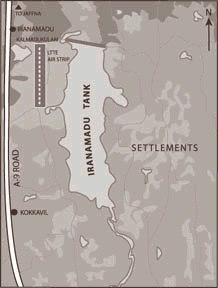

SLAF Kfir is a fast fighter-bomber able to avoid MANPAD SAMs and has adequate bombing accuracy to do CAS for the SLA but is ill-suited to chase down slower, more agile at low altitude aircraft like the LTTE's Zlin 143s to do the COIN air-to-air role
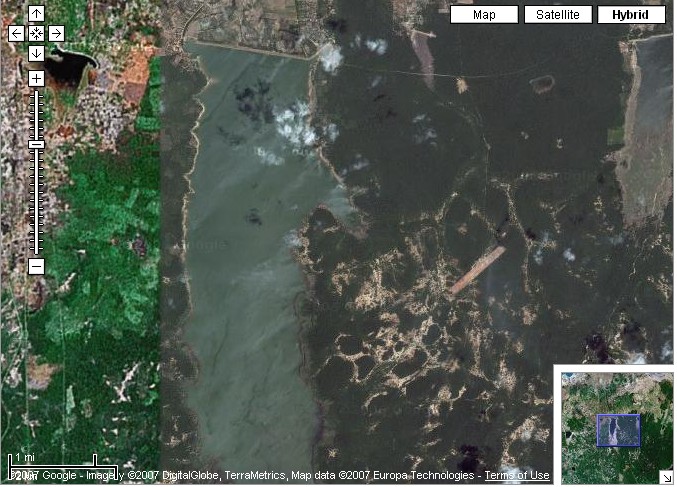
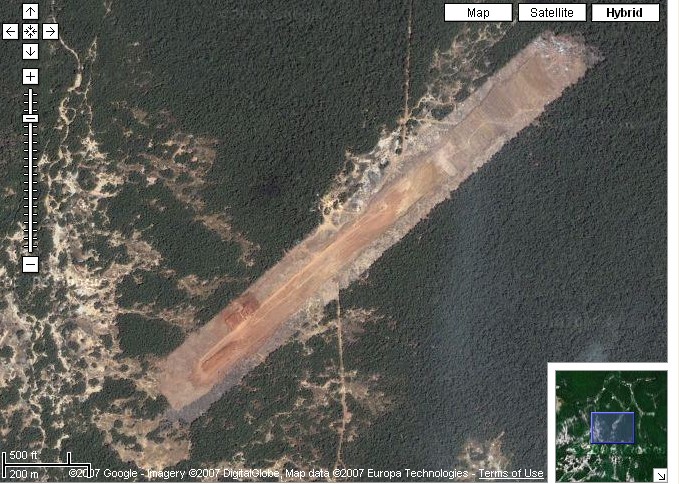
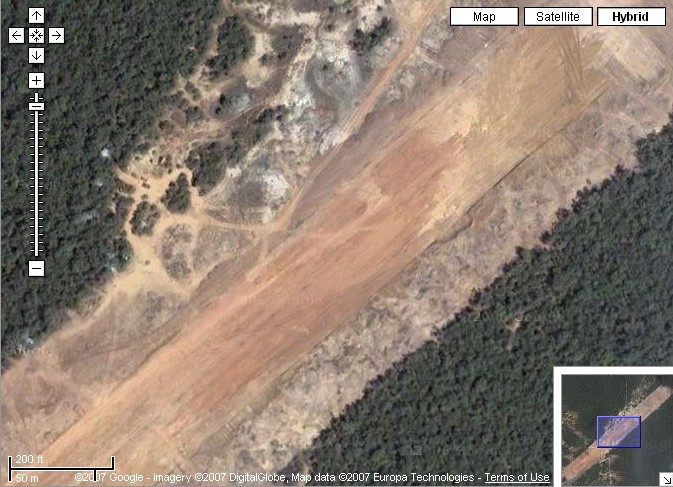
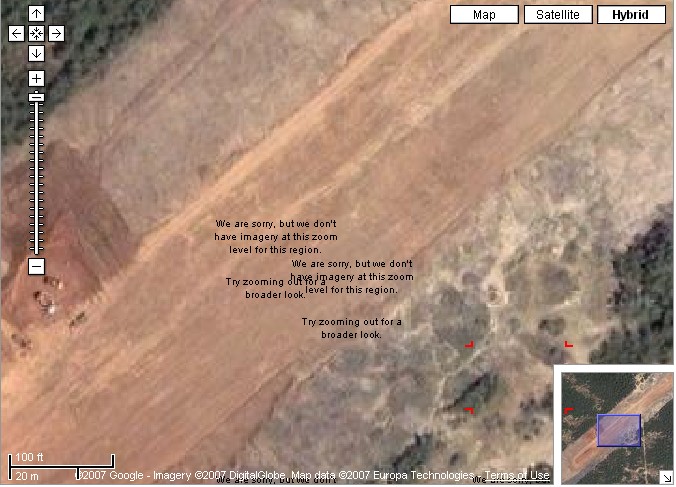
Coercive Airpower in the Eelam Conflict- Taraki
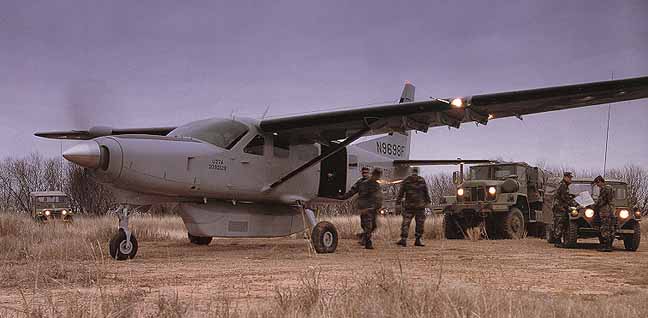
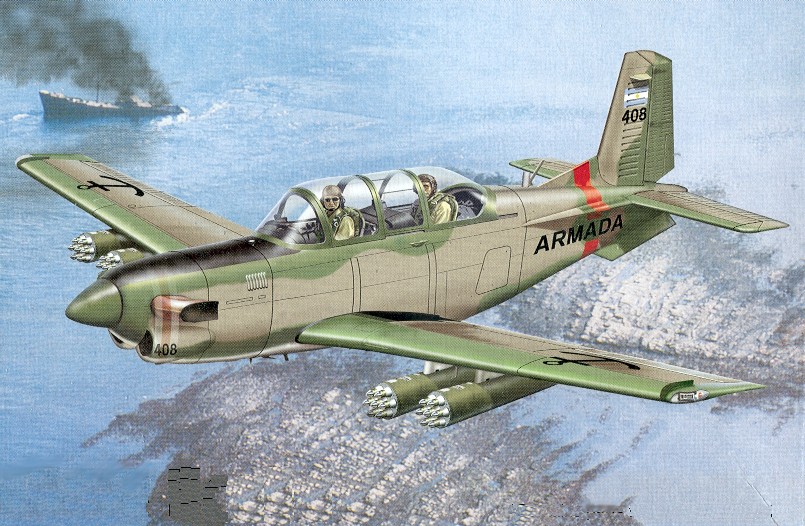
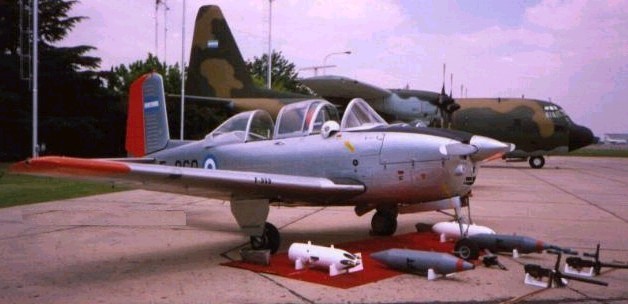
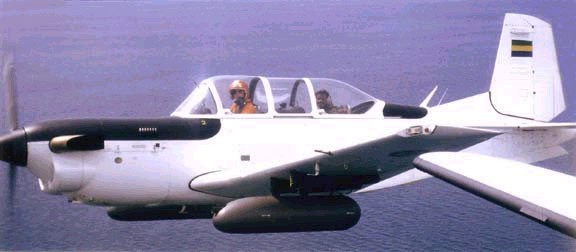
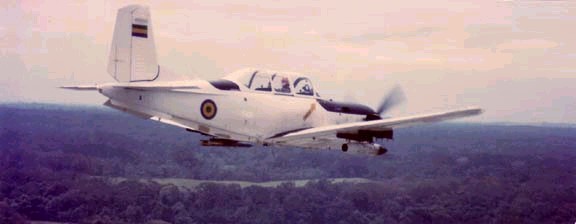
 www.youtube.com/watch?v=N3Pn_oYNZKc
www.youtube.com/watch?v=N3Pn_oYNZKc
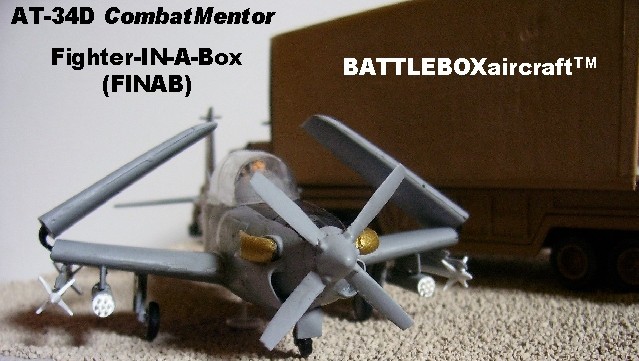
Military Plane Crash Kills Two
John Gilmore
BRS Inc.
300 Airport Road
So. St. Paul MN 55075
(651) 457-7491
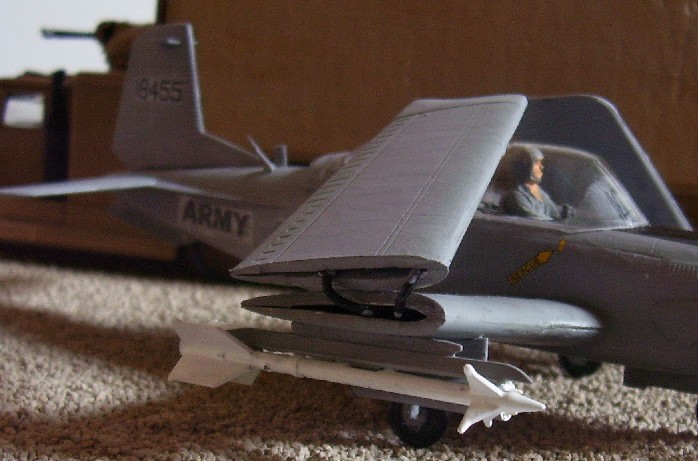
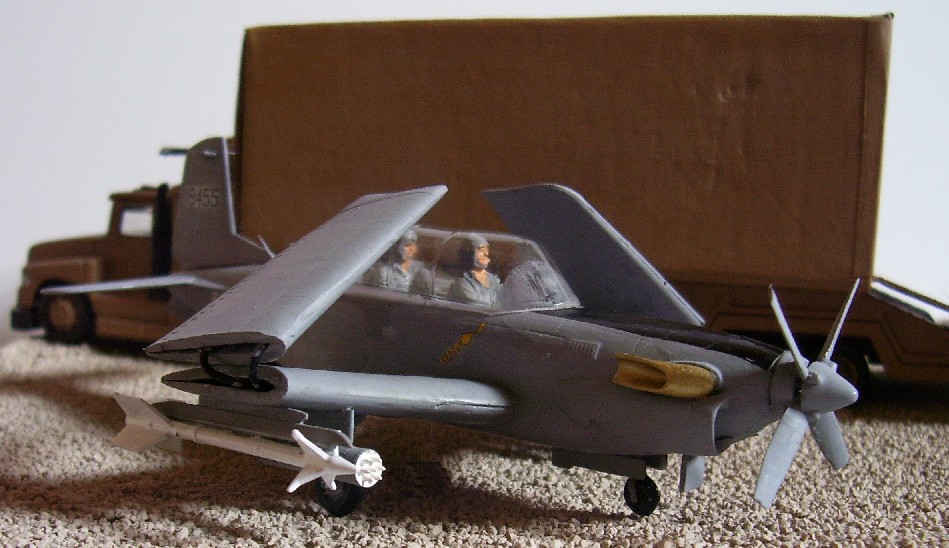
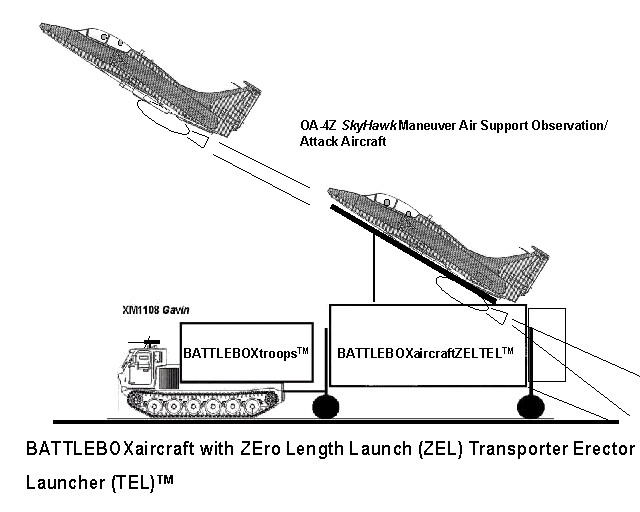
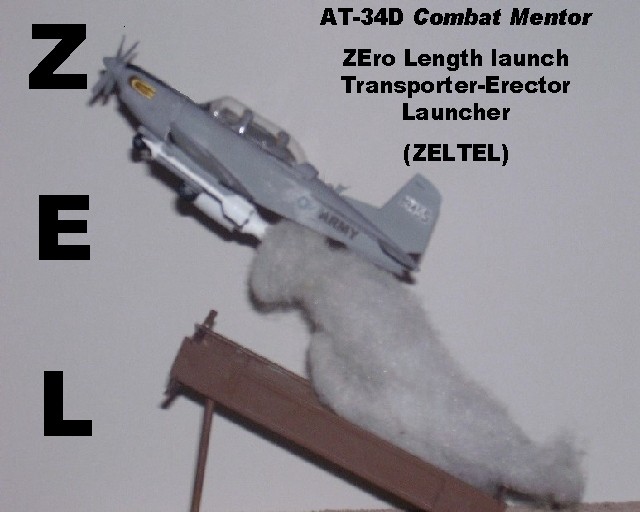
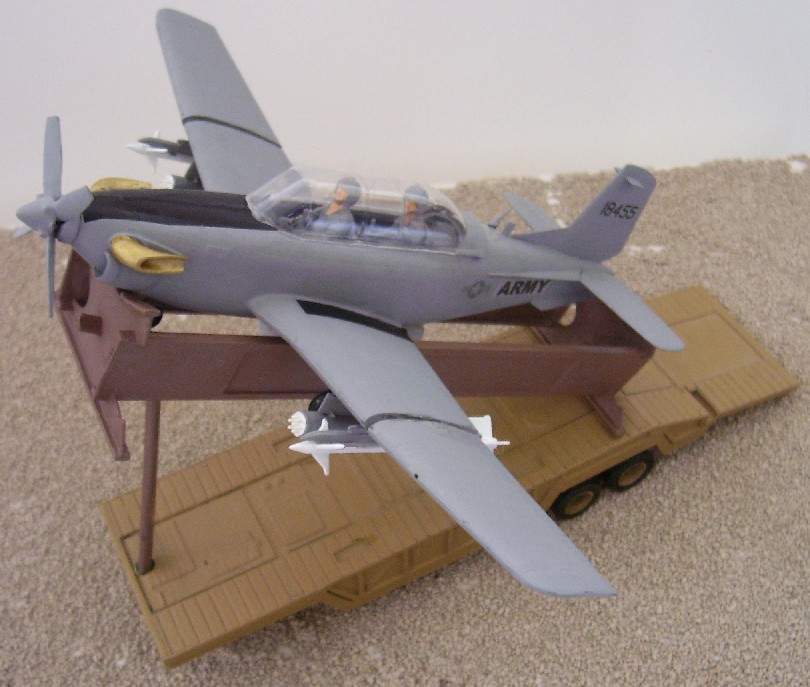
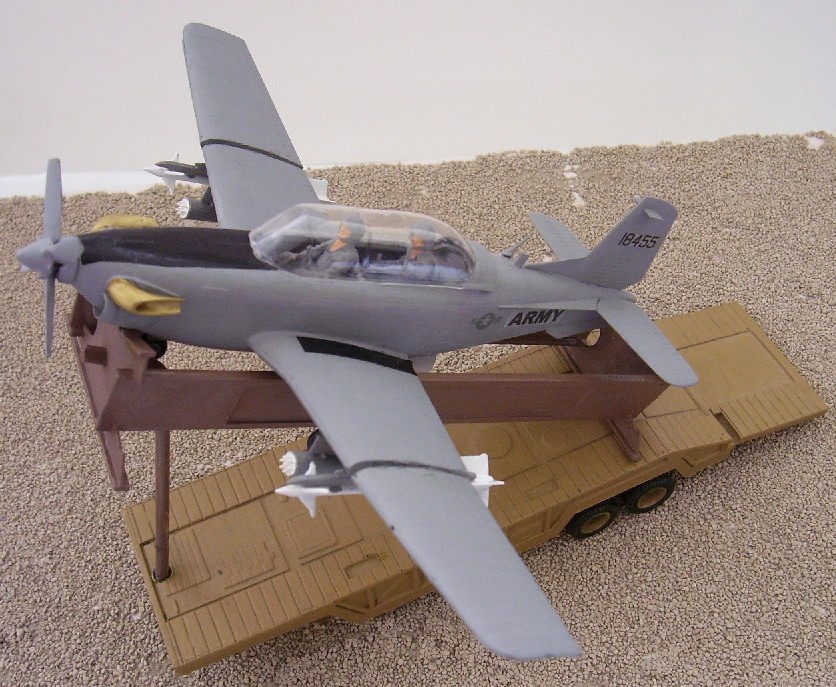
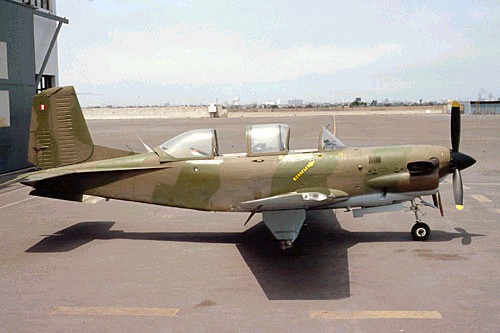
POC: BOD@T-34.com
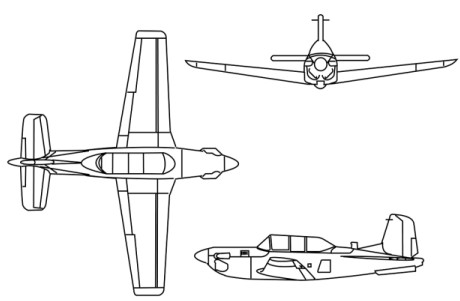
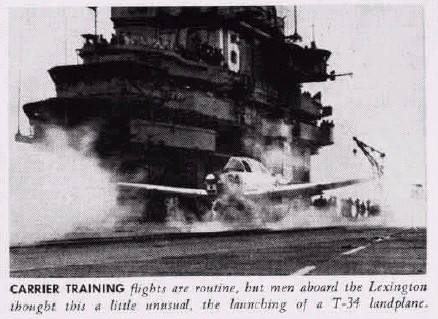
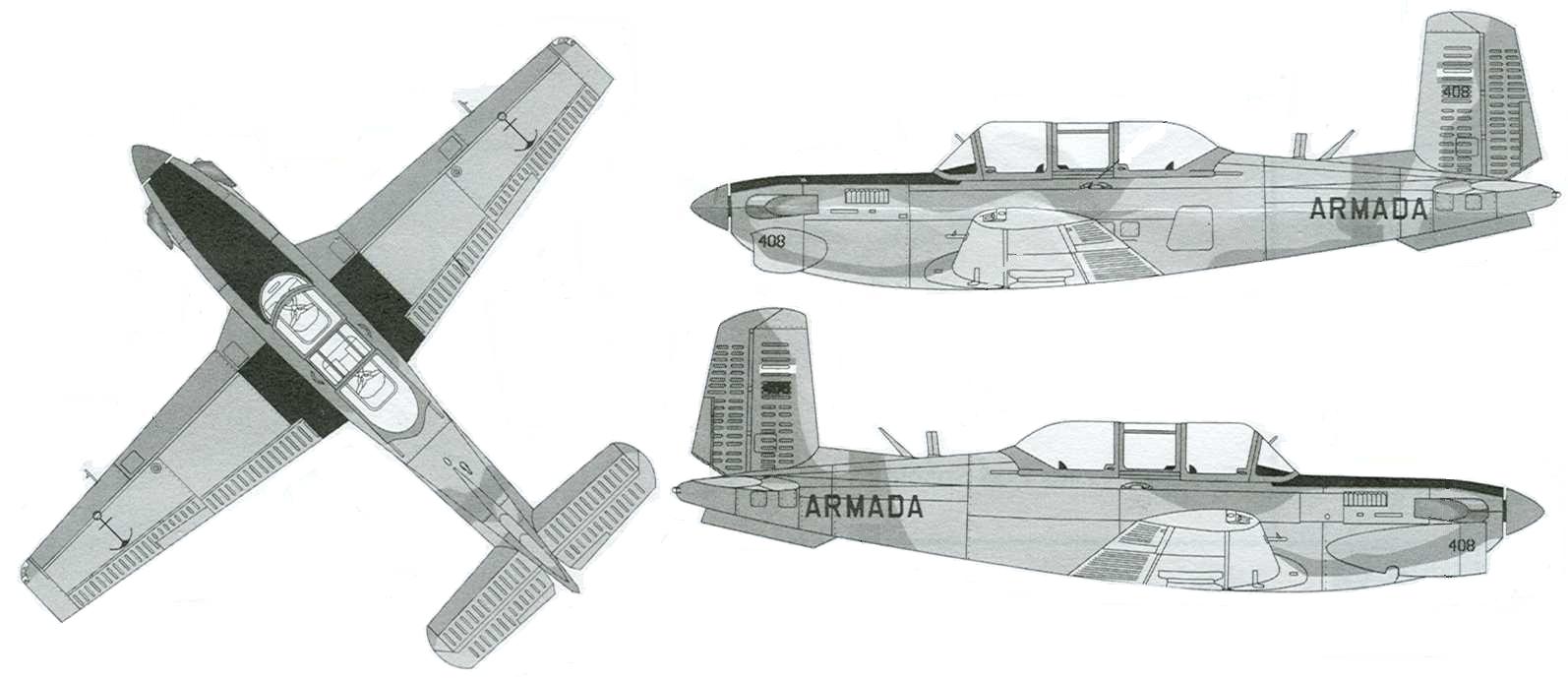
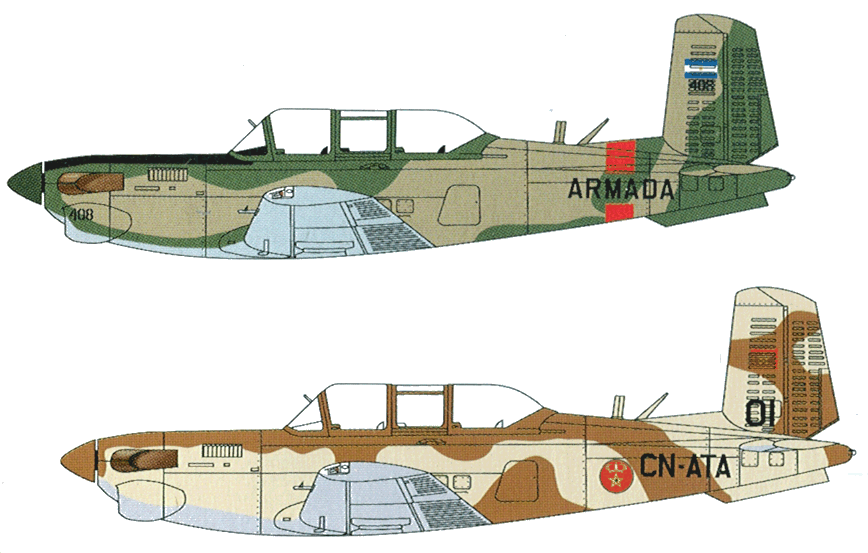
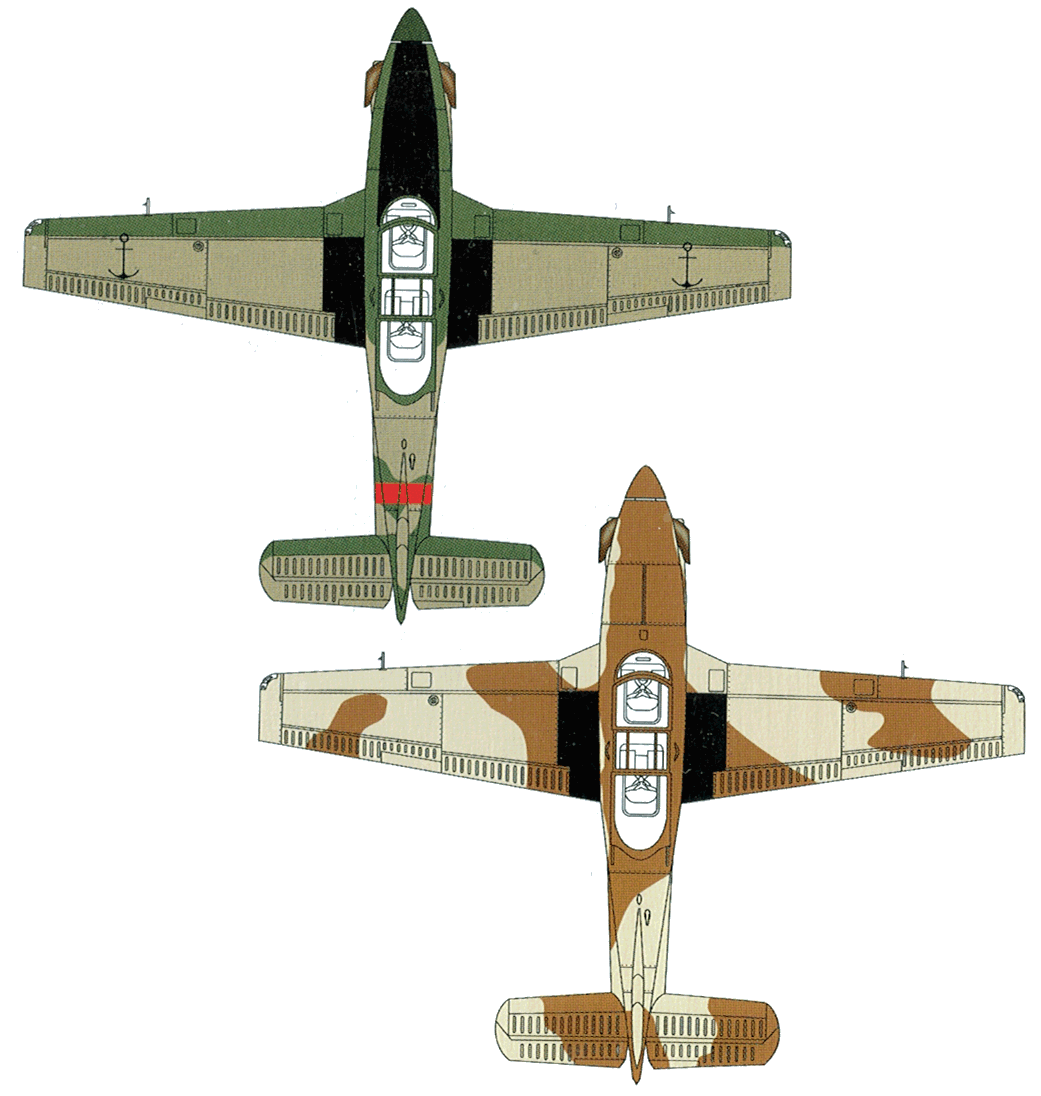
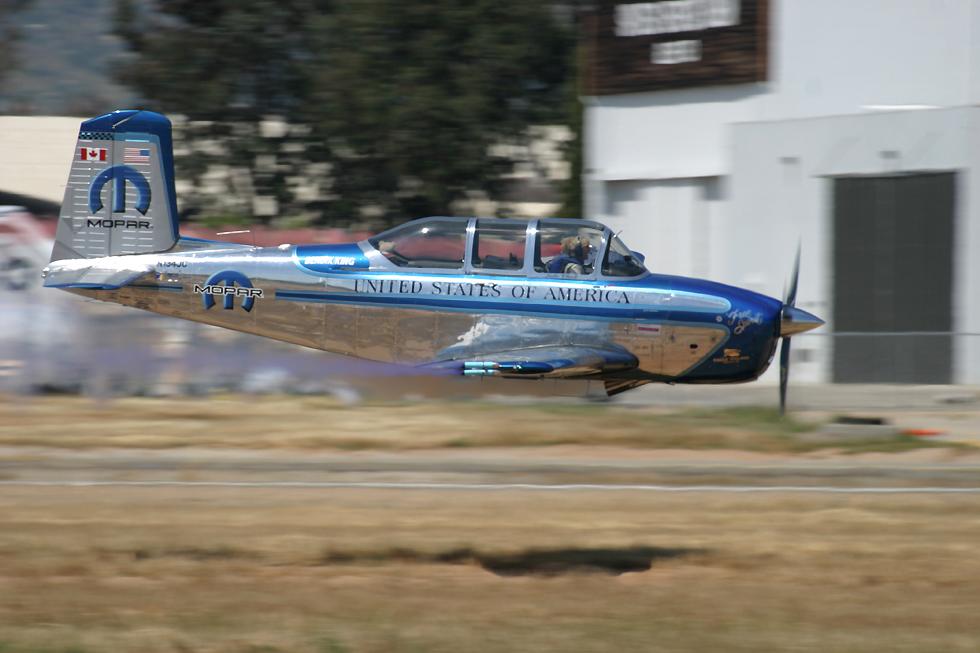
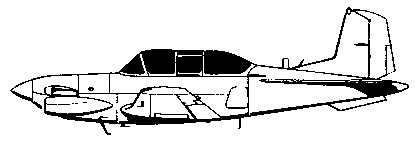
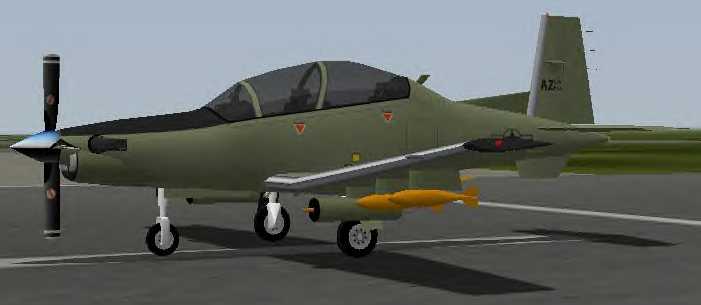
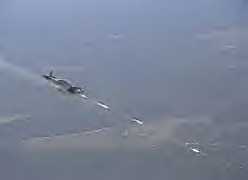

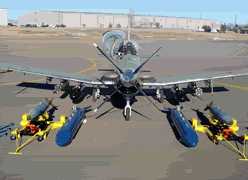
+ Already in USAF service
+ Ejection seats
+ Quiet
- Not durable to take enemy fire
- No civil use--not a crop duster
- No smokescreen capability
- Not armored
- Wings don't detach or fold for trailer/shipping container ground mobility
Director Government Business Development
U.S. Government and Domestic products
Phone: (316) 676-8558
Fax: -6779
Email: lyn_roberts@rac.ray.com
Director T-6 Strategy & Business Development
Phone: (316) 676-5031
Fax: -5483
Email: doug_scott@rac.ray.com
Director International Business Development
Europe, Israel, North & South America
Phone: (316) 676-7424
Fax: -6779
Email: larry_pope@rac.ray.com
Director International Business Development
Asia Pacific Rim, Africa & Middle East
Phone: 316-676-3350
Fax: 316-676-6779
Email: mark_qualls@rac.ray.com
According to www.airforce-technology.com:
An O-6B Texan is needed
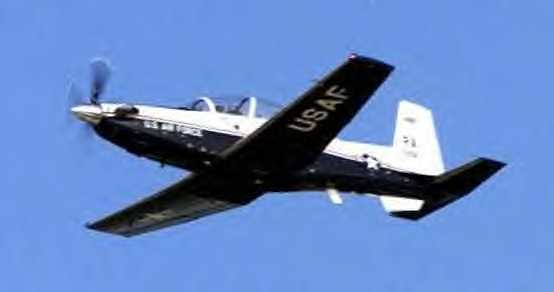 Raytheon developed a kit to optimize the Texan's performance in combat environments, converting them to a T-6B for foreign sales, although OV-6B "Texan" Ranger is a better designation; "O" for Observation and "V" for its short take-off and landing ability. The B version has a weapons control computer and six wing hard points for mounting bombs, rocket pods, or machine guns. However, a Ranger should not become an attack aircraft, but a much needed observation and support platform which must include appropriate communications and surveillance equipment like that found on the Army's OH-58 Kiowa scout helo. This inexpensive and nimble two-seat aircraft provides a clear view where a highly trained enlisted fire support coordinator can ensure safe and effective fires on the enemy below. Airborne fire support today is attempted by partially trained pilots from slow helicopters, F/A-18D fast FACs, or single-seat OA-10s where a pilot is expected to fly the aircraft while coordinating strikes.
Raytheon developed a kit to optimize the Texan's performance in combat environments, converting them to a T-6B for foreign sales, although OV-6B "Texan" Ranger is a better designation; "O" for Observation and "V" for its short take-off and landing ability. The B version has a weapons control computer and six wing hard points for mounting bombs, rocket pods, or machine guns. However, a Ranger should not become an attack aircraft, but a much needed observation and support platform which must include appropriate communications and surveillance equipment like that found on the Army's OH-58 Kiowa scout helo. This inexpensive and nimble two-seat aircraft provides a clear view where a highly trained enlisted fire support coordinator can ensure safe and effective fires on the enemy below. Airborne fire support today is attempted by partially trained pilots from slow helicopters, F/A-18D fast FACs, or single-seat OA-10s where a pilot is expected to fly the aircraft while coordinating strikes.
2. Artillery Spotting - Tiny U.S. Army spotting aircraft were essential for artillery units fighting in Europe during World War II. However, the Army has no spotting aircraft today so an artillery battery is unable to adjust fires unless a forward observer is on the ground near the target and able to communicate with the firing battery. A Kiowa scout helo can spot artillery fire, but that is a very slow platform with little endurance. A Ranger can call in artillery fires on enemy forces miles ahead of friendly ground forces using its speed or high-altitude capability to avoid ground fire.
3. Frontline Reconnaissance - Rangers are vulnerable in high-threat AAA environments due to their slower speed, although they are much faster than attack helicopters. The solution is for pilots to use their judgment and operate like attack helicopters. If the AAA threat is high, they will fly low and avoid enemy held areas. They will remain just behind advancing forces and pop up occasionally for a quick look. If enemy heavy machine guns or AAA shoot at them, it exposes their positions to attack by ground forces.
Despite the emphasis on high-tech warfare, almost all fighting by US ground troops occurs against enemies with little anti-aircraft weaponry. In those situations, the best surveillance platform is a small, circling two-seat propeller aircraft. A spotter with high-power binoculars and radios can remain on station for hours, sometimes flying high enough where he cannot be seen or heard. Unlike UAVs, this spotter can see in all directions, and can hear explosions so he knows if someone is shooting at him. Shooting down enemy UAVs is an ideal role for Rangers and unlike UAVs, their guidance cannot be jammed, a rarely mentioned shortfall of UAVs.
4. Search and Rescue - This mission favors long-range slow-moving aircraft. However, it may be risky to employ Rangers in high threat environments. Yet the US military now operates in mostly benign environments in Iraq and Afghanistan where expensive helicopters frequently conduct hours of road and border reconnaissance. Rangers are better suited for such operations since they are quieter, faster, and much cheaper to operate.
The great book "Killing Pablo" about the hunt for drug lord Pablo Escobar in Colombia mentions another advantage of small propeller aircraft. The US Army employed small RC-12s to locate cell phone transmissions and observe suspect areas. In most Third World nations, small propeller aircraft are common and attract no notice, whereas a jet aircraft or a helicopter flying overhead is odd and attracts immediate attention.
5. Radio Relay - Small units sometimes lose radio contact because of hills, mountains, buildings, or a lack of batteries. Sophisticated enemies may jam radio or GPS frequencies leaving ground units confused. With a Ranger overhead, they can ask for message relay or directions. In some cases, a Ranger will spot friendly units moving down the wrong road or heading toward an ambush, so the guys in the sky will help.
6. Emergency Close Air Support (CAS) - This mission is listed last in hope of avoiding the inevitable digression into the best platform for CAS. Many soldiers who like the idea of a slow and low flying A-1 SkyHawk used in Vietnam will discover the small Ranger lacks payload capacity and argue for something larger. The jet mafia will use this as an excuse to evaluate and develop alternatives; e.g. a never-ending study to shelve this idea. This is why promoting an AV-6B Ranger is a bad idea; "A" is a designation for attack aircraft.
Although the T-6B has six hardpoints, adding weaponry will cut speed, range, and endurance. On the other hand, rockets are good for marking targets, and a .50 caliber machine gun is nice in case Rangers come across enemy UAVs or helicopters. The best answer is to allow each commander to use his judgment based on the enemy threat and mission at hand. There may be situations in remote regions where no large airfields exist to operate jet attack aircraft, so OV-6Bs may be the only CAS option. And of course if US ground forces face probable defeat in a major battle, OV-6Bs will be thrown into the fight. While they carry little payload, strafing Rangers will frighten an advancing enemy and force him to redirect his firepower upward.
Despite the obvious value of immediately forming
Ranger squadrons, opposition will arise from those who favor a larger platform, or one from their company or district. Others will see the
Ranger as a threat to their program, especially those touting expensive and far less capable UAVs. They will urge "studies" and "competition" to kill this idea. No matter what ideas they present, the OV-6Bs research, development, testing, and production timetable is zero; they can be sent to Iraq tomorrow. Various high-tech targeting and surveillance systems may be added, so long as weight and cost increases are moderate. CAS testing a couple of years ago revealed that the best observation and targeting device was a pair of simple high-powered binoculars. Perhaps
Rangers can be replaced by a more capable platform in the future, but only the T-6B design is available now. In addition, if the US military adopts inexpensive OV-6Bs for combat use, this will ensure numerous orders from other nations which will create American jobs. Ranger Ranger Ranger
The U.S. marine corps and U.S. Army need support from OV-6B
Ranger squadrons. Since the marines plan to replace their two-seat F/A-18Ds with single-seat F-35s, they will need a new airborne FAC platform. The Army and Air Force must agree on who will fund and man
Ranger squadrons. The Army is prohibited from operating fixed-wing aircraft, although exceptions have been made for VIP aircraft and small signal intelligence aircraft. Unless the Air Force wishes to fund and man
Ranger squadrons, they should agree to allow the Army to operate any rotary aircraft; no jets of course. Once the OV-6B squadrons are established, the debate can commence to select and develop a superior replacement aircraft, something that takes the US military at least ten years. If that occurs, the OV-6Bs can revert to T-6s and go to training squadrons. Meanwhile, OV-6B
Rangers can immediately fill a critical gap. Ranger Ranger Ranger Ranger


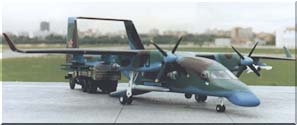

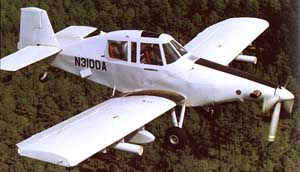
 www.youtube.com/watch?v=cbanSkIk-xM
www.youtube.com/watch?v=cbanSkIk-xM
 www.youtube.com/watch?v=R9grUNuOgYc
www.youtube.com/watch?v=R9grUNuOgYc
+ Already in world-wide service
+ Quiet
+ Civil use as crop duster/firefighter
+ Has "smoker" smokescreen capabilities
+ Rugged and STOL capable; does not need air bases
+ Armored
+ Wings detach or fold for trailer/shipping container ground mobility
Future Concepts & Business Development
Thrush Aircraft Inc.
300 Old Pretoria Road
Albany, Georgia 31707
(229) 883-1440
Mdoellfeld@ThrushAircraft.com
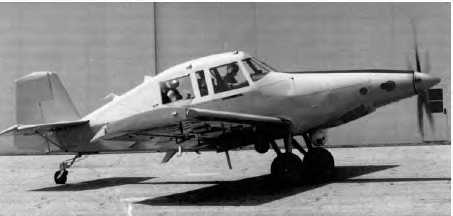
U.S. Cuts Role Of Apache for Deep Attack
DefenseNews.com
Posted 04/03/06 12:28
www.defensenews.com/story.php?F=1607858&C=america

Excellent artwork by Robert Johnson
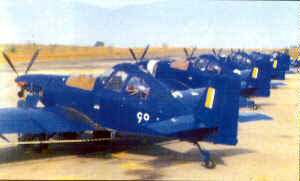
Rare picture of NEDS in action in Burma
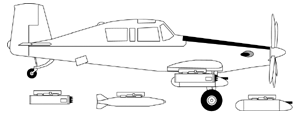

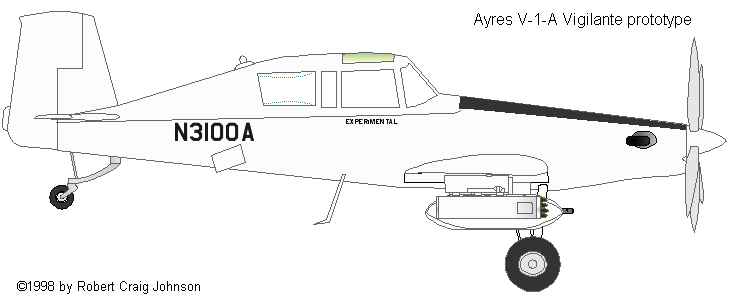
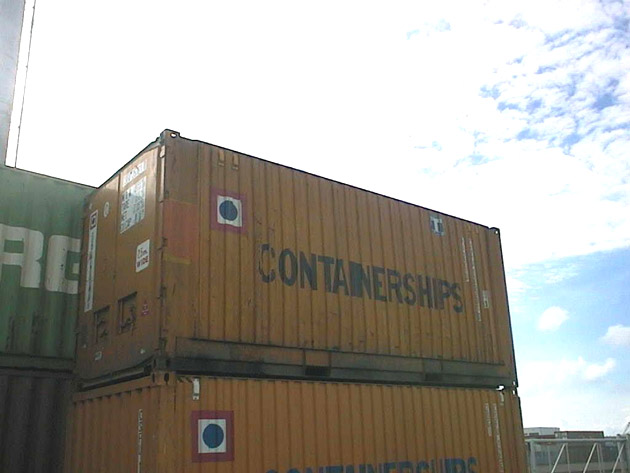
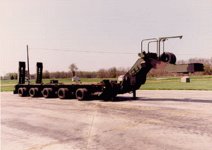
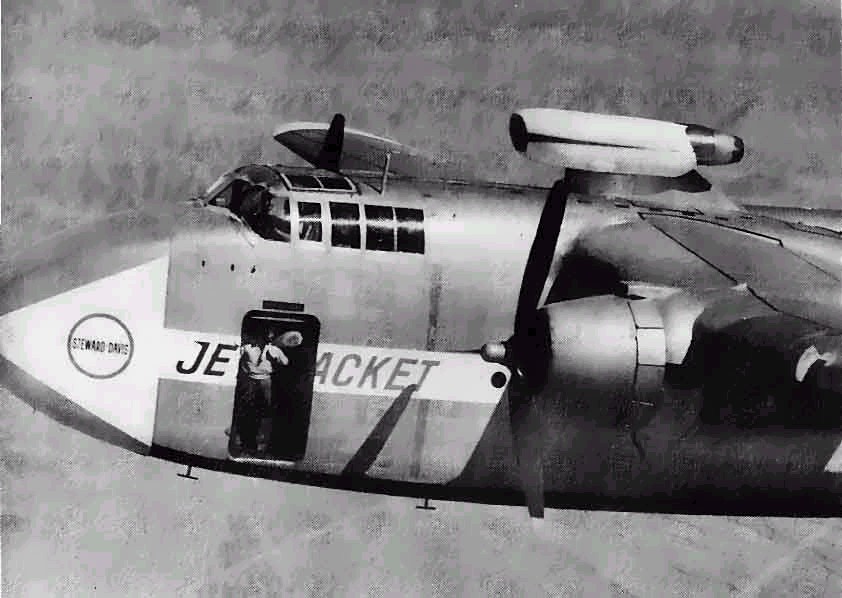
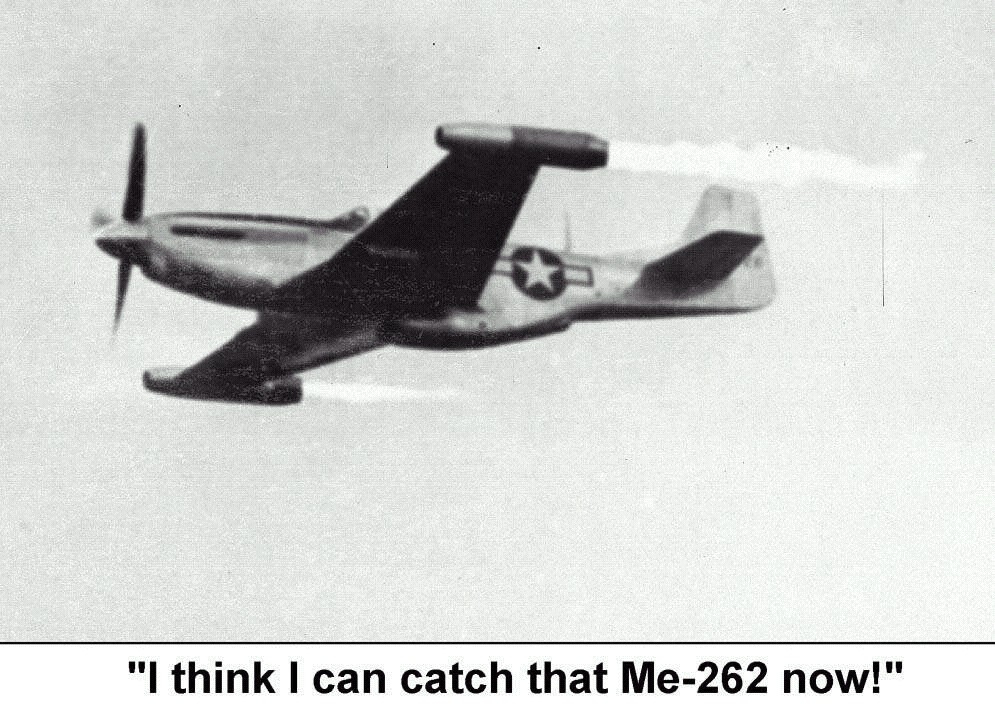
250 2,372 lb 767 Hp
350 1,695 lb 1,074 Hp
450 1,289 lb 1,381 Hp
www.geocities.com/usarmyaviationdigest/mas.htm
www.combatreform.org/killerbees.htm
www.combatreform.org/killerbees2.htm
www.combatreform.org/killerbees3.htm
APPENDIX
b. Fly 100 different aircraft from Vietnam to present
c. Excellent flight manual and weapons system data
Hundreds of fast-paced missions
Unlimited game play
Take on the world's best
Dogfight on the Internet against the world's toughest aces
FEEDBACK!
FEEDBACK!
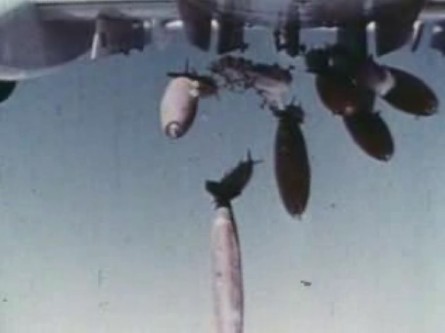

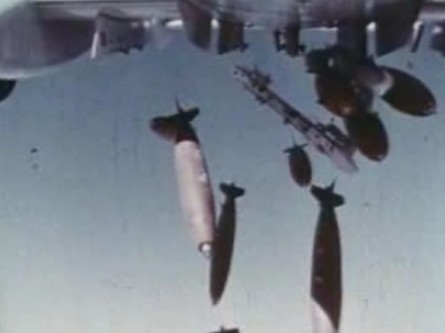
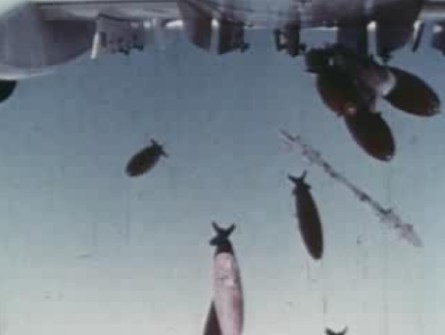
August 15, 2002
Two 30mm Gatling Gun Pods
Two .50 cal Gatling Gun Pods"
For pictures of A-10s in combat in Afghanistan:
And just how long have some of us been saying that the aerobatics is now in the missile, NOT the fighter. A WW ONE Spad could rule the skys over Iraq, with a wingload of sidewinders"
